|
||||||||||||||||||||||||||||||||||||||||||||||||||||||||||||||||||||||||||||||||||||||||||||||||||||||||||||||||||||||||||||||||||||||||||||||||||||||||||||||||||||||||||||||||||||||||||||||||||||||||||||||||||||||||||||||||||||||||||||||||||||||||||||||||||||||||||||||||||||||||||||||||||||||||||||||||||||||||||||||||||||||||||||||||||||||||||
|
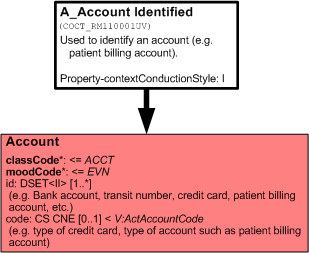
| Parent: | Patient Billing Account (FIAB_DM000000UV) |
The Account CMET is used to identify account information.
This is the identified variant of A_Account universal
| A_Account identified | COCT_MT110001UV01 |
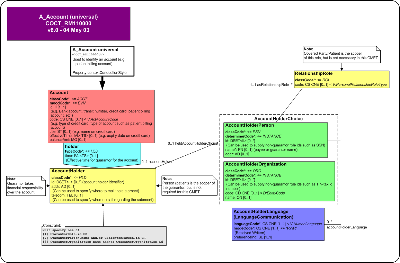
| Parent: | Patient Billing Account (FIAB_DM000000UV) |
Note: This CMET replaces or revises material in the HL7 V3 2005 Normative Edition standard. It will appear in the HL7 V3 2006 Normative Edition.
The Account CMET is used to identify account information. An account is an accumulator of financial transactions (e.g. charges, debits, credits) that have either a positive or negative affect on the balance of the account. Examples of accounts are patient billing accounts, cash, credit card, Payor accounts and Payee accounts.
This CMET describes the account, type of account, effective dates for the account (e.g. for credit cards, the start/end dates), an account name (e.g. name on the credit card) and balance.
The account holder is noted, which could either be an individual or organization. If the account holder is a person, it may be useful to note the language that the account holder is conversant in.
| A_Account universal | COCT_MT110000UV04 |
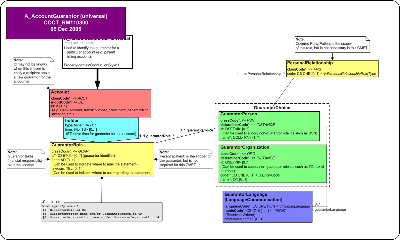
| Parent: | Patient Billing Account (FIAB_DM000000UV) |
Note: This CMET replaces or revises material in the HL7 V3 2005 Normative Edition standard. It will appear in the HL7 V3 2006 Normative Edition.
The AccountGuarantor CMET is used to identify the guarantor for a particular account (e.g. patient billing account). A guarantor takes financial responsibility over the account.
This CMET describes the account, type of account, effective dates for the account (e.g. for credit cards, the start/end dates), an account name (e.g. name on the credit card) and balance.
The account holder is noted as the guarantor, which could either be an individual or organization. If the account holder is a person, it may be useful to note the language that the account holder is conversant in. The person that scopes the guarantor (e.g. patient) may also be noted.
| A_AccountGuarantor universal | COCT_MT110300UV04 |
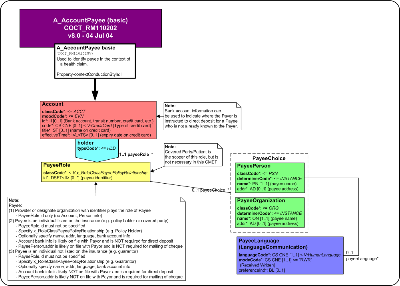
| Parent: | Patient Billing Account (FIAB_DM000000UV) |
Note: This CMET will appear in the HL7 V3 2006 Normative Edition.
This is the basic variant of A_AccountPayee universal. It is a set of minimal constaints upon the universal CMET.
| A_AccountPayee basic | COCT_MT110202UV04 |
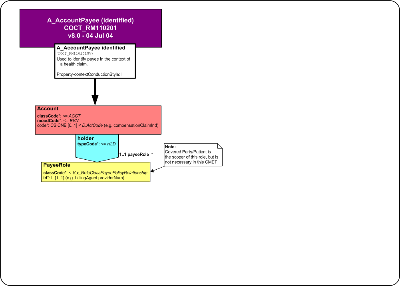
| Parent: | Patient Billing Account (FIAB_DM000000UV) |
Note: This CMET will appear in the HL7 V3 2006 Normative Edition.
This is the identified variant of A_AccountPayee universal
| A_AccountPayee identified | COCT_MT110201UV04 |
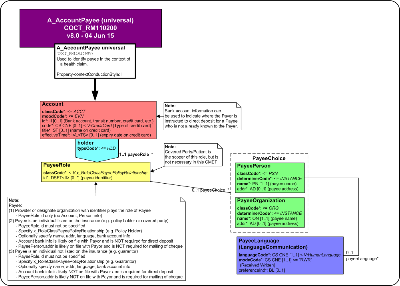
| Parent: | Patient Billing Account (FIAB_DM000000UV) |
Note: This CMET replaces or revises material in the HL7 V3 2005 Normative Edition standard. It will appear in the HL7 V3 2006 Normative Edition.
The AccountPayee CMET specifies the Payee, in the context of an Invoice. A Payee is a person or organization that receives payment for services rendered and/or goods provided and receives payment on behalf of one or more Providers. As well, a Payee may be a person who has directly paid the Provider and is being reimbursed by the Payor. In some cases, a Payee may be the same as the Provider.
A Payee is specified in either of 3 ways:
-
[1] Payee is a known entity and has an identifier (e.g. Provider or designate organization).
In this case, only a Payee identifier is specified.
-
[2] Payee is an individual listed on the insurance policy (e.g. policy holder or covered party).
In this case, a Payee identifier is not specified. In its place would be a relationship code from the Payee to the policy (e.g. Policy Holder). Optional information would be Payee name, address, language and bank account information. Note that bank account information and address may be not on file with the Payor.
-
[3] Payee is an individual not listed on the insurance policy (e.g. guarantor).
In this case, a Payee identifier is not specified. In its place would be a relationship code from the Payee to the policy (e.g. Guarantor). Optional information would be Payee name, address, language and bank account information. Note that bank account information and address are likely not on file with the Payor.
| A_AccountPayee universal | COCT_MT110200UV04 |
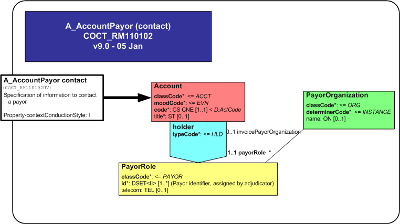
| Parent: | Patient Billing Account (FIAB_DM000000UV) |
Note: This CMET will appear in the HL7 V3 2006 Normative Edition.
This is the contact variant of A_AccountPayor universal.
| A_AccountPayor contact | COCT_MT110102UV04 |
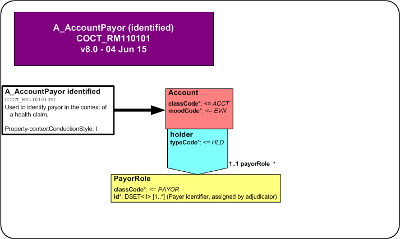
| Parent: | Patient Billing Account (FIAB_DM000000UV) |
Note: This CMET will appear in the HL7 V3 2006 Normative Edition.
This is the identified variant of A_AccountPayor universal
| A_AccountPayor identified | COCT_MT110101UV04 |
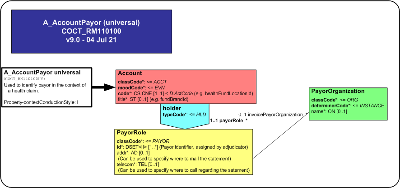
| Parent: | Patient Billing Account (FIAB_DM000000UV) |
Note: This CMET replaces or revises material in the HL7 V3 2005 Normative Edition standard. It will appear in the HL7 V3 2006 Normative Edition.
The AccountPayor CMET contains the Payor's identifier. It is used to identify the Payor in the context of an Invoice. A Payor is an organization that establishes benefit/insurance plans, determines eligibility for benefits and funds payment for Goods and/or Services provided to a Person. A Payor may retain a TPA (Third Party Administrator) or Adjudicator to perform some or all of the invoice validation, adjudication and payment. Fundamentally, a Payor is the organization that pays the adjudicated invoice.
| A_AccountPayor universal | COCT_MT110100UV04 |
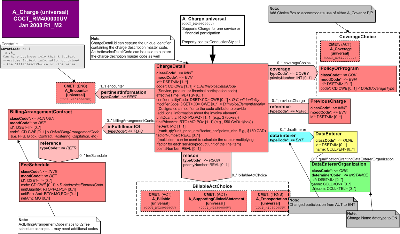
| Parent: | Patient Billing Account (FIAB_DM000000UV) |
Overview:
The A_Charge (universal) CMET supports the conveyance of invoiced charges relating to a single billable act that is being or has been provided, as indicated by the moodCode EVN.
ChargeDetail
The ChargeDetail is conveyed with the classCode INVE for invoice.
A set of one or more ChargeDetail identifier is required to be sent if available to uniquely identify the invoice in one or more accounting systems.
The ChargeDetail code, which is required to be specified by ActInvoiceDetailCode value set, provides specific information related to the type of billable act provided, e.g., the type of service provided or the type of product dispensed, or the type of financial participation incurred on the part of the guarantor for the billable act.
The ChargeDetail effectiveTime denotes the time period of the billable acts referenced by the ChargeDetail.
The ChargeDetail confidentialityCode may be sent to control the collection, access, and use of information related to this charge. The level of confidentiality is conveyed by a coded concept from the Confidentiality vocabulary domain, which includes codes indicating the types of permitted access, restriction on access, reasons for confidentiality, such as celebrity status of patient, and types of sensitive services or health condition information that requires privacy protection.
The ChargeDetail modifierCode designates a modifier to the code attribute to provide additional information about the invoice element.
The ChargeDetail unitQuantity conveys the ratio of units per service provision or product dispense, e.g., 2 hour session of physical therapy or 3 boxes of a product per dispense.
The ChargeDetail unitPriceAmt conveys the price per unit, e.g., $50 CAD/1{box} or $100 per hour of physical therapy.
The ChargeDetail netAmt is expressed using a currency {the unit in which monetary amounts are denominated in different economic regions] to express the net amount charged based on the product of applicable ChargeDetail unity quantity, unitPriceAmt, factorNumber and pointsNumber attributes.
The ChargeDetail factorNumber is the multiplier or percentage used to calculate the rate for each unitQuantity/unitPriceAmt expressed with a Real integer, e.g., the tax rate.
The ChargeDetail pointsNumber is used where the netAmt is expressed in 'points', this expresses the weighting (based on difficulty, cost and/or resource intensiveness) associated with the good or service delivered.
Links to Other Acts
A ChargeDetail may link to other acts:
Coverage for the billable act by one or more policies or programs may be conveyed using the Coverage COVBY ActRelationship association to one or more PolicyOrProgram or A_Coverage CMET. Coordination of benefits among several PolicyOrPrograms may be conveyed in priorityNumber in terms of the priority of their responsibility for coverage.
A PolicyOrProgram is represented by the classCode COV. An identifier id is required to be sent if available. It is required to be fully specified by a policy or program type from the codeActCoverageTypeCode.
The reference ActRelationship REFR may be used to associate zero or more previouse charges to a ChargeDetail.
The PreviousCharge classCode INVE indicates that this is an invoice.
The PreviousCharge moodCode EVN indicates that an instance of a previous charge invoice actually happened.
The PreviousCharge id ione or more unique identifiers is required to be sent if available.
The author AUT participation may be used to associate one or more DataEnterer with the ChargeDetail. The DataEnterRole is represented by the qualified entityclassCode QUAL. The DataEnterer id is required to be sent if available and the DataEnterer name may be sent.
A DataEntererOrganization may scope the DataEntererRole. This is an organization entity instance with one or more required identifier, and optional name and telecom.
The reason RSON ActRelationship associates a choice of Billable Acts as reasons for the charge. The RSON priorityNumber allows the charges to be prioritized for coding and billing purposes.
The BillableActChoice box enables a choice of the following CMETs to convey information related to clinical or non-clinical acts: A_Billable universal, A_SupportingClinicalInformation universal, A_Transportation universal , or the A_Observation universal. In the future, other Acts or CMETs drawn from electronic provider health records (EHR) may be included in this choice box, which would support conveyance of charge information based on EHR systems.
The inFullfillmentOf ActRelationship associates the ChargeDetail with the BillingArrangementContract, a financial contract expressed with the classCode FCNTCT in definition mood DEF.
The BillingArrangementContract code provides specific information about the type of financial contract with a coded concept from the ActBillingArrangementCode value set, e.g., fee-for-service, capitation, block grant, etc.
The BillingArrangementContract id is required to be sent if available to identify the contract.
The reference REFR ActRelationship associates the BillingArrangementContract with the FeeSchedule expressed with the classCode INVE in definition mode.
The FeeSchedule id is required be sent if available to uniquely identify a fee schedule.
The FeeSchedule code from the ActInvoiceElementCode value set provides specific information about the type of charges that may be invoiced.
The FeeSchedule may carry unitQuantity, unitPriceAmt, and netAmt if these are different or more informative than those carried in the ChargeDetail.
The pertinentInformation ActRelationship typeCode PERTassociates the A_Encounter universal with the ChargeDetail. New in this ballot: The contextControlCode has been removed, because it does not support bi-directional overrides of the patient information. One can have a business rule that R_Patient in A_Encounter overrides patient information contained in the BillableActChoice and vice versa.
| A_EncounterUniversal | COCT_MT010000UV01 |
| A_TransportationUniversal | COCT_MT060000UV01 |
| A_BillableUniversal | COCT_MT280000UV04 |
| A_CoverageUniversal | COCT_MT510000UV06 |
| A_SupportingClinicalStatementUniversal | COCT_MT530000UV |
| A_Charge universal | COCT_MT400000UV07 |
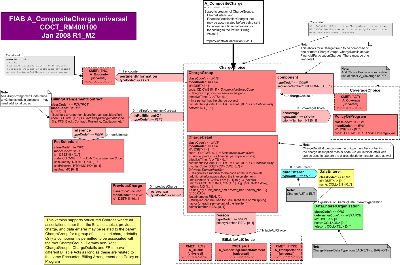
| Parent: | Patient Billing Account (FIAB_DM000000UV) |
Overview: .
The A_CompositeCharge (universal) CMET supports the conveyance of groups of invoiced charges relating to one or more billable act that is being or has been provided, as indicated by the moodCode EVN. These may be a series of components, which may be other charge groups or charge details. The initial group is the root group. Child groups are nodes, and all paths must end with a charge detail. The various associated classes may either be linked at the group or detail levels, or are restricted to either the group or the detail level.
The focal class is the ChargeGroup which is conveyed with the the classCode for invoice (INVE).
ChargeGroup Attributes
One or more ChargeGroup id is required to identify the ChargeGroup instance.
The ChargeGroup code, which is specified by the ActInvoiceGroupCode, is the category of billable acts charges as conveyed by one or more component ChargeGroups or ChargeDetails.
The ChargeGroup effectiveTime denotes the time period of the billable acts referenced by the ChargeGroup.
The ChargeGroup confidentialityCode is used to control the collection, access, and use of information related to this charge group. The level of confidentiality is conveyed by a coded concept from the Confidentiality vocabulary domain, which includes codes indicating the types of permitted access, restriction on access, reasons for confidentiality, such as celebrity status of patient, and types of sensitive services or health condition information that requires privacy protection. The confidentiality code selected at the ChargeGroup level may be overridden by the confidentiality code selected at the ChargeDetail level.
The ChargeGroup netAmt conveys the total of the amounts charged for each component ChargeDetail.
The focal act ChargeGroup is the root group, which must be a composite of either one or more ChargeGroup or one or more ChargeDetails. The composition is conveyed using the component ActRelationship with a sequenceNumber for structuring the hierarchy, i.e., ordering the elements from the parent groups to the detail elements.
The ChargeDetail is conveyed with the classCode for invoice (INVE).
ChargeDetail Attributes
A set of one or more ChargeDetail identifiers may be used to uniquely identify the invoice in one or more accounting systems.
The ChargeDetail code, which is specified by ActInvoiceDetailCode vocabulary domain, provides specific information related to the type of billable act provided, e.g., the type of service provided or the type of product dispensed, or the type of financial participation incurred on the part of the guarantor for the billable act.
The ChargeDetail effectiveTime denotes the time period of the billable acts referenced by the ChargeDetail.
The ChargeDetail modifierCode designates a modifier to the code attribute to provide additional information about the invoice element, e.g., body site codes or organ donor or how the service was performed.
The ChargeDetail unitQuantity conveys the ratio of units per service provision or product dispense, e.g., 2 hour session of physical therapy or 3 boxes of a product per dispense.
The ChargeDetail unitPriceAmt conveys the price per unit, e.g., $50 CAD/1{box} or $100 per hour of physical therapy.
The ChargeDetail netAmt is expressed using a currency {the unit in which monetary amounts are denominated in different economic regions] to express the net amount charged based on the product of applicable ChargeDetail unity quantity, unityPriceAmt, factorNumber and pointsNumber attributes.
The ChargeDetail factorNumber is the multiplier or percentage used to calculate the rate for each unitQuanitity/unitPriceAmt expressed with a Real integer, e.g., the tax rate.
The ChargeDetail pointsNumber is used where the netAmount is expressed in 'points', this expresses the weighting (based on difficulty, cost and/or resource intensiveness) associated with the good or service delivered.
Links to Other Acts
A ChargeDetail may link to other acts:
Coverage for the billable act by one or more policies or programs may be conveyed using the Coverage (COVBY) association to one or more PolicyOrProgram or A_Coverage CMET. Coordination of benefits among several PolicyOrPrograms may be conveyed in sequenceNumber in terms of the priority of their responsibility for coverage.
A PolicyOrProgram is represented by the classCode COV. It may have an id. It is fully specified by a policy or program type from the code vocabulary domain ActCoverageTypeCode.
The author participation may be used to associate one or more DataEnterer with the ChargeDetail. The DataEnterRole is represented by the qualified entityclassCode QUAL. The DataEnterer id is required and the DataEnterer name is optional.
A DataEntererOrganization may scope the DataEntererRole. This is an organization entity instance with one or more required identifier, name and telecom.
The reasonActRelationship associates a choice of Billable Acts as reasons for the charge only to a ChargeDetail. The reason contextControlCode is valued as additive, propagating and the contextConductionInd has default value of "true". This enables context conduction of the R_Patient from the A_Encounter through to the BillableAct, and overrides any patient role information that may be carried therein. The RSON priorityNumber allows the charges to be prioritized for coding and billing purposes.
The BillableActChoice box enables a choice of the following CMETs to convey information related to clinical or non-clinical acts: A_Billable (universal), A_SupportingClinicalInformation (universal), A_Transportation (universal) or the A_Observation (universal). In the future, other Acts or CMETs drawn from electronic provider health records (HER) may be included in this choice box, which would support conveyance of charge information based on HER systems.
The referenceActRelationship may associate the ChargeGroup or ChargeDetail with a previousCharge ChargeGroup or ChargeDetail. One or more identifiers are required.
The inFullfillmentOfActRelationship associates the ChargeGroup or ChargeDetail with the BillingArrangementContract , a financial contract expressed with the classCode FCNTCT.
The BillingArrangementContract code provides specific information about the type of financial contract with a coded concept from the ActBillingArrangementCode vocabulary domain, e.g., fee-for-service, capitation, block grant, etc.
The reference ActRelationship associates the BillingArrangementContract with the FeeSchedule expressed with the Act.classCode INV in definition mode.
The FeeSchedule id may be used to identify an item in a fee schedule.
The FeeSchedule code ActInvoiceElementCode provides specific information about the type of charges that may be invoiced.
The FeeSchedule may carry unitQuantity, unitPriceAmt, and netAmt if these are different or more informative than those carried in the ChargeDetail.
The pertinentInformation ActRelationship typeCode PERTassociates the A_Encounter universal with the ChargeDetail. New in this ballot: The contextControlCode has been removed, because it does not support bi-directional overrides of the patient information. One can have a business rule that R_Patient in A_Encounter overrides patient information contained in the BillableActChoice and vice versa.
| A_EncounterUniversal | COCT_MT010000UV01 |
| A_TransportationUniversal | COCT_MT060000UV01 |
| A_BillableUniversal | COCT_MT280000UV04 |
| A_CoverageUniversal | COCT_MT510000UV06 |
| A_SupportingClinicalStatementUniversal | COCT_MT530000UV |
| A_CompositeCharge universal | COCT_MT400100UV07 |
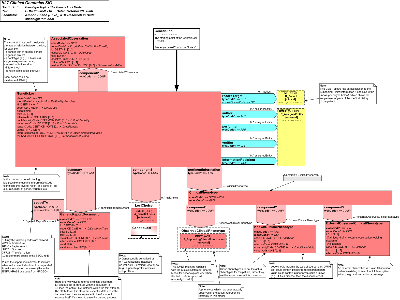
| Parent: | Clinical Genomics (POCG_DM000023UV) |
| R_PatientClinical | COCT_MT050004UV01 |
| R_AssignedEntityUniversal | COCT_MT090000UV01 |
| A_SupportingClinicalInformationUniversal | COCT_MT200000UV01 |
| A_GeneticLocusUniversal | COCT_MT930000UV |
| A_GeneticLoci universal | COCT_MT540000UV |
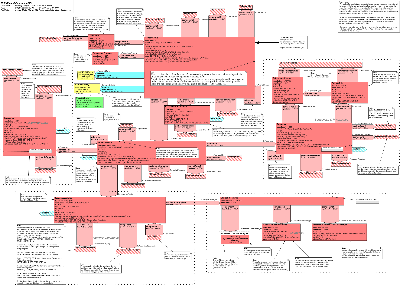
| Parent: | Clinical Genomics (POCG_DM000023UV) |
The documentation of the GeneticLocus model can be found in the Clinical Genomics Domain / Genotype Topic / R-MIM "GeneticLocus(POCG_RM000010UV)".
| R_AssignedEntityUniversal | COCT_MT090000UV01 |
| A_SupportingClinicalInformationUniversal | COCT_MT200000UV01 |
| A_GeneticLocus universal | COCT_MT930000UV |
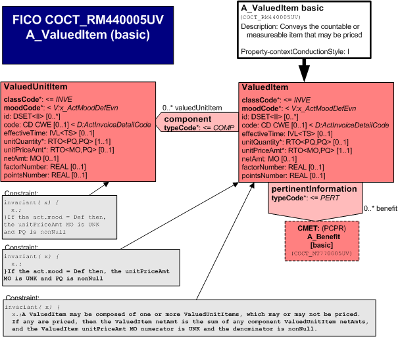
| Parent: | None |
Note: This is the second Normative ballot of the A_ValuedItem CMET. There are several variants: universal, basic, minimal, definitional, informational, and identifiable.
Overview
This CMET is used to convey information related to a ValuedItem in terms of its measurable or countable units. All Variants may include pricing information needed to calculate the net amount. In the minimal, basic, and universal variants, the ValuedItem may be composed of one or more ValuedUnitItems, which may or may not be priced. The universal and basic variants include coverage related information such as charges, financial participation, fee schedule, and coverage policies such as the health status of the subject of care that is conveyed in the A_Benefit CMET.
The identified variant is used to convey the identity of the ValuedItem information in the definition mood. The identifier is mandatory for the identified variant.
The definitional variant is used to convey the identity of the ValuedItem information in the definition mood. The identifier is optional for this variant.
The informational variant is used to convey the ValuedItem information in the definition or event mood. The identifier is required for this variant.
The minimal variant is used to convey optionally identifiable ValuedItem information in the definition or event mood, which may be composed of ValuedUnitItems.
The basic variant may include association to policy or program benefits to which it pertains, which are conveyed in the A_Benefit (basic) CMET COCT_MT770005UV.
The universal variant is used to convey more extensive ValuedItem information typical of knowledge base and payer benefit repository records.
How the ValuedUnitItem is used to compose a ValuedItem: A DME provider prices the frame and "add-on" components required to meet health needs of the patient. Component ValuedUnitItems may convey the InvoiceDetailCode for DME, e.g., UPC codes, and the unitPriceAmt for each part. For example, a DME provider prices the frame and "add-on" components required to meet health needs of the patient. Component ValuedUnitItems may convey the InvoiceDetailCode for DME, e.g., UPC codes, and the unitPriceAmt for each part. For an example see: DME_Table.doc
How Pricing is used:For each variant, one and only one ValuedItem is required to be sent. For the basic and universal variant, one or more ValuedUnitItem may be sent. If the act.mood of the ValuedItem or any ValuedUnitItems is in definition mood, the price may be as yet unspecified. In this case, the MO numerator for unspecified price is constrained to "UNK" for "unknown"; the PQ property denominator must be nonNull; and the netAmt is not valued. For example, in the case of product labeling, only the valued countable or measurable item is defined, but the price per unit or net amount is not yet determined.
If ValuedItem is in event mood and no ValuedUnitItem is sent, then the ValuedItem netAmt must be sent as the product of the ValuedItem unitPricedAmt and unitQuantity.
See Foundation Section 3.1.12 Class: InvoiceElement (in Acts) "For leaf-level amounts, this will be the value of the unitQuantity * unitPriceAmt [ * factorNumber] [* pointsNumber]. For grouping invoice elements, this will be the sum of the netAmt attributes of all contained InvoiceElements http://hl7.org/v3ballot/html/infrastructure/rim/rim.htm#InvoiceElement-cls
If any ValuedUnitItem act.mood is event, then the ValuedItem act.mood must be event. In this case, any ValuedUnitItem unitQuantity and unitPriceAmt attributes must be nonNull, and the ValuedUnitItem netAmt must be the product of these attributes. In addition, the ValuedItem netAmt must be the sum of any ValuedUnitItem netAmts. Since a ValuedItem unitPriceAmt is required to be sent, the MO numerator and PQ denominator must either both be UNK; or MO numerator must be equal to the ValuedItem netAmt and the PQ denominator must have a fixed value of 1.
NOTE: The RTO is NI because the MO numerator for unspecified price is set to "UNK" for "unknown" while the PQ denominator is nonNull. However, because RTO is NI, to ensure that there is information contained in the ratio, the unitPriceAmt is required with cardinality of 1...1. Thus:
<value xsi:type="RTO" nullFlavor="NI"> <numerator xsi:type="MO" nullFlavor="UNK"/> <denominator xsi:type="PQ" value="50" unit="mg"/> </value>
For more information see http://hl7.org/v3ballot/html/infrastructure/itsxml/datatypes-its-xml.htm#dtimpl-RTO
For more information on the derivation of CMET variants, see Refinement, Constraint and Localization, Release 2 Section 2.4.2 Common Message Element Types (CMETs) http://hl7.org/v3ballot/html/infrastructure/constraints/constraints.htm
Walk-through
ValuedItem
The ValuedItem classCode INVE: The focal class indicates the countable or measurable item (e.g., a product, device, or service) that may be or has been priced.
The ValuedItem moodCodeActMoodDefEvn: The ValuedItem is something that may be or has been priced.
The ValuedItem id: Optionally identifies an instance of ValuedItem information, e.g. as used on a particular product label.
The ValuedItem code from the ActInvoiceDetailCode concept domain, to which value set may be bound to provide specific information about the type of items that that may be or has been priced. For example, if the ActInvoiceDetailDrugProduct sub-concept domain is used, then the value set could include NDC, UPC or GTIN. When this code is the same as the code on a class in the base model to which this CMET is associated, do not valued this attribute or ensure that the codes are the same. For example, a Medication message may include the NDC code used in this CMET's attribute in an Entity class describing the drug.
The ValuedItem effectiveTime indicates the time during which ValuedItem information is effective.
The ValuedItem unitQuantityRTO<PQ,PQ> specifies the units by which the ValuedItem is measured or counted, and quantifies the countable or measurable ValuedItem instances. Required to be sent if known. The PQ units and values are aligned with the type of ValuedItem specified by the value set or coding system bound to the ValuedItem InvoiceDetailCode or its child concept domain.
For example, if the ActInvoiceDetailDrugCode is bound to the NDC codes, then the PQ unit value set is the NCPDP Billing Unit Standard http://www.ncpdp.org/PDF/Basic_guide_to_standards.pdf. For more information see Foundation Section 3.1.12.2 InvoiceElement.unitQuantity: RTO<PQ,PQ> (0..1).
One and only one ValuedItem unitPriceAmtRTO<MO,PQ> is required to be sent to quantify the ratio of the price per countable or measurable instance of an item that may be or has been priced. If the act.mood of the ValuedItem is in definition mood, the price may be as yet unspecified. In this case, the MO numerator for unspecified price is constrained to "UNK" for "unknown"; the PQ denominator must be nonNull; and the netAmt is not valued. For example, in the case of product labeling, only the valued countable or measurable item is defined, but the price per unit or net amount is not yet determined.
The ValuedItem netAmtMO may be sent to express the product of the ValuedItem unitQuantity and the unitPriceAmt. If the unitPriceAmt MO is UNK, then the netAmt is UNK or not sent. If any ValuedUnitItem act.mood is event, then the ValuedItem act.mood must be event. In this case, any ValuedUnitItem unitQuantity and unitPriceAmt attributes must be nonNull, and the ValuedUnitItem netAmt must be the product of these attributes. In addition, the ValuedItem netAmt must be the sum of any ValuedUnitItem netAmts. Since a ValuedItem unitPriceAmt is required to be sent, the MO numerator and PQ denominator must either be both be UNK; or MO numerator must be equal to the ValuedItem netAmt and the PQ denominator must have a fixed value of '1'.
The ValuedItem factorNumberREAL may be sent to represent a multiplier used in determining the overall cost of services delivered and/or goods received. The concept of a Factor allows for a discount or surcharge multiplier to be applied to a monetary amount. For example, the formula, with a factor would be: unitQuantity * unitPrice (Cost/Point) * factorNumber = netAmt.
The ValuedItem pointNumberMO may be sent to express the weighting (based on difficulty, cost and/or resource intensiveness) associated with the good or service delivered. The concept of Points allows for assignment of point values for services and/or goods, such that a monetary amount can be assigned to each point. For example, the formula, with points would be: unitQuantity * pointsNumber * unitPriceAmt (Cost/Point) = netAmt.
For more information see Foundation Section 3.1.12
The ActRelationship typeCode COMP: The ValuedItem may be linked to zero or more ValuedUnitItems. The component association indicates that the ValuedItem may be comprised of one or more ValuedUnitItems, which may or may not be priced.
Constraint: If any ValuedUnitItems are priced, then theValuedItem netAmount is the sum of these component prices, and the ValuedItem unitPriceAmt must not be valued .
ValuedUnitItem
ValuedUnitItem classCode INVE: The focal class indicates the countable or measurable unit item (e.g., a product, device, or service) that are components to a ValuedItem. A ValuedUnitItem may be or has been priced.
The ValuedUnitItem moodCode: The mood of this act is ActMoodDefEvn, that is, a ValuedUnitItem is something that may be or has been priced.
The ValuedUnitItem id: Optionally identifies an instance of ValuedUnitItem information, e.g. as used on a particular product label.
The ValuedUnitItem code from the ActInvoiceDetailCode concept domain, to which value set may be bound to provide specific information about the type of unit items that that may be or has been priced. For example, if the ActInvoiceDetailDrugProduct sub-concept domain is used, then the value set could include NDC, UPC or GTIN. When this code is the same as the code on a class in the base model to which this CMET is associated, do not valued this attribute or ensure that the codes are the same. For example, a Medication message may include the NDC code used in this CMET's attribute in an Entity class describing the drug.
The ValuedUnitItem effectiveTime indicates the time during which ValuedItem information is effective.
The ValuedUnitItem unitQuantityRTO<PQ,PQ> specifies the units by which the ValuedUnitItem is measured or counted, and quantifies the countable or measurable ValuedItem instances. Required to be sent if known. The PQ units and values are aligned with the type of ValuedUnitItem specified by the value set or coding system bound to the ValuedItem InvoiceDetailCode or its child concept domain.
For example, if the ActInvoiceDetailDrugCode is bound to the NDC codes, then the PQ unit value set is the NCPDP Billing Unit Standard http://www.ncpdp.org/PDF/Basic_guide_to_standards.pdf. For more information see Foundation Section 3.1.12.2 InvoiceElement.unitQuantity: RTO<PQ,PQ> (0..1)
One and only one ValuedUnitItem unitPriceAmtRTO<MO,PQ> is required to be sent to quantify the ratio of the price per countable or measurable instance of an item that may be or has been priced. If the act.mood of the ValuedUnitItem is in definition mood, the price may be as yet unspecified. In this case, the MO numerator for unspecified price is constrained to "UNK" for "unknown"; the PQ denominator must be nonNull; and the netAmt is not valued. For example, in the case of product labeling, only the valued countable or measurable item is defined, but the price per unit or net amount is not yet determined.
The ValuedUnitItem netAmtMO may be sent to express the product of the ValuedUnitItem unitQuantity and the unitPriceAmt. If the unitPriceAmt MO numerator is UNK, then the netAmt is UNK or not sent.
The ValuedUnitItem factorNumberREAL may be sent to represent a multiplier used in determining the overall cost of services delivered and/or goods received. The concept of a Factor allows for a discount or surcharge multiplier to be applied to a monetary amount. For example, the formula, with a factor would be: unitQuantity * unitPrice (Cost/Point) * factorNumber = netAmt.
The ValuedUnitItem pointNumberMO may be sent to express the weighting (based on difficulty, cost and/or resource intensiveness) associated with the good or service delivered. The concept of Points allows for assignment of point values for services and/or goods, such that a monetary amount can be assigned to each point. For example, the formula, with points would be: unitQuantity * pointsNumber * unitPriceAmt (Cost/Point) = netAmt.
The ActRelationship typeCodePERT: The ValuedItem may be linked to zero or more A_Benefit (basic) CMET. The association indicates that the ValuedItem may pertain to zero or more benefits under a Program or Policy.
| A_BenefitBasic | COCT_MT770005UV09 |
| A_ValuedItem basic | COCT_MT440005UV09 |
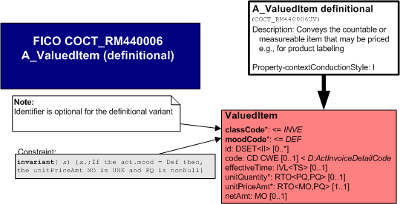
| Parent: | None |
Note: This is the second Normative ballot of the A_ValuedItem CMET. There are several variants: universal, basic, minimal, definitional, informational, and identifiable.
Overview
This CMET is used to convey information related to a ValuedItem in terms of its measurable or countable units. All Variants may include pricing information needed to calculate the net amount. In the minimal, basic, and universal variants, the ValuedItem may be composed of one or more ValuedUnitItems, which may or may not be priced. The universal and basic variants include coverage related information such as charges, financial participation, fee schedule, and coverage policies such as the health status of the subject of care that is conveyed in the A_Benefit CMET.
The identified variant is used to convey the identity of the ValuedItem information in the definition mood. The identifier is mandatory for the identified variant.
The definitional variant is used to convey the identity of the ValuedItem information in the definition mood. The identifier is optional for this variant.
The informational variant is used to convey the ValuedItem information in the definition or event mood. The identifier is required for this variant.
The minimal variant is used to convey optionally identifiable ValuedItem information in the definition or event mood, which may be composed of ValuedUnitItems.
The basic variant may include association to policy or program benefits to which it pertains, which are conveyed in the A_Benefit (basic) CMET COCT_MT770005UV.
The universal variant is used to convey more extensive ValuedItem information typical of knowledge base and payer benefit repository records.
How the ValuedUnitItem is used to compose a ValuedItem: A DME provider prices the frame and "add-on" components required to meet health needs of the patient. Component ValuedUnitItems may convey the InvoiceDetailCode for DME, e.g., UPC codes, and the unitPriceAmt for each part. For example, a DME provider prices the frame and "add-on" components required to meet health needs of the patient. Component ValuedUnitItems may convey the InvoiceDetailCode for DME, e.g., UPC codes, and the unitPriceAmt for each part. For an example see: DME_Table.doc
How Pricing is used:For each variant, one and only one ValuedItem is required to be sent. For the basic and universal variant, one or more ValuedUnitItem may be sent. If the act.mood of the ValuedItem or any ValuedUnitItems is in definition mood, the price may be as yet unspecified. In this case, the MO numerator for unspecified price is constrained to "UNK" for "unknown"; the PQ property denominator must be nonNull; and the netAmt is not valued. For example, in the case of product labeling, only the valued countable or measurable item is defined, but the price per unit or net amount is not yet determined.
If ValuedItem is in event mood and no ValuedUnitItem is sent, then the ValuedItem netAmt must be sent as the product of the ValuedItem unitPricedAmt and unitQuantity.
See Foundation Section 3.1.12 Class: InvoiceElement (in Acts) "For leaf-level amounts, this will be the value of the unitQuantity * unitPriceAmt [ * factorNumber] [* pointsNumber]. For grouping invoice elements, this will be the sum of the netAmt attributes of all contained InvoiceElements http://hl7.org/v3ballot/html/infrastructure/rim/rim.htm#InvoiceElement-cls
If any ValuedUnitItem act.mood is event, then the ValuedItem act.mood must be event. In this case, any ValuedUnitItem unitQuantity and unitPriceAmt attributes must be nonNull, and the ValuedUnitItem netAmt must be the product of these attributes. In addition, the ValuedItem netAmt must be the sum of any ValuedUnitItem netAmts. Since a ValuedItem unitPriceAmt is required to be sent, the MO numerator and PQ denominator must either both be UNK; or MO numerator must be equal to the ValuedItem netAmt and the PQ denominator must have a fixed value of 1.
NOTE: The RTO is NI because the MO numerator for unspecified price is set to "UNK" for "unknown" while the PQ denominator is nonNull. However, because RTO is NI, to ensure that there is information contained in the ratio, the unitPriceAmt is required with cardinality of 1...1. Thus:
<value xsi:type="RTO" nullFlavor="NI"> <numerator xsi:type="MO" nullFlavor="UNK"/> <denominator xsi:type="PQ" value="50" unit="mg"/> </value>
For more information see http://hl7.org/v3ballot/html/infrastructure/itsxml/datatypes-its-xml.htm#dtimpl-RTO
For more information on the derivation of CMET variants, see Refinement, Constraint and Localization, Release 2 Section 2.4.2 Common Message Element Types (CMETs) http://hl7.org/v3ballot/html/infrastructure/constraints/constraints.htm
Walk-through
ValuedItem
The ValuedItem classCode INVE: The focal class indicates the countable or measurable item (e.g., a product, device, or service) that may be or has been priced.
The ValuedItem moodCodeDEF: The ValuedItem is something that may be or has been priced.
The ValuedItem id: Optionally identifies an instance of ValuedItem information, e.g. as used on a particular product label.
The ValuedItem code from the ActInvoiceDetailCode concept domain, to which value set may be bound to provide specific information about the type of items that that may be or has been priced. For example, if the ActInvoiceDetailDrugProduct sub-concept domain is used, then the value set could include NDC, UPC or GTIN. When this code is the same as the code on a class in the base model to which this CMET is associated, do not valued this attribute or ensure that the codes are the same. For example, a Medication message may include the NDC code used in this CMET's attribute in an Entity class describing the drug.
The ValuedItem effectiveTime indicates the time during which ValuedItem information is effective.
The ValuedItem unitQuantityRTO<PQ,PQ> specifies the units by which the ValuedItem is measured or counted, and quantifies the countable or measurable ValuedItem instances. Required to be sent if known. The PQ units and values are aligned with the type of ValuedItem specified by the value set or coding system bound to the ValuedItem InvoiceDetailCode or its child concept domain.
For example, if the ActInvoiceDetailDrugCode is bound to the NDC codes, then the PQ unit value set is the NCPDP Billing Unit Standard http://www.ncpdp.org/PDF/Basic_guide_to_standards.pdf. For more information see Foundation Section 3.1.12.2 InvoiceElement.unitQuantity: RTO<PQ,PQ> (0..1).
One and only one ValuedItem unitPriceAmtRTO<MO,PQ> is required to be sent to quantify the ratio of the price per countable or measurable instance of an item that may be or has been priced. If the act.mood of the ValuedItem is in definition mood, the price may be as yet unspecified. In this case, the MO numerator for unspecified price is constrained to "UNK" for "unknown"; the PQ denominator must be nonNull; and the netAmt is not valued. For example, in the case of product labeling, only the valued countable or measurable item is defined, but the price per unit or net amount is not yet determined.
The ValuedItem netAmtMO may be sent to express the product of the ValuedItem unitQuantity and the unitPriceAmt. If the unitPriceAmt MO is UNK, then the netAmt is UNK or not sent. If any ValuedUnitItem act.mood is event, then the ValuedItem act.mood must be event. In this case, any ValuedUnitItem unitQuantity and unitPriceAmt attributes must be nonNull, and the ValuedUnitItem netAmt must be the product of these attributes. In addition, the ValuedItem netAmt must be the sum of any ValuedUnitItem netAmts. Since a ValuedItem unitPriceAmt is required to be sent, the MO numerator and PQ denominator must either be both be UNK; or MO numerator must be equal to the ValuedItem netAmt and the PQ denominator must have a fixed value of '1'.
The ValuedItem factorNumberREAL may be sent to represent a multiplier used in determining the overall cost of services delivered and/or goods received. The concept of a Factor allows for a discount or surcharge multiplier to be applied to a monetary amount. For example, the formula, with a factor would be: unitQuantity * unitPrice (Cost/Point) * factorNumber = netAmt.
The ValuedItem pointNumberMO may be sent to express the weighting (based on difficulty, cost and/or resource intensiveness) associated with the good or service delivered. The concept of Points allows for assignment of point values for services and/or goods, such that a monetary amount can be assigned to each point. For example, the formula, with points would be: unitQuantity * pointsNumber * unitPriceAmt (Cost/Point) = netAmt.
For more information see Foundation Section 3.1.12
| A_ValuedItem definitional | COCT_MT440006UV09 |
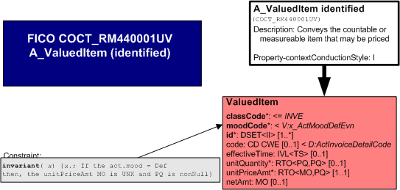
| Parent: | None |
Note: This is the second Normative ballot of the A_ValuedItem CMET. There are several variants: universal, basic, minimal, definitional, informational, and identifiable.
Overview
This CMET is used to convey information related to a ValuedItem in terms of its measurable or countable units. All Variants may include pricing information needed to calculate the net amount. In the minimal, basic, and universal variants, the ValuedItem may be composed of one or more ValuedUnitItems, which may or may not be priced. The universal and basic variants include coverage related information such as charges, financial participation, fee schedule, and coverage policies such as the health status of the subject of care that is conveyed in the A_Benefit CMET.
The identified variant is used to convey the identity of the ValuedItem information in the definition mood. The identifier is mandatory for the identified variant.
The definitional variant is used to convey the identity of the ValuedItem information in the definition mood. The identifier is optional for this variant.
The informational variant is used to convey the ValuedItem information in the definition or event mood. The identifier is required for this variant.
The minimal variant is used to convey optionally identifiable ValuedItem information in the definition or event mood, which may be composed of ValuedUnitItems.
The basic variant may include association to policy or program benefits to which it pertains, which are conveyed in the A_Benefit (basic) CMET COCT_MT770005UV.
The universal variant is used to convey more extensive ValuedItem information typical of knowledge base and payer benefit repository records.
How the ValuedUnitItem is used to compose a ValuedItem: A DME provider prices the frame and "add-on" components required to meet health needs of the patient. Component ValuedUnitItems may convey the InvoiceDetailCode for DME, e.g., UPC codes, and the unitPriceAmt for each part. For example, a DME provider prices the frame and "add-on" components required to meet health needs of the patient. Component ValuedUnitItems may convey the InvoiceDetailCode for DME, e.g., UPC codes, and the unitPriceAmt for each part. For an example see: DME_Table.doc
How Pricing is used:For each variant, one and only one ValuedItem is required to be sent. For the basic and universal variant, one or more ValuedUnitItem may be sent. If the act.mood of the ValuedItem or any ValuedUnitItems is in definition mood, the price may be as yet unspecified. In this case, the MO numerator for unspecified price is constrained to "UNK" for "unknown"; the PQ property denominator must be nonNull; and the netAmt is not valued. For example, in the case of product labeling, only the valued countable or measurable item is defined, but the price per unit or net amount is not yet determined.
If ValuedItem is in event mood and no ValuedUnitItem is sent, then the ValuedItem netAmt must be sent as the product of the ValuedItem unitPricedAmt and unitQuantity.
See Foundation Section 3.1.12 Class: InvoiceElement (in Acts) "For leaf-level amounts, this will be the value of the unitQuantity * unitPriceAmt [ * factorNumber] [* pointsNumber]. For grouping invoice elements, this will be the sum of the netAmt attributes of all contained InvoiceElements http://hl7.org/v3ballot/html/infrastructure/rim/rim.htm#InvoiceElement-cls
If any ValuedUnitItem act.mood is event, then the ValuedItem act.mood must be event. In this case, any ValuedUnitItem unitQuantity and unitPriceAmt attributes must be nonNull, and the ValuedUnitItem netAmt must be the product of these attributes. In addition, the ValuedItem netAmt must be the sum of any ValuedUnitItem netAmts. Since a ValuedItem unitPriceAmt is required to be sent, the MO numerator and PQ denominator must either both be UNK; or MO numerator must be equal to the ValuedItem netAmt and the PQ denominator must have a fixed value of 1.
NOTE: The RTO is NI because the MO numerator for unspecified price is set to "UNK" for "unknown" while the PQ denominator is nonNull. However, because RTO is NI, to ensure that there is information contained in the ratio, the unitPriceAmt is required with cardinality of 1...1. Thus:
<value xsi:type="RTO" nullFlavor="NI"> <numerator xsi:type="MO" nullFlavor="UNK"/> <denominator xsi:type="PQ" value="50" unit="mg"/> </value>
For more information see http://hl7.org/v3ballot/html/infrastructure/itsxml/datatypes-its-xml.htm#dtimpl-RTO
For more information on the derivation of CMET variants, see Refinement, Constraint and Localization, Release 2 Section 2.4.2 Common Message Element Types (CMETs) http://hl7.org/v3ballot/html/infrastructure/constraints/constraints.htm
Walk-through
ValuedItem
The ValuedItem classCode INVE: The focal class indicates the countable or measurable item (e.g., a product, device, or service) that may be or has been priced.
The ValuedItem moodCodeActMoodDefEvn: The ValuedItem is something that may be or has been priced.
The ValuedItem id: Shall be used to identify an instance of ValuedItem information, e.g. as used on a particular product label.
The ValuedItem code from the ActInvoiceDetailCode concept domain, to which value set may be bound to provide specific information about the type of items that that may be or has been priced. For example, if the ActInvoiceDetailDrugProduct sub-concept domain is used, then the value set could include NDC, UPC or GTIN. When this code is the same as the code on a class in the base model to which this CMET is associated, do not valued this attribute or ensure that the codes are the same. For example, a Medication message may include the NDC code used in this CMET's attribute in an Entity class describing the drug.
The ValuedItem effectiveTime indicates the time during which ValuedItem information is effective.
The ValuedItem unitQuantityRTO<PQ,PQ> specifies the units by which the ValuedItem is measured or counted, and quantifies the countable or measurable ValuedItem instances. Required to be sent if known. The PQ units and values are aligned with the type of ValuedItem specified by the value set or coding system bound to the ValuedItem InvoiceDetailCode or its child concept domain.
For example, if the ActInvoiceDetailDrugCode is bound to the NDC codes, then the PQ unit value set is the NCPDP Billing Unit Standard http://www.ncpdp.org/PDF/Basic_guide_to_standards.pdf. For more information see Foundation Section 3.1.12.2 InvoiceElement.unitQuantity: RTO<PQ,PQ> (0..1).
One and only one ValuedItem unitPriceAmtRTO<MO,PQ> is required to be sent to quantify the ratio of the price per countable or measurable instance of an item that may be or has been priced. If the act.mood of the ValuedItem is in definition mood, the price may be as yet unspecified. In this case, the MO numerator for unspecified price is constrained to "UNK" for "unknown"; the PQ denominator must be nonNull; and the netAmt is not valued. For example, in the case of product labeling, only the valued countable or measurable item is defined, but the price per unit or net amount is not yet determined.
The ValuedItem netAmtMO may be sent to express the product of the ValuedItem unitQuantity and the unitPriceAmt. If the unitPriceAmt MO is UNK, then the netAmt is UNK or not sent. If any ValuedUnitItem act.mood is event, then the ValuedItem act.mood must be event. In this case, any ValuedUnitItem unitQuantity and unitPriceAmt attributes must be nonNull, and the ValuedUnitItem netAmt must be the product of these attributes. In addition, the ValuedItem netAmt must be the sum of any ValuedUnitItem netAmts. Since a ValuedItem unitPriceAmt is required to be sent, the MO numerator and PQ denominator must either be both be UNK; or MO numerator must be equal to the ValuedItem netAmt and the PQ denominator must have a fixed value of '1'.
The ValuedItem factorNumberREAL may be sent to represent a multiplier used in determining the overall cost of services delivered and/or goods received. The concept of a Factor allows for a discount or surcharge multiplier to be applied to a monetary amount. For example, the formula, with a factor would be: unitQuantity * unitPrice (Cost/Point) * factorNumber = netAmt.
The ValuedItem pointNumberMO may be sent to express the weighting (based on difficulty, cost and/or resource intensiveness) associated with the good or service delivered. The concept of Points allows for assignment of point values for services and/or goods, such that a monetary amount can be assigned to each point. For example, the formula, with points would be: unitQuantity * pointsNumber * unitPriceAmt (Cost/Point) = netAmt.
For more information see Foundation Section 3.1.12
| A_ValuedItem identified | COCT_MT440001UV09 |
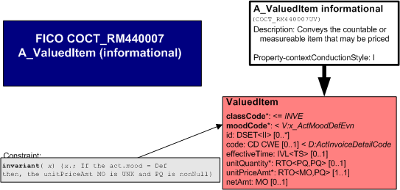
| Parent: | None |
Note: This is the second Normative ballot of the A_ValuedItem CMET. There are several variants: universal, basic, minimal, definitional, informational, and identifiable.
Overview
This CMET is used to convey information related to a ValuedItem in terms of its measurable or countable units. All Variants may include pricing information needed to calculate the net amount. In the minimal, basic, and universal variants, the ValuedItem may be composed of one or more ValuedUnitItems, which may or may not be priced. The universal and basic variants include coverage related information such as charges, financial participation, fee schedule, and coverage policies such as the health status of the subject of care that is conveyed in the A_Benefit CMET.
The identified variant is used to convey the identity of the ValuedItem information in the definition mood. The identifier is mandatory for the identified variant.
The definitional variant is used to convey the identity of the ValuedItem information in the definition mood. The identifier is optional for this variant.
The informational variant is used to convey the ValuedItem information in the definition or event mood. The identifier is required for this variant.
The minimal variant is used to convey optionally identifiable ValuedItem information in the definition or event mood, which may be composed of ValuedUnitItems.
The basic variant may include association to policy or program benefits to which it pertains, which are conveyed in the A_Benefit (basic) CMET COCT_MT770005UV.
The universal variant is used to convey more extensive ValuedItem information typical of knowledge base and payer benefit repository records.
How the ValuedUnitItem is used to compose a ValuedItem: A DME provider prices the frame and "add-on" components required to meet health needs of the patient. Component ValuedUnitItems may convey the InvoiceDetailCode for DME, e.g., UPC codes, and the unitPriceAmt for each part. For example, a DME provider prices the frame and "add-on" components required to meet health needs of the patient. Component ValuedUnitItems may convey the InvoiceDetailCode for DME, e.g., UPC codes, and the unitPriceAmt for each part. For an example see: DME_Table.doc
How Pricing is used:For each variant, one and only one ValuedItem is required to be sent. For the basic and universal variant, one or more ValuedUnitItem may be sent. If the act.mood of the ValuedItem or any ValuedUnitItems is in definition mood, the price may be as yet unspecified. In this case, the MO numerator for unspecified price is constrained to "UNK" for "unknown"; the PQ property denominator must be nonNull; and the netAmt is not valued. For example, in the case of product labeling, only the valued countable or measurable item is defined, but the price per unit or net amount is not yet determined.
If ValuedItem is in event mood and no ValuedUnitItem is sent, then the ValuedItem netAmt must be sent as the product of the ValuedItem unitPricedAmt and unitQuantity.
See Foundation Section 3.1.12 Class: InvoiceElement (in Acts) "For leaf-level amounts, this will be the value of the unitQuantity * unitPriceAmt [ * factorNumber] [* pointsNumber]. For grouping invoice elements, this will be the sum of the netAmt attributes of all contained InvoiceElements http://hl7.org/v3ballot/html/infrastructure/rim/rim.htm#InvoiceElement-cls
If any ValuedUnitItem act.mood is event, then the ValuedItem act.mood must be event. In this case, any ValuedUnitItem unitQuantity and unitPriceAmt attributes must be nonNull, and the ValuedUnitItem netAmt must be the product of these attributes. In addition, the ValuedItem netAmt must be the sum of any ValuedUnitItem netAmts. Since a ValuedItem unitPriceAmt is required to be sent, the MO numerator and PQ denominator must either both be UNK; or MO numerator must be equal to the ValuedItem netAmt and the PQ denominator must have a fixed value of 1.
NOTE: The RTO is NI because the MO numerator for unspecified price is set to "UNK" for "unknown" while the PQ denominator is nonNull. However, because RTO is NI, to ensure that there is information contained in the ratio, the unitPriceAmt is required with cardinality of 1...1. Thus:
<value xsi:type="RTO" nullFlavor="NI"> <numerator xsi:type="MO" nullFlavor="UNK"/> <denominator xsi:type="PQ" value="50" unit="mg"/> </value>
For more information see http://hl7.org/v3ballot/html/infrastructure/itsxml/datatypes-its-xml.htm#dtimpl-RTO
For more information on the derivation of CMET variants, see Refinement, Constraint and Localization, Release 2 Section 2.4.2 Common Message Element Types (CMETs) http://hl7.org/v3ballot/html/infrastructure/constraints/constraints.htm
Walk-through
ValuedItem
The ValuedItem classCode INVE: The focal class indicates the countable or measurable item (e.g., a product, device, or service) that may be or has been priced.
The ValuedItem moodCodeActMoodDefEvn: The ValuedItem is something that may be or has been priced.
The ValuedItem id: Optionally identifies an instance of ValuedItem information, e.g. as used on a particular product label.
The ValuedItem code from the ActInvoiceDetailCode concept domain, to which value set may be bound to provide specific information about the type of items that that may be or has been priced. For example, if the ActInvoiceDetailDrugProduct sub-concept domain is used, then the value set could include NDC, UPC or GTIN. When this code is the same as the code on a class in the base model to which this CMET is associated, do not valued this attribute or ensure that the codes are the same. For example, a Medication message may include the NDC code used in this CMET's attribute in an Entity class describing the drug.
The ValuedItem effectiveTime indicates the time during which ValuedItem information is effective.
The ValuedItem unitQuantityRTO<PQ,PQ> specifies the units by which the ValuedItem is measured or counted, and quantifies the countable or measurable ValuedItem instances. Required to be sent if known. The PQ units and values are aligned with the type of ValuedItem specified by the value set or coding system bound to the ValuedItem InvoiceDetailCode or its child concept domain.
For example, if the ActInvoiceDetailDrugCode is bound to the NDC codes, then the PQ unit value set is the NCPDP Billing Unit Standard http://www.ncpdp.org/PDF/Basic_guide_to_standards.pdf. For more information see Foundation Section 3.1.12.2 InvoiceElement.unitQuantity: RTO<PQ,PQ> (0..1).
One and only one ValuedItem unitPriceAmtRTO<MO,PQ> is required to be sent to quantify the ratio of the price per countable or measurable instance of an item that may be or has been priced. If the act.mood of the ValuedItem is in definition mood, the price may be as yet unspecified. In this case, the MO numerator for unspecified price is constrained to "UNK" for "unknown"; the PQ denominator must be nonNull; and the netAmt is not valued. For example, in the case of product labeling, only the valued countable or measurable item is defined, but the price per unit or net amount is not yet determined.
The ValuedItem netAmtMO may be sent to express the product of the ValuedItem unitQuantity and the unitPriceAmt. If the unitPriceAmt MO is UNK, then the netAmt is UNK or not sent. If any ValuedUnitItem act.mood is event, then the ValuedItem act.mood must be event. In this case, any ValuedUnitItem unitQuantity and unitPriceAmt attributes must be nonNull, and the ValuedUnitItem netAmt must be the product of these attributes. In addition, the ValuedItem netAmt must be the sum of any ValuedUnitItem netAmts. Since a ValuedItem unitPriceAmt is required to be sent, the MO numerator and PQ denominator must either be both be UNK; or MO numerator must be equal to the ValuedItem netAmt and the PQ denominator must have a fixed value of '1'.
The ValuedItem factorNumberREAL may be sent to represent a multiplier used in determining the overall cost of services delivered and/or goods received. The concept of a Factor allows for a discount or surcharge multiplier to be applied to a monetary amount. For example, the formula, with a factor would be: unitQuantity * unitPrice (Cost/Point) * factorNumber = netAmt.
The ValuedItem pointNumberMO may be sent to express the weighting (based on difficulty, cost and/or resource intensiveness) associated with the good or service delivered. The concept of Points allows for assignment of point values for services and/or goods, such that a monetary amount can be assigned to each point. For example, the formula, with points would be: unitQuantity * pointsNumber * unitPriceAmt (Cost/Point) = netAmt.
For more information see Foundation Section 3.1.12
| A_ValuedItem informational | COCT_MT440007UV09 |
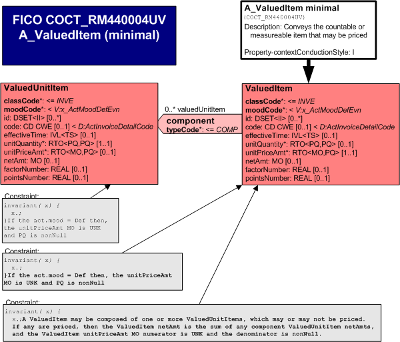
| Parent: | None |
Note: This is the second Normative ballot of the A_ValuedItem CMET. There are several variants: universal, basic, minimal, definitional, informational, and identifiable.
Overview
This CMET is used to convey information related to a ValuedItem in terms of its measurable or countable units. All Variants may include pricing information needed to calculate the net amount. In the minimal, basic, and universal variants, the ValuedItem may be composed of one or more ValuedUnitItems, which may or may not be priced. The universal and basic variants include coverage related information such as charges, financial participation, fee schedule, and coverage policies such as the health status of the subject of care that is conveyed in the A_Benefit CMET.
The identified variant is used to convey the identity of the ValuedItem information in the definition mood. The identifier is mandatory for the identified variant.
The definitional variant is used to convey the identity of the ValuedItem information in the definition mood. The identifier is optional for this variant.
The informational variant is used to convey the ValuedItem information in the definition or event mood. The identifier is required for this variant.
The minimal variant is used to convey optionally identifiable ValuedItem information in the definition or event mood, which may be composed of ValuedUnitItems.
The basic variant may include association to policy or program benefits to which it pertains, which are conveyed in the A_Benefit (basic) CMET COCT_MT770005UV.
The universal variant is used to convey more extensive ValuedItem information typical of knowledge base and payer benefit repository records.
How the ValuedUnitItem is used to compose a ValuedItem: A DME provider prices the frame and "add-on" components required to meet health needs of the patient. Component ValuedUnitItems may convey the InvoiceDetailCode for DME, e.g., UPC codes, and the unitPriceAmt for each part. For example, a DME provider prices the frame and "add-on" components required to meet health needs of the patient. Component ValuedUnitItems may convey the InvoiceDetailCode for DME, e.g., UPC codes, and the unitPriceAmt for each part. For an example see: DME_Table.doc
How Pricing is used:For each variant, one and only one ValuedItem is required to be sent. For the basic and universal variant, one or more ValuedUnitItem may be sent. If the act.mood of the ValuedItem or any ValuedUnitItems is in definition mood, the price may be as yet unspecified. In this case, the MO numerator for unspecified price is constrained to "UNK" for "unknown"; the PQ property denominator must be nonNull; and the netAmt is not valued. For example, in the case of product labeling, only the valued countable or measurable item is defined, but the price per unit or net amount is not yet determined.
If ValuedItem is in event mood and no ValuedUnitItem is sent, then the ValuedItem netAmt must be sent as the product of the ValuedItem unitPricedAmt and unitQuantity.
See Foundation Section 3.1.12 Class: InvoiceElement (in Acts) "For leaf-level amounts, this will be the value of the unitQuantity * unitPriceAmt [ * factorNumber] [* pointsNumber]. For grouping invoice elements, this will be the sum of the netAmt attributes of all contained InvoiceElements http://hl7.org/v3ballot/html/infrastructure/rim/rim.htm#InvoiceElement-cls
If any ValuedUnitItem act.mood is event, then the ValuedItem act.mood must be event. In this case, any ValuedUnitItem unitQuantity and unitPriceAmt attributes must be nonNull, and the ValuedUnitItem netAmt must be the product of these attributes. In addition, the ValuedItem netAmt must be the sum of any ValuedUnitItem netAmts. Since a ValuedItem unitPriceAmt is required to be sent, the MO numerator and PQ denominator must either both be UNK; or MO numerator must be equal to the ValuedItem netAmt and the PQ denominator must have a fixed value of 1.
NOTE: The RTO is NI because the MO numerator for unspecified price is set to "UNK" for "unknown" while the PQ denominator is nonNull. However, because RTO is NI, to ensure that there is information contained in the ratio, the unitPriceAmt is required with cardinality of 1...1. Thus:
<value xsi:type="RTO" nullFlavor="NI"> <numerator xsi:type="MO" nullFlavor="UNK"/> <denominator xsi:type="PQ" value="50" unit="mg"/> </value>
For more information see http://hl7.org/v3ballot/html/infrastructure/itsxml/datatypes-its-xml.htm#dtimpl-RTO
For more information on the derivation of CMET variants, see Refinement, Constraint and Localization, Release 2 Section 2.4.2 Common Message Element Types (CMETs) http://hl7.org/v3ballot/html/infrastructure/constraints/constraints.htm
Walk-through
ValuedItem
The ValuedItem classCode INVE: The focal class indicates the countable or measurable item (e.g., a product, device, or service) that may be or has been priced.
The ValuedItem moodCodeActMoodDefEvn: The ValuedItem is something that may be or has been priced.
The ValuedItem id: Optionally identifies an instance of ValuedItem information, e.g. as used on a particular product label.
The ValuedItem code from the ActInvoiceDetailCode concept domain, to which value set may be bound to provide specific information about the type of items that that may be or has been priced. For example, if the ActInvoiceDetailDrugProduct sub-concept domain is used, then the value set could include NDC, UPC or GTIN. When this code is the same as the code on a class in the base model to which this CMET is associated, do not valued this attribute or ensure that the codes are the same. For example, a Medication message may include the NDC code used in this CMET's attribute in an Entity class describing the drug.
The ValuedItem effectiveTime indicates the time during which ValuedItem information is effective.
The ValuedItem unitQuantityRTO<PQ,PQ> specifies the units by which the ValuedItem is measured or counted, and quantifies the countable or measurable ValuedItem instances. Required to be sent if known. The PQ units and values are aligned with the type of ValuedItem specified by the value set or coding system bound to the ValuedItem InvoiceDetailCode or its child concept domain.
For example, if the ActInvoiceDetailDrugCode is bound to the NDC codes, then the PQ unit value set is the NCPDP Billing Unit Standard http://www.ncpdp.org/PDF/Basic_guide_to_standards.pdf. For more information see Foundation Section 3.1.12.2 InvoiceElement.unitQuantity: RTO<PQ,PQ> (0..1).
One and only one ValuedItem unitPriceAmtRTO<MO,PQ> is required to be sent to quantify the ratio of the price per countable or measurable instance of an item that may be or has been priced. If the act.mood of the ValuedItem is in definition mood, the price may be as yet unspecified. In this case, the MO numerator for unspecified price is constrained to "UNK" for "unknown"; the PQ denominator must be nonNull; and the netAmt is not valued. For example, in the case of product labeling, only the valued countable or measurable item is defined, but the price per unit or net amount is not yet determined.
The ValuedItem netAmtMO may be sent to express the product of the ValuedItem unitQuantity and the unitPriceAmt. If the unitPriceAmt MO is UNK, then the netAmt is UNK or not sent. If any ValuedUnitItem act.mood is event, then the ValuedItem act.mood must be event. In this case, any ValuedUnitItem unitQuantity and unitPriceAmt attributes must be nonNull, and the ValuedUnitItem netAmt must be the product of these attributes. In addition, the ValuedItem netAmt must be the sum of any ValuedUnitItem netAmts. Since a ValuedItem unitPriceAmt is required to be sent, the MO numerator and PQ denominator must either be both be UNK; or MO numerator must be equal to the ValuedItem netAmt and the PQ denominator must have a fixed value of '1'.
The ValuedItem factorNumberREAL may be sent to represent a multiplier used in determining the overall cost of services delivered and/or goods received. The concept of a Factor allows for a discount or surcharge multiplier to be applied to a monetary amount. For example, the formula, with a factor would be: unitQuantity * unitPrice (Cost/Point) * factorNumber = netAmt.
The ValuedItem pointNumberMO may be sent to express the weighting (based on difficulty, cost and/or resource intensiveness) associated with the good or service delivered. The concept of Points allows for assignment of point values for services and/or goods, such that a monetary amount can be assigned to each point. For example, the formula, with points would be: unitQuantity * pointsNumber * unitPriceAmt (Cost/Point) = netAmt.
For more information see Foundation Section 3.1.12
The ActRelationship typeCode COMP: The ValuedItem may be linked to zero or more ValuedUnitItems. The component association indicates that the ValuedItem may be comprised of one or more ValuedUnitItems, which may or may not be priced.
Constraint: If any ValuedUnitItems are priced, then theValuedItem netAmount is the sum of these component prices, and the ValuedItem unitPriceAmt must not be valued .
ValuedUnitItem
ValuedUnitItem classCode INVE: The focal class indicates the countable or measurable unit item (e.g., a product, device, or service) that are components to a ValuedItem. A ValuedUnitItem may be or has been priced.
The ValuedUnitItem moodCode: The mood of this act is ActMoodDefEvn, that is, a ValuedUnitItem is something that may be or has been priced.
The ValuedUnitItem id: Optionally identifies an instance of ValuedUnitItem information, e.g. as used on a particular product label.
The ValuedUnitItem code from the ActInvoiceDetailCode concept domain, to which value set may be bound to provide specific information about the type of unit items that that may be or has been priced. For example, if the ActInvoiceDetailDrugProduct sub-concept domain is used, then the value set could include NDC, UPC or GTIN. When this code is the same as the code on a class in the base model to which this CMET is associated, do not valued this attribute or ensure that the codes are the same. For example, a Medication message may include the NDC code used in this CMET's attribute in an Entity class describing the drug.
The ValuedUnitItem effectiveTime indicates the time during which ValuedItem information is effective.
The ValuedUnitItem unitQuantityRTO<PQ,PQ> specifies the units by which the ValuedUnitItem is measured or counted, and quantifies the countable or measurable ValuedItem instances. Required to be sent if known. The PQ units and values are aligned with the type of ValuedUnitItem specified by the value set or coding system bound to the ValuedItem InvoiceDetailCode or its child concept domain.
For example, if the ActInvoiceDetailDrugCode is bound to the NDC codes, then the PQ unit value set is the NCPDP Billing Unit Standard http://www.ncpdp.org/PDF/Basic_guide_to_standards.pdf. For more information see Foundation Section 3.1.12.2 InvoiceElement.unitQuantity: RTO<PQ,PQ> (0..1)
One and only one ValuedUnitItem unitPriceAmtRTO<MO,PQ> is required to be sent to quantify the ratio of the price per countable or measurable instance of an item that may be or has been priced. If the act.mood of the ValuedUnitItem is in definition mood, the price may be as yet unspecified. In this case, the MO numerator for unspecified price is constrained to "UNK" for "unknown"; the PQ denominator must be nonNull; and the netAmt is not valued. For example, in the case of product labeling, only the valued countable or measurable item is defined, but the price per unit or net amount is not yet determined.
The ValuedUnitItem netAmtMO may be sent to express the product of the ValuedUnitItem unitQuantity and the unitPriceAmt. If the unitPriceAmt MO numerator is UNK, then the netAmt is UNK or not sent.
The ValuedUnitItem factorNumberREAL may be sent to represent a multiplier used in determining the overall cost of services delivered and/or goods received. The concept of a Factor allows for a discount or surcharge multiplier to be applied to a monetary amount. For example, the formula, with a factor would be: unitQuantity * unitPrice (Cost/Point) * factorNumber = netAmt.
The ValuedUnitItem pointNumberMO may be sent to express the weighting (based on difficulty, cost and/or resource intensiveness) associated with the good or service delivered. The concept of Points allows for assignment of point values for services and/or goods, such that a monetary amount can be assigned to each point. For example, the formula, with points would be: unitQuantity * pointsNumber * unitPriceAmt (Cost/Point) = netAmt.
| A_ValuedItem minimal | COCT_MT440004UV09 |
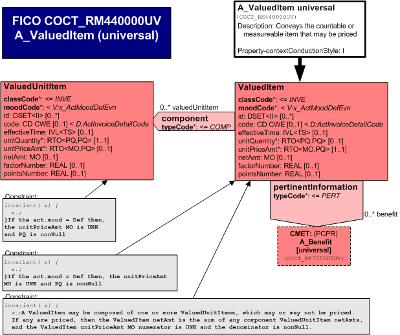
| Parent: | None |
Note: This is the second Normative ballot of the A_ValuedItem CMET. There are several variants: universal, basic, minimal, definitional, informational, and identifiable.
Overview
This CMET is used to convey information related to a ValuedItem in terms of its measurable or countable units. All Variants may include pricing information needed to calculate the net amount. In the minimal, basic, and universal variants, the ValuedItem may be composed of one or more ValuedUnitItems, which may or may not be priced. The universal and basic variants include coverage related information such as charges, financial participation, fee schedule, and coverage policies such as the health status of the subject of care that is conveyed in the A_Benefit CMET.
The identified variant is used to convey the identity of the ValuedItem information in the definition mood. The identifier is mandatory for the identified variant.
The definitional variant is used to convey the identity of the ValuedItem information in the definition mood. The identifier is optional for this variant.
The informational variant is used to convey the ValuedItem information in the definition or event mood. The identifier is required for this variant.
The minimal variant is used to convey optionally identifiable ValuedItem information in the definition or event mood, which may be composed of ValuedUnitItems.
The basic variant may include association to policy or program benefits to which it pertains, which are conveyed in the A_Benefit (basic) CMET COCT_MT770005UV.
The universal variant is used to convey more extensive ValuedItem information typical of knowledge base and payer benefit repository records.
How the ValuedUnitItem is used to compose a ValuedItem: A DME provider prices the frame and "add-on" components required to meet health needs of the patient. Component ValuedUnitItems may convey the InvoiceDetailCode for DME, e.g., UPC codes, and the unitPriceAmt for each part. For example, a DME provider prices the frame and "add-on" components required to meet health needs of the patient. Component ValuedUnitItems may convey the InvoiceDetailCode for DME, e.g., UPC codes, and the unitPriceAmt for each part. For an example see: DME_Table.doc
How Pricing is used:For each variant, one and only one ValuedItem is required to be sent. For the basic and universal variant, one or more ValuedUnitItem may be sent. If the act.mood of the ValuedItem or any ValuedUnitItems is in definition mood, the price may be as yet unspecified. In this case, the MO numerator for unspecified price is constrained to "UNK" for "unknown"; the PQ property denominator must be nonNull; and the netAmt is not valued. For example, in the case of product labeling, only the valued countable or measurable item is defined, but the price per unit or net amount is not yet determined.
If ValuedItem is in event mood and no ValuedUnitItem is sent, then the ValuedItem netAmt must be sent as the product of the ValuedItem unitPricedAmt and unitQuantity.
See Foundation Section 3.1.12 Class: InvoiceElement (in Acts) "For leaf-level amounts, this will be the value of the unitQuantity * unitPriceAmt [ * factorNumber] [* pointsNumber]. For grouping invoice elements, this will be the sum of the netAmt attributes of all contained InvoiceElements http://hl7.org/v3ballot/html/infrastructure/rim/rim.htm#InvoiceElement-cls
If any ValuedUnitItem act.mood is event, then the ValuedItem act.mood must be event. In this case, any ValuedUnitItem unitQuantity and unitPriceAmt attributes must be nonNull, and the ValuedUnitItem netAmt must be the product of these attributes. In addition, the ValuedItem netAmt must be the sum of any ValuedUnitItem netAmts. Since a ValuedItem unitPriceAmt is required to be sent, the MO numerator and PQ denominator must either both be UNK; or MO numerator must be equal to the ValuedItem netAmt and the PQ denominator must have a fixed value of 1.
NOTE: The RTO is NI because the MO numerator for unspecified price is set to "UNK" for "unknown" while the PQ denominator is nonNull. However, because RTO is NI, to ensure that there is information contained in the ratio, the unitPriceAmt is required with cardinality of 1...1. Thus:
<value xsi:type="RTO" nullFlavor="NI"> <numerator xsi:type="MO" nullFlavor="UNK"/> <denominator xsi:type="PQ" value="50" unit="mg"/> </value>
For more information see http://hl7.org/v3ballot/html/infrastructure/itsxml/datatypes-its-xml.htm#dtimpl-RTO
For more information on the derivation of CMET variants, see Refinement, Constraint and Localization, Release 2 Section 2.4.2 Common Message Element Types (CMETs) http://hl7.org/v3ballot/html/infrastructure/constraints/constraints.htm
Walk-through
ValuedItem
The ValuedItem classCode INVE: The focal class indicates the countable or measurable item (e.g., a product, device, or service) that may be or has been priced.
The ValuedItem moodCodeActMoodDefEvn: The ValuedItem is something that may be or has been priced.
The ValuedItem id: Optionally identifies an instance of ValuedItem information, e.g. as used on a particular product label.
The ValuedItem code from the ActInvoiceDetailCode concept domain, to which value set may be bound to provide specific information about the type of items that that may be or has been priced. For example, if the ActInvoiceDetailDrugProduct sub-concept domain is used, then the value set could include NDC, UPC or GTIN. When this code is the same as the code on a class in the base model to which this CMET is associated, do not valued this attribute or ensure that the codes are the same. For example, a Medication message may include the NDC code used in this CMET's attribute in an Entity class describing the drug.
The ValuedItem effectiveTime indicates the time during which ValuedItem information is effective.
The ValuedItem unitQuantityRTO<PQ,PQ> specifies the units by which the ValuedItem is measured or counted, and quantifies the countable or measurable ValuedItem instances. Required to be sent if known. The PQ units and values are aligned with the type of ValuedItem specified by the value set or coding system bound to the ValuedItem InvoiceDetailCode or its child concept domain.
For example, if the ActInvoiceDetailDrugCode is bound to the NDC codes, then the PQ unit value set is the NCPDP Billing Unit Standard http://www.ncpdp.org/PDF/Basic_guide_to_standards.pdf. For more information see Foundation Section 3.1.12.2 InvoiceElement.unitQuantity: RTO<PQ,PQ> (0..1).
One and only one ValuedItem unitPriceAmtRTO<MO,PQ> is required to be sent to quantify the ratio of the price per countable or measurable instance of an item that may be or has been priced. If the act.mood of the ValuedItem is in definition mood, the price may be as yet unspecified. In this case, the MO numerator for unspecified price is constrained to "UNK" for "unknown"; the PQ denominator must be nonNull; and the netAmt is not valued. For example, in the case of product labeling, only the valued countable or measurable item is defined, but the price per unit or net amount is not yet determined.
The ValuedItem netAmtMO may be sent to express the product of the ValuedItem unitQuantity and the unitPriceAmt. If the unitPriceAmt MO is UNK, then the netAmt is UNK or not sent. If any ValuedUnitItem act.mood is event, then the ValuedItem act.mood must be event. In this case, any ValuedUnitItem unitQuantity and unitPriceAmt attributes must be nonNull, and the ValuedUnitItem netAmt must be the product of these attributes. In addition, the ValuedItem netAmt must be the sum of any ValuedUnitItem netAmts. Since a ValuedItem unitPriceAmt is required to be sent, the MO numerator and PQ denominator must either be both be UNK; or MO numerator must be equal to the ValuedItem netAmt and the PQ denominator must have a fixed value of '1'.
The ValuedItem factorNumberREAL may be sent to represent a multiplier used in determining the overall cost of services delivered and/or goods received. The concept of a Factor allows for a discount or surcharge multiplier to be applied to a monetary amount. For example, the formula, with a factor would be: unitQuantity * unitPrice (Cost/Point) * factorNumber = netAmt.
The ValuedItem pointNumberMO may be sent to express the weighting (based on difficulty, cost and/or resource intensiveness) associated with the good or service delivered. The concept of Points allows for assignment of point values for services and/or goods, such that a monetary amount can be assigned to each point. For example, the formula, with points would be: unitQuantity * pointsNumber * unitPriceAmt (Cost/Point) = netAmt.
For more information see Foundation Section 3.1.12
The ActRelationship typeCode COMP: The ValuedItem may be linked to zero or more ValuedUnitItems. The component association indicates that the ValuedItem may be comprised of one or more ValuedUnitItems, which may or may not be priced.
Constraint: If any ValuedUnitItems are priced, then theValuedItem netAmount is the sum of these component prices, and the ValuedItem unitPriceAmt must not be valued .
ValuedUnitItem
ValuedUnitItem classCode INVE: The focal class indicates the countable or measurable unit item (e.g., a product, device, or service) that are components to a ValuedItem. A ValuedUnitItem may be or has been priced.
The ValuedUnitItem moodCode: The mood of this act is ActMoodDefEvn, that is, a ValuedUnitItem is something that may be or has been priced.
The ValuedUnitItem id: Optionally identifies an instance of ValuedUnitItem information, e.g. as used on a particular product label.
The ValuedUnitItem code from the ActInvoiceDetailCode concept domain, to which value set may be bound to provide specific information about the type of unit items that that may be or has been priced. For example, if the ActInvoiceDetailDrugProduct sub-concept domain is used, then the value set could include NDC, UPC or GTIN. When this code is the same as the code on a class in the base model to which this CMET is associated, do not valued this attribute or ensure that the codes are the same. For example, a Medication message may include the NDC code used in this CMET's attribute in an Entity class describing the drug.
The ValuedUnitItem effectiveTime indicates the time during which ValuedItem information is effective.
The ValuedUnitItem unitQuantityRTO<PQ,PQ> specifies the units by which the ValuedUnitItem is measured or counted, and quantifies the countable or measurable ValuedItem instances. Required to be sent if known. The PQ units and values are aligned with the type of ValuedUnitItem specified by the value set or coding system bound to the ValuedItem InvoiceDetailCode or its child concept domain.
For example, if the ActInvoiceDetailDrugCode is bound to the NDC codes, then the PQ unit value set is the NCPDP Billing Unit Standard http://www.ncpdp.org/PDF/Basic_guide_to_standards.pdf. For more information see Foundation Section 3.1.12.2 InvoiceElement.unitQuantity: RTO<PQ,PQ> (0..1)
One and only one ValuedUnitItem unitPriceAmtRTO<MO,PQ> is required to be sent to quantify the ratio of the price per countable or measurable instance of an item that may be or has been priced. If the act.mood of the ValuedUnitItem is in definition mood, the price may be as yet unspecified. In this case, the MO numerator for unspecified price is constrained to "UNK" for "unknown"; the PQ denominator must be nonNull; and the netAmt is not valued. For example, in the case of product labeling, only the valued countable or measurable item is defined, but the price per unit or net amount is not yet determined.
The ValuedUnitItem netAmtMO may be sent to express the product of the ValuedUnitItem unitQuantity and the unitPriceAmt. If the unitPriceAmt MO numerator is UNK, then the netAmt is UNK or not sent.
The ValuedUnitItem factorNumberREAL may be sent to represent a multiplier used in determining the overall cost of services delivered and/or goods received. The concept of a Factor allows for a discount or surcharge multiplier to be applied to a monetary amount. For example, the formula, with a factor would be: unitQuantity * unitPrice (Cost/Point) * factorNumber = netAmt.
The ValuedUnitItem pointNumberMO may be sent to express the weighting (based on difficulty, cost and/or resource intensiveness) associated with the good or service delivered. The concept of Points allows for assignment of point values for services and/or goods, such that a monetary amount can be assigned to each point. For example, the formula, with points would be: unitQuantity * pointsNumber * unitPriceAmt (Cost/Point) = netAmt.
The ActRelationship typeCodePERT: The ValuedItem may be linked to zero or more A_Benefit (universal) CMET. The association indicates that the ValuedItem may pertain to zero or more benefits under a Program or Policy.
| A_BenefitUniversal | COCT_MT770000UV09 |
| A_ValuedItem universal | COCT_MT440000UV09 |

| Parent: | None |
Note: This is the first Normative ballot of the A_Benefit basic CMET. There is is also a universal variant.
Overview
The A_Benefit CMET is used to convey a benefit covered by a policy or program (P/P). The universal variant optionally includes financial information related to the provider contract and the covered party's financial participation in the cost of a health service or product. This is the basic variant which omits the financial information classes.
The Benefit is an act with a classCodePCPR: This class indicates a service provision benefit under a P/P, which may be further specified by associated acts, e.g., the benefit may have a supporting clinical statement about care provided or the condition of the subject of care as a precondition; may refer to coverage policies related to the provision of the benefit; or may be limited by the charges covered under a P/P or financial participations required of the covered party.
The Benefit id: Optionally identifies a benefit.
The Benefit moodCode: The mood of this act is ActMoodCompletionTrack, that is, a P/P Benefit is either something that is being provided, has been provided, can be provided, or is intended or requested to be provided.
The Benefit code: The type of benefit is required be specified by a code from the x_ActBillableCode value set if known. For example, medical, chiropractic, dental care, social work, hospice, long term care, ambulance, acupuncture, pharmacy, psychiatry, naturopathy, physical therapy, etc.
The Benefit effectiveTime: The effective date range for a benefit may be sent.
The Benefit reasonCode: These are the reasons or criteria specified by codes from the ActCoverageReason value set, relating to coverage of a benefit provided under a policy or program. May be used to convey reasons pertaining to coverage contractual provisions, e.g., relating to who may provide the benefit in order to effect coverage.
The Benefit precondition ActRelationshipType code PRCN: The Benefit may be associated to one or more A_SupportingClinicalStatement CMET, which convey the services that must be received as a precondition of coverage of the Benefit, e.g., a diagnostic test is required to validate the medical necessity of a procedure in order for that procedure to be a covered benefit under a P/P.
The Benefit reference ActRelationshipType code REFR: The Benefit may reference zero or more CoveragePolicy with an act classCodePOL, which conveys the coverage policy or policies that sets rules for the coverage of the Benefit charges and financial participations.
The CoveragePolicy moodCodeDEF: The mood of this act is Definition, that is, coverage for a Benefit is defined by the CoveragePolicy.
The CoveragePolicy id: One or more unique identifiers for the CoveragePolicy may be sent.
The CoveragePolicy ActCode: The type of policy is required to be specified if known by codes from the ActPolicyType value set.
The CoveragePolicy statusCode: The status of this CoveragePolicy, e.g., obsolete if this CoveragePolicy has been replaced but applied to a Benefit during the P/P effective time so as to be applicable to the coverage of a Benefit during that time span.
The CoveragePolicy effectiveTime: The effective date range for a coverage policy may be sent.
The CoveragePolicy reasonCode: These are the reasons or criteria for the CoveragePolicy specified by codes from the ActCoverageReason value set, e.g., coverage policy for a Benefit may be related to medical necessity or evidence that a drug is not being used "off-label" or a service is not an "experimental treatment".
| A_SupportingClinicalStatementUniversal | COCT_MT530000UV |
| A_Benefit basic | COCT_MT770005UV09 |
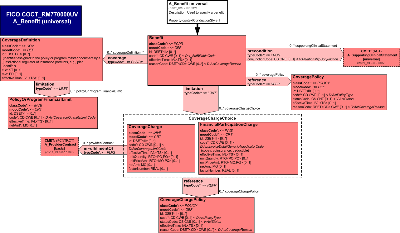
| Parent: | None |
Note: This is the first Normative ballot of the A_Benefit universal CMET. There is is also a basic variant.
Overview
The A_Benefit CMET is used to convey a benefit covered by a Policy or Program (P/P). The universal variant optionally includes financial information related to the provider contract and the covered party's financial participation in the cost of a health service or product.
The Benefit is an act with a classCodePCPR: This class indicates a service provision benefit under a P/P, which may be further specified by associated acts, e.g., the benefit may have a supporting clinical statement about care provided or the condition of the subject of care as a precondition; may refer to coverage policies related to the provision of the benefit; or may be limited by the charges covered under a P/P or financial participations required of the covered party.
The Benefit id: Optionally identifies a benefit.
The Benefit moodCode: The mood of this act is ActMoodCompletionTrack, that is, a P/P Benefit is either something that is being provided, has been provided, can be provided, or is intended or requested to be provided.
The Benefit code: The type of benefit is required be specified by a code from the x_ActBillableCode value set if known. For example, medical, chiropractic, dental care, social work, hospice, long term care, ambulance, acupuncture, pharmacy, psychiatry, naturopathy, physical therapy, etc.
The Benefit effectiveTime: The effective date range for a benefit may be sent.
The Benefit reasonCode: These are the reasons or criteria specified by codes from the ActCoverageReason value set, relating to coverage of a benefit provided under a policy or program. May be used to convey reasons pertaining to coverage contractual provisions, e.g., relating to who may provide the benefit in order to effect coverage.
The Benefit precondition ActRelationshipType code PRCN: The Benefit may be associated to one or more A_SupportingClinicalStatement CMET, which convey the services that must be received as a precondition of coverage of the Benefit, e.g., a diagnostic test is required to validate the medical necessity of a procedure in order for that procedure to be a covered benefit under a P/P.
The Benefit reference ActRelationshipType code REFR: The Benefit may reference zero or more CoveragePolicy with an act classCodePOL, which conveys the coverage policy or policies that sets rules for the coverage of the Benefit charges and financial participations.
The CoveragePolicy moodCodeDEF: The mood of this act is Definition, that is, coverage for a Benefit is defined by the CoveragePolicy.
The CoveragePolicy id: One or more unique identifiers for the CoveragePolicy may be sent.
The CoveragePolicy ActCode: The type of policy is required to be specified if known by codes from the ActPolicyType value set.
The CoveragePolicy statusCode: The status of this CoveragePolicy, e.g., obsolete if this CoveragePolicy has been replaced but applied to a Benefit during the P/P effective time so as to be applicable to the coverage of a Benefit during that time span.
The CoveragePolicy effectiveTime: The effective date range for a coverage policy may be sent.
The CoveragePolicy reasonCode: These are the reasons or criteria for the CoveragePolicy specified by codes from the ActCoverageReason value set, e.g., coverage policy for a Benefit may be related to medical necessity or evidence that a drug is not being used "off-label" or a service is not an "experimental treatment".
The Benefit limitation ActRelationshipType code LIMIT: The Benefit may be associated with zero or more CoverageChargeChoice acts, either CoverageCharge or FinancialParticipationCharge.
The CoverageCharge act classCodeINVE: This class indicates the rules relating to the charges for a benefit that a P/P will cover.
The CoverageCharge moodCodeCRT: The mood of this act is Criterion, which conveys the conditions that must be met for the charges related to the Benefit to be covered.
The CoverageCharge id: One or more unique identifiers for the CoverageCharge rule may be sent.
The CoverageCharge code: The type of coverage charge rule is required to be specified if known by codes from the ActCoverageLimitCode value set, e.g., the net amount, unit quantity, or unit price.
The CoverageCharge effectiveTime: The effective date range for a coverage charge rule.
The CoverageCharge unitQuantity conveys the ratio of units per service provision or product dispense, e.g., 2 hour session of physical therapy or 3 boxes of a product per dispense.
The CoverageCharge unitPriceAmt conveys the price per unit, e.g., $50 CAD/1{box} or $100 per hour of physical therapy.
The CoverageCharge netAmt is expressed using a currency {the unit in which monetary amounts are denominated in different economic regions] to express the net amount charged based on the product of applicable coverage charge unity quantity, unityPriceAmt, factorNumber and pointsNumber attributes.
The CoverageCharge factorNumber is the multiplier or percentage used to calculate the rate for each unitQuanitity/unitPriceAmt expressed with a Real integer, e.g., the out-of-network vs. the in-network percentage charge.
The FinancialParticipationCharge classCodeINVE: This class indicates the rules relating to the limits of charges for a benefit that a P/P will cover.
The FinancialParticipationCharge moodCodeCRT: The mood of this act is Criterion, which conveys the financial participation charges that the covered party must pay in order for the Benefit to be covered by the P/P.
The FinancialParticipationCharge id: One or more unique identifiers for the FinancialParticipationCharge may be sent.
The FinancialParticipationCharge code: The type of financial participation required of covered parties may be specified by codes from the ActInvoiceDetailGenericAdjudicationCode value set, e.g., copayment, deductible, or coinsurance.
The FinancialParticipationCharge effectiveTime: The effective date range for a financial participation rule.
The FinancialParticipationCharge unitQuantityconveys the ratio of units per service provision or product dispense for purpose of calculating financial participation, e.g., a 30 or 90 day supply of a product per dispense.
The FinancialParticipationCharge unitPriceAmt conveys the financial participation required per unit of service covered under the benefit, e.g., $15 per hour of physical therapy.
The FinancialParticipationCharge netAMT is expressed using a currency {the unit in which monetary amounts are denominated in different economic regions] to express the net financial participation amount charged based on the product of applicable financial participation unity quantity, unityPriceAmt, factorNumber and pointsNumber attributes.
The FinancialParticipationCharge factorNumber is the multiplier or percentage used to calculate the rate for each unitQuanitity/unitPriceAmt expressed with a Real integer, e.g., the out-of-network financial participation charge is 10% higher than the in-network financial participation charge.
The CoverageCharge may be linked by the inFullfillmentOf ActRelationshipType code FLFS to zero or more A_ProviderContract (basic) CMET.
The ActRelationshipType code REFER: The CoverageChargeChoice may be associated to one or more CoverageChargePolicy, which conveys the coverage policy or policies that sets rules for the coverage of the Benefit charges and financial participations.
The CoverageChargePolicy moodCodeDEF: The mood of this act is Definition, that is, a Benefit CoveragePolicy is defined by this class's attributes.
The CoverageChargePolicy id: One or more unique identifiers for the CoverageChargePolicy may be sent.
The CoverageChargePolicy code: The type of policy may be specified by codes from the ActPolicyType value set.
The CoverageChargePolicy statusCode: The status of this CoveragePolicy, obsolete if this CoverageChargePolicy has been replaced but applied to a Benefit during the P/P effective time and was applicable to the coverage of a Benefit charge or financial participation during that time span.
The CoverageChargePolicy effectiveTime: The effective date range for a coverage charge policy.
The CoverageChargePolicy reasonCode: One or more reason codes related to the coverage charge policy may be selected from the ActCoverageReason value set, e.g., a spend down requirement is the reason for a policy referenced by a financial participation charge deductible that limits the clinical services covered during the benefit effective time.
| A_SupportingClinicalStatementUniversal | COCT_MT530000UV |
| A_ProviderContractBasic | COCT_MT780005UV09 |
| A_Benefit universal | COCT_MT770000UV09 |
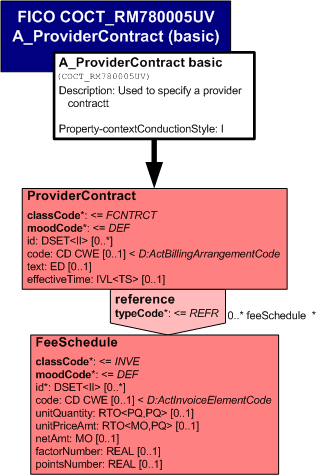
| Parent: | None |
The A_ProviderContract (basic) CMET conveys provider contract information, which may reference a fee schedule describing the billing arrangement components of a service charge under the contract.
ProviderContract is a financial contract typically between a provider and a payer that is expressed with the classCodeFCNTCT .
The BillingArrangementContract moodDEF conveys the type of definition of billing arrangement contract rather than an executed instance.
The BillingArrangementContract id is required to be sent if available to identify the contract.
The BillingArrangementContract code provides specific information about the type of financial contract with a coded concept from the ActBillingArrangementCode value set, e.g., fee-for-service, capitation, block grant, etc.
The BillingArrangementContract id is required to be sent if available to identify the contract.
The BillingArrangementContract effectiveTime may be sent to indicate the time during which the contract is in effect.
The referenceActRelationshipTypeREFR associates the BillingArrangementContract with the FeeSchedule expressed with the classCodeINVE in definition mode.
The FeeSchedule mood conveys that this is the type of fee schedule that would be applied to the associated coverage charge under a particular billing arrangement contract.
The FeeSchedule id is required be sent if available to uniquely identify a fee schedule.
The FeeSchedule code from the ActInvoiceElementCode value set provides specific information about the type of charges that may be invoiced.
The FeeSchedule may carry unitQuantity, unitPriceAmt, netAmt, factorNumber, and points if these are more informative than or impacts those carried in the an invoice class to which the A_ProviderContract may be associated, e.g., the A_Benefit ChargeDetail.
| A_ProviderContract basic | COCT_MT780005UV09 |
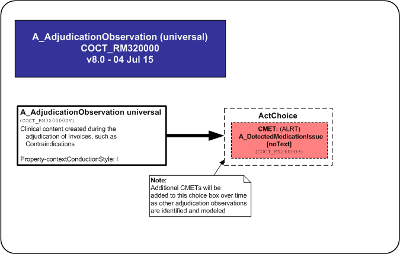
| Parent: | Claims & Reimbursement (FICR_DM000000UV03) |
Note: This CMET is normative in the HL7 V3 2006 Normative Edition.
The Adjudication Observation CMET is a choice amongst various adjudication observations such as contraindications. Adjudication observations provide clinical content created during the Adjudication of Invoices.
Additional CMETs will be added to the choice box over time as other adjudication observations are identified and modeled.
| A_DetectedMedicationIssueNoText | COCT_MT260003UV |
| A_AdjudicationObservation universal | COCT_MT320000UV04 |
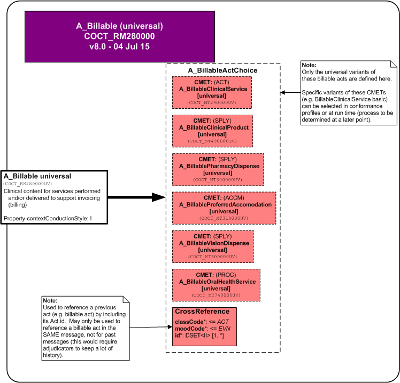
| Parent: | Claims & Reimbursement (FICR_DM000000UV03) |
Note: This CMET is normative in the HL7 V3 2006 Normative Edition.
The Billable CMET is a choice amongst the various billable acts that have the clinical content for services and/or products that are included in financial Invoices (billing).
In addition, there is a CrossReference used to reference a previous billable act by including its service/product identifier. The cross reference can only be used to reference another billable act within the same physical message (otherwise, this would require the receiver of the message to keep a large number of identifiers).
Additional CMETs will be added to the choice box over time as other billable acts are identified and modeled.
| A_BillableClinicalServiceUniversal | COCT_MT290000UV06 |
| A_BillablePharmacyDispenseUniversal | COCT_MT300000UV04 |
| A_BillablePreferredAccomodationUniversal | COCT_MT310000UV04 |
| A_BillableClinicalProductUniversal | COCT_MT490000UV04 |
| A_BillableVisionDispenseUniversal | COCT_MT600000UV06 |
| A_BillableOralHealthServiceUniversal | COCT_MT740000UV04 |
| A_Billable universal | COCT_MT280000UV04 |
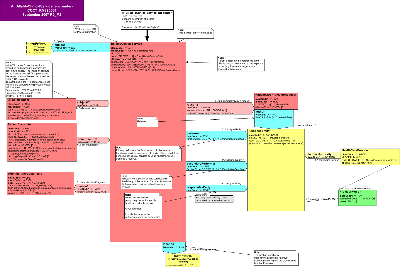
| Parent: | Claims & Reimbursement (FICR_DM000000UV03) |
Note: This CMET is intended to replace or revise material in the HL7 V3 2006 Normative Edition standard.
Overview:
The Billable Clinical Service encounter CMET is intended to provide detailed clinical information on orderable or billable health care related services including clinical interventions, procedures or services; observations; accommodations; substance administration; encounters; transportation; oral health care; or any care provided to living subjects, required to support the generation or posting of a Charge; an Invoice, Pre-Determination, Coverage Extension or Authorization in the event and intent mood.
The elements (classes, attributes, relationships) of this CMET are a subset of the elements of its parent CMET. For descriptions of the elements of this CMET, see the descriptions of the relevant elements of the parent CMET, which can be found via the following link: A_BillableClinicalServices universal
| R_PatientUniversal | COCT_MT050000UV01 |
| R_ServiceDeliveryLocationContact | COCT_MT240003UV02 |
| A_BillableClinicalService Encounter | COCT_MT290004UV06 |
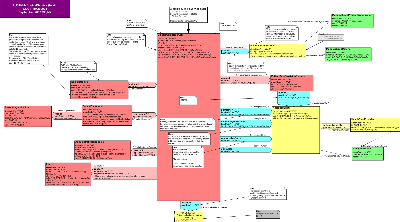
| Parent: | Claims & Reimbursement (FICR_DM000000UV03) |
Note: This CMET is intended to replace or revise material in the HL7 V3 2006 Normative Edition standard.
Overview:
The Billable Clinical Service basic CMET is intended to provide detailed clinical information on orderable or billable health care related services including clinical interventions, procedures or services; observations; accommodations; substance administration; encounters; transportation; oral health care; or any care provided to living subjects, required to support the generation or posting of a Charge; an Invoice, Pre-Determination, Coverage Extension or Authorization in the event and intent mood; or to describe detailed benefits covered under a policy or program in the definition mood.
The elements (classes, attributes, relationships) of this CMET are a subset of the elements of its parent CMET. For descriptions of the elements of this CMET, see the descriptions of the relevant elements of the parent CMET, which can be found via the following link: A_BillableClinicalServices univeral
| R_ServiceDeliveryLocationContact | COCT_MT240003UV02 |
| A_BillableClinicalService basic | COCT_MT290002UV06 |
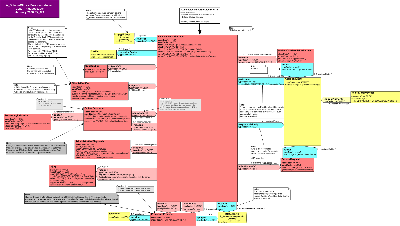
| Parent: | Claims & Reimbursement (FICR_DM000000UV03) |
Note: This CMET is intended to replace or revise material in the HL7 V3 2006 Normative Edition standard.
Overview:
The BillableClinicalService referral CMET is intended to provide detailed clinical information on orderable health care related services needed for a referral including clinical interventions, procedures or services; observations; accommodations; substance administration; encounters; transportation; oral health care; or any care provided to living subjects, required to support the generation or posting of a Pre-Determination, Coverage Extension, or Authorization in the intent mood.
The elements (classes, attributes, relationships) of this CMET are a subset of the elements of its parent CMET. For descriptions of the elements of this CMET, see the descriptions of the relevant elements of the parent CMET, which can be found via the following link: A_BillableClinicalServices univeral
| R_PatientUniversal | COCT_MT050000UV01 |
| R_ServiceDeliveryLocationContact | COCT_MT240003UV02 |
| A_BillableClinicalService referral | COCT_MT290003UV07 |
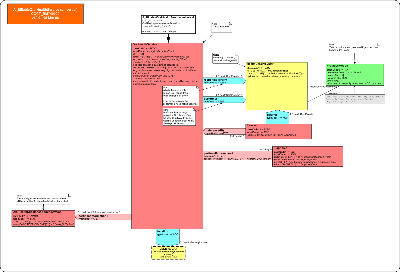
| Parent: | Claims & Reimbursement (FICR_DM000000UV03) |
Note: This CMET is normative in the HL7 V3 2006 Normative Edition.
The BillableOralHealthService CMET provides oral health information required to support billing for an Invoice, Pre-Determination, Coverage Extension or Authorization.
The patient is not referenced in this billable act as it is inherited from the parent model (as CoveredPartyAsPatient).
The oral health procedure (e.g. cleaning, tooth extraction(is supported by the specification of a oral health provider (e.g. dentist), referral, previous teeth extractions, previous oral health procedures, diagnosis and location.
| R_ServiceDeliveryLocationContact | COCT_MT240003UV02 |
| A_BillableOralHealthService universal | COCT_MT740000UV04 |
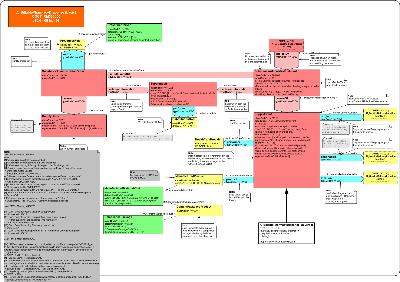
| Parent: | Claims & Reimbursement (FICR_DM000000UV03) |
Note: This CMET is normative in the HL7 V3 2006 Normative Edition.
This is a variant of the A_BillablePharmacyDispense universal (COCT_MT300000) CMET.
The BillablePharmacyDispense CMET provides pharmacy dispense information, required to support billing information for an Invoice, Pre-Determination, Coverage Extension or Authorization. It is derived from the Pharmacy Domain Model.
The patient is not referenced in this billable act as it is inherited from the parent model (as CoveredPartyAsPatient).
The supply act represents the dispensing of a drug and is supported by the prescriber and performer (pharmacist, dispenser) and can indicate the order that was filled, alert(s), shipping location and methadone dose control information.
A drug form may also be specified for compounds. However, the drug dispensed is not identified in this CMET, as it will be described in the Invoice (i.e. the drug is what is being billed for).
If the service was provided in the context of an encounter, admit and discharge dates may need to be specified.
| R_ServiceDeliveryLocationContact | COCT_MT240003UV02 |
| R_ServiceDeliveryLocationContact | COCT_MT240003UV02 |
| R_ServiceDeliveryLocationContact | COCT_MT240003UV02 |
| A_DetectedMedicationIssueNoText | COCT_MT260003UV |
| A_BillablePharmacyDispense Basic | COCT_MT300001UV04 |
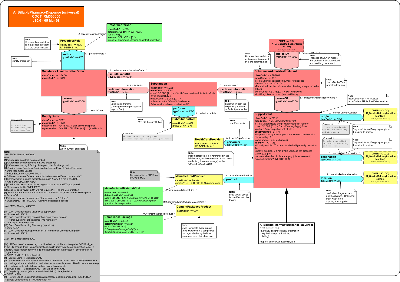
| Parent: | Claims & Reimbursement (FICR_DM000000UV03) |
Note: This CMET is normative in the HL7 V3 2006 Normative Edition.
The BillablePharmacyDispense CMET provides pharmacy dispense information, required to support billing information for an Invoice, Pre-Determination, Coverage Extension or Authorization. It is derived from the Pharmacy Domain Model.
The patient is not referenced in this billable act as it is inherited from the parent model (as CoveredPartyAsPatient).
The supply act represents the dispensing of a drug and is supported by the prescriber and performer (pharmacist, dispenser) and can indicate the order that was filled, alert(s), shipping location and methadone dose control information.
A drug form may also be specified for compounds. However, the drug dispensed is not identified in this CMET, as it will be described in the Invoice (i.e. the drug is what is being billed for).
If the service was provided in the context of an encounter, admit and discharge dates may need to be specified.
| R_ServiceDeliveryLocationContact | COCT_MT240003UV02 |
| R_ServiceDeliveryLocationContact | COCT_MT240003UV02 |
| R_ServiceDeliveryLocationContact | COCT_MT240003UV02 |
| A_DetectedMedicationIssueNoText | COCT_MT260003UV |
| A_BillablePharmacyDispense universal | COCT_MT300000UV04 |
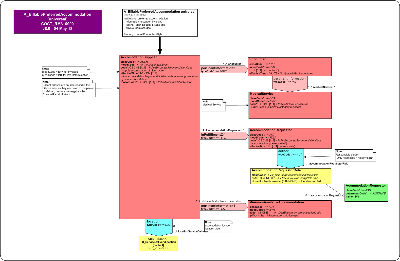
| Parent: | Claims & Reimbursement (FICR_DM000000UV03) |
Note: This CMET is normative in the HL7 V3 2006 Normative Edition.
The BillablePreferredAccommodation CMET provides institutional preferred accommodation information, required to support billing information for an Invoice, Pre-Determination, Coverage Extension or Authorization.
The patient is not referenced in this billable act as it is inherited from the parent model (as CoveredPartyAsPatient).
The accommodation supplied is supported with the accommodation requested (and by whom) and the minimum accommodation available at the time of the request. Additional information such as the location of the accommodation supplied, the encounter and medical service may be supplied.
| R_ServiceDeliveryLocationContact | COCT_MT240003UV02 |
| A_BillablePreferredAccomodation universal | COCT_MT310000UV04 |
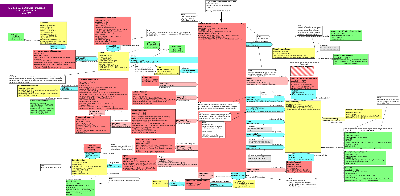
| Parent: | Claims & Reimbursement (FICR_DM000000UV03) |
The BillableSocialService CMET provides detailed information on social services, required to support billing information for an Invoice, Pre-Determination, Coverage Extension or Authorization.
The BillableSocialService CMET supports the conveyance of the health, socio-economic, and functional assessment observations about the client who is the subject of the social service that augments information typically conveyed about a patient of clinical services.
| E_PersonUniversal | COCT_MT030200UV09 |
| E_OrganizationUniversal | COCT_MT150000UV02 |
| R_ServiceDeliveryLocationContact | COCT_MT240003UV02 |
| E_PlaceUniversal | COCT_MT710000UV07 |
| A_SpatialCoordinateUniversal | COCT_MT960000UV05 |
| A_BillableSocialService universal | COCT_MT610000UV06 |
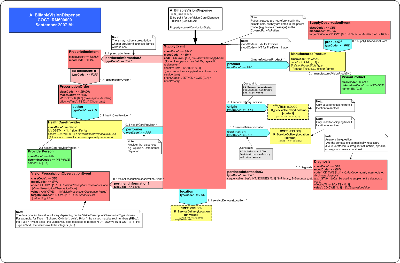
| Parent: | Claims & Reimbursement (FICR_DM000000UV03) |
Note: This is a membership 1 ballot of the second release of this CMETThis CMET is normative in the HL7 V3 2006 Normative Edition. Release 2 includes changes to vocabulary and class attributes.
The BillableVisionDispense CMET provides vision dispense information, required to support billing information for an Invoice, Pre-Determination, Coverage Extension or Authorization.
The patient is not referenced in this billable act as it is inherited from the parent model (as CoveredPartyAsPatient).
The supply event is supported by the specification of the product, the performer, prescription and prescriber, diagnosis and location.
| R_ServiceDeliveryLocationUniversal | COCT_MT240000UV01 |
| R_ServiceDeliveryLocationContact | COCT_MT240003UV02 |
| R_ServiceDeliveryLocationContact | COCT_MT240003UV02 |
| A_BillableVisionDispense universal | COCT_MT600000UV06 |
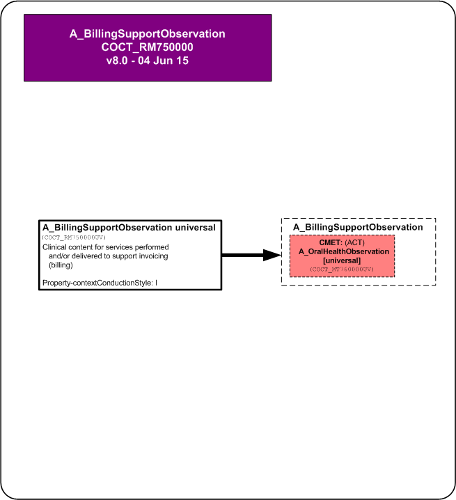
| Parent: | Claims & Reimbursement (FICR_DM000000UV03) |
Note: This CMET is normative in the HL7 V3 2006 Normative Edition.
The CMET is used to supply clinical content for services performed and/or delivered to support invoicing (billing).
| A_OralHealthObservationUniversal | COCT_MT760000UV04 |
| A_BillingSupportObservation universal | COCT_MT750000UV04 |
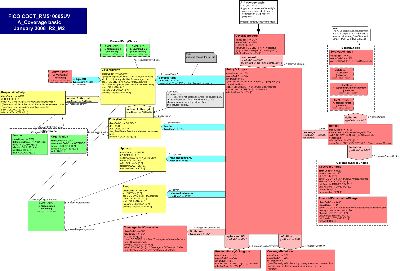
| Parent: | Claims & Reimbursement (FICR_DM000000UV03) |
Note: This CMET is new in this ballot. This is committee ballot 1.
Overview:
The Coverage basic CMET provides detailed information required to support management of a record regarding any current or previous coverages available to a beneficiary, such as a patient, under kind of insurance policy or government program (P/P), including services covered and financial participations. This CMET is intended to convey coverage information needed to manage, for example, accounts receivables related to the provision of services related to benefits; eligibility determination, eligibility verification, enrollment, and administration of a Covered Party's record.
The elements (classes, attributes, relationships) of this CMET are a subset of the elements of its parent CMET. For descriptions of the elements of this CMET, see the descriptions of the relevant elements of the parent CMET, which can be found via the following link: A_Coverage universal
| E_LivingSubjectInformational | COCT_MT030007UV |
| A_TransportationUniversal | COCT_MT060000UV01 |
| E_OrganizationUniversal | COCT_MT150000UV02 |
| E_OrganizationUniversal | COCT_MT150000UV02 |
| A_BillableUniversal | COCT_MT280000UV04 |
| A_SupportingClinicalStatementUniversal | COCT_MT530000UV |
| A_VerificationUniversal | COCT_MT810000UV |
| A_Coverage basic | COCT_MT510005UV06 |
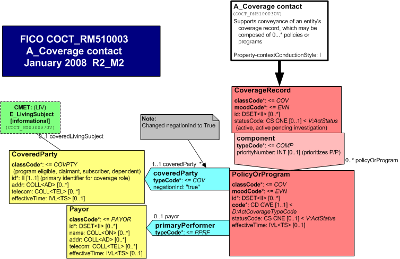
| Parent: | Claims & Reimbursement (FICR_DM000000UV03) |
Note: This CMET is new in this ballot. This is committee ballot 1.
Overview:
The Coverage contact CMET provides sufficient information to support contacting the covered party and the payor for coverage under any kind of insurance policy or government program (P/P). This CMET is intended to convey coverage information needed to manage, for example, accounts receivables related to the provision of services related to benefits; eligibility determination, eligibility verification, enrollment, and administration of a Covered Party's record.
The elements (classes, attributes, relationships) of this CMET are a subset of the elements of its parent CMET. For descriptions of the elements of this CMET, see the descriptions of the relevant elements of the parent CMET, which can be found via the following link: A_Coverage universal
| E_LivingSubjectInformational | COCT_MT030007UV |
| A_Coverage contact | COCT_MT510003UV06 |
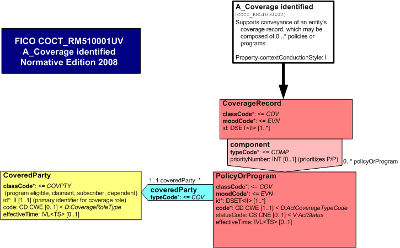
| Parent: | Claims & Reimbursement (FICR_DM000000UV03) |
Note: This CMET is new in this ballot. This is committee ballot 1.
Overview:
The Coverage identified CMET provides sufficient information to identify the covered party and the coverage under any kind of insurance policy or government program (P/P). This CMET is intended to convey coverage information needed to manage, for example, accounts receivables related to the provision of services related to benefits; eligibility determination, eligibility verification, enrollment, and administration of a Covered Party's record.
The elements (classes, attributes, relationships) of this CMET are a subset of the elements of its parent CMET. For descriptions of the elements of this CMET, see the descriptions of the relevant elements of the parent CMET, which can be found via the following link: A_Coverage universal
| A_Coverage identified | COCT_MT510001UV06 |
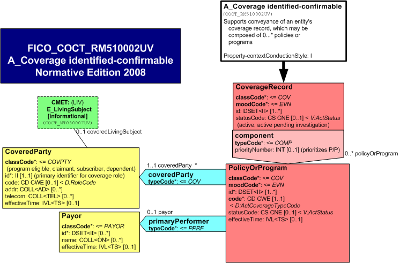
| Parent: | Claims & Reimbursement (FICR_DM000000UV03) |
Note: This CMET is new in this ballot. This is committee ballot 1.
A_Coverage identified-confirmable (COCT_RM51002)Overview:
The Coverage identified-confirmable CMET provides sufficient information to confirm the identity of the covered party and the coverage under any kind of insurance policy or government program (P/P). This CMET is intended to convey coverage information needed to manage, for example, accounts receivables related to the provision of services related to benefits; eligibility determination, eligibility verification, enrollment, and administration of a Covered Party's record.
The elements (classes, attributes, relationships) of this CMET are a subset of the elements of its parent CMET. For descriptions of the elements of this CMET, see the descriptions of the relevant elements of the parent CMET, which can be found via the following link: A_Coverage universal
| E_LivingSubjectInformational | COCT_MT030007UV |
| A_Coverage identified-confirmable | COCT_MT510002UV06 |
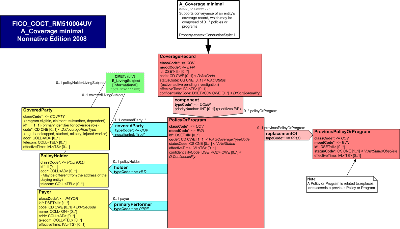
| Parent: | Claims & Reimbursement (FICR_DM000000UV03) |
Note: This CMET is new in this ballot. This is committee ballot 1.
Overview:
The Coverage minimal CMET provides sufficient information required to support management of a record regarding any current of previous coverages available to a beneficiary, such as a patient, under kind of insurance policy or government program (P/P). This CMET is intended to convey coverage information needed to manage, for example, accounts receivables related to the provision of services related to benefits; eligibility determination, eligibility verification, enrollment, and administration of a Covered Party's record.
The elements (classes, attributes, relationships) of this CMET are a subset of the elements of its parent CMET. For descriptions of the elements of this CMET, see the descriptions of the relevant elements of the parent CMET, which can be found via the following link: A_Coverage universal
| E_LivingSubjectInformational | COCT_MT030007UV |
| A_Coverage minimal | COCT_MT510004UV06 |
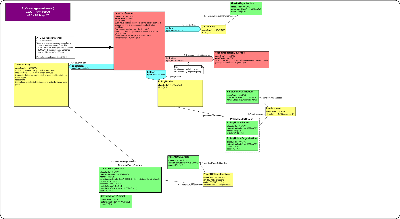
| Parent: | Claims & Reimbursement (FICR_DM000000UV03) |
Note: This CMET is normative in the HL7 V3 2006 Normative Edition. This is release 1 of A_Coverage.
The Coverage CMET is used to reference an insurance policy for a specific covered party. For the purposes of this CMET, the covered party may not actually be named on the insurance policy (e.g. pedestrian in an auto accident), but may be specified as a covered party when submitting a claim for services.
The policy is described by its policy identifier (may be made up of multiple parts such as plan id, group id, division, section, etc.), type (e.g. private, public, auto, WCB), status and effective date (i.e. date policy in effect).
The author of the policy, known as the insurance carrier, may be noted.
Up to 1 beneficiary/covered party/insured can be specified. Note: more than one beneficiary typically exists for family plans, but only 1 is noted for this CMET. The covered party may be either an animal (e.g. pet insurance) or individual. If the covered party is an individual, then the parent or guardian may be specified for under age individuals.
The policy holder/subscriber may also be noted as an individual (e.g. parent) or organization (e.g. employer).
| A_Coverage universal | COCT_MT180000UV04 |
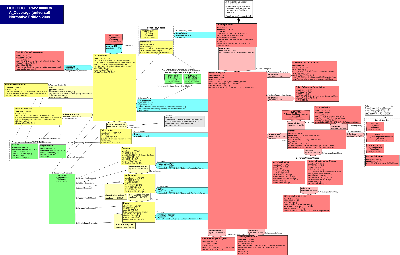
| Parent: | Claims & Reimbursement (FICR_DM000000UV03) |
Note: This CMET was new for the Jan 2007 ballot. This is release 2 of A_Coverage, membership ballot 2.
Overview:
The Coverage universal CMET provides detailed information about coverage under any kind of insurance policy or government program (P/P). This CMET is intended to convey coverage information needed to manage, for example, accounts receivables related to the provision of services related to benefits; eligibility determination, eligibility verification, enrollment, and administration of a Covered Party's record.
Policies are differentiated from programs because of substantial differences in their rules for eligibility determination, the types of benefits covered, the rules for coverage, their accountability and oversights, and the degree to which coverage decisions, premiums, reimbursements, and financial participations are related to insurance risk. A policy for insurance coverage is risk based and typically underwritten by a commercial entity. A program is typically subsidized by government funds; not wholly risk-based; and sponsored, underwritten, and administered by government entities or their contractors.
Coverage is to be distinguished from benefits in that benefits are promised under the terms of the contract and awarded if the terms of the contract are met. Coverage is the potential to be awarded benefits. Coverage is "actualized" when an underwriter recognizes and pays the claim for a benefit, e.g., a service required to indemnify the Covered Party for a loss that is covered or "indemnified" under the terms of a policy or program.
The type of benefits that may be covered under a policy or program is specified by the covered benefits(s). A policy or program covers or explicitly does not cover benefits. Each benefit type is a list of financial, service, or product benefits that may be covered, and may include conditions relating to whether the loss indemnified meets the coverage terms. With respect to a health P/P, this may include whether the service is a covered benefit; the medical necessity of the service; and the type and affiliation of providers who may render the services; and may include the financial participation required of a covered party such as deductibles, coinsurance, and copays, and the limits of coverage. With respect to a property and casualty policy, whether the losses result from perils insured against, and may include information relating to the type of property covered, locations covered, individuals' insured, financial participation such as deductibles, and the limits of indemnification. In life insurance covered services specify the causes of death that are explicitly covered or not covered, the benefits covered for beneficiaries, and may include conditions under which the covered party with a terminal illness may receive benefits under the policy while living.
Structurally, this CMET supports conveyance of an entity's coverage record, which may be composed of zero to many P/Ps. A P/P for coverage is an instance of a contract or program that is effective for a specified time period, and may have priority in terms of liability for coverage over other P/Ps in effect. It is the scope of benefits that may be covered, the costs for which the policy holder is indemnified against by the underwriter.
This CMET is a second release of the A_Coverage COCT_RM180000, and is derived from the yet to be released FICO_RM030000 Entity Eligibility Details. This CMET will be used in the FIAB Account Management messages to convey P/P information related to an account. It may also be used in the Patient RMIM (PRPA_RM201301) in future iterations.
The beneficiary of the service to which coverage applies is not referenced in this CMET, since it is inherited from the parent model that uses this CMET, and is in most cases played by the same entity that plays the CoveredParty role. When this CMET is used in the Patient RMIM, the beneficiary and covered party is typically the patient. An exception to this rule is that under some health P/P (1) a newborn may be a patient and a beneficiary, but is not the CoveredParty; in that case, the mother plays the CoveredParty role; or (2) the beneficiary may be a family member of a patient and covered party to whom counseling or care instructions relating to the patient is being provided.
CoverageRecord
The focal class of the Coverage CMET is the CoverageRecord class. This is a grouper class whose purpose is to group one or more policies or programs (P/Ps). It can group many P/Ps under different act statuses. That is, it may be used to group together those P/Ps which are:
...active (in one group) versus
...cancelled (in another group) versus
...suspended versus
...yet to become effective
The parent model should allow this CMET to repeat.
The attributes of the CoverageRecord are:
The CoverageRecord classCode: This class has an act type of Coverage.
The CoverageRecord moodCode: The mood of this act is Event, that is, the coverage contract is something that actually happens.
A beneficiary may not have coverage, the coverage may be unknown, or there may be a record of coverage (CoverageRecord) that includes 0...* coverages, the applicability of which may be known or unknown at a particular point in time. This CMET is intended to support all of these use cases. This is conveyed differently depending upon the context in which the A_Coverage CMET is used.
To indicate that a Patient in the Patient PRPA_RM201301 has no coverage, the Participation coveredPartyOf would not be sent. If it is unknown, a null flavor may be sent.
To indicate that a patient in the FIAB_RM10000 Release 2 has no coverage, the ActRelationship Coverage would not be sent. If it is unknown, a null flavor may be sent.
To indicate that a beneficiary has a record of coverage that includes 0...* coverages, the applicability of which may be known or unknown at a particular point in time, the A_Coverage CMET is sent. If the CoverageRecord has no component P/Ps, this indicates that the beneficiary has a record of coverage that includes no information about P/Ps. The CoverageRecord may consist of one or more P/Ps that have status codes indicating that they are not in effect or suspended. It may include one or more P/Ps under which the beneficiary is not covered because the type of encounter or services required are not covered by these P/Ps. Alternatively, the CoverageRecord could consist of a charity program for which a beneficiary without alternative coverages may be eligible.
The CoverageRecord statusCode: The status of the grouped P/Ps, that is, active, cancelled, completed (expired), suspended, etc. To be specified by a code from the ActStatus code.
The CoverageRecord effectiveTime: The effective date range of the statusCode for this CoverageRecord for this group of P/Ps. This may be important for billing purposes to ensure that coverage information used in a claim is current for the dates of service.
The CoverageRecord may be associated with zero to one beneficiary, which may be represented by R_Patient (univeral) CMET or the Beneficiary Role
The attributes of the Beneficiary are:
The Beneficiary classCode: This class has a a role type of Qualified Entity as denoted by the roleClassCode QUAL, which is an entity that has been recognized as having certain characteristics qualitying it as the beneficiary of services that may be covered by a policy or program within the coverage record.
The Beneficiary code: he type of beneficiary may be specified by a code from the QualifiedRoleType value set, which is used to further qualify an entity playing a qualified role.
The Beneficiary id: Optionally one or more unique identifiers for the beneficiary.
The Beneficiary status: The state of the beneficiary role may be specified by a code from the RoleStatus domain, e.g., the player of the role may be an applicant pending eligibility determination by the scoping organization.
The Beneficiary may be played by an organization, or a living subject, which may be a person.
The Beneficiary is scoped by an organization that sets the criteria for qualifying as a beneficiary.
The CoverageRecord will always be linked to one or more P/Ps.
PolicyOrProgram: This is an instance of a policy or program that is in effect.
The component relationship typeCode: The purpose of this ActRelationship link is that the CoverageRecord "has components".
The component relationship priorityNumber: This link attribute prioritizes coverages, that is, "1" is the primary coverage, "2" is the secondary coverage, etc. Coverage priority determines which of the P/Ps has primary responsibility for coverage and will impact coordination of benefits during the adjudication process.
The attributes of the PolicyOrProgram are:
The PolicyOrProgram classCode: This class has an act type of Coverage.
The PolicyOrProgram moodCode: The mood of this act is Event, that is, the coverage contract is something that actually happens.
The PolicyOrProgram id: One or more unique identifiers for this policy or program. Required to be sent if available.
The PolicyOrProgram code: The coverage type of the P/P shall be specified by a code from the ActCoverageTypeCode value set, e.g., a policy for health, property and casualty, or life insurance, or a program for worker compensation, crime victim compensation, or government subsidized health program .
The PolicyOrProgram statusCode: The status of this P/P, that is, active, cancelled, completed (expired), suspended.
The PolicyOrProgram effectiveTime: The policy or program's effective date and expiration date. This is the plan begin and end date range.
A PolicyOrProgram has associations to the following classes.
CoveredParty:
The P/P is required to be linked to one and only one CoveredParty role if known, which must be played by a kind or instance of a person, an organization, or a non-person living subject that is eligible for P/P benefits. Under a health insurance policy, the Covered Party is the person who is either the subscriber or dependent named in the P/P. Under a health program, the Covered Party is a program eligible. Under property and casualty insurance, the covered party is, for example, the claimant in a liability case or auto accident. Under life insurance, the Covered Party is the person in whose life the beneficiary has an insurable interest. Under reinsurance, the Covered Party is an underwriter. If the CoveredParty is not known, a null flavor is sent.
Both subscriber and dependent can be covered parties (aka beneficiaries). Whether the patient is the subscriber or dependent is distinguished by Beneficiary role code.
A CoveredParty may be a single person, organization, or non-person living subject. A designated population that is not individually differentiated as members of a group may play the role of Covered Party by being a "kind" of person or non-person living subject receiving benefits under a P/P, e.g., reproductive health education provided to all seventh grade children in a school district; needle exchange provided to all needle users within vicinity; or vaccination of a herd of cattle. Note that a kind of organization may not be a Covered Party.
A Covered Party may or may not be played by the same entity who is the beneficiary, e.g., the Covered Party under a life insurance policy is typically not the beneficiary of the policy except in the case of a viatical settlement where the policy is sold at a discount from its face value to pay for care for a terminal illness.
Covered Parties may be scoped by any of the Organizations playing participatory roles in the P/P as underwriters, sponsors or payors.
The CoveredParty participation typeCode: This ActRelationship shall associate one and only one CoveredParty as the target of coverage under the P/P.
The CoveredParty participation sequenceNumber: When a P/P covers multiple named parties, this is the optional ranking order of the covered party, e.g., under a health policy, the subscriber would usually be first.
The CoveredParty negationID: Indicates that the CoveredParty is not covered under a particular P/P under the circumstances. For example, although the beneficiary's CoverageRecord indicates coverage under a worker compensation program, if the current encounter is not work-related, then the person playing the CoveredParty with respect to the worker compensation program may not be deemed to have coverage under that program at the initiation of an encounter. However, this status may change during the course of the encounter if there is a subsequent finding that the patient condition is in fact work-related.
The CoveredParty classCode: This shall be specified by a code from the RoleClassCoveredParty value set, e.g., claimant, program eligible, named insured, individual, subscriber, or dependent.
The CoveredParty id: The primary identifiers for this covered party role, assigned/scoped by either the sponsor, the underwriter or payor. These identifiers are the Covered Party's identification numbers on under a policy or program, and may be carried on an identification card. In atypical cases, there may be more than one, e.g., covered party under a Medicaid managed care plan may be identified with both the person's identifier as a Medicaid eligible and the identifier assigned by the contracting Medicaid managed care plan. The covered party identifier is not necessarily an OID, but may be based on the root OID of the assigning entity.
The CoveredParty code: The type of covered party role is required to be specified by a code from the CoverageRoleType value set, which further specifies the Covered Party Role.class, e.g., handicapped, student, military, injured worker, animal, crime victim, unemployed worker, etc. For example, a Covered Party status may be the result of having a Role.class of Named Insured where the person playing the role has is covered under university health plan as a student. In addition or as an alternative, the same person may play a Covered Party with the Role.class of Dependent where that status is a result of also being a full time student under the age of 23. Thus, the CoveredParty Role.code of "full time student" further specifies both the Role.class of Named Insured and that of Dependent.
The CoveredParty addr: The address of the Covered Party.
The CoveredParty effectiveTime: The effective date and expiration date when the covered party is covered by the P/P. If a dependent is added or deleted from the P/P, then the dependent's effective dates will be different than the P/P effective dates. This is the benefit begin and end date range for the Covered Party.
The CoveredParty may be optionally linked to the PolicyHolder, who has indirect authority over the CoveredParty role status of the playing entity by virtue of discretion afforded the PolicyHolder to cover a particular entity or type of CoveredParty. For example, a PolicyHolder has discretion to purchase a automobile liability policy that covers family members, and may agree to insure only some of members of the family.
The CoveredParty may be the subject of zero or more A_Verifcation (universal) CMET and/or EligibilityStatusObservation, which convey information about the verification of the eligibility.
EligibilityStatusObservation:
The EligibilityStatusObservation classCode: This class has the act type of "observation".
The EligibilityStatusObservation moodCode: The mood of this act is Event, which conveys that an eligibility status observation occurred.
The EligibilityStatusObservation id: The unique identifier(s) for this observation act.
The EligibilityStatusObservation code: The result of the observation may be specified by a code from the ObservationEligibilityIndicatorType value set to indicate the type of information observed to establish eligibility. E.g., evidence of the covered party's health/socio-economic status.
The EligibilityStatusObservation value: Value related to the eligibility status evidence, e.g., a scanned copy of evidence.
PersonalRelationship
The PersonalRelationship Part RoleLink typeCode: The CoveredParty role may be further specified by the Part RoleLink association to its PersonalRelationship role, e.g. as a adopted child, dependent, spouse, etc., to a scoping person. This Personal Relationship is pertinent to the CoveredParty role where the scoper is also playing applicable ResponsibleParty roles, such as subscriber, trustee, or guardian and/or the PolicyHolder role.
The Covered Party may have zero to one personal relationships, which are prioritized in terms of their relevance to the CoveredParty role.
The PersonalRelationship Part participation priorityNumber: Related persons are prioritized in terms of their relevance to the covered party role. For example, the covered party is both the neice and the adopted child of the subscriber and the priorityNumber is which role is has priority for the coverage, i.e., the adopted child.
The PersonalRelationship Part participation effectiveTime: The date range of the personal relationship, that is the begin and end date range of a marriage, adoption, guardian relationship, etc.
PersonalRelationship classCode This role is played by a person.
PersonalRelationship code This code indicates what the personal relationship is with the covered party. This is required to be specified by a code from the PersonalRelationshipRoleType value set, that is, a personal relationship which is relevant to the covered party role, e.g., adopted child, spouse.
ResponsibleParty:
The ResponsibleParty is a person or organization who/which has indirect control over the covered party status. For example, when a CEO has life insurance provided by an employer, then the employer is the responsible party. A subscriber is usually the party responsible for the covered party status of a dependent. An executor of a will may be the party responsible for the healthcare coverage status of dependents.
The ResponsibleParty indirectAuthority participation typeCode: The responsible party may not have sole authority over the covered pary's status, but has partial authority. The policy holder may have overriding authority. A subscriber, who is an absentee parent, has indirect authority to choose not to cover dependents; however a government program may require that the subscriber enroll the dependents in lieu of more costly coverage under the government program.
The responsible party role may be played by a person, such as subscriber, trustee, guardian ad litem, who is authorized to act on behalf of the covered party.
The responsible party may be scoped by an organization, e.g.,a Guardian Ad Lidem may be scoped by a court.
The ResponsibleParty classCode: This role class type is agent, a player who is authorized to act on behalf of a scoper.
The ResponsibleParty code: The responsible party role type is required to be specified by a code from the ResponsibleParty value set. E.g., guardian (of a ward) or subscriber (of dependent).
PolicyHolder:
The P/P may be linked to zero or one PolicyHolder role. The policy holder is the one who holds the policy for health insurance or auto insurance. The holder may be the subscriber for health insurance. An employer may be the policy holder for employees. The policy holder may be a person or organization. The policy holder may be the same person as the covered party, when the subscriber is the patient.
If the covered party is the same person/entity as the policy holder (e.g., subscriber/insured), then the person in the CoveredParty's Beneficiary-CoveredPartyChoice box will be identical to the person in the policy holder's scoping EntityChoice box.
The Holder participation typeCode: The purpose of this ActRelationship link (between P/P and PolicyHolder) is that the P/P is "held by" the policy holder.
The PolicyHolder is an indirect authority over the fact that an entity is a CoveredParty for the policy holder's P/P. An employee/subscriber can add or remove a dependent from being a covered party under the P/P.
The PolicyHolder classCode: This class has a role type of "policy holder" that is scoped by either the sponsor or underwriter.
The PolicyHolder id: The primary identifier for this policy holder role is assigned by the underwriter.
The PolicyHolder addr: The address of the policy holder, which may differ from that of the covered party.
Sponsor
The P/P may be linked to zero or one Sponsor role. The sponsor is the party responsible for providing coverage, e.g., a governmental agency. A role played by an entity, usually an organization that is the sponsor of an insurance plan or a health program. A sponsor is the party that is ultimately accountable for the coverage by employment contract or by law. An sponsor can be an employer, union, government agency, or association. The sponsor decides whether to enter into a coverage contract with an underwriter.
The author participation typeCode: The type of role for this relationship is "responsible party".
The author participation functionCode: An optional code specifying additional detail about the function that the Participation has in the Act, if such detail is not implied by the Participation.typeCode. This shall be specified by a code from the ParticipationFunction value set. New values being added Fall 2006.
The Sponsor classCode: This class has a role type of "sponsor".
The Sponsor id: Optionally one or more unique identifiers for the sponsor. For example, corporation identifiers.
The Sponsor code: The type of sponsor may be specified by a code from the CoverageSponsorRoleType value set, e.g., Multiple Employee Welfare Association (MEWA) or unions or chambers of commerce, which acts as an umbrella sponsor for their members. Some sponsors are fully insured, that is, they delegate risk downstream to an underwriter. Some sponsors are self-insured, that is they are both the sponsor and underwriter, and may also play the role of the payor.
The Sponsor name: The name of the sponsor.
The Sponsor addr: The address of the sponsor.
The Sponsor telecom: The contact numbers for the sponsor.
The Sponsor effectiveTime: The effective date range for an organization in this role of sponsor.
A Sponsor has direct authority over an Underwriter, as the party who contract with the underwriter.
A Sponsor Role may be scoped by an organization authorized to grant recognition to the entity playing this role. E.g., Jurisdictions may recognize an entity as (1) a government agency charged with sponsoring a subsidized health program; or (2) as a Multiple Employer Welfare Association responsible to sponsor health insurance for employees.
Underwriter
The P/P may be linked to zero or one Underwriter role. The underwriter is the author of the contract, for example, an insurance company, reinsurer, self-insured employer, or government sponsored program, such as U.S. Medicaid. There may be multiple underwriters involved in a P/P.
The author participation typeCode: The type of role for this relationship is "author" of the contract.
The author participation functionCode: An optional code which indicates how the underwriter and the payor participate in the coverage act. This shall be specified by a code from the ParticipationFunction value set, for example, primary, subcontracting, passing on risk. New values being added Fall 2006.
The Underwriter classCode: This class has a role type of "underwriter".
The Underwriter id: Optionally one or more unique identifiers for the underwriter. For example, an NAIC identifier.
The Underwriter code: The type of underwriter may be specified by a code from the RoleCode domain. An UnderwriterRoleCode value set will be developed, to include, e.g., property and casaulty, high risk, life, healthcare, worker's compensation.
The Underwriter name: The name of the underwriter.
The Underwriter addr: The address of the underwriter.
The Underwriter telecom: The contact numbers for the underwriter.
The Underwriter effectiveTime: The effective date range for an organization in this role of underwriter.
One underwriter may have direct authority over another underwriter. An underwriter for a P/P may contract with a second underwriter to provide reinsurance. An underwriter may also contract with other underwriters to provide a P/P for some subset of coverages, for example, a managed care plan may subcontract with a provider organization to assume risk for some covered parties. One underwriter may play the role of reinsurer or stop loss carrier to the underwriter that is the primary on the contract with the sponsor. This has consequences in healthcare because the reinsurer may take over the authorization of benefits when stop loss for a covered party is reached.
An Underwriter may have direct authority over a Payor, because they contracted with the payor to administer the P/P.
Payor
The P/P may be linked to zero or one Payor role. The payor is the party responsible for administering the P/P, e.g., paying claims/invoices.
The primaryPerformer participation typeCode: The type of role for this relationship is "performer". There may be multiple payors involved in a P/P.
The primaryPerformer participation functionCode: An optional code which indicates how the payor and the payor participate in the coverage act. This shall be specified by a code from the ParticipationFunction value set. New values being added Fall 2006.
The attributes of Payor are:
The Payor classCode: This class has a role type of "payor".
The Payor id: Optionally one or more unique identifiers for the payor. For example, an NAIC identifier.
The Payor code: The type of payor may be specified by a code from the PayorRoleType value set, e.g., enrollment broker or third party administrator.
The Payor name: The name of the payor.
The Payor addr: The address of the payor.
The Payor telecom: The contact numbers for the payor.
The Payor effectiveTime: The effective date range for an organization in this role of payor.
The Payor may perform or subcontract with 0...* other Payors to perform enrollment, adjudication, utilization management, or provider contracting. For example, a health plan may contract with a third party billing service, an eligibility verification vendor, and a utilization management vendor to perform payor functions.
PreviousPolicyOrProgram
The P/P may be linked to 0..1 PreviousPolicyOrProgram. The parent P/P is replacing or related to or succeeds the previous policy or program.
The replacementOf relationship typeCode: The type of role for this relationship is "replacement".
The PreviousPolicyOrProgram classCode: This class has a role type of "coverage".
The PreviousPolicyOrProgram moodCode: The mood of this act is Event, that is, the coverage contract is something that actually happens.
The PreviousPolicyOrProgram id: Optionally one or more unique identifiers for the PreviousPolicyOrProgram.
The PreviousPolicyOrProgram statusCode: The status of this previous P/P. For example, obsolete if this P/P has been replaced. See pending new x_PreviousActStatus with values: cancelled, nullified and obsolete.
The PreviousPolicyOrProgram effectiveTime: The effective date range for the PreviousPolicyOrProgram.
Benefit
The ActRelationship COVBY typeCode: The P/P may be linked to one or more Benefit(s). The coverage association indicates that the P/P may provide coverage for a benefit if the provision of the benefit meet the coverage rules; or may explicitly exclude coverage for a benefit, in which case the negation indicator is used.
The Benefit classCode PCPR: This class indicates the service provided as a P/P benefit, which may be further specified by associated acts, e.g., the Benefit may have a supporting clinical statement about care provided or the condition of the subject of care as a precondition; may refer to coverage policies related to the provision of the benefit; may be limited by the charges covered under the P/P or financial participations required of the covered party; or may be defined in terms of the service specifications in the BenefitChoice.
The Benefit moodCode: The mood of this act is Definition, that is, a P/P Benefit is defined by this class's attributes, associations, and associated classes.
The Benefit code: The type of benefit is required be specified by a code from the x_ActBillableCode value set if known. For example, medical, chiropractic, dental care, social work, hospice, long term care, ambulance, acupuncture, pharmacy, psychiatry, naturopathy, physical therapy, etc.
The Benefit negationInd: Used to say that this benefit is excluded from coverage, e.g., cosmetic surgery
The Benefit effectiveTime: The effective date range for a benefit.
The Benefit reasonCode: These are the reasons or criteria specified by codes from the ActCoverageReason value set, relating to coverage of a benefit provided under a policy or program. May be used to convey reasons pertaining to coverage contractual provisions, including criteria for eligibility, coverage limitations, coverage maximums, or financial participation required of covered parties.
The ActRelationship INST typeCode: The Benefit may be associated to one or more ServiceChoices. The coverage association indicated that the Benefit may be instantiated by one or more A_Billable, A_SupportingClinicalStatement, A_Transportation CMET or ServiceDefinition that more fully specify the service instantiating the benefit definition. The ServiceDefinition is an act in definition mood that defines services that may be further specified by codes from the x_ActBillableCode
The ActRelationship PRCN typeCode: The Benefit may be associated to one or more A_SupportingClinicalStatement CMET, which convey the services that must be received as a precondition of coverage of the Benefit, e.g., a diagnostic test is required to validate the medical necessity of a procedure in order for that procedure to be a covered benefit under a P/P.
The ActRelationship REFER typeCode: The Benefit may be associated to one or more CoveragePolicy act POLclassCode, which convey the coverage policy or policies that sets rules for the coverage of the Benefit.
The CoveragePolicy moodCode: The mood of this act is Definition, that is, a Benefit CoveragePolicy is defined by this class's attributes.
The CoveragePolicy id: Optionally one or more unique indentifiers for the CoveragePolicy.
The CoveragePolicy code: The type of policy may be specified by codes from the ActPolicyType value set.
The CoveragePolicy statusCode: The status of this CoveragePolicy, obsolete if this CoveragePolicy has been replaced but applied to a Benefit during the P/P effective time and was applicable to the coverage of a Benefit during that time span.
The CoveragePolicy effectiveTime: The effective date range for a coverage policy.
The CoveragePolicy reasonCode: One or more reason codes related to the coverage policy may be selected from the ActCoverageReason value set, e.g., a pre-existing condition exclusion may be the reason for a coverage policy that is referenced by a Benefit that is not covered, i.e., with negationInd set to "true".
The ActRelationship LIMIT typeCode: The Benefit may be associated to one or more CoverageChargeChoice acts.
The CoverageCharge classCodeINVE: This class indicates the rules relating to the limits of charges for a benefit that a P/P will cover.
The CoverageCharge moodCode: The mood of this act is Criterion, which conveys the conditions that must be met for the charges related to the Benefit to be covered.
The CoverageCharge id: Optionally one or more unique indentifiers for the CoverageCharge.
The CoverageCharge code: The type of coverage charge may be specified by codes from the ActCoverageLimitCode value set, e.g., the net amount, unit quantity, or unit price.
The CoverageCharge effectiveTime: The effective date range for a coverage charge rule.
The CoverageCharge unitQuantity conveys the ratio of units per service provision or product dispense, e.g., 2 hour session of physical therapy or 3 boxes of a product per dispense.
The CoverageCharge unitPriceAmt conveys the price per unit, e.g., $50 CAD/1{box} or $100 per hour of physical therapy.
The CoverageCharge netAmt is expressed using a currency {the unit in which monetary amounts are denominated in different economic regions] to express the net amount charged based on the product of applicable coverage charge unity quantity, unityPriceAmt, factorNumber and pointsNumber attributes.
The CoverageChargefactorNumber is the multiplier or percentage used to calculate the rate for each unitQuanitity/unitPriceAmt expressed with a Real integer, e.g., the out-of-network vs. the in-network percentage charge.
The FinancialParticipationCharge classCodeINVE: This class indicates the rules relating to the limits of charges for a benefit that a P/P will cover.
The FinancialParticipationCharge moodCode: The mood of this act is Criterion, which conveys the financial participation charges that the covered party must pay in order for the Benefit to be covered by the P/P.
The FinancialParticipationCharge id: Optionally one or more unique indentifiers for the FinancialParticipationCharge.
The FinancialParticipationCharge code: The type of financial participation required of covered parties may be specified by codes from the ActInvoiceDetailGenericAdjudicationCode value set, e.g., copayment, deductible, or coinsurance.
The FinancialParticipationCharge effectiveTime: The effective date range for a financial participation rule.
The FinancialParticipationCharge unitQuantity conveys the ratio of units per service provision or product dispense for purpose of calculating financial participation, e.g., a 30 or 90 day supply of a product per dispense.
The FinancialParticipationChargeunitPriceAmt conveys the financial participation required per unit of service covered under the benefit, e.g., $15 per hour of physical therapy.
The FinancialParticipationCharge netAmt is expressed using a currency {the unit in which monetary amounts are denominated in different economic regions] to express the net financial participation amount charged based on the product of applicable financial participation unity quantity, unityPriceAmt, factorNumber and pointsNumber attributes.
The FinancialParticipationChargel factorNumber is the multiplier or percentage used to calculate the rate for each unitQuanitity/unitPriceAmt expressed with a Real integer, e.g., the out-of-network financial participation charge is 10% higher than the in-network financial participation charge.
The ActRelationship REFER typeCode: The CoverageChargeChoice may be associated to one or more CoverageChargePolicy POLclassCode, which convey the coverage policy or policies that sets rules for the coverage of the Benefit.
The CoverageChargePolicy moodCode: The mood of this act is Definition, that is, a Benefit CoveragePolicy is defined by this class's attributes.
The CoverageChargePolicy id: Optionally one or more unique indentifiers for the CoverageChargePolicy.
The CoverageChargePolicy code: The type of policy may be specified by codes from the ActPolicyType value set.
The CoverageChargePolicy statusCode: The status of this CoveragePolicy, obsolete if this CoveragePolicy has been replaced but applied to a Benefit during the P/P effective time and was applicable to the coverage of a Benefit during that time span.
The CoverageChargePolicy effectiveTime: The effective date range for a coverage charge policy.
The CoverageChargePolicy reasonCode: One or more reason codes related to the coverage charge policy may be selected from the ActCoverageReason value set, e.g., a dental coverage charge policy reason of "maximum total amount" is referenced by a CoverageCharge rule with the net amount that will be covered for a dental benefit; or a spend down requirement is the reason for a policy referenced by a financial participation charge deductible that limits the clinical services covered during the benefit effective time.
The PolicyOrProgramLimit
The ActRelationship LIMIT typeCode: The P/P may be associated to one or more PolicyOrProgramLimits, which conveys coverage limitations such as the maximum coverage amounts, maximum coverage period, and covered party type limitations.
The PolicyOrProgramLimit OBSclassCode: This class has an act type of Observation.
The PolicyOrProgramLimit moodCode: The mood of this act is Definition, that is, a PolicyOrProgramLimit is defined by this class's attributes.
The PolicyOrProgramLimit id: Optionally one or more unique idenfiers for the PolicyOrProgramLimit.
The PolicyOrProgramLimit code: The type of P/P limit may be specified by a code from the ActCoverageLimitType, e.g., limit on the maximum period, amount, unit price, or type of covered party. value set.
The PolicyOrProgramLimit effectiveTime: The effective date range for a PolicyOrProgramLimit.
The PolicyOrProgramLimit reasonCode: The policy or program reason may be specified by a code from the ActCoverageLevelReasonCode, e.g., covered parties are limited to spouse and children only.
The PolicyOrProgramLimit value: May be used to specify a coverage limit observation value, e.g., the life-time maximum for a P/P is one million dollars.
| E_LivingSubjectInformational | COCT_MT030007UV |
| R_PatientUniversal | COCT_MT050000UV01 |
| A_TransportationUniversal | COCT_MT060000UV01 |
| E_OrganizationUniversal | COCT_MT150000UV02 |
| E_OrganizationUniversal | COCT_MT150000UV02 |
| A_BillableUniversal | COCT_MT280000UV04 |
| A_SupportingClinicalStatementUniversal | COCT_MT530000UV |
| A_SupportingClinicalStatementUniversal | COCT_MT530000UV |
| A_VerificationUniversal | COCT_MT810000UV |
| Cr Event New A_Coverage universal | COCT_MT510000UV06 |
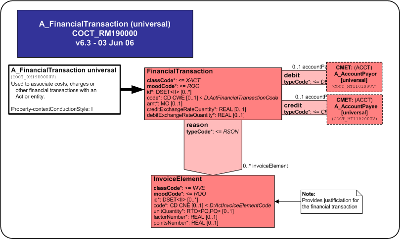
| Parent: | Claims & Reimbursement (FICR_DM000000UV03) |
Note: This CMET is normative in the HL7 V3 2006 Normative Edition.
The FinancialTransaction CMET is used to associate costs, charges or other financial transactions with an act or entity.
The financial transaction includes transaction type, amount and exchange rates.
| A_AccountPayorUniversal | COCT_MT110100UV04 |
| A_AccountPayeeUniversal | COCT_MT110200UV04 |
| A_FinancialTransaction universal | COCT_MT190000UV04 |
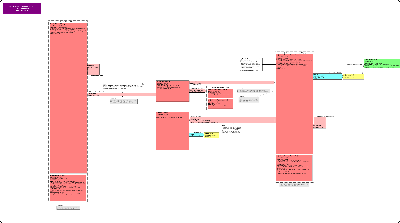
| Parent: | Claims & Reimbursement (FICR_DM000000UV03) |
Note: This CMET is normative in the HL7 V3 2006 Normative Edition.
The InvoiceCoordination CMET is used to package explanation of benefits (EOB) information from one Adjudicator to be included in a subsequent Invoice to a downstream Adjudicator for coordinating Invoices amongst Adjudicators (COB - coordination of benefits).
| A_InvoiceCoordination basic | COCT_MT680002UV04 |
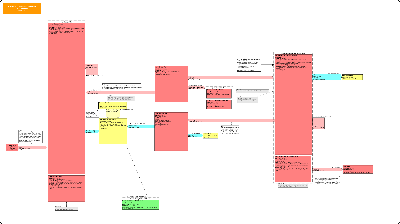
| Parent: | Claims & Reimbursement (FICR_DM000000UV03) |
Note: This CMET is normative in the HL7 V3 2006 Normative Edition.
The InvoiceCoordination CMET is used to package explanation of benefits (EOB) information from one Adjudicator to be included in a subsequent Invoice to a downstream Adjudicator for coordinating Invoices amongst Adjudicators (COB - coordination of benefits).
| A_BillableUniversal | COCT_MT280000UV04 |
| A_InvoiceCoordination enhanced | COCT_MT680003UV04 |
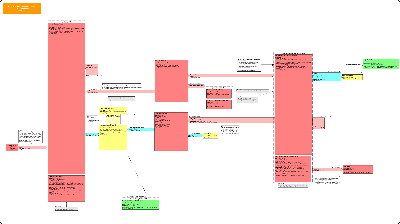
| Parent: | Claims & Reimbursement (FICR_DM000000UV03) |
Note: This CMET is normative in the HL7 V3 2006 Normative Edition.
The InvoiceCoordination CMET is used to package explanation of benefits (EOB) information from one Adjudicator to be included in a subsequent Invoice to a downstream Adjudicator for coordinating Invoices amongst Adjudicators (COB - coordination of benefits).
| A_BillableUniversal | COCT_MT280000UV04 |
| A_InvoiceCoordination universal | COCT_MT680000UV04 |
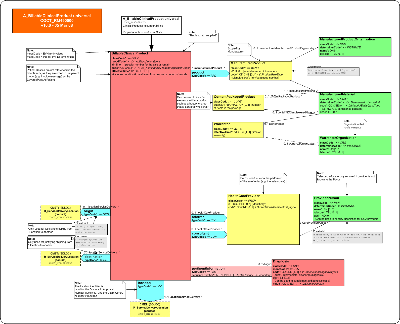
| Parent: | Claims & Reimbursement (FICR_DM000000UV03) |
Note: This CMET is normative in the HL7 V3 2006 Normative Edition.
The BillableClinicalProduct CMET provides detailed information on clinical products, required to support billing information for an Invoice, Pre-Determination, Coverage Extension or Authorization.
The patient is not referenced in this billable act as it is inherited from the parent model (as CoveredPartyAsPatient).
How the product was provided is specified in the ClinicalBillableProduct act and the product relationship provides serial number, identifier, manufacturer, packaging and warrantor. It is supported by the performer, referrer and consultant, the diagnosis and the indicating of the locations for source and to/from delivery information. The order and who ordered it may be identified.
| R_ServiceDeliveryLocationContact | COCT_MT240003UV02 |
| R_ServiceDeliveryLocationContact | COCT_MT240003UV02 |
| R_ServiceDeliveryLocationContact | COCT_MT240003UV02 |
| A_BillableClinicalProduct universal | COCT_MT490000UV04 |
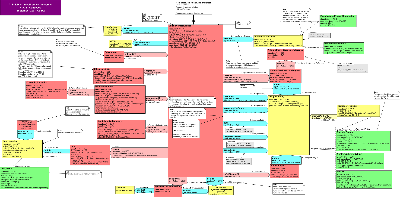
| Parent: | Claims & Reimbursement (FICR_DM000000UV03) |
Note: This CMET is intended to replace or revise material in the HL7 V3 2006 Normative Edition standard. This is the first membership ballot for this CMET and its basic, referral and encounter variants.
Overview:
The BillableClinicalService universal CMET provides detailed clinical information on orderable or billable health care related services including clinical interventions, procedures or services; observations; accommodations; substance administration; encounters; transportation; oral health care; or any care provided to living subjects, required to support the generation or posting of a Charge; an Invoice, Pre-Determination, Coverage Extension or Authorization in the event and intent mood; or to describe detailed benefits covered under a policy or program in the definition mood.
The patient may be referenced in this billable act via the R_Patient (universal), or it may be inherited from the parent model (as CoveredPartyAsPatient or the R_Patient CMET information that may propagate from an ancestral A_Charge). If patient information contained in this CMET differs from patient information propagated from any ancestor Acts to which the A_BillableClinicalService CMET is associated, then it the patient information at this level overrides that propagated by the ancestor, but does not propagate further.
The service ordered (intent mood) or billed (event mood) is specified in the ClinicalBillableService act. Information relating to the service includes details about the provider (performer), and one or more assisting providers, e.g., a supervisor (as secondary performers), referrers, or consultants. Substitution can be indicated. Details relating to an encounter for the service and any related diagnosis may be sent.
Reasons for the service may be an injury, which may or may not be an accident, and may include a description of the injury site location. The location where a service was provided may be indicated as well as the location where a specimen was collected.
If the service was provided in the context of an encounter, admit and discharge dates may need to be specified.
If the service affected a product (e.g. repair a wheelchair), then the product is identified.
If the service involved a reusable device (e.g. durable medical equipment), then the device is identified.
Please note that in an Invoice, the billing codes transmitted may or may not differ from the clinical information coding. Clinical information is carried in this BillableClinicalService CMET included in the Invoice, however, the billing codes themselves are in the InvoiceElementDetail.code and InvoiceElementDetail.modifierCode, not in this CMET.
BillableClinicalService Attributes
The focal class (and entry point) of the BillableClinicalService RMIM is the BillableClinicalService class. The attributes of the BillableClinicalService are:
The BillableClinicalService classCode: The x_ActOrderableOrBillableService.classCode value set includes those relevant healthcare acts class shall be sent. The domain x_ActOrderableOrBillableService.classCode allows this CMET to be used for other types of acts, in addition to procedures.
The BillableClinicalService moodCode shall be selected from the ActMoodCompletionTrack for services that are orderable (intent mood), billable (event mood), or covered as orderable or billable (definition mood).
The BillableClinicalService id: One or more unique identifiers for this specific billable service. Required to be sent if available.
The BillableClinicalService code: The type of billable service shall be specified by a code from the x_ActBillableServiceCode value set. The x_ActBillableServiceCode vocabulary expands the use of this CMET to other Acts besides procedures and defines a subset of ActCodes for those acts that are billable.
The BillableClinicalService effectiveTime: The duration and date/time of the occurrence of a billable service or the time of interest from the perspective of the intent to provide the billable service shall be sent.
The BillableClinicalService repeatNumber: Sent to indicate the minimal and maximal number of repetitions of the billable service, e.g., the same service delivered twice on the same day, or e.g., quantity range for pre-determination or authorization of multiple occurrences of the same service. Required to be sent if available.
The BillableClinicalServiceconfidentialityCode: May be sent to indicate one or more codes that control the disclosure of all information related to the BillableService conveyed in an instance of the CMET.
The BillableClinicalService reasonCode: May be sent to indicate one or more reasons for the performance of the BillableClinicalService that are related but not integral to the service, such as patient's preference, medical necessity, duplicate therapy, fraudulent prescription, or care protocol. Value sets within the ActOrderableOrBillableServiceReason vocabulary domain are available in the universal, and the variants as appropriate to the choice of value set from the classCode vocabulary domain, Actx_OrderableOrBillableService.
Vocabulary domain ActOrderableOrBillableServiceReason includes other act reasons, not just procedure reasons. This domain excludes reasons specified by diagnosed conditions. Examples of applicable values from this domain include duplicate therapy and fraudulent prescription codes from the subset ActBillableClnicalServiceReason abstract value set. This is a subset of ActReason for those ActReasons which can be used for orderable or billable acts.
Links to Other Acts
A BillableClinicalService may link to other acts:
New to this ballot: The ActRelationship subject1: This is a link to the patient information conveyed from the R_Patient (universal) CMET via context conduction.
The Participation reusableDevice: The BillableClinicalService may be linked to one Device role, which indicates that a reusable device, e.g., durable medical equipment was involved in this BillableClinicalService.
The Device id is a mandatory unique identifier for the device, e.g., equipment ID.
The ActRelationship subjectOf2: The BillableClinicalService may be linked to one Substitution act.
The Substitution act indicates that this BillableClinicalService was substituted for another, unspecified service.
The ActRelationship subjectOf1: The BillableClinicalService may be linked to one BillableModifier observation event by the subjectOf1 association of the BillableModifier to the BillableClinicalService.
The BillableModifier observation event indicates that this BillableClinicalService is the subject of a modifying code.
A procedure code in the focal class may be modified by related information provided by the BillableModifier observation event, i.e., codes modifying ActBillableCodes, e.g., Left, Right. The modifier is determined by the BillableModifier.code, which is selected from the ActBillableModifierCode vocabulary Domain, and which must be sent if available. Note that this code may be incorporated as an InvoiceElement.modifierCode in an Invoice related to this service.
The ActRelationship componentOf: The BillableClinicalService may be linked to one PatientEncounter act event. The relationship is componentOf, because if there is an association to an encounter, then that encounter is intrinsic to the service being ordered or billed.
The PatientEncounter id is one or more unique identifier for the encounter, e.g., the encounter number, which is required to be sent if available.
The PatientEncounter code is an optional code for encounter type, e.g., ambulatory, emergency, home health, short stay. Code strength is CWE.
New to this ballot (definition changed): The PatientEncounter effectiveTime, the "administrative" time, i.e., the encounter start and end date required to be chosen by business rules, e.g., the activity time would be from set up of a surgical suite through the clean up vs. the time the patient was in surgery, as opposed to the actual time the encounter took place.
New to this ballot: The PatientEncounter activityTime is the actual patient activity time interval starting with the administrative onset of the encounter (e.g. admission, registration, patient arrival) and ending with the patient's departure (e.g. discharge). For active encounters the end of the effectiveTime range is the anticipated end date-time. Required to be sent if available. This is the actual time the encounter took place.
The PatientEncounter priorityCode (admission type) is drawn from the x_EncounterAdmissionUrgency value set to indicate the urgency for starting a patient encounter, e.g., routine, urgent, emergency, or elective.
The PatientEncounter admissionReferralSource code used to categorize the type of place or organization responsible for the patient immediately prior to their admission; for example, in the United States, this is identified in UB-92 Form Locator 20, Source of Adm(ission). The code is selected from the EncounterReferralSource value set
The PatientEncounter dischargeDispositionCode is selected from the EncounterDischargeDisposition vocabulary domain.
New for this ballot: The ActRelationship sourceOf DIAG: The PatientEncounter may be linked to one or more PresentingDiagnosis observations. This diagnosis is the reason for the patient encounter, i.e., the presenting diagnosis for symptoms, which may differ from the administrative diagnoses (admit, discharge, etc.).
The priorityNumber may be used to indicate primary diagnosis, secondary diagnosis, etc.
The Diagnosis code ObservationIndicationType shall indicate the type of types of indications such as diagnosis, symptom and other indications such as contrast agents for lab tests.
The Diagnosis text can be used to supplement a diagnostic code.
The Diagnosis value shall indicate the specific observation result which is the reason for the action (prescription, lab test, etc.). E.g. Headache, Ear infection, planned diagnostic image (requiring contrast agent), etc., and is selected from the ObservationValue domain IndicationValue value set, which indicates the
New for this ballot: The ActRelationship sourceOf DIAG: The BillableClinicalService may be linked to one or moreAdministrativeDiagnosis observations. This diagnosis is the reason for a healthcare service, i.e., the administrative diagnoses (admit, discharge, etc.), which may differ from the presenting diagnosis for symptoms.
The priorityNumber may be used to indicate primary diagnosis, secondary diagnosis, etc.
The Diagnosis code ObservationDiagnosisType shall indicate the type of diagnosis, e.g., admission, intermediate, or discharge diagnosis.
The Diagnosis text can be used to supplement a diagnostic code.
The Diagnosis value shall indicate the diagnosis code itself, selected from the ObservationValue domain DiagnosisValue value set, which indicates the observed diagnosis.
The ActRelationship reason1: The BillableClinicalService may be linked to one or more Injury observation events. The sequenceNumber shall be used to indicate the relevance of this injury observation to this service .
The Injury code ActInjuryCode shall indicate the type of injury that the injury coding specifies.
reason1: The BillableClinicalService is required to be linked to one or more Injury observation events if applicable. The sequenceNumber shall be used to indicate the relevance of this diagnosis to this service.
The Injury value has values for observations about the injury selected from the InjuryObservationValue value set, which is required to be sent if available.
The Injury targetSiteCode InjuryActSite indicates the site of the injury, i.e., the body part and side of the body.
The Participation origin: The Injury may be linked to one InjuryLocation, which is a role played by the location where the injury occurred, and which may be located by the distance measured from one or more reference places. Association is optional.
The InjuryLocation id is one or more unique identifiers for the injury location.
The InjuryLocation code indicates the location role type selected from the LocationRoleType vocabulary with coding strength CWE.
New for this ballot: the vocabulary domain changed from ServiceDeliveryLocationRoleType to LocationRoleType to allow other types of location than service delivery locations, such as injury/accident sites (stairs, playground, road).
The InjuryLocation name is one or more optional and unordered names for the injury location.
The InjuryLocation addr is an address for the injury location.
The InjuryLocation telecom is one or more optional and unordered phone numbers for the injury location.
The Participation subjectOf: The InjuryLocation may be the subject of one or moreA_SpatialCoordinate (universal) CMET COCT_MT960000., which conveys the distance between any one or more InjuryPlaces scoping the InjuryLocation where the injury occurred as played by another InjuryPlace. The association is required if there is a scoping InjuryPlace. For example, the InjuryLocation is played by an InjuryPlace, e.g., the middle of the Harvard Bridge, which is the subject of a distance measure with value of 10 smoots from the scoping InjuryPlace, the Cambridge entrance of the bridge and 2 smoots from the scoping Injury place, the west side of the bridge
One InjuryPlace entity may play the InjuryLocation role. One or more different InjuryPlace entities may scope the InjuryLocation. If there is one or more scoping InjuryPlace entities, then the InjuryLocation is required to be the subject of one or more DistanceMeaurements, all of which must have the InjuryLocation as their subject.
The InjuryPlace is an instance of a place entity that may have an id.
The InjuryPlace may have a code selected from the PlaceEntityType vocabulary domain.
The InjuryPlace may have one or more names.
The InjuryPlace may have a desc[ription].
component: The BillableClinicalService may be linked to one SpecimenCollectionEvent procedure event, if the service involves collection of a specimen.
location: The SpecimenCollectionEvent shall be linked to one R_ServiceDeliveryLocation which is a physical location where the specimen collection took place. This may be the same location as the location of the parent service.
product: The SpecimenCollectionEvent shall be linked to one Specimen, which is the product of the specimen collection event.
location: The BillableClinicalService may be linked to one R_ServiceDeliveryLocation.
inFullfillmentOf1: The BillableClinicalService may be linked to one or more ServiceRequests. This is the order placed for the service.
The ServiceRequest id is one or more optional unique identifiers for the ServiceRequest, e.g., an order number.
The ServiceRequest code is the clinical coding for what was ordered, which is required to be sent if available.
author: The ServiceRequest is required to be linked to one AssignedEntity if applicable. This is the provider who placed the order for the service.
The Assigned Entity role may be played by a ProviderPerson, an Animal, or a Device2 as appropriate to the participation of the AssignedEntity in the BillableClinicalService.
The AssignedEntity id is one or more unique identifiers for the provider, e.g., institutional provider number, National Provider Identifier (NPI), etc. Required to be sent if available.
The AssignedEntity role.code the functional role assigned by the entity (organization, board, institution) that scopes the playing entity, and may support crosswalks between the HealthCareProvider role type and local provider or specialty code sets. Required to be sent if available.
IndirectAuthority: The AssignedEntity role may be linked to one or more HealthCareProvider roles.
The HealthCareProvider id is one or more optional unique identifiers for the provider type, e.g., a provider taxonomy code in the US realm.
The HealthCareProvider role.code may further specify the provider type, and is selected from the HealthCareProviderRoleType abstract value set. In the U.S. realm, this would be the provider taxonomy code.
The HealthCareProvider effectiveTime is optional time stamp or time interval during which the provider's role type is in effect.
The HealthCareProvider role may be played by a ProviderPerson entity.
The Participation consultant: The BillableClinicalService may be linked to one or more AssignedEntity. This is a provider who was brought in for a consultation regarding this case. Constraint: The consultant, if indicated, shall be played by either be a ProviderPerson or a Device2.
The Participation responsibleParty: The BillableClinicalService may be linked to oneAssignedEntity. This is the provider who is ultimately responsible for providing this service, i.e., the supervisor, e.g., the attending physician, or the doctor for a nurse. If not present, it should be assumed that the performer is the responsibleParty. Constraint: The responsibleParty, if indicated, shall be played by a ProviderPerson.
The Participation author: The BillableClinicalService may be linked to one AssignedEntity. This is the provider who reports the clinical service, who stated what the service was and who is responsible for doing so. Others may not be allowed to alter the reporting of the service. Constraint: The playing entity, if indicated, shall be played by a ProviderPerson.
The Participation secondaryPerformer: The BillableClinicalService may be linked to one or more AssignedEntity. This is a provider who assists the primary performer. A secondaryPerformer may be played by a ProviderPerson, a Device2 (e.g., robot) or an Animal (e.g., a service animal).
The Participation performer: The BillableClinicalService may be linked to one AssignedEntity. This is the provider who is the primary performer of the service. A performer may be played by a ProviderPerson, a Device2 (e.g., robot) or a NonPersonLivingSubject (e.g., a service animal, fish used for Ichtiotherapy, bacteriophage).
The AssignedEntity role may be played by a ProviderPerson.
The ProviderPerson name shall be the name of the provider person.
The ProviderPerson telecom is the contact number(s) of the provider person, and is required to be sent if available.
The ProviderPerson administrativeGenderCode is the gender of the provider person, and is required to be sent if available.
The ProviderPerson birthTime is the birth date of the provider person, which is required to be sent if available.
The ProviderPerson addr[ess] is the address of the provider person, which is required to be sent if available.
The assignedEntity role may be played by an NonPersonLivingSubject (NPLS).
The NPLS id is an optional unique identifier for the NPLS.
The NPLS code NonPersonLivingSubjectEntityType is an optional code for the type of NPLS, e.g., dog.
The NPLS name is optional text for the name the of the NPLS.
The assignedEntity role may be played by a Device2.
The Device2 id is the optional unique identifier of the device.
The Device2 code is an optional code for the type of device.
The Device2 name is optional text for the name of the device.
The Device2 manufacturerModelName is an optional character string with code (SC data type) for the manufacturer's model name for the device, which is selected from the ManufacturerModelName vocabulary domain.
TheDevice2 softwareName is an optional character string with code (SC data type) for the device's software name, which is selected from the SofwareName vocabulary domain.
The ActRelationship reason2:: The BillableClinicalService may be linked to one or more reasons, each of which is a choice between a PatientCareProvisionRequest or diagnosis.
The reason2 sequenceNumber is an optional number indicating the primacy of referrals or diagnoses where more than one diagnosis or request is the reason for the BillableClinicalService. This will support indicating primary and secondary diagnoses.
PatientCareProvisionRequest. This is the referral from another provider.
The PatientCareProvisionRequest id is one or more unique identifiers for the referral, e.g., the referral number, which is required to be sent if available.
The PatientCareProvisionRequest code may specify the type of service referral and is selected from the ActCode domain.
The PatientCareProvisionRequest effectiveTime is the time or time period during which a referral request is in effect, which is required to be sent if available.
The Participation author: The PatientCareProvisionRequest is required to be linked to one AssignedEntity. This is the provider who made the referral request.
The author time is the time when the referral request was made, which must be sent if available.
diagnosis: One or more diagnoses which are the reason for the service, or the reason the referral was made. This is a shadow of the Diagnosis observation associated with the PatientEncounter, and has the same attributes.
product: The BillableClinicalService may be linked to one or more ManufacturedProduct roles.
TheManufacturedProduct role is any product used while providing the service, e.g., a drug or device.
The ManufacturedProduct id is a unique identifiers for one specific instance of a product, e.g., serial number, which must be sent if available.
The ManufacturedProduct code is a code which identifies what the product is, e.g., a catalogue number or a model number. Required to be sent if available.
The ManufacturedProduct role may be scoped by a ManufacturedProductOrganizationentity.
The ManufacturedProductOrganization entity is the manufacturer of the product.
The ManufacturedProductOrganization name is the name or the manufacturer, which is required to be sent if available.
The ManufacturedProductOrganization telcom is the phone number (and/or other contact numbers) of the manufacturer, which is required to be sent if available.
The ManufacturedProduct role may be played by a Manufacturedmaterial entity.
The ManufacturedProduct is the manufacturer of the product.
The Manufacturedmaterial code identifies the type of material entity by a selection from the MaterialEntityClassType vocabulary domain, e.g., a HCPCS code, which is required to be sent if available.
| R_PatientUniversal | COCT_MT050000UV01 |
| R_ServiceDeliveryLocationContact | COCT_MT240003UV02 |
| A_SpatialCoordinateUniversal | COCT_MT960000UV05 |
| A_BillableClinicalService universal | COCT_MT290000UV06 |
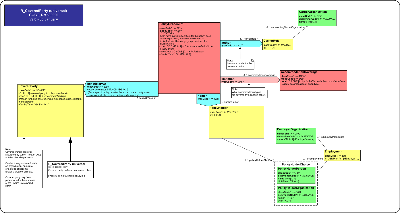
| Parent: | Claims & Reimbursement (FICR_DM000000UV03) |
Note: This CMET is normative in the HL7 V3 2006 Normative Edition.
The CoveredParty CMET specifies a particular covered party under an insurance policy. For the purposes of this CMET, the covered party may not actually be named on the insurance policy (e.g. pedestrian in an auto accident), but may be specified as a covered party when submitting a claim for services.
The policy is described by its policy identifier (may be made up of multiple parts such as plan id, group id, division, section, etc.), type (e.g. private, public, auto, WCB), status and effective date (i.e. date policy in effect).
The policy holder/subscriber may also be noted as an individual (e.g. parent) or organization (e.g. employer).
| R_CoveredParty universal | COCT_MT500000UV04 |
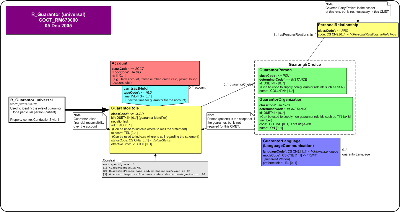
| Parent: | Claims & Reimbursement (FICR_DM000000UV03) |
Note: This CMET is normative in the HL7 V3 2006 Normative Edition.
The Guarantor CMET is used to identify the role of guarantor for a particular person (e.g. patient). A guarantor takes financial responsibility over an account.
This CMET describes the account, type of account, effective dates for the account (e.g. for credit cards, the start/end dates), an account name (e.g. name on the credit card) and balance.
The account holder is noted as the guarantor, which could either be an individual or organization. If the account holder is a person, it may be useful to note the language that the account holder is conversant in. The person that scopes the guarantor (e.g. patient) may also be noted.
| R_Guarantor universal | COCT_MT670000UV04 |
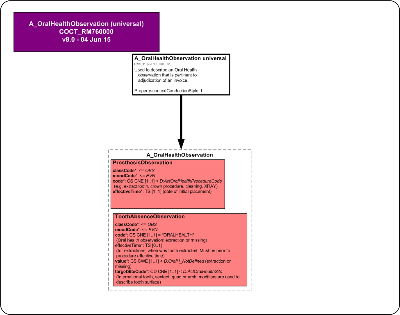
| Parent: | Clinical Statement Pattern (COCS_DM000000UV) |
The OralHealth CMET is used to describe an Oral Health observation that is pertinent to adjudication of an invoice
| A_OralHealthObservation universal | COCT_MT760000UV04 |
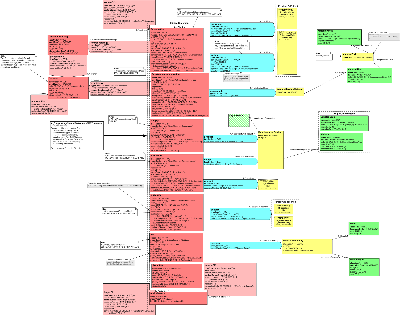
| Parent: | Clinical Statement Pattern (COCS_DM000000UV) |
This CMET is used to supply clinical information in support of clinical services (ordering, scheduling, reporting, etc.). This CMET is based on the Clinical Statement Pattern but constrained to limit the complexity of supporting information.
| R_PatientPersonInformational | COCT_MT050207UV07 |
| R_PatientPersonInformational | COCT_MT050207UV07 |
| R_SpecimenLite | COCT_MT080200UV09 |
| R_SpecimenLite | COCT_MT080200UV09 |
| R_AssignedEntityUniversal | COCT_MT090000UV01 |
| A_SupportingClinicalStatement minimal | COCT_MT530004UV |
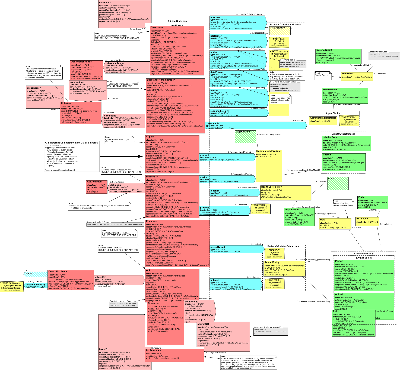
| Parent: | Clinical Statement Pattern (COCS_DM000000UV) |
This CMET is used to supply clinical information in support of clinical services (ordering, scheduling, reporting, etc.). This CMET is based on the Clinical Statement Pattern with derived objects where necessary (sourceOf/targetOf to sourceOf and targetOf).
| R_PatientUniversal | COCT_MT050000UV01 |
| R_PatientUniversal | COCT_MT050000UV01 |
| R_SpecimenUniversal | COCT_MT080000UV09 |
| R_SpecimenUniversal | COCT_MT080000UV09 |
| R_AssignedEntityUniversal | COCT_MT090000UV01 |
| R_AssignedPersonIdentified/confirmable | COCT_MT090102UV02 |
| R_MedicationUniversal | COCT_MT230100UV |
| A_SupportingClinicalStatement universal | COCT_MT530000UV |
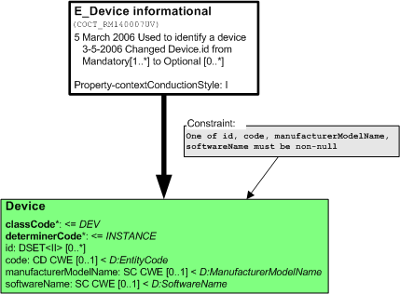
| Parent: | None |
This is the informational variant of E_Device universal.
| E_Device informational | COCT_MT140007UV |
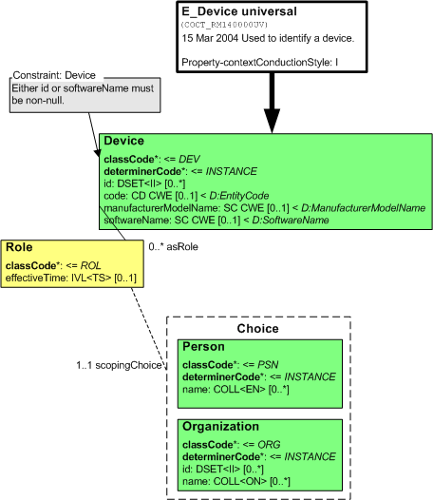
| Parent: | None |
This CMET is used in several places where an "intelligent" device is playing a role in healthcare. Current usage examples include devices acting as "agents" and devices receiving an identity as an "identified" device. The core class includes the code attribute to provide for identification of the type of device, and both manufacturer and software names to characterize what is frequently a computer system.
Further, the device includes an optional repeating Role association that is played by the device and scoped by a person. This allows the sender to further characterize the device according to the person assigned the device to its task, certified it for service, owns it, , etc.
| E_Device universal | COCT_MT140000UV02 |
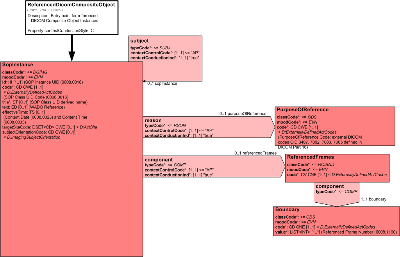
| Parent: | None |
The A_DicomCompositeObjectReference minimal CMET is used to reference DICOM composite objects within HL7 Version 3 messages in the context of acts and observations. It provides detailed information on the referenced DICOM composite object such as images, presentation states and DICOM structured documents. Mappings from DICOM object attributes to the various Act attributes are provided. The CMETs for the HL7 V3 message DICOM composite object references and the corresponding CDA Release 2 section entries are structurally identical. For the CDA section entries different clone names are used according to the specified entry names in the CDA Release2.
Note: The A_DicomCompositeObjectReference minimal CMET COCT_RM830120 may be used in combination with COCT_RM830110 which provides a single location for lookup of referenced DICOM composite objects of an HL7 V3 message (identifying information on the DICOM study/series/instance hierarchy can be found there).
The following description of the act classes and act relationships contains the attribute mappings of HL7 V3 attributes to DICOM (Digital Imaging and Communications in Medicine) tags. The group and element number of the mapped DICOM tags are listed in parenthesis. The CDA mappings specify the use of the CMET act classes and act relationships as CDA Release 2 document section entries.1 SopInstance
The SopInstance act class contains the DICOM Service Object Pair (SOP) Instance information for referenced DICOM composite objects. The SopInstance act class is used to reference both, image and non-image DICOM instances. The text attribute contains the DICOM WADO (Web Access to Persistent DICOM Objects, DICOM Standard PS 3.18) reference.
Table 1 DICOM Composite Object Reference in an HL7 v3 Act
| Attribute | Data Type | Multiplicity | Value |
| classCode | CS | 1..1 | DGIMG |
| moodCode | CS | 1..1 | EVN |
| id | II | 1..1 | <SOP Instance UID (0008,0018) as root property with no extension property> Uniquely identifies the SOP Instance. |
| code | CE | 1..1 | <SOP Class UID (0008,0016) as code property, 1.2.840.10008.2.6.1 as codeSystem property, DCMUID as codeSystemName property, SOP Class UID Name (from PS3.6) as displayName property>: Unique Identifier for the SOP Class as Code Property |
| title | ST | 0..1 | SOP Class UID derived name |
| text | ED | 0..1 | <application/DICOM as mediaType property, WADO reference (see Table X.3-6) as reference property> |
| effectiveTime | TS | 0..1 | <Content Date (0008,0023): The date the content creation (e.g. image pixel data, document) started; and Content Time (0008,0033 ): The time the content creation (e.g. image pixel data, document) started.> |
Note: The DGIMG classCode is used to reference all DICOM Composite Instances, not just diagnostic images.
WADO is a service that enables the Web Client System to retrieve DICOM Persistent Objects managed by a Web Enabled DICOM Server, through the HTTP/HTTPs protocol. The WADO reference uses an URI with query parameters (Table 7). Access to the content of a data object is enabled by specifying a "link" pointing to a specific DICOM Persistent Object by means of its URL/URI and specifying its DICOM object Instance UID and the transfer syntax to be employed.
Table 2 WADO Reference in HL7 DGIMG Observation.Text
| WADO Component | Source |
| <scheme>://<authority>/<path> | Configuration setting, used by the conversion process, identifying the WADO server |
| ?requestType=WADO | Fixed |
| &studyUID=<uid> | Study Instance UID for referenced instance |
| &seriesUID=<uid> | Series Instance UID for referenced instance |
| &objectUID=<uid> | SOP Instance UID for referenced instance |
| &contentType=application/DICOM | Fixed |
1.1 CDA Mapping (Class Name and Attributes used for CDA Documents)
- Act clone name of the CDA entry is "Observation" instead of "SopInstance". The attributes and attribute values of this CDA entry "Observation" are identical to those listed in table 1 and 2.
2 ActRelationship SUBJECT (SopInstance recursive actRelationship)
This optional recursive "SUBJECT" actRelationship is used to link a referenced DICOM Presentation State to one or more associated referenced DICOM images (SopInstance act class is used in both cases) it is applied to.
2.1 CDA Mapping (ActRelationship Name and Attributes used for CDA Documents)
- ActRelationship Clone name: entryRelationship (replaces SUBJECT)
- ActRelationship.typeCode: x_ActRelationshipEntry (Constraint: Fixed value = SUBJ)
- ActRelationship.contextControlCode: "AP" (Additive Propagating)
- ContextConductionInd: "true"
3 ActRelationship REASON (SopInstance to PurposeOfReference)
This optional "REASON" actRelationship is used to relate a referenced DICOM composite object (SopInstance ActClass) with the PurposeOfReference ActClass which includes the coded purpose(s) of reference.
3.1 CDA Mapping (ActRelationship Name and Attributes used for CDA Documents)
- ActRelationship Clone name: entryRelationship (replaces REASON)
- ActRelationship.typeCode: x_ActRelationshipEntry (Constraint: Fixed value = RSON)
- ActRelationship.contextControlCode: "AP" (Additive Propagating)
- ContextConductionInd: "true"
4 PurposeOfReference
Describes the purpose the DICOM composite object reference is made for. Appropriate codes such as externally defined DICOM codes may be used to specify the semantics of the purpose of reference. When absent, implies that the reason for the reference is unknown.
Codes specified in DICOM Part 16 "Content Mapping Resource" (DICOM PS 3.16) shall be used to designate the coded purpose of reference. Candidate codes are contained in the DICOM Context Groups 3407, 7002, 7003 and 7005. The attribute mapping for the code attributes are listed in table 3.
Table 3 DICOM Coded Purpose of Reference in an HL7 v3 Act
| Attribute | Data Type | Multiplicity | Value |
| classCode | CS | 1..1 | OBS |
| moodCode | CS | 1..1 | EVN |
| code | CE | 1..1 | <Code Value (0008,0100) as code property, 1.2.840.10008.2.16.4 as codeSystem property, Coding Scheme Designator (0008,0102) as codeSystemName property, Code Meaning (0008,0104) as displayName property> |
4.1 CDA Mapping (Class Name and Attributes used for CDA Documents)
- Act Clone Name: Observation
- Act clone name of the CDA entry is "Observation" instead of "PurposeOfReference"
- The attributes and attribute values of this "Observation" CDA entry are identical to those listed in table 3
5 ActRelationship COMPONENT (SopInstance to ReferencedFrames)
This optional "COMPONENT" actRelationship is used to link a referenced DICOM composite object to one or more frames of a DICOM multi-frame image SOP instance.
5.1 CDA Mapping (ActRelationship Name and Attributes used for CDA Documents)
- ActRelationship Clone name: entryRelationship (replaces COMPONENT)
- ActRelationship.typeCode: x_ActRelationshipEntry (Constraint: Fixed value = COMP)
- ActRelationship.contextControlCode: "AP" (Additive Propagating)
- ContextConductionInd: "true"
6 ReferencedFrames
This act class shall be used if the referenced DICOM SOP instance is a multi-frame image and the reference does not apply to all frames. The list of integer values for the referenced frames of a DICOM multi-frame image SOP instance is contained in the Boundary ActClass.Table 4 DICOM Referenced Frames in an HL7 v3 Act
| Attribute | Data Type | Multiplicity | Value |
| classCode | CS | 1..1 | ROIBND |
| moodCode | CS | 1..1 | EVN |
| code | CV | 1..1 | <Code Value (0008,0100) as code property, 1.2.840.10008.2.16.4 as codeSystem property, DCM as codeSystemName property, Code Meaning (0008,0104) as displayName property>: Proposal to define an appropriate DICOM code has been submitted |
6.1 CDA Mapping (Class Name and Attributes used for CDA Documents)
- Act Clone Name: Observation
- Act clone name of the CDA entry is "Observation" instead of "ReferencedFrames"
7 ActRelationship Component (ReferencedFrames to Boundary)
This "COMPONENT" actRelationship is used to link the ReferencedFrames ActClass to the Boundary ActClass which contains the list of integer values for the referenced frames of a DICOM multi-frame image SOP instance.
7.1 CDA Mapping (ActRelationship Name and Attributes used for CDA Documents)
-
ActRelationship Clone name: entryRelationship (replaces COMPONENT)
- ActRelationship.typeCode: x_ActRelationshipEntry (Contstraint: Fixed value = COMP)
8 Boundary
The act class contains a list of integer values for the referenced frames of a DICOM multi-frame image SOP instance. It identifies the frame numbers within the Referenced SOP Instance to which the reference applies. The first frame shall be denoted as frame number 1. This act class shall be used if the referenced DICOM SOP instance is a multi-frame image and the reference does not apply to all frames.
Table 5 Boundary ActClass
|
Attribute |
Data Type |
Multiplicity |
Value |
|
classCode |
CS |
1..1 |
OBS |
|
moodCode |
CS |
1..1 |
EVN |
|
code |
CE |
1..1 |
<Code Value (0008,0100) as code property, 1.2.840.10008.2.16.4 as codeSystem property, DCM as codeSystemName property, Code Meaning (0008,0104) as displayName property>: Proposal to define an appropriate DICOM code has been submitted |
|
value |
LIST<INT> |
1..* |
<Referenced Frame Number (0008,1160)> Identifies the frame numbers within the Referenced SOP Instance to which the reference applies. The first frame shall be denoted as frame number 1. Values shall be provided if the Referenced SOP Instance is a multi-frame image and the reference does not apply to all frames. |
8.1 CDA Mapping (Class Name and Attributes used for CDA Documents)
-
Act Clone Name: ObservationAct clone name of the CDA entry is "Observation" instead of "Boundary"
Message Element Types Used
None| A_DicomCompositeObjectReference minimal | COCT_MT830120UV05 |
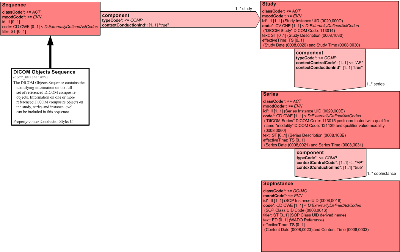
| Parent: | None |
The A_DicomSequence minimal CMET is used to reference DICOM composite objects within HL7 Version 3 messages. It provides a single location for the identifying information of the study/series/instance hierarchical context of DICOM composite objects that are referenced for a specific purpose. Additional information on this context (e.g. Study Description) may optionally be added. Mappings from DICOM object attributes to the various Act attributes are provided. The CMETs for the HL7 V3 message sequence and the CDA Release 2 section are structurally identical. For the CDA section pattern different clone names are used according to the specified entry names of CDA Release 2.
Note: The A_DicomSequence minimal CMET may be used in combination with COCT_RM830120 to provide additional structured information on individual references to DICOM composite objects. COCT_RM830120 is used to put the references into the context of other acts and observations (e.g. relate referenced DICOM images to lab observations).
The following description of the act classes and act relationships contains the attribute mappings of HL7 V3 attributes to DICOM (Digital Imaging and Communications in Medicine) tags. The group and element number of the mapped DICOM tags are listed in parenthesis. The CDA mappings specify the use of the CMET act classes and act relationships for a CDA Release 2 document section which contains section entries.1 Sequence
The DICOM Objects Sequence contains the identifying information on DICOM composite objects referenced in a HL7 V3 message for a specific purpose. The sequence can be used for any HL7 V3 message which includes references to composite DICOM objects, such as images and structured reports. Information on one or more referenced DICOM composite objects on the study, series and instance level can be included in a sequence.
Table 1 Sequence Act
| Attribute | Data Type | Multiplicity | Value |
| classCode | CS | 1..1 | ACT |
| moodCode | CS | 1..1 | EVN |
| id | II | 0..1 | Sequence Identifier |
| code | CE | 1..1 | Externally defined DICOM codes, e.g. <121181 as code property, 1.2.840.10008.2.16.4 as codeSystem property, DCM as codeSystemName property, e.g. "DICOM Object Catalog" as displayName property> |
| title | ST | 0..1 | <e.g. "DICOM Object Catalog"> |
1.1 CDA Mapping (Class Name and Attributes used for CDA Documents)
Section (replaces Sequence)
The CDA DICOM Objects Section contains the identifying information on DICOM composite objects referenced in a CDA Release2 document for a specific purpose. The CDA DICOM Objects Section can be used within any CDA Release 2 document which includes references to composite DICOM objects in the structured part of the CDA document, such as images and structured reports. Information on one or more referenced DICOM composite objects on the study, series and instance level can be included in this section.
Table 2 Section Act
| Attribute | Data Type | Multiplicity | Value |
| classCode | CS | 1..1 | ACT |
| moodCode | CS | 1..1 | EVN |
| id | II | 0..1 | Section Identifier |
| code | CE | 1..1 | Externally defined DICOM codes, e.g. <121181 as code property, 1.2.840.10008.2.16.4 as codeSystem property, DCM as codeSystemName property, e.g. "DICOM Object Catalog" as displayName property> |
| title | ST | 0..1 | <e.g. "DICOM Object Catalog"> |
DICOM Supplement 101:
Specifies the semantics of the section e.g. "DICOM Object Catalog" (DICOM Code Value: 121181) which contains information on the full set of DICOM composite objects referenced in the CDA document: "It is recommended that this list be transcoded to CDA Entries in a Section with Section.Title "DICOM Object Catalog" and a Section.Code of 121181 from the DICOM Controlled Terminology (see PS3.16)."
2 ActRelationship COMPONENT (Sequence to Study)
This actRelationship "COMPONENT" is used to link Sequence with one or more associated study acts.
2.1 CDA Mapping (ActRelationship Name and Attributes used for CDA Documents)
- ActRelationship Clone name: entry (replaces COMPONENT)
- ActRelationship.typeCode: x_ActRelationshipEntry (Constraint: Fixed value = COMP)
- ContextConductionInd: "true"
3 Study
The Study act class contains the DICOM study information that defines the characteristics of a referenced medical study performed on a patient. A study is a collection of one or more series of medical images, presentation states, SR documents, overlays and/or curves that are logically related for the purpose of diagnosing a patient. Each study is associated with exactly one patient. A study may include composite instances that are created by a single modality, multiple modalities or by multiple devices of the same modality. The study information is modality independent.
Table 3 DICOM Study Reference in an HL7 v3 Act
| Attribute | Data Type | Multiplicity | Value |
| classCode | CS | 1..1 | ACT |
| moodCode | CS | 1..1 | EVN |
| id | II | 1..1 | <Study Instance UID (0020,000D) as root property with no extension property>: Unique identifier for the Study |
| code | CV | 1..1 | <113014 as code property, 1.2.840.10008.2.16.4 as codeSystem property, DCM as codeSystemName property, "DICOM Study" as displayName property> |
| text | ST | 0..1 | <Study Description (0008,1030)> Institution-generated description or classification of the Study (component) performed. |
| effectiveTime | TS | 0..1 | <Study Date (0008,0020): Date the Study started; and Study Time (0008,0030): Time the Study started.> |
3.1 CDA Mapping (Class Name and Attributes used for CDA Documents)
- Act clone name of the CDA entry is "Act" instead of "Study". The attributes and attribute values of this CDA entry "Act" are identical to those listed in table 3.
4 ActRelationship COMPONENT (Study to Series)
This actRelationship "COMPONENT" is used to link one study act with one or more associated series acts.
4.1 CDA Mapping (ActRelationship Name and Attributes used for CDA Documents)
- ActRelationship Clone name: entryRelationship (replaces COMPONENT)
- ActRelationship.typeCode: x_ActRelationshipEntry (Constraint: Fixed value = COMP)
- ActRelationship.contextControlCode: "AP" (Additive Propagating)
- ContextConductionInd: "true"
5 Series
The Series act class contains the DICOM series information for referenced DICOM composite objects. The series information defines the attributes that are used to group composite instances into distinct logical sets. Each series is associated with exactly one study.
Table 4 DICOM Series Reference in an HL7 v3 Act
| Attribute | Data Type | Multiplicity | Value |
| classCode | CS | 1..1 | ACT |
| moodCode | CS | 1..1 | EVN |
| id | II | 1..1 | <Series Instance UID (0020,000E) as root property with no extension property> ): Unique identifier of the Series. |
| code | CD | 0..1 | <113015 as code property, 1.2.840.10008.2.16.4 as codeSystem property, DCM as codeSystemName property, "DICOM Series" as displayName property, Modality as qualifier property (see text and Table 5)> |
| text | ST | 0..1 | <Series Description (0008,103E)> User provided description of the Series |
| effectiveTime | TS | 0..1 | <Series Date (0008,0021) : Date the Series started. and Series Time (0008,0031): Time the Series started.> |
The code for the Act representing a Series uses a qualifier property to indicate the modality. The qualifier property is a list of coded name/value pairs. For this use, only a single list entry is used, as described in Table 5.
Table 5 Modality Qualifier for the Series Act.Code
| Property | Data Type | Value |
| name | CV | <121139 as code property, 1.2.840.10008.2.16.4 as codeSystem property, DCM as codeSystemName property, "Modality" as displayName property> |
| value | CD | <Modality (0008,0060) as code property, 1.2.840.10008.2.16.4 as codeSystem property, DCM as codeSystemName property, Modality code meaning (from PS3.16) as displayName property> |
5.1 CDA Mapping (Class Name and Attributes used for CDA Documents)
- Act Clone Name: Act
- Act clone name of the CDA entry is "Act" instead of "Series". The attributes and attribute values of this CDA entry "Act" are identical to those listed in table 4 and 5.
6 ActRelationship COMPONENT (Series to SopInstance)
This actRelationship "COMPONENT" is used to link one series act with one or more associated SopInstance acts.
6.1 CDA Mapping (ActRelationship Name and Attributes used for CDA Documents)
- ActRelationship Clone name: entryRelationship (replaces COMPONENT)
- ActRelationship.typeCode: x_ActRelationshipEntry (Constraint: Fixed value = COMP)
- ActRelationship.contextControlCode: "AP" (Additive Propagating)
- ContextConductionInd: "true"
Please refer to A_DicomCompositeObjectReference minimal CMETfor the description of the SopInstance act class.
Message Element Types Used
None
| A_DicomSequence minimal | COCT_MT830110UV05 |
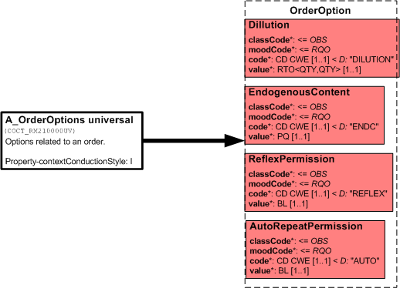
| Parent: | Laboratory Observation (POLB_DM000000UV) |
CMET NAME: A_Order_options
DOMAIN OVERVIEW The A_Order_options CMET is used to specify additional information specific to laboratory order. The information provided can be used by automation systems to specify additional configurable parameters related to the automated analysis of a specimen. This includes things like the endogenous content of a diluent; whether the instrument is given permission to repeat a test, with or without a specified dilution; perform an unordered test (reflex) based on results for something ordered.
FOCAL AREA STRUCTURE All of the characteristics described are observations and hence the entry point into the Order Options CMET is a choice among these observations.
REQUIRED ELEMENTS MANDATORY There are no mandatory elements beyond the structural elements required by the RIM. MUST SUPPORT All elements occurring in the Specimen CMET must be supported.
FOCAL CLASS CMET NAME: A_Order_options
| A_OrderOptions universal | COCT_MT210000UV02 |
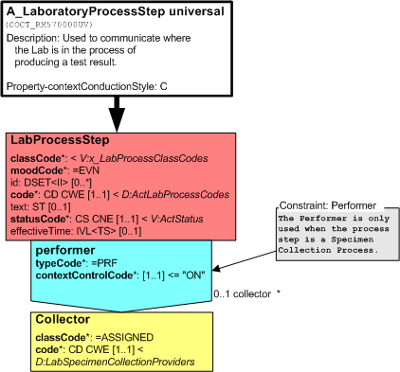
| Parent: | Laboratory Observation (POLB_DM000000UV) |
The A_LaboratoryProcessStep universal CMET is used to communicate where the laboratory is in the process of producing a test result.
Model Walkthrough
LabProcessStep: The LabProcessStep is an ACT that is used to document various parts of the Lab workflow associated with producing a laboratory result.
- classCode: The classCode for the LabProcessStep class is drawn from a value set which includes values such as ACSN (accession), CONTREG (container registration), PROC (procedure), SPECCOLLECT (specimen collection), SPCTRN (specimen treatment) and TRNS (transport).
- The mood of LabProcessStep is always EVN (event).
- id: The optional id attribute is used to carry one or more identifiers which uniquely identify this process step from all other process steps.
- code: The mandatory code attribute is used to further identify the specific process step this class is documenting.
- text: The optional text attribute is used to describe the process step.
- statusCode: The mandatory statusCode attribute is used to communicate the state of the process step. Complete would indicate the process step has been finished. Active would indicate the process step is still in progress, etc.
- effectiveTime: The optional effectiveTime attribute is used to indicate the time (or interval of time) that the process step was active.
LabProcessStep Participations:
Performer: The Performer participation is used only when the process step is a Specimen Collection process.
- typeCode: The Participation.typeCode has been restricted to PRF (performer).
- contextControlCode: The mandatory contextControlCode has been given a default value of "ON" indicating the context is overriding and non-propagating by default.
Collector: Performer associates the LabProcessStep with the Collector role. The Collector Role (as an assigned entity) is used to document at a high level what role is responsible for collecting a specimen. This class carries some of the functionality found in the 2.x Specimen Action Code (OBR.11).
- code: The mandatory code attribute is used to identify at a high level who is responsible for collecting a specimen. Types of values include "laboratory", "phlebotomist", "pathologist", etc.
| A_LaboratoryProcessStep universal | COCT_MT570000UV09 |
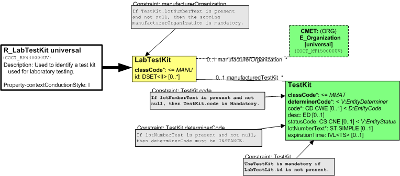
| Parent: | Laboratory Observation (POLB_DM000000UV) |
The R_LabTestKit universal CMET universal is used to identify and characterize a test kit used to produce a test result.
Model Walkthrough
LabTestKit: The LabTestKit is a manufactured product role (RoleClassManufacturedProduct) that is used to identify the lab test kit. The role is played the manufactured material representing the test kit. The role is scoped by the organization manufacturing the test kit.
LabTestKit Associations:
manufacturerOrganization: The LabTestKit role is scoped by the manufacturerOrganization. The manufacturerOrganization is documented using the E_Organization universal CMET. There may be 0..1 manufacturerOrganizations. If TestKit.lotNumberText is present, then manufacturerOrganization is mandatory. The manufacturerOrganization is mandatory in this circumstance because lot numbers are unique only in conjunction with the code identifying the test kit and the manufacturer of the test kit.
manufacturedTestKit: The LabTestKit role is played by the manufacturedTestKit. The manufacturedTestKit is documented using a Manufactured Material (MMAT) Entity. There may be 0..1 manufacturedTestKits. If the LabTestKit.id is not present, then the manufacturedTestKit must be present in the CMET. This means the test kit must either be identified, or it must be described.
| E_OrganizationUniversal | COCT_MT150000UV02 |
| R_LabTestKit universal | COCT_MT430000UV09 |

| Parent: | Laboratory Observation (POLB_DM000000UV) |
CMET NAME: Reagent
DOMAIN OVERVIEW The Reagent CMET provides information specific to the reagent used in the analysis of a specimen. It provides information that relates to the manufacturer of the reagent and more specific information such as the lot and expiration date of the reagent.
FOCAL AREA STRUCTURE The concept of the CMET is to associate the reagent with its manufacturer, expiration date and lot number.
REQUIRED ELEMENTS MANDATORY There are no mandatory elements beyond the structural elements required by the RIM. MUST SUPPORT All elements occurring in the Reagent CMET must be supported.
FOCAL CLASS
R_Reagent The focal class R_Reagent. The substance named by the id attribute plays the role of reagent.
| E_OrganizationUniversal | COCT_MT150000UV02 |
| R_Reagent universal | COCT_MT250000UV03 |
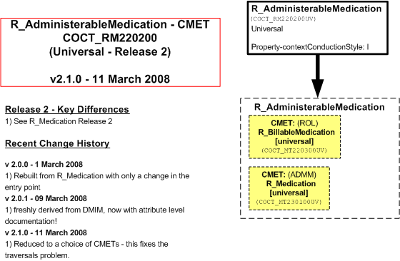
| Parent: | None |
This is the entry point to the Medication Model for messages concerned with a medication supplied or administered to a patient . This may be an a medication or a packaged medicine.
Note: This model is a subset from the POME DMIM and a full walkthrough is desccribed there.
| R_BillableMedicationUniversal | COCT_MT220300UV |
| R_MedicationUniversal | COCT_MT230100UV |
| R_AdministerableMedication universal | COCT_MT220200UV |
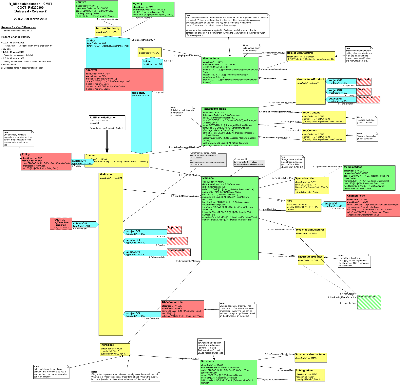
| Parent: | None |
This is the entry point to the Medication Model for messages concerned with identifying a medication supplied or administered to a patient from a billing perspective ..
Note: This model is a subset from the POME DMIM and a full walkthrough is desccribed there.
| A_ValuedItemIdentified | COCT_MT440001UV09 |
| R_BillableMedication uiniversal | COCT_MT220300UV |
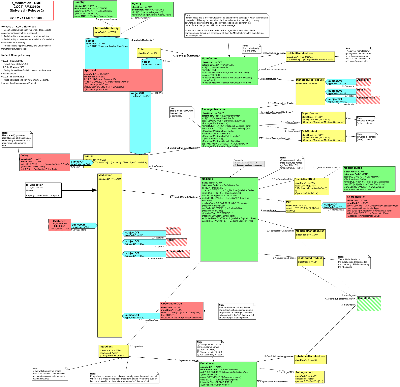
| Parent: | None |
This is the entry point to the Medication Model for messages concerned with a medication rather than a packaged medicine.
Note: This model is a subset from the POME DMIM and a full walkthrough is desccribed there.
| A_ValuedItemIdentified | COCT_MT440001UV09 |
| R_Medication universal | COCT_MT230100UV |
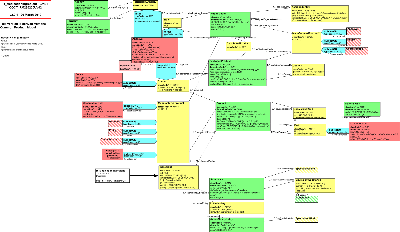
| Parent: | None |
This is the entry point to the Medication Model for messages concerned with a medication ingredient.
Note: This model is now based on the Common Product Model DMIM.
| A_ValuedItemIdentified | COCT_MT440001UV09 |
| R_MedicationIngredient universal | COCT_MT230200UV |
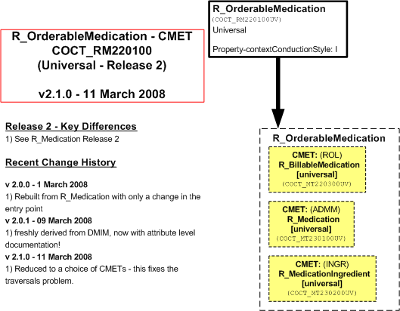
| Parent: | None |
This is the entry point to the Medication Model for messages concerned with a order medication for a patient. This may be an ingredient, a medication or a packaged medicine.
Note: This model is a subset from the POME DMIM and a full walkthrough is desccribed there.
| R_BillableMedicationUniversal | COCT_MT220300UV |
| R_MedicationUniversal | COCT_MT230100UV |
| R_MedicationIngredientUniversal | COCT_MT230200UV |
| R_OrderableMedication | COCT_MT220100UV |
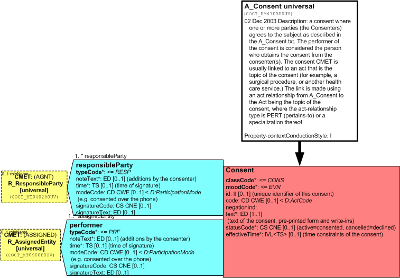
| Parent: | Medical Records (RCMR_DM000050UV) |
A consent where one or more parties (the Consenters) agree to the subject as described in the A_Consent.text. The performer of the consent is considered the person who obtains the consent from the consenter(s). The consent CMET is usually linked to an Act that is the topic of the consent (for example, a surgical procedure, or another health care service). The link is made using an Act relationship from A_Consent to the Act being the topic of the consent, where the ActRelationship type is PERT (pertains-to) or a specialization thereof.
| R_ResponsiblePartyUniversal | COCT_MT040200UV09 |
| R_AssignedEntityUniversal | COCT_MT090000UV01 |
| A_Consent universal | COCT_MT470000UV |
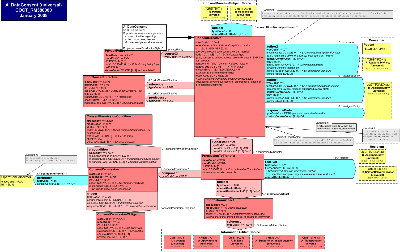
| Parent: | Medical Records (RCMR_DM000050UV) |
Usage Notes: This CMET conveys a Consent Directive that may authorize or prohibit one or more information transfers or "access" by recipients to perform system operations for specified purposed under certain conditions with certain obligations on types or instances of information artifacts over which the authoring party has control. The CMET may be sent in conjunction with the transmission of an information artifact, a query, a query response, and may reference the content of one or more prior Consent Directive instances in whole or part. In future ballots, CMET variants may be developed to reference a Consent Directive instance rather than convey details that a receiving system does not need to receive because it can directly access the consent directive details.
The Data Consent CMET captures the data and associations needed to (1) record or report a consumer's consent or dissent to authorize the collection, access, use, or disclosure of personally identifiable information; (2) convey a provider's request or intent to override a patient's recorded consent or dissent; (3) report a provider's actual override of a patient's recorded consent or dissent for audit purposes; (4) convey a type of consent directive associated with a privacy policy; or (5) to record or report a consumer's consent directive, which is to be applied to future access, collection, use or disclosure of personally identifiable information. This CMET may be attached to a message or used in association with the transmission of a clinical document to specify the consent directives of the subject of personal health information therein conveyed. Note that a consumer may or may not be a patient and the information to which the consent directive applies may or may not be health information. It must be personally identifiable information. For the purposes of this walk through, "consumer" means both an actual and a potential consumer of services such as healthcare.
The subject of a consumer's consent directive include specific instances or categories of information, including orders and results for lab, medications, diagnostic imaging; allergy and intolerance, medical condition, observations, demographics, immunizations, providers, and encounters. Note that categories of information may relate to a particular structuring of information, such medication lists or summary health record, or it may relate to groupings of value sets and particular classes and attributes that may be indicative of a category of information or from which a category of information may be inferred. As stated in the HL7 Reference Information Model at 3.1.1.14 Act.confidentialityCode: "Inference means that filtered sensitive information can still be assumed given the other information that was not filtered. The simplest form of inference is that even the existence of a test order for an HIV Western Blot test or a T4/T8 lymphocyte count is a strong indication for an existing HIV infection, even if the results are not known. Very often, diagnoses can be inferred from medication, such as Zidovudin for treatment of HIV infections."
The Attributes of the Focal Class ConsentDirective
The ConsentDirective classCode CONS: The act class consent refers in this context to consent related to the collection, access, use, or disclosure of a consumer's personally identifiable information. The type of consent is specified at a high level by the ActConsentType code. If the ConsentDirective type authorizes the transfer of one or more InformationArtifacts, then further detail is required to be conveyed if known such as the recipients of subject InformationArtifacts; operations permitted to be performed on those InformationArtifacts; the purposes for which an operation may be performed; the roles permitted to perform the operations, as well as any preconditions or resulting obligations. NOTE Constraint: If ActConsentType is INFA, then the PermissionToTransfer must be present. This is required regardless of whether the negationInd is null, true or false. In the case where consent to access is not granted, the PermissionToTransfer and its associated classes are used to specify the details of a masking directive.
The ConsentDirective moodCode x_ActMoodCompletionCriterion may be used (1) in the event mood EVN to indicate that a consumer has consented or dissented to authorize the collection, access, use, or disclosure of personally identifiable information; and to report a provider's actual override of a patient's recorded consent or dissent, which may be used for audit purposes; (2) in the intent INT or request RQO mood to convey a provider's intent or request to override a patient's recorded consent or dissent; (3) in the definition mood DEF to convey a type of consent directive associated with a privacy policy; or (4) in the criterion mood CRIT to record or report a consumer's consent directive, which is to be applied to future collection, access, use or disclosure of the consumer's personally identifiable information.
The ConsentDirective id II BUS_VER: A consent directive identifier is required to be sent if known. This uniquely identifies a consent directive or consent directive override instance as a business object and as a version of that business object as it exists at a given point in time. Note that this is a Release 2 Data Type that supports a scope attribute on the Instance Identifier. In the Data Types - Abstract Specification, Release 2 at 4.13.4, a Business Identifier is defined as: "An identifier that is associated with the object due to the business practices associated with the object. The scope of the use of the id may not be restricted to a single object, but may be reused for other objects closely associated with the object due to business practice." A Version Identifier is defined as: "An identifier that references a particular object as it existed at a given point in time. The identifier can be considered an identifier of a static snapshot of the object. The identifier changes with each state transition on the object. I.e. the version identifier of an object prior to a 'suspend' state transition is distinct from the identifier of the object after the state transition. Each version identifier can be tied to exactly one ControlAct event which brought that version into being (though the control act may never be instantiated). NOTE: Applications that do not support versioning of objects must ignore and not persist these ids to avoid confusion resulting from leaving the same identifier on an object that undergoes changes."
The ConsentDirective code ActConsentType: The type of consent being granted, refused, revoked, or overridden shall be specified by a code from the ActConsentType concept domain, e.g., consent to collect, access, use, or disclose, e.g., for research.
The ConsentDirective negationInd with default set to "false": The presence of the negation indicator set to "false" indicates that the consumer consents to grant the permission indicated by the ActConsentType. A negation indicator is set to "true" indicates a consumer's dissent. If a consumer had previously consented to access, that permission may be revoked by sending a second Data Consent message/CMET with the same Consent Directive, as indicated by an identical consent directive Business Identifier and a new Version Identifier, and setting the negationInd to "true". Note that the negationInd must either be non-null or not sent, the later case may be an indication that the consumer's consent was deemed or implied, i.e., the consumer did not have or is not provided an opportunity to actively consent or dissent to any or all permissions relating to collection, access, use, and disclosure of personally identifiable information. NOTE Constraint: If the negationInd is "false", then the PermissionToInform is mandatory.
The ConsentDirective statusCode: A statusCode from the specializable ActStatusNormal concept domain must be sent.
The ConsentDirective effectiveTime: The Consent effective and end time is required to be sent if known.
The ConsentDirective reasonCode: If a provider or other authorized assigned entity is participating in the ConsentDirective as author1, then a code from the ActConsentInformationAccessOverrideReason concept domain must be sent if known to indicate the provider's reason for overriding a patient's consent directive. Otherwise, the ActConsentInformationAccessOverrideReason must not be used. Note that this is a constraint.
The ConsentDirective shall be linked with the subject participation typeCode SBJ to the choice of either the R_ResponsibleParty (universal) or R_Patient (universal) CMET indicating that one and only one consumer or patient shall be the subject of the ConsentDirective.
The subject participation contextControlCode OP indicates that any party participating as a subject in the ConsentDirective overrides all subjects from any ancestral subject participations and propagate to all descendant acts reached by conducting ActRelationships.
NOTE Constraints: The ConsentDirective must be linked by an AUT participation to one and only one type of authoring role, either "author2" the consenter role, which may be the patient and/or one or more responsible parties; or "author1", which may be zero to one assigned entity. If author1 then there must be a responsibleParty who is ultimately responsible for author1.
The author2 participation typeCode AUT is required to link the ConsentDirective to zero to many consenting party, which may be either a Patient of roleClassPAT who is the same person entity referenced in the R_Patient CMET; or a consumer or one or more delegates of a consumer or patient as represented by the R_ResponsibleParty CMET. Note that the R_ResponsibleParty is used here rather than the more constrained R_AssignedParty, because the former does not specify the type of scoping organization, if any, while the latter may only be scoped by an organization, thereby implying that an organization is to some extent accountable for the functions undertaken by a player of an AssignedParty role.
The author2 participation functionCode may be sent using codes from the ConsenterParticipationFunction concept domain to indicate the function served by the a R_ResponsibleParty participation in the authoring of a consent directive, e.g., as a legal guardian or a representative with powers of attorney.
The mandatory author2 participation contextControlCode OP indicates that any consenting party participating as an author in the ConsentDirective overrides all authors from any ancestral author participations and propagate to all descendant acts reached by conducting ActRelationships.
The author2 participation time must be sent to indicate the time at which the consenting party authored the consent directive.
The author2 participation modeCode must be sent if available to indicate the modality by which the consenter participated in authoring the consent directive, using codes from the ParticipationMode domain to specifies whether the consent was provided e.g., in person, over the telephone; or verbally, electronically, or on paper .
The author2 participation signatureCode must be sent if available to specify whether and how the participant has attested to his or her participation through a signature.
The author2 participation signatureText may be sent used to send a textual or multimedia depiction of the signature by which the participant endorses his or her participation in the Act as the author, and that he or she agrees to assume the associated accountability.
The author1 participation typeCode AUT is required to link the ConsentDirective to zero or one assignedEntity, which is conveyed by the R_AssignedEntity (universal) CMET.
The author1 participation functionCode may be sent using codes from the OverrideParticipationFunction concept domain to indicate the function served by the a R_AssignedParty in the authoring of a consent directive override, e.g., as an authorized clerical staff charged with creating a default consent directive or updating an existing consent directive based on changed privacy policy; a resident authoring an override for a a responsible party to mask information from the consumer; or a provider that is authorized to "break the glass" to access critical health information.
The mandatory author1 participation contextControlCode OP indicates that any assigned entity participating as an author in the ConsentDirective overrides all authors from any ancestral author participations and propagate to all descendant acts reached by conducting ActRelationships.
The author1 participation time may be sent to indicate the time at which the AssignedEntity authored the consent directive override.
The author1 participation signatureCode must be sent if available to specify whether and how the participant has attested to his or her participation through a signature.
The author1 participation signatureText may be sent used to send a textual or multimedia depiction of the signature by which the participant endorses his or her participation in the Act as specified an author, and that he or she agrees to assume the associated accountability.
The responsibleParty typeCode RESP is required to link the ConsentDirective to zero or one assignedEntity, which is conveyed by the R_AssignedEntity (universal) CMET.
The ConsentDirective may have a predecessor relationship typeCode SUCC as the source act to zero to many PriorConsentDirective(s) target acts in circumstances where one or more prior consent directive types such as a notice of privacy practices, an opt-in to collection, a restriction on disclosure for non-treatment purposes, and a delegation to a healthcare representative, typically a paper or online form is replaced or succeeded by the focal coded ConsentDirective that is substantially equivalent to and fully specifies the content expressed by one or more PriorConsentDirectives types.
The ConsentDirective may have a reference relationship typeCode REFR as a source act of zero to many PriorConsentDirective(s) target acts in circumstances where the prior consent directive artifacts are captured and maintained in hard-copy as validation of the focal coded ConsentDirective especially in circumstances where the healthcare consumer's digital signature may not be legally accepted or technically supported for purposes of attestation of the ConsentDirective.
Attributes of PriorConsentDirective: One or more consent directives may be predecessors of the focal consent directive. A predecessor consent directives may be captured as an Xform; an electronic text image; or hard copy unstructured text . If a hard-copy consent directive is used as evidence of the consenter's attestation to the focal ConsentDirective, e.g., in situations where legally, a signature is required but digital signatures is not technically supported or not legally binding, then attaching a scanned consent directive or text image file with a wet signature may satisfy the business requirement.
The PriorConsentDirective classCode: This class has an act type of CONS or "consent", which is the legal transaction between a healthcare consumer and an actual or potential custodian of the consumer's information conveying grants or denials of permission to collect, access, use or disclose this information.
The PriorConsentDirective moodCode: The mood of this act is event EVN, indicating that the prior consent directive has occurred or is in the process of occurring.
The PriorConsentDirective id: A set of zero to many identifiers is required to be sent if known to identify a prior consent directive.
The PriorConsentDirective code ActConsentDirectiveType may be used to convey the type of prior consent directive types that may be singly or combined into the focal fully specified, structured Consent Directive, e.g. a notice of privacy practices, an opt-in to collection, a restriction on disclosure for non-treatment purposes, of a delegation to a healthcare representative. NOTE: This ActCode was approved during the Fall 2007 Harmonization Meeting, and is defined as the type of consent directive indicated by an ActClassPolicy e.g., a 3rd party authorization to disclose or a consent for a substitute decision maker (SDM) or a notice of privacy policy. It is a sibling to ActPrivacyPolicyType and a child of ActPolicyType.
The PriorConsentDirective text of type ED: A PriorConsentDirective text image may be attached. Where a consent directive is substantially equivalent predecessor of the focal consent directive, and the prior consent directive is used as evidence of the consenter's attestation to the focal ConsentDirective, e.g., in situations where legally, a signature is required but digital signatures is not technically supported or not legally binding, then attaching e.g., a scanned consent directive with a wet signature and/or referencing the PriorConsentDirective identifier may be legally sufficient proof of attestation as long as the association to the signed directive is maintained.
The PriorConsentDirective statusCode: A statusCode with the default of "complete" may be sent.
The PriorConsentDirective effectiveTime: The Consent effective and end time must be sent if known. This is of importance where the signature on the PriorConsentDirective is the legal basis for attestation of the focal ConsentDirective.
The PriorConsentDirective languageCode HumanLanguage: The language used in the PriorConsentDirective may be sent.
The ConsentDirective may have a reference relationship typeCode COMPLY to the PrivacyPolicy meaning that the source act, the focal ConsentDirective complies with, adheres to, conforms to, or is permissible under (in whole or in part) the policy, contract, agreement, law, conformance criteria, certification guidelines or requirement conveyed by the PrivacyPolicy as the target act. NOTE: This ActRelationshipType was approved during the Fall 2007 Harmonization meeting, and means that the source act complies with, adheres to, conforms to, or is permissible under the target act, either in whole or in part. Example act types include policies, contracts, agreements, laws, conformance criteria, certification guidelines, and requirements.
Attributes of PrivacyPolicy
The PrivacyPolicy classCode: This class has an act type of POLICY, which is defined as a mandate, regulation, obligation, requirement, rule, or expectation unilaterally imposed by one party on the activity or behavior of another party, or on the manner in which an act is executed. In this context, the policy relates to a jurisdictional or organizational policy relating to the healthcare consumer's right of privacy in personal information and any confidentiality requirements related to its use.
The PrivacyPolicy moodCode: The mood of this act is permission EVN, indicating that the PrivacyPolicy is or has been in effect.
The PrivacyPolicy id: A set of zero to many identifiers is required be used to identify this policy if known.
The PrivacyPolicy code is required be specified if known from the ActPrivacyPolicyType concept domain to identify the type of privacy policy governing the ConsentDirective, e.g., privacy policy about the consent requirements for disclosure of health information related to treatment in a substance abuse program. NOTE: This ActCode was approved during the Fall 2007 Harmonization Meeting, and is defined as the type of privacy policy indicated by an ActClassPolicy, e.g., privacy policy about the consent requirements for disclosure of health information related to treatment in a substance abuse program covered by 42 CFR Part 2. It is a sibling to ActConsentDirectiveType.
The ConsentDirective may have an authorization relationship typeCode AUTH of zero to many PermissionToTransfer acts.
The authorization relationship is required have one contextControlCode set to ON to indicate that the author may override but not propagate authorship to the child Acts, i.e., if author1 overrides a consent directive with certain permissions, then the overriding author does not author those permissions.
The authorization relationship contextConductionInd is set to true to indicate that the context marked as conducting will conducts to child acts.
Attributes of PermissionToTransfer
The PermissionToTransfer classCode: This class has an act type of TRFR or "transfer", which is defined as "The act of transferring or providing access to information about a topic to a subject."
The PermissionToTransfer moodCode: The mood of this act is permission PERM, indicating that informing recipients about the subject act is authorized by the ConsentDirective author.
The PermissionToTransfer id: A set of zero to many identifiers may be used to identify this act.
The PermissionToTransfer code may be specified from the ActInformationTransferCode concept domain to provide information about the protocols by which the information transfer is permitted, e.g., in accordance with legal or regulatory requirements. NOTE: This ActCode was approved during the Fall 2007 Harmonization Meeting.
The receiver participation typeCode RCV is required to link the PermissionToTransfer to zero or more recipients being granted permission, which may be either an assigned person conveyed by the R_AssignedPerson (universal) CMET or a service delivery location conveyed by the R_ServiceDeliveryLocation (universal) CMET.
The receiver participation contextControlCode OP indicates that any recipients receiving permission to be informed override all recipients from any ancestral receiver participation and propagate to all descendant acts reached by conducting ActRelationships.
The receiver participation participationFunction may be sent using codes from the AuthorizedReceiverParticipationFunction concept domain to indicate the receiver functions of the R_AssignedEntity or the R_ServiceDeliveryLocation roles, such as information custodian, care team, or work area.
The PermissionToTransfer shall have as subjects one or more InformationArtifact(s) via the subject relationship typeCode SUBJ. The contextControlCode ON indicates that the permitted release of information applies only to the target InformationArtifact and overrides any propagating ancestor acts to which it is subject, e.g., a previous refusal to permit release of information, but will not propagate further. The contextConductInd is a Boolean set to 'false' meaning that the target InformationArtifact may not have the PermissionToTransfer as a subject where the author is not granting consent to collect, access, use, or disclose subject information.
Attributes of InformationArtifact
The InformationArtifact classCode ACT: This act type indicates that any act in definition or event mood ActMoodDefEvn may be the subject of an information transfer, e.g., an act that may meet the definition or any act instance.
The InformationArtifact id: A set of zero to many identifiers may be used to identify this InformationArtifact.
The InformationArtifact code shall be specified with a code from the ActInformationAccessCode concept domain to provide more precise description of the type of information within the InformationArtifact that is the subject of the permitted disclosure. The ActInformationAccessCode is defined as the type of personal health information to which the subject of the information or the subject's delegate consents or dissents to authorize access. Examples of the type of information include: allergy, adverse drug, demographic, immunization, lab results, mediation, medical condition, observations, policy or program, provider, or services.
The InformationArtifact may reference zero to many InformationArtifactChoice via the reference relationship typeCode REFR to permit the InformationArtifact to reference the A_Coverage (universal) CMET, which may convey demographic and coverage information; the A_Appointment CMET, which may convey information related to an appointment scheduling healthcare services; the A_Billable CMET (universal), which may convey encounter information including diagnoses, procedures, service locations, and providers; the A_SupportingClinicalStatement (universal), which may convey any type of clinical encounter or healthcare services in great detail; and the A_Transportation CMET, which may convey confidential information about transportation for health services, including locations.
The PermissionToTransfer is required to have a component relationship typeCode COMP of zero to many ConsentPermission acts.
Attributes of ConsentPermisson
The ConsentPermission classCode: This class has an act type of CACT or "control act", which is defined as: "An act representing a system action such as the change of state of another act or the initiation of a query. All control acts represent trigger events in the HL7 context. ControlActs may occur in different moods.
The ConsentPermission moodCode: The mood of this act is permission PERM, indicating that specified acts or operations on one or more information artifacts, which are the subject of the PermissionToTransfer are permitted.
The ConsentPermission id A set of zero to many identifiers may be used to identify this act.
The ConsentPermission code must be specified from the HL7TriggerEventCode concept domain to indicate the available trigger events used in the release of HL7 identified by the versionCode that are permitted acts or operations.
The ConsentPermission reasonCode may be specified from the PatientProfileQueryReasonCode concept domain to indicate the purposes for which permission to perform the acts or operations indicated by the HL7TriggerEventCode is granted, e.g., for treatment, payment, operations, disclosure to third parties, marketing, public health surveillance or reporting, or research.
The ConsentPermission may have a precondition relationship typeCode PRCN of zero to many ConsentPermissionCondition acts.
The precondition sequenceNumber indicates the relative order in which the associated ConsentPermissionCondition is considered and may associate enumerated condition(s) with one or more ConsentPermissionObligations with the same sequence number to indicate that if the condition for the ConsentPermission is met, the associated ConsentPermissionObligation is a required post condition.
The precondition checkpointCode indicates when in the course of a permitted act a precondition for the act is evaluated (e.g., before the act starts for the first time, before every repetition, after each repetition but not before the first, or throughout the entire time of the act).
The precondition conjunctionCode specifies the logical conjunction of the criteria among all the precondition-links of permitted acts (e.g., and, or, exclusive-or).
Attributes of ConsentPermissonCondition
The ConsentPermissionCondition classCode: This class has an act type of COND or "condition": An observable finding or state that persists over time and tends to require intervention or management, and, therefore, distinguished from an Observation made at a point in time; may exist before an Observation of the Condition is made or after interventions to manage the Condition are undertaken.
The ConsentPermissionCondition moodCode: The mood of this act is permission CRT, indicating a condition criterion that must obtain in order for an act or operation is permitted to be performed on an information artifact.
The ConsentPermissionCondition id: A set of zero to many identifiers may be used to identify a condition, which may be used when evaluating the status of one or more conditions.
The ConsentPermissionCondition code must be specified from the ActPrivilegeCategorizationType concept domain to indicate the observations used to characterize a privilege, under which this additional permission condition information is classified. Examples include security or privacy policy requirements, e.g., the manner, time, and location in which an act or operation is permitted on an information artifact.
The ConsentPermissionCondition statusCode indicates the state of the act, e.g., active vs. completed.
The ConsentPermissionCondition negationInd indicates whether the negation of the specified condition is required for the act or operation to be permitted.
The ConsentPermissionCondition effectiveTime indicates the focal or operative time of the condition necessary for the permitted act or operation.
The ConsentPermissionCondition value indicates the condition value assigned to the ActPrivilegeCategorizationType.
The ConsentPermission may have a precondition relationship typeCode TRIG of zero to many ConsentPermissionObligation acts in criterion mood indicating that the ConsentPermission triggers a ConsentPermissionObligation as a post-condition.
The trigger sequenceNumber indicates the relative order in which the associated ConsentPermissionObligation is considered and may associate enumerated obligation(s) with one or more ConsentPermissionConditions with the same sequence number to indicate that if the condition(s) for the ConsentPermission is met, the associated ConsentPermissionObligation is a required post condition.
The trigger splitCode indicates how multiple ConsentPermissionObligations with the same sequence numbers are to be evaluated exclusively or inclusively.
The trigger conjunctionCodespecifies the logical conjunction of the criteria among all the post-conditions of permitted acts (e.g., and, or, exclusive-or).
Attributes of ConsentPermissonObligation
The ConsentPermissionObligation classCode: This class has an act type of POLICY or "policy", which is an obligation under a privacy or security policy that is triggered by the permitted act or operation on an information artifact. For example, a typical security policy is the obligation to log and audit an operation performed on a protected information artifact
The ConsentPermissionObligation moodCode: The mood of this act is permission CRT, indicating an obligation that is the required post-condition of a permitted act or operation.
The ConsentPermissionObligation id: A set of zero to many identifiers may be used to identify this obligation, which may be used when evaluating the status of one or more obligations.
The ConsentPermissionObligation code must be specified from the ActPolicyType concept domain to further specify an obligation that results from a permitted act or operation on an information artifact, e.g., the obligation to log and audit.
The ConsentPermissionObligation effectiveTime indicates the focal or operative time of the obligation necessary for the permitted act or operation.
The ConsentPermissionObligation activityTime specifies the time in which the obligation is ordered or scheduled to happen as a post-condition for the permitted act or operation.
The ConsentPermission shall be linked with the performer participation typeCode PRF to the OperationPerformer role indicating that one to many performers shall perform the act or operation condoned by the ConsentPermission.
The mandatory performer participation contextControlCode ON indicates that any role participating as performing operator in the ConsentPermission overrides all roles from any ancestral participations but does not propagate to all descendant acts reached by conducting ActRelationships. That is, the operation performer does not have an authoring relationship to the consent authorizing the transfer of specified information, but is not the same role as the authoring role. However, the entities playing these roles could be the same, e.g., the representative of the healthcare consumer may be the performer of an operation, the permission for which was granted by the consumer to the consumer as a recipient of the transferred information, e.g., query the consumer's health information. This requirement is further specified by the following constraint: The OperationPerformer identifier must match a recipient identifier on its parent PermissionToTransfer.
| A_AppointmentUniversal | COCT_MT020000UV01 |
| R_ResponsibleUniversal | COCT_MT040000UV09 |
| R_ResponsiblePartyUniversal | COCT_MT040200UV09 |
| R_PatientUniversal | COCT_MT050000UV01 |
| A_TransportationUniversal | COCT_MT060000UV01 |
| R_AssignedEntityUniversal | COCT_MT090000UV01 |
| R_AssignedEntityUniversal | COCT_MT090000UV01 |
| R_ServiceDeliveryLocationUniversal | COCT_MT240000UV01 |
| A_BillableUniversal | COCT_MT280000UV04 |
| A_CoverageUniversal | COCT_MT510000UV06 |
| A_SupportingClinicalStatementUniversal | COCT_MT530000UV |
| A_DataConsent universal | COCT_MT580000UV07 |
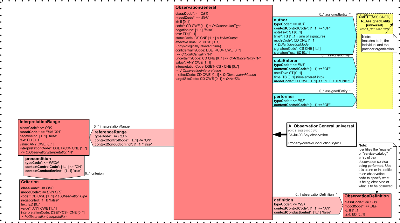
| Parent: | None |
Observation General CMET
A general observation represents the fact that the Lab Observation DMIM also serves to represent a wide variety of relatively unspecialized observations. All the participations general observation are addressed within the Laboratory Domain Message Information Model (DMIM) Act Relationships
There is a single act relationship that is not addressed within the Laboratory DMIM. Reference Range
An observation event is associated with zero to many observation event criteria. These are acts that contain additional information that provides context for the data passed in observation event value. Typical reference ranges indicate the normal high and low values of an observation for a particular population. The reader should note that the particular criteria for a specific reference range are captured as an associated observation.
| R_AssignedEntityUniversal | COCT_MT090000UV01 |
| A_ObservationGeneral universal | COCT_MT120500UV |
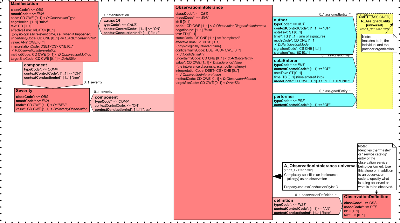
| Parent: | None |
Observation Intolerance CMET
An observation intolerance (AKA allergy) provides the attributes and associations needed for the specification of an intolerance or allergy. An allergy is a hypersensitive state acquired through exposure to a particular allergen. Those participations and act relationship that are valid for intolerances, and that are not addressed in the Laboratory Observation Domain Message Information Model are described below. Participations
There are no participations that are specific to an intolerance Act Relationships
The following associations have particular relevance for an intolerance. Adverse Reaction:
An intolerance can be associated with zero to many adverse reactions. For the most part, intolerances are discovered and confirmed through the observation of an adverse reaction. However, an intolerance may be reported without providing specific information on related adverse reactions. At the same time, an allergic person may experience many reactions as a result of multiple exposures. Severity:
It is relevant, though not mandatory or universal to record the severity of a person's adverse reaction. Each severity observation is related to a single adverse reaction. Note, however, that it is possible to record the severity of allergic reactions without specific documentation of the adverse reaction itself.
| R_AssignedEntityUniversal | COCT_MT090000UV01 |
| A_ObservationIntolerence universal | COCT_MT120300UV |

| Parent: | None |
Observation Supporting Information CMET
Observation supporting information provides the ability to include relevant supporting information for an observation. This CMET allows information related to a variety of act types to be associated with an observation. Currently, it is expected that supporting information will constitute one of the following: an instance of medication administration or the intent to administer medication, an observation intolerance or allergy, a procedure or the intent to perform a procedure, a diagnosis, or a general (generic) observation.
In the case of medications and procedures, it is assumed that now participation or additional act relationship information will be included. The reader should refer to the relevant CMET discussions for information on participations and act relationships for intolerances, diagnoses, and/or general observations.
| A_ObservationDxUniversal | COCT_MT120100UV |
| A_ObservationIntoleranceUniversal | COCT_MT120300UV |
| A_ObservationGeneralUniversal | COCT_MT120500UV |
| A_SupportingClinicalInfo universal | COCT_MT200000UV01 |
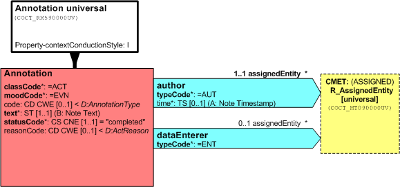
| Parent: | None |
Annotation CMET
Text-based comments made about a record, patient, or other object to which this CMET is attached. Provides for greater documentation and communication. All the participations for this CMET are addressed within the Observations Domain Message Information Model (DMIM) Walkthrough
| R_AssignedEntityUniversal | COCT_MT090000UV01 |
| A_annotation Universal | COCT_MT590000UV |
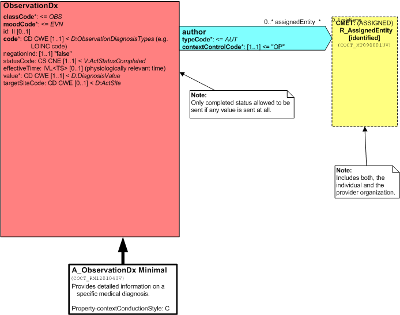
| Parent: | None |
This is the minimal variant of A_ObservationDx universal
Overview
A diagnosis is an observation that represents the determination of the nature of a case of disease. The diagnosis code is captured as the value of the observation, while act code indicates the type of diagnosis, e.g., admitting, billing. All the participations relevant to a diagnosis are addressed in the discussion of the Laboratory Domain Message Information Model. There are not specific act relationships.
| R_AssignedEntityIdentified | COCT_MT090001UV01 |
| A_ObservationDx minimal | COCT_MT120104UV |
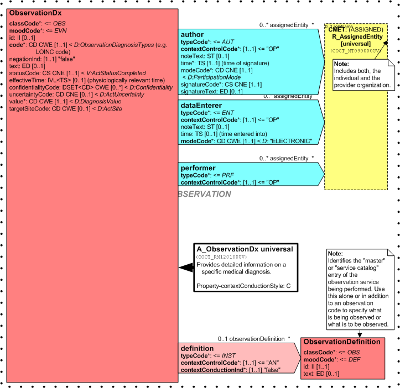
| Parent: | None |
This is the universal variant of the A_ObservationDx CMET.
Overview
A diagnosis is an observation that represents the determination of the nature of a case of disease. The diagnosis code is captured as the value of the observation, while act code indicates the type of diagnosis, e.g., admitting, billing. All the participations relevant to a diagnosis are addressed in the discussion of the Laboratory Domain Message Information Model. There are not specific act relationships.
| R_AssignedEntityUniversal | COCT_MT090000UV01 |
| A_ObservationDx universal | COCT_MT120100UV |

| Parent: | Patient Administration (PRPA_DM000000UV) |
This is the identified variant of A_Encounter universal. This CMET supports the use case of closely coupled systems where the receiver only needs the patient encounter's identifier.
Encounter -- An interaction between a patient and care provider(s) for the purpose of providing healthcare-related services. Healthcare services include health assessment.
- id - one or more unique identifiers for this encounter (mandatory)
- code - type of encounter (such as ambulatory, inpatient, emergency, home health)
- effectiveTime - the time interval starting with the administrative onset of the encounter (e.g. admission, registration, patient arrival) and ending with the patient's departure (e.g. discharge). For active encounters the end of the effectiveTime range is the anticipated end date-time.
| A_Encounter identified | COCT_MT010001UV01 |
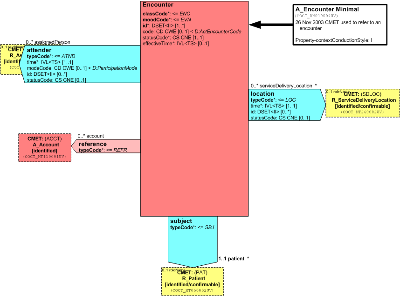
| Parent: | Patient Administration (PRPA_DM000000UV) |
This is the minimal variant of A_Encounter universal.
The encounter is described by type (e.g., ambulatory, inpatient), identifier(s), status, and effective time. The included participations are attending practitioner(s), assigned patient location(s), relevant account(s), and the patient. No act relationships are included.
| R_PatientIdentified/confirmable | COCT_MT050002UV07 |
| R_AssignedPersonIdentified/confirmable | COCT_MT090102UV02 |
| A_AccountIdentified | COCT_MT110001UV01 |
| R_ServiceDeliveryLocationIdentified/confirmable | COCT_MT240002UV02 |
| A_Encounter minimal | COCT_MT010004UV02 |
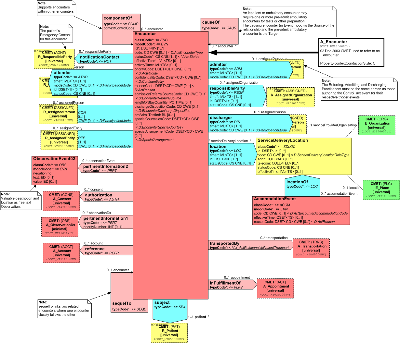
| Parent: | Patient Administration (PRPA_DM000000UV) |
This is the universal variant of A_Encounter . This CMET is used where the receiver is assumed to need all the data about a specific patient encounter in event mood.
Encounter -- An interaction between a patient and care provider(s) for the purpose of providing healthcare-related services. Healthcare services include health assessment.
- moodCode - A mandatory value specifying that this describes a patient encounter that actually happens (may be completed or ongoing).
- id - one or more unique identifiers for this encounter (mandatory)
- code - type of encounter (ambulatory, inpatient, emergency, home health, field or virtual; the last two types are not supported in this release of the standard)
- statusCode - distinguishes active from completed encounters
- effectiveTime - the time interval starting with the administrative onset of the encounter (e.g. admission, registration, patient arrival) and ending with the patient's departure (e.g. discharge). For active encounters the end of the effectiveTime range is the anticipated end date-time.
- activityTime - the total time interval for an encounter including preparation before the patient arrives and clean-up actions after the patient departs
- priorityCode - the encounter admission urgency
- confidentialityCode - a code that controls the disclosure of information about this patient encounter
- reasonCode - gives an explanation for the encounter, other than the medical reason for the encounter in the pertinentInformation2 (diagnoses) described below. Examples of values here are "Medical Necessity", "Patient's Request" and "Dependency".
- admissionReferralSource - a code used to categorize the type of place or organization responsible for the patient immediately prior to their admission; for example, in the United States, this is identified in UB-92 Form Locator 20, Source of Adm(ission). Detailed information about the admitted-from place or type of place is conveyed through the "arrival" transportedBy act relationship (see below).
- lengthOfStayQuantity - expresses the expected or actual quantity of time for the encounter. While the encounter is still "active" (the encounter doesn't have an end date yet) this field should be interpreted as the expected length. When the encounter is "completed" this field contains the actual length of stay. The actual days quantity cannot be simply calculated from the admission and discharge dates because of possible leaves of absence.
- dischargeDispositionCode - a code depicting the disposition of the patient at the time of discharge (e.g., discharged to home, expired, against medical advice, etc.). Detailed information about the discharged-to place or type of place is conveyed through the "departure" transportedBy act relationship (see below).
- acuityLevelCode - a code depicting the acuity (complexity of patient care, resource intensiveness of the patient care) of a patient's medical condition upon arrival
- preAdmitTestInd - indicates whether tests or other preparations were done in a preadmission encounter prior to this admission. The actual encounter for the pre-admit tests can be related to the encounter with the reason act relationship (see below).
- specialCourtesiesCode - a code identifying special courtesies extended to the patient (e.g., no courtesies, extended courtesies, professional courtesy, VIP courtesies)
- specialArrangementCode - a code indicating the type of special arrangements provided for a patient encounter (e.g., wheelchair, stretcher, interpreter, attendant, seeing eye dog). This is not related to the AccommodationEvent.
Links to Other Acts
- locationOf: the encounter can be linked to one or more AccommodationEvent acts associated with the patient's assigned location. A patient may request or need a specific accommodation such as ward, private or semi-private accommodations for (a part of) the encounter. The AccommodationEvent.ReasonCode tells if the accommodation is a medical necessity or the result of a patient request.
- transportedBy: the encounter can be linked to one or two TransportationProcess acts for patient arrival and departure. The transportation act can be reported as either events (actual) or appointments (planned). For admissions the structure can include mode of arrival as TransportationProcess.text and admitted-from location by specific place and/or type of place in a R_LocationLocatedEntity CMET. For discharges the structure can include mode of departure in TransportationProcess.text and discharged-to location by specific place and/or type of place in a R_LocationLocatedEntity CMET. Both the person who transported the patient and an escort can be sent in R_AssignedPerson CMET's. Context conduction ensures that the encounter and the transportation have the same subject (patient).
- reference: the encounter can link to one or more patient accounts. Each account identifier is sent in a separate A_Account CMET.
- pertinentInformation1: the encounter can be linked to one or more diagnoses. Each diagnosis is sent in a separate A_ObservationDx CMET. The type of diagnosis is determined by the Observation.code within the A_ObservationDx CMET; "ADMX" for an admission diagnosis, "INTDX" for an interim diagnosis, and "DISDX" for a discharge diagnosis. Multiple diagnoses of the same type can be rank ordered using the pertinentInformation1.priorityNumber.
- authorization: the encounter can be linked to one or more consents granted by the patient or patient's representative. Each consent is sent in a separate A_Consent CMET.
- pertinentInformation2: the encounter can be linked to one or more reports of patient valuables stored during the encounter. Each report is sent as a free text observation of the valuables and where they are stored during the encounter in the ObservationEvent. If no valuables were stored for the patient then an ObservationEvent can be sent with a negationInd of "true".
Direct Participations in the Encounter
- admitter: the healthcare practitioner that required/authorized the encounter, usually in case of an inpatient encounter.
- responsibleParty: a healthcare provider organization that holds responsibility for the patient during the encounter.
- discharger: the healthcare practitioner that required/authorized the ending of an encounter, usually in case of an inpatient encounter.
- location: the patient's assigned location during the encounter.
- subject: the patient who is the subject of the encounter.
- referrer: the healthcare practitioner who requested the encounter to take place.
- consultant: an advisor participating in the encounter by performing evaluations and making recommendations.
- attender: a healthcare practitioner who is primarily responsible for the patient during a period in time in the given encounter.
- notificationContact: the patient's designated Emergency Contact for this encounter.
| A_AppointmentUniversal | COCT_MT020000UV01 |
| R_ResponsiblePartyUniversal | COCT_MT040200UV09 |
| R_PatientUniversal | COCT_MT050000UV01 |
| A_TransportationUniversal | COCT_MT060000UV01 |
| R_AssignedEntityUniversal | COCT_MT090000UV01 |
| R_AssignedPersonUniversal | COCT_MT090100UV01 |
| R_AssignedPersonUniversal | COCT_MT090100UV01 |
| R_AssignedPersonUniversal | COCT_MT090100UV01 |
| R_AssignedPersonUniversal | COCT_MT090100UV01 |
| R_AssignedOrganizationUniversal | COCT_MT090200UV01 |
| A_AccountUniversal | COCT_MT110000UV04 |
| A_ObservationDxMinimal | COCT_MT120104UV |
| E_OrganizationUniversal | COCT_MT150000UV02 |
| A_ConsentUniversal | COCT_MT470000UV |
| E_PlaceUniversal | COCT_MT710000UV07 |
| A_Encounter universal | COCT_MT010000UV01 |
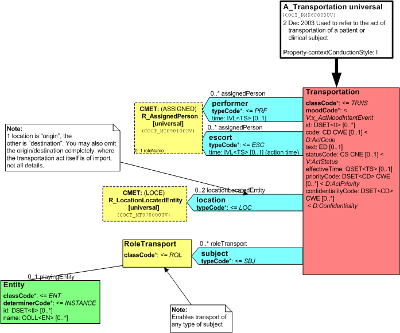
| Parent: | Patient Administration (PRPA_DM000000UV) |
This is the universal variant of A_Transportation. This CMET is used where the receiver is assumed to need all data about the planned or actual transportation of an entity (person or object) from one location to another.
Transportation - Transportation of a payload (people or material) from a location of origin to a destination location. This can be a transportation request, appointment or event.
- id - Identifier(s) for this transportation act (optional)
- code - A value specifying the mode of transportation. Examples include ambulance, private transport, public transport, on foot.
- text - A textual description of this transportation act
- statusCode - A value specifying the state of this transportation act (based on the RIM act class state-machine). Examples include pending, active, aborted, completed.
- effectiveTime - The time the transported payload is en route
- priorityCode - A code or set of codes (e.g., for routine, emergency), specifying the urgency under which the transportation act happened, can happen, is happening, or is intended to happen
- confidentialityCode - Value(s) that control the disclosure of information about this transportation act
Direct Participations
- performer - Optional association to the person(s) who transported or will transport a payload (people or material) from a location of origin to a destination location. The optional time attribute can convey the period this person transported the payload if the participation period was not for the full duration of the transport.
- escort - Optional association to the person(s) who escorted or will escort the payload during a transportation act. The optional time attribute can convey the period this person escorted the payload if the participation period was not for the full duration of the transport.
- location - Optional association to the starting and ending locations of this transportation act. A location can be specialized as origin or destination location.
- subject - Association to the entity being transported (person or material) by the transportation act
| R_LocationLocatedEntityUniversal | COCT_MT070000UV01 |
| R_AssignedPersonUniversal | COCT_MT090100UV01 |
| A_Transportation universal | COCT_MT060000UV01 |
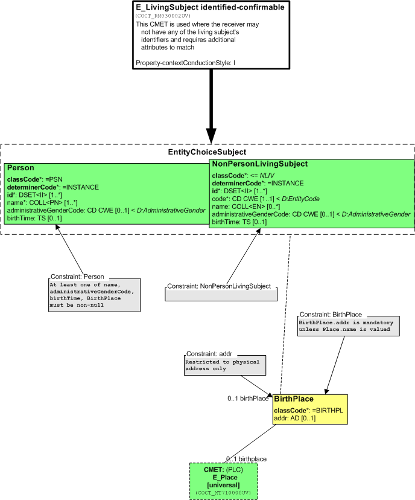
| Parent: | Patient Administration (PRPA_DM000000UV) |
This is the identified-confirmable variant of E_LivingSubject universal. This CMET supports the case where the receiver may not have any of the living subject's identifiers and requires additional attributes to match.
Changes from Previous Version (COCT_MT030002UV01)
- Person changes conformance of name attribute from Optional [0..*] to Required [1..*]
- Person changes datatype of name attribute from BAG<EN> to BAG<PN>
- Person changes classCode attribute domain specification from <= PSN to = PSN
- Person changes determinerCode attribute domain specification from <= INSTANCE to = INSTANCE
- NonPersonLivingSubject removes quantity and strainText attributes
- NonPersonLivingSubject adds Required code attribute
- NonPersonLivingSubject changes determinerCode attribute domain specification from <= INSTANCE+KIND to = INSTANCE
- BirthPlace adds addr attribute and changes association to E_Place [universal] from Optional 1..1 to Optional 0..1.
EntityChoiceSubject - A Living Subject can be either a person or a non-person living subject.
Person - A specific human being who is or was alive.
- id - one or more identifiers for this person (mandatory)
- name - one or more names for this person (required)
- administrativeGenderCode - value representing the gender (sex) of this person. Note: this attribute does not include terms related to clinical gender which is a complex physiological, genetic and sociological concept that requires multiple observations in order to be comprehensively described.
- birthTime - The date and time this person was born. This could be an exact moment such as January 1, 1960 @ 03:00:00 EST or an approximate date such as January 1960.
NonPersonLivingSubject -A specific non-person living subject (e.g., animal, microorganism, plant) that is or was alive.
- id - one or more identifiers for this non-person living subject (mandatory)
- code - value representing the specific kind of non-person living subject the instance represents, for example animal or plant taxonomy (required)
- name - names of this non-person living subject
- administrativeGenderCode - value representing the gender (sex) of this non-person living subject. This attribute does not include terms related to clinical gender which is a complex physiological, genetic and sociological concept that requires multiple observations in order to be comprehensively described.
- birthTime - date and time this non-person living subject was born or hatched. This could be an exact moment such as January 1, 1960 @ 03:00:00 EST or an approximate date such as January 1960.
Associations
- Birth Place is the location where the focal living subject was born or hatched
Constraints
- For a Person, at least one of name, administrativeGenderCode, birthTime, or BirthPlace must be non-null
- For a NonPersonLivingSubject, at least one of name, code, administrativeGenderCode, birthTime or BirthPlace must be non-null
- For a BirthPlace, either BirthPlace.addr (physical address type) or Place.name must be non-null
| E_PlaceUniversal | COCT_MT710000UV07 |
| E_LivingSubject identified-confirmable | COCT_MT030002UV07 |
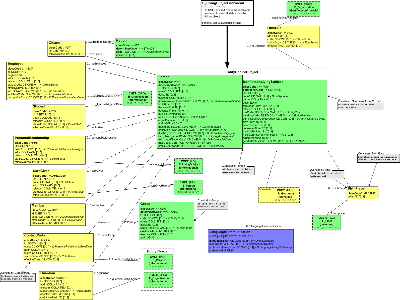
| Parent: | Patient Administration (PRPA_DM000000UV) |
This is the universal variant of E_LivingSubject . This CMET is used where the receiver is assumed to need all data about a specific living subject.
Changes from Previous Version (COCT_MT030000UV04)
This CMET was updated to be consistent with the Patient Administration Registries DMIM. Specific changes are:
- Person changes conformance of name attribute from Optional [0..*] to Required [1..*]
- Person changes datatype of name attribute from BAG<EN> to BAG<PN>
- Person removes statusCode attribute
- Person adds telecom and addr attributes
- Person changes classCode attribute domain specification from <= PSN to = PSN
- Person changes determinerCode attribute domain specification from <= INSTANCE to = INSTANCE
- Person adds a constraint requiring that either id or name must be valued
- NonPersonLivingSubject changes determinerCode attribute domain specification from <= INSTANCE+KIND to = INSTANCE
- NonPersonLivingSubject removes quantity, statusCode and strainText attributes
- NonPersonLivingSubject changes datatype of name attribute from <SET>EN to <BAG>EN
- NonPersonLivingSubject adds code, telecom and deceasedTime attributes
- NonPersonLivingSubject adds a constraint requiring that either id or name must be valued
- EntityChoiceSubject adds new association to PersonalRelationship
- EntityChoiceSubject adds new association to CareGiver
- EntityChoiceSubject removes association to R_CoveredParty [universal]
- Citizen changes association to scoping entity from Optional 1..1 association to E_Organization to Mandatory 1..1 association to Nation
- Citizen changes classCode attribute domain specification from <= CIT to = CIT
- Student corrects datatype of statusCode attribute from SET<CS> to CS
- Student changes classCode attribute domain specification from <= STD to = STD
- Student changes association to scoping organization from E_Organization [universal] to E_Organization [informational]
- Employment renamed Employee
- Employee adds occupationCode attribute
- Employee removes jobCode attribute
- Employee changes association to scoping organization from Optional 0..1 association to E_Organization [universal] to Required 1..1 association to E_Organization [informational]
- Member changes scoping entity from an Optional 1..1 association to Entity to a Required 1..1 association to Group
- Group adds code, telecom and addr attributes
- Group removes quantity attribute
- Group adds a constraint requiring that either id or name must be valued
- Guarantor class replaced with R_Guarantor CMET
- BirthPlace adds addr attribute and changes association to E_Place [universal] from Optional 1..1 to Optional 0..1
- BirthPlace changes classCode attribute domain specification from <= BIRTHPL to = BIRTHPL
- OtherIDs adds code, statusCode and effectiveTime attributes
- OtherIDs changes id attribute from Optional [1..*] to Mandatory [1..*]
- OtherIDs changes scoping organization from Optional 0..1 association to E_Organization [universal] to Required 1..1 association E_Organization[identified/confirmable]
- ContactParty changes playing entity from an Optional 1..1 association to a choice of E_Person [identified/confirmable] or E_Organization [identified/confirmable] to a Required 1..1 association to a choice of E_Person [informational] or E_Organization [informational]
- ContactParty changes code attribute from the AdministrativeContactRoleType domain to the PersonalRelationshipRoleType domain
- ContactParty changes telecom attribute from Mandatory 1..* to Required 0..*
- ContactParty adds constraint requiring that either addr or telecom must be valued
- Guardian changes playing entity from an Optional 1..1 association to a choice of E_Person [identified/confirmable] or E_Organization [identified/confirmable] to a Required 1..1 association to a choice of E_Person [informational] or E_Organization [informational]
EntityChoiceSubject - A Living Subject can be either a person or a non-person living subject.
Person - A specific human being who is or was alive.
- id - identifiers for this person (optional)
- name - one or more names for this person (required)
- desc - textual or multimedia depiction of this person. Descriptions are meant to be shown to interested human individuals.
- telecom - telecommunication addresses for communicating with this person
- administrativeGenderCode - value representing the gender (sex) of this person. Note: this attribute does not include terms related to clinical gender which is a complex physiological, genetic and sociological concept that requires multiple observations in order to be comprehensively described.
- birthTime - date and time this person was born. This could be an exact moment such as January 1, 1960 @ 03:00:00 EST or an approximate date such as January 1960.
- deceasedInd - an indication that this person is dead
- deceasedTime - date and time this person died. This could be an exact moment such as January 1, 1960 @ 03:00:00 EST or an approximate date such as January 1960.
- multipleBirthInd - an indication that this person was part of a multiple birth
- multipleBirthOrderNumber - the order in which this person was born if part of a multiple birth
- organDonorInd - an indication that this person is a candidate to serve as an organ donor. Note: specifics of an organ donor agreement would be conveyed in a medico-legal document.
- addr - address(es) for corresponding with this person
- maritalStatusCode - value representing the domestic partnership status of this person
- educationLevelCode - value representing the highest level of education this person achieved
- disabilityCode - set of values identifying this person's disabilities
- livingArrangementCode - value specifying the housing situation of this person
- religiousAffiliationCode - value representing the primary religious preference of this person
- raceCode - set of values representing the races of this person
- ethnicGroupCode - set of values representing the ethnic groups of this person
NonPersonLivingSubject -A specific non-person living subject (e.g., animal, microorganism, plant) that is or was alive.
- id - identifiers for this non-person living subject (optional)
- code - value representing the specific kind of non-person living subject the instance represents, for example animal or plant taxonomy (required)
- name - name(s) of this non-person living subject
- desc - textual or multimedia depiction of this non-person living subject. Descriptions are meant to be shown to interested human individuals.
- existenceTime - interval of time specifying the period in which this non-person living subject physically existed
- telecom - telecommunication addresses for communicating with the focal non-person living subject
- riskCode - value representing the type of hazard or threat associated with this non-person living subject. Animals of irascible temperament may prove to be a risk to healthcare personnel.
- handlingCode - value representing special handling requirements for this non-person living subject to avoid damage to it or other entities
- administrativeGenderCode - value representing the gender (sex) of this non-person living subject. This attribute does not include terms related to clinical gender which is a complex physiological, genetic and sociological concept that requires multiple observations in order to be comprehensively described.
- birthTime - date and time this non-person living subject was born or hatched. This could be an exact moment such as January 1, 1960 @ 03:00:00 EST or an approximate date such as January 1960.
- deceasedInd - an indication that this non-person living subject is dead.
- deceasedTime - date and time this non-person living subject died. This could be an exact moment such as January 1, 1960 @ 03:00:00 EST or an approximate date such as January 1960.
- multipleBirthInd - an indication that this non-person living subject was part of a multiple birth
- multipleBirthOrderNumber - the order in which this non-person living subject was born if part of a multiple birth
- organDonorInd - an indication that this non-person living subject is a candidate to serve as an organ donor
- genderStatusCode - value representing whether the primary reproductive organs of this non-person living subject are present
Associations
- Personal Relationship is another living subject related to the focal living subject such as parent, sibling, spouse, neighbor
- Care Giver is a person who provides primary care for the focal living subject at home
- Member is the membership of the focal living subject in a Group such as a family, tribe or religious organization
- Contact Party is a person or organization that is authorized to provide or receive information about the focal living subject
- Guardian is a person or an organization that is legally responsible for the care and management of the focal living subject.
- Guarantor is a person or organization that takes financial responsibility for the health care of the focal living subject
- Birth Place is the location where the focal living subject was born or hatched
- Other IDs conveys identifiers assigned to the focal living subject in other systems
- The Person specialization of Living Subject also includes additional associations:
- Citizen - a relationship between the focal person who owes loyalty to and is entitled by birth or naturalization to the protection of a Nation
- Employee - a relationship of the focal person with an organization to receive wages or salary. The purpose of this class is to identify the type of relationship the employee has to the employer rather than the nature of the work actually performed
- Student - a relationship of the focal person to a school in which they are enrolled
- Language Communication - the language communication capability of the focal person
Constraints
- For a Person, at least one of name, administrativeGenderCode, birthTime, or BirthPlace must be non-null
- For a NonPersonLivingSubject, at least one of name, code, administrativeGenderCode, birthTime or BirthPlace must be non-null
- For a BirthPlace, either BirthPlace.addr (physical address type) or Place.name must be non-null
- For ContactParty, either addr or telecom must be non-null
- For Group, either id or name must be non-null
| E_LivingSubjectInformational | COCT_MT030007UV |
| E_PersonInformational | COCT_MT030207UV07 |
| E_PersonInformational | COCT_MT030207UV07 |
| E_OrganizationIdentified/confirmable | COCT_MT150002UV01 |
| E_OrganizationInformational | COCT_MT150007UV |
| E_OrganizationInformational | COCT_MT150007UV |
| R_GuarantorUniversal | COCT_MT670000UV04 |
| E_PlaceUniversal | COCT_MT710000UV07 |
| E_LivingSubject universal | COCT_MT030000UV09 |
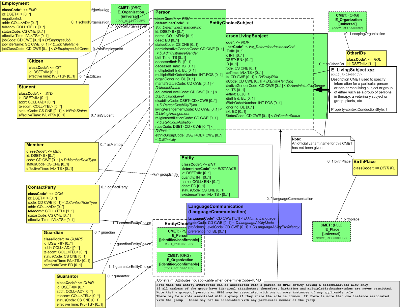
| Parent: | Patient Administration (PRPA_DM000000UV) |
E_LivingSubject xyz
This is the [xyz???] variant of the E_LivingSubject universal CMET. This CMET defines content used to completely identify a particular person or non-person living subject (NPLS) or a group of either, such as an undifferentiated group of persons receiving clinical interventions, therapy or education, e.g., a herd of cattle receiving immunizations; 7th grade girls in a tribal school receiving HIV/AIDs education; or couples with multiple marital status in birthing classes. This variant supplies much supplementary information of use in so called "loosely-coupled" systems, where the particular person or NPLS or group of either is not necessarily known to the receiving system.
This variant differs from the universal in two ways: (1) it does not include an association to the R_CoveredParty CMET because it is included in the release 2 version of the R_CoveredParty CMET, which would result in self-reference; and (2) the determinerCode for both the Person entity and the NPLS entity allows both INSTANCE and KIND. The universal variant supports INSTANCE and KIND on the NPLS, not the Person entity. The PRPA DM000000 does not support KIND on either entity.
| E_PersonIdentified/confirmable | COCT_MT030202UV07 |
| E_OrganizationUniversal | COCT_MT150000UV02 |
| E_OrganizationUniversal | COCT_MT150000UV02 |
| E_OrganizationIdentified/confirmable | COCT_MT150002UV01 |
| E_PlaceUniversal | COCT_MT710000UV07 |
| E_LivingSubject xyz | COCT_MT030007UV |
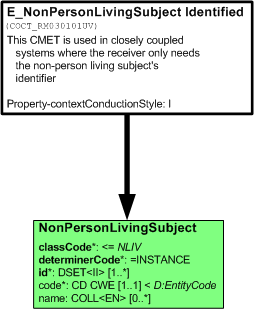
| Parent: | Patient Administration (PRPA_DM000000UV) |
This is the identified variant of E_NonPersonLivingSubject universal. This CMET supports the case of closely coupled systems where the receiver only needs the non-person living subject's identifier.
Changes from Previous Version (COCT_RM030101UV01)
- NonPersonLivingSubject changes determinerCode attribute domain specification from <= INSTANCE to = INSTANCE
- NonPersonLivingSubject adds Requred 1..1 code attribute
- NonPersonLivingSubject changes name attribute datatype from SET<EN> to BAG<EN>
- NonPersonLivingSubject removes quantity attribute
NonPersonLivingSubject -A specific non-person living subject (e.g., animal, microorganism, plant).
- id - one or more identifiers for this non-person living subject (mandatory)
- code - value representing the specific kind of non-person living subject the instance represents, for example animal or plant taxonomy (required)
- name - names of this non-person living subject
| E_NonPersonLivingSubject identified | COCT_MT030101UV07 |
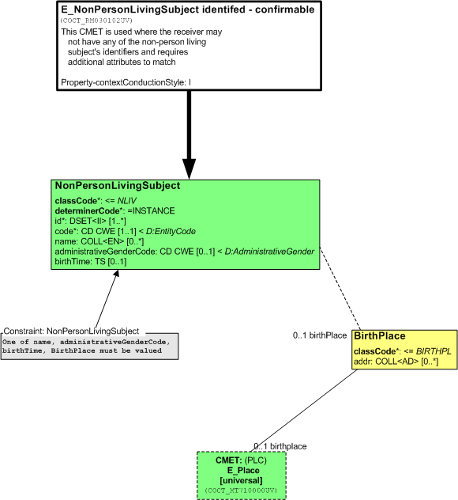
| Parent: | Patient Administration (PRPA_DM000000UV) |
This is the identified-confirmable variant of E_NonPersonLivingSubject universal. This CMET supports the case where the receiver may not have any of the person's identifiers and requires additional attributes to match.
Changes from Previous Version (COCT_RM030102UV01)
- NonPersonLivingSubject changes determinerCode attribute domain specification from <= INSTANCE+KIND to = INSTANCE
- NonPersonLivingSubject adds Required 1..1 code attribute
- NonPersonLivingSubject removes quantity and strainText attributes
- NonPersonLivingSubject changes datatype of name attribute from <SET>EN to <BAG>EN
- BirthPlace adds addr attribute and changes association to E_Place [universal] from Optional 1..1 to Optional 0..1
NonPersonLivingSubject -A specific non-person living subject (e.g., animal, microorganism, plant).
- id - one or more identifiers for this non-person living subject (required)
- code - value representing the specific kind of non-person living subject the instance represents, for example animal or plant taxonomy (required)
- name - names of this non-person living subject
- administrativeGenderCode - value representing the gender (sex) of this non-person living subject. This attribute does not include terms related to clinical gender which is a complex physiological, genetic and sociological concept that requires multiple observations in order to be comprehensively described.
- birthTime - date and time this non-person living subject was born or hatched. This could be an exact moment such as January 1, 1960 @ 03:00:00 EST or an approximate date such as January 1960.
- Birth Place - location where the focal non-person living subject was born or hatched
Constraints
- A name, administrativeGenderCode, birthtime or BirthPlace must be non-null
| E_PlaceUniversal | COCT_MT710000UV07 |
| E_NonPersonLivingSubject identified-confirmable | COCT_MT030102UV07 |
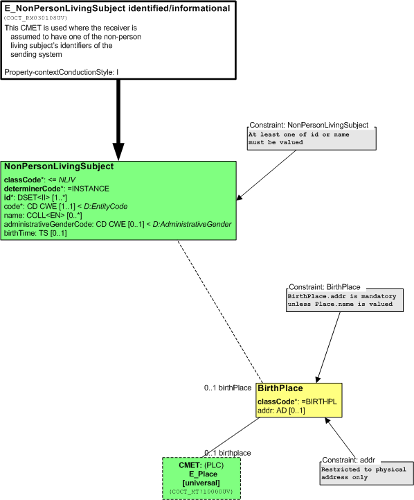
| Parent: | Patient Administration (PRPA_DM000000UV) |
This is the identified/informational variant of E_NonPersonLivingSubject universal. This CMET supports the case where the receiver is assumed to have one of the non-person living subject's identifiers of the sending system.
NonPersonLivingSubject -A specific non-person living subject (e.g., animal, microorganism, plant).
- id - one or more identifiers for this non-person living subject (mandatory)
- code - value representing the specific kind of non-person living subject the instance represents, for example animal or plant taxonomy (required)
- name - names of this non-person living subject
- administrativeGenderCode - value representing the gender (sex) of this non-person living subject. This attribute does not include terms related to clinical gender which is a complex physiological, genetic and sociological concept that requires multiple observations in order to be comprehensively described.
- birthTime - date and time this non-person living subject was born or hatched. This could be an exact moment such as January 1, 1960 @ 03:00:00 EST or an approximate date such as January 1960.
- Birth Place - location where the focal non-person living subject was born or hatched
Constraints
- Either an id or a name must be valued in the NonPersonLivingSubject
- In a BirthPlace is sent then either the Place.name or BirthPlace.addr (must be a physical address) must be valued
| E_PlaceUniversal | COCT_MT710000UV07 |
| E_NonPersonLivingSubject identified-informational | COCT_MT030108UV07 |
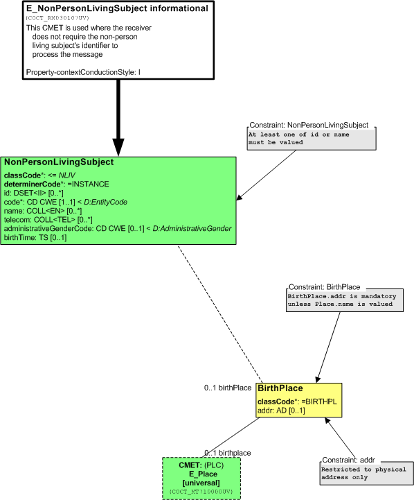
| Parent: | Patient Administration (PRPA_DM000000UV) |
This is the informational variant of E_NonPersonLivingSubject universal. This CMET is used where the receiver is assumed not to need the living subject's identifier to process the message.
NonPersonLivingSubject -A specific non-person living subject (e.g., animal, microorganism, plant).
- id - identifiers for this non-person living subject (optional)
- code - value representing the specific kind of non-person living subject the instance represents, for example animal or plant taxonomy (required)
- name - names of this non-person living subject
- telecom - telecommunication addresses for communicating with this non-person living subject
- administrativeGenderCode - value representing the gender (sex) of this non-person living subject. This attribute does not include terms related to clinical gender which is a complex physiological, genetic and sociological concept that requires multiple observations in order to be comprehensively described.
- birthTime - date and time this non-person living subject was born or hatched. This could be an exact moment such as January 1, 1960 @ 03:00:00 EST or an approximate date such as January 1960.
- Birth Place - location where the focal non-person living subject was born or hatched
Constraints
- Either an id or a name must be valued in the NonPersonLivingSubject
- In a BirthPlace is sent then either the Place.name or BirthPlace.addr (must be a physical address) must be valued
| E_PlaceUniversal | COCT_MT710000UV07 |
| E_NonPersonLivingSubject informational | COCT_MT030107UV07 |
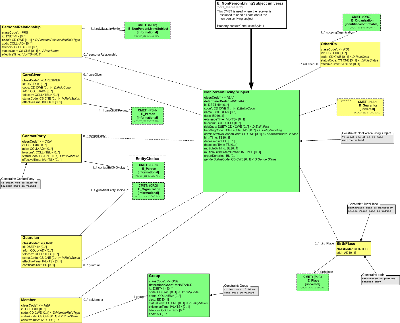
| Parent: | Patient Administration (PRPA_DM000000UV) |
The universal variant of E_NonPersonLivingSubject. This CMET is used where the receiver is assumed to need all data about a particular non-person living subject such as veterinary subject, plant, etc.
Changes from Previous Version (COCT_RM030100UV01)
This CMET was updated to be consistent with the Patient Administration Registries DMIM. Specific changes are:
- NonPersonLivingSubject changes determinerCode attribute domain specification from <= INSTANCE+KIND to = INSTANCE
- NonPersonLivingSubject removes quantity, statusCode and strainText attributes
- NonPersonLivingSubject changes datatype of name attribute from <SET>EN to <BAG>EN
- NonPersonLivingSubject adds code, telecom and deceasedTime attributes
- NonPersonLivingSubject adds association to PersonalRelationship
- NonPersonLivingSubject adds association to CareGiver
- NonPersonLivingSubject adds a constraint requiring that id or name must be valued
- NonPersonLivingSubject removes association to R_CoveredParty [universal]
- Member changes scoping entity from an Optional 1..1 association to Entity to a Required 1..1 association to Group
- Group adds code, telecom and addr attributes
- Group removes quantity attribute
- Group adds a constraint requiring that id or name must be valued
- Guarantor class replaced with R_Guarantor CMET
- BirthPlace adds addr attribute and changes association to E_Place [universal] from Optional 1..1 to Optional 0..1
- OtherIDs adds code, statusCode and effectiveTime attributes
- OtherIDs changes id attribute from Optional [1..*] to Mandatory [1..*]
- OtherIDs changes scoping organization from an Optional 0..1 association to E_Organization [universal] to a Required 1..1 association to E_Organization[identified/confirmable]
- ContactParty changes playing entity from an Optional 1..1 association to a choice between E_Person [identified/confirmable] or E_Organization [identified/confirmable] to a Required 1..1 association to a choice between E_Person [informational] or E_Organization [informational]
- ContactParty removes code attribute
- ContactParty changes telecom attribute from Mandatory 1..* to Required 0..*
- ContactParty adds constraint requiring that either addr or telecom must be valued
- Guardian changes playing entity from an Optional 1..1 association to a choice of E_Person [identified/confirmable] or E_Organization [identified/confirmable] to a Required 1..1 association to a choice of E_Person [informational] or E_Organization [informational]
- Guardian changes classCode attribute domain specification from <= GUAR to = GUAR
NonPersonLivingSubject -A specific non-person living subject (e.g., animal, microorganism, plant) that is or was alive.
- id - identifiers for this non-person living subject (optional)
- code - value representing the specific kind of non-person living subject the instance represents, for example animal or plant taxonomy (required)
- name - names of this non-person living subject
- desc - textual or multimedia depiction of this non-person living subject. Descriptions are meant to be shown to interested human individuals.
- existenceTime - interval of time specifying the period in which this non-person living subject physically existed
- telecom - telecommunication addresses for communicating with this non-person living subject
- riskCode - value representing the type of hazard or threat associated with this non-person living subject. Animals of irascible temperament may prove to be a risk to healthcare personnel.
- handlingCode - value representing special handling requirements for this non-person living subject to avoid damage to it or other entities
- administrativeGenderCode - value representing the gender (sex) of this non-person living subject. This attribute does not include terms related to clinical gender which is a complex physiological, genetic and sociological concept that requires multiple observations in order to be comprehensively described.
- birthTime - date and time this non-person living subject was born or hatched. This could be an exact moment such as January 1, 1960 @ 03:00:00 EST or an approximate date such as January 1960.
- deceasedInd - an indication that this non-person living subject is dead.
- deceasedTime - date and time this non-person living subject died. This could be an exact moment such as January 1, 1960 @ 03:00:00 EST or an approximate date such as January 1960.
- multipleBirthInd - an indication that this non-person living subject was part of a multiple birth
- multipleBirthOrderNumber - The order in which this non-person living subject was born if part of a multiple birth
- organDonorInd - an indication that this non-person living subject is a candidate to serve as an organ donor
- genderStatusCode - value representing whether the primary reproductive organs of this non-person living subject are present
Associations
- Personal Relationship is another non-person living subject related to the focal living subject such as parent, sibling, neighbor
- Care Giver is a person who provides primary care for the focal non-person living subject at home
- Contact Party is a person or organization that is authorized to provide or receive information about the focal non-person living subject
- Guardian is a person or an organization that is legally responsible for the care and management of the focal non-person living subject.
- Member is the membership of the focal non-person living subject in a Group
- Other IDs conveys identifiers assigned to the focal non-person living subject in other systems
- Guarantor is a person or organization that takes financial responsibility for the health care of the focal non-person living subject
- Birth Place is the location where the focal non-person living subject was born or hatched
Constraints
- For NonPersonLivingSubject, either id or name must be non-null
- For BirthPlace, either BirthPlace.addr (physical address type) or Place.name must be non-null
- For Contact Party, either addr or telecom must be non-null
- For Group, either id or name must be non-null
| E_NonPersonLivingSubjectInformational | COCT_MT030107UV07 |
| E_PersonInformational | COCT_MT030207UV07 |
| E_PersonInformational | COCT_MT030207UV07 |
| E_OrganizationIdentified/confirmable | COCT_MT150002UV01 |
| E_OrganizationInformational | COCT_MT150007UV |
| R_GuarantorUniversal | COCT_MT670000UV04 |
| E_PlaceUniversal | COCT_MT710000UV07 |
| E_NonPersonLivingSubject universal | COCT_MT030100UV09 |
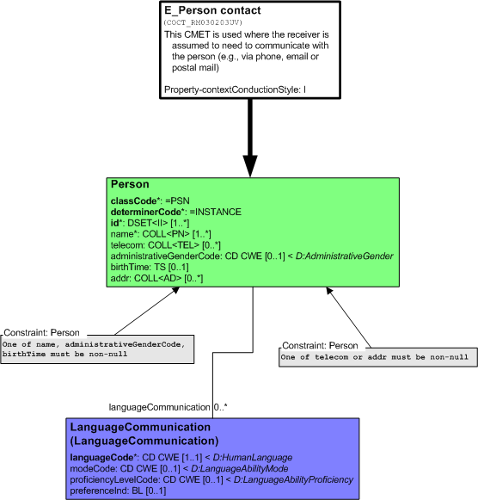
| Parent: | Patient Administration (PRPA_DM000000UV) |
This is the contact variant of E_Person universal. This CMET supports the case where the receiver is assumed to need to communicate with the person (e.g., via phone, email or postal mail).
Person - A specific human being
- id - one or more identifiers for this person (mandatory)
- name - one or more names for this person (required)
- telecom - telecommunication addresses for communicating with this person
- administrativeGenderCode - value representing the gender (sex) of this person. Note: this attribute does not include terms related to clinical gender which is a complex physiological, genetic and sociological concept that requires multiple observations in order to be comprehensively described.
- birthTime - date and time this person was born. This could be an exact moment such as January 1, 1960 @ 03:00:00 EST or an approximate date such as January 1960.
- addr - address(es) for corresponding with this person
- Language Communication - language communication capability of the person
Constraints
- The Person name, administrativeGenderCode or birthTime must be non-null.
- Either telecom or addr must be non-null
| E_Person contact | COCT_MT030203UV07 |
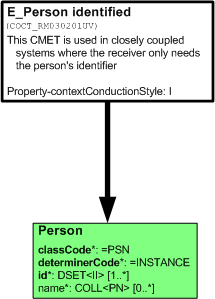
| Parent: | Patient Administration (PRPA_DM000000UV) |
This is the identified variant of E_Person universal. This CMET supports the case of closely coupled systems where the receiver only needs the person's identifier
Person - A specific human being
- id - one or more identifiers for this person (mandatory)
- name - names of this person (required)
| E_Person identified | COCT_MT030201UV07 |
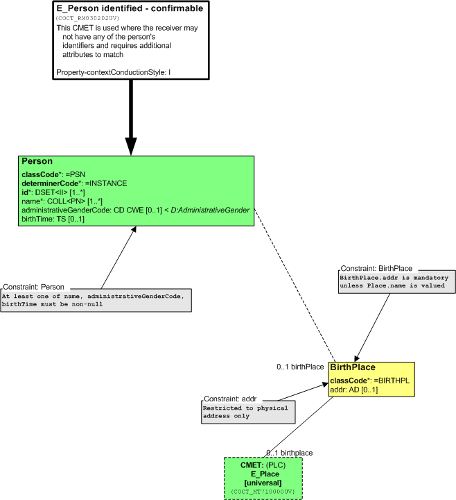
| Parent: | Patient Administration (PRPA_DM000000UV) |
This is the identified-confirmable variant of E_Person universal. This CMET supports the case where the receiver may not have any of the person's identifiers and requires additional attributes to match
Changes from Previous Version (COCT_RM030202UV01)
- Person changes classCode attribute domain specification from <= PSN to = PSN
- Person changes determinerCode attribute domain specification from <= INSTANCE to = INSTANCE
- Person changes name attribute conformance from optional [0..*] to required [1..*]
- Person changes name attribute datatype from BAG<EN> to BAG<PN>
- BirthPlace adds addr attribute and changes association to playing entity from an Optional 1..1 association to Place to an Optional 0..1 association to E_Place [universal]
Person - A specific human being
- id - one or more identifiers for this person (mandatory)
- name - one or more names for this person (required)
- administrativeGenderCode - value representing the gender (sex) of this person. Note: this attribute does not include terms related to clinical gender which is a complex physiological, genetic and sociological concept that requires multiple observations in order to be comprehensively described.
- birthTime - date and time this person was born. This could be an exact moment such as January 1, 1960 @ 03:00:00 EST or an approximate date such as January 1960.
- Birth Place is the location where the focal person was born
Constraints
- The Person name, administrativeGenderCode or birthTime must be non-null
- For BirthPlace, either BirthPlace.addr (physical address) or Place.name must be non-null
| E_PlaceUniversal | COCT_MT710000UV07 |
| E_Person identified-confirmable | COCT_MT030202UV07 |
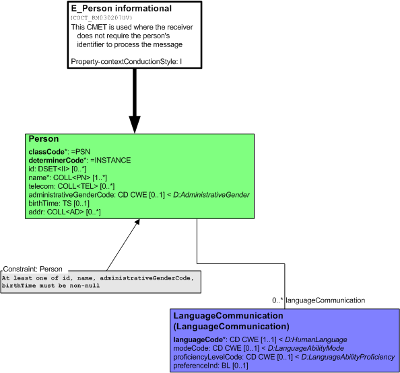
| Parent: | Patient Administration (PRPA_DM000000UV) |
This is the informational variant of E_Person universal. This CMET is used where the receiver is assumed not to need the person's identifier to process the message.
Person - A specific human being
- id - identifiers for this person (optional)
- name - one or more names for this person (required)
- telecom - telecommunication addresses for communicating with this person
- administrativeGenderCode - value representing the gender (sex) of this person. Note: this attribute does not include terms related to clinical gender which is a complex physiological, genetic and sociological concept that requires multiple observations in order to be comprehensively described.
- birthTime - date and time this person was born. This could be an exact moment such as January 1, 1960 @ 03:00:00 EST or an approximate date such as January 1960.
- addr - addresses for corresponding with this person
- Language Communication - language communication capability of the person
Constraints
- The Person id, name, administrativeGenderCode or birthTime must be non-null
| E_Person informational | COCT_MT030207UV07 |
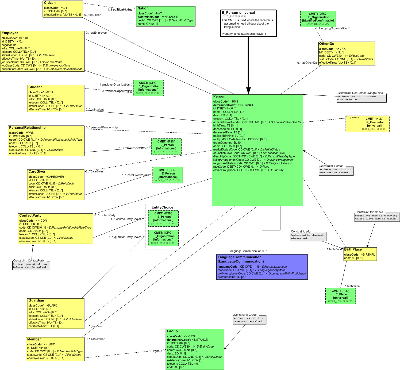
| Parent: | Patient Administration (PRPA_DM000000UV) |
This is the universal variant of E_Person. This CMET supports the case where the receiver is assumed to need all data about a person.
Changes from Previous Version (COCT_RM030200UV01)
This CMET was updated to be consistent with the Patient Administration Registries DMIM. Specific changes are:
- Person changes classCode attribute domain specification from <= PSN to = PSN
- Person changes determinerCode attribute domain specification from <= INSTANCE to = INSTANCE
- Person changes conformance of name attribute from Optional [0..*] to Required [1..*]
- Person changes datatype of name attribute from BAG<EN> to BAG<PN>
- Person removes statusCode attribute
- Person adds telecom and addr attributes
- Person adds association to PersonalRelationship
- Person adds association to CareGiver
- Person removes association to R_CoveredParty [universal]
- Citizen changes classCode attribute domain specification from <= CIT to = CIT
- Citizen changes association to scoping entity from Optional 1..1 association to E_Organization [universal] to Mandatory 1..1 association to Nation
- Student changes classCode attribute domain specification from <= STD to = STD
- Student changes association to scoping organization from E_Organization [universal] to E_Organization [informational]
- Employment renamed Employee
- Employee adds occupationCode attribute
- Employee removes jobCode attribute
- Employee changes association to scoping organization from Optional 0..1 association to E_Organization [universal] to Required 1..1 association to E_Organization [informational]
- Member changes scoping entity from an Optional 1..1 association to Entity to a Required 1..1 association to Group
- Group adds code, telecom and addr attributes
- Group removes quantity attribute
- Guarantor class replaced with R_Guarantor CMET
- BirthPlace adds addr attribute and changes association to E_Place [universal] from Optional 1..1 to Optional 0..1
- OtherIDs adds code, statusCode and effectiveTime attributes
- OtherIDs changes id attribute from Optional [1..*] to Mandatory [1..*]
- OtherIDs changes scoping organization from E_Organization [universal] to E_Organization[identified/confirmable]
- ContactParty changes playing entity from an Optional 1..1 association to a choice between E_Person [identified/confirmable] or E_Organization [identified/confirmable] to a Required 1..1 association to a choice between E_Person [informational] or E_Organization [informational]
- ContactParty changes code attribute from the AdministrativeContactRoleType domain to the PersonalRelationshipRoleType domain
- ContactParty changes telecom attribute from Mandatory 1..* to Required 0..*
- ContactParty adds constraint requiring that either addr or telecom must be valued
- Guardian changes classCode attribute domain specification from <= GUAR to = GUAR
- Guardian changes playing entity from an Optional 1..1 association to a choice of E_Person [identified/confirmable] or E_Organization [identified/confirmable] to a Required 1..1 association to a choice of E_Person [informational] or E_Organization [informational]
Person - A specific human being who is or was alive.
- id - identifiers for this person (optional)
- name - one or more names for this person (required)
- desc - textual or multimedia depiction of this person. Descriptions are meant to be shown to interested human individuals.
- telecom - telecommunication addresses for communicating with this person
- administrativeGenderCode - value representing the gender (sex) of this person. Note: this attribute does not include terms related to clinical gender which is a complex physiological, genetic and sociological concept that requires multiple observations in order to be comprehensively described.
- birthTime - date and time this person was born. This could be an exact moment such as January 1, 1960 @ 03:00:00 EST or an approximate date such as January 1960.
- deceasedInd - an indication that this person is dead
- deceasedTime - date and time this person died. This could be an exact moment such as January 1, 1960 @ 03:00:00 EST or an approximate date such as January 1960.
- multipleBirthInd - an indication that this person was part of a multiple birth
- multipleBirthOrderNumber - order in which this person was born if part of a multiple birth
- organDonorInd - an indication that this person is a candidate to serve as an organ donor. Note: specifics of an organ donor agreement would be conveyed in a medico-legal document.
- addr - addresses for corresponding with this person
- maritalStatusCode - value representing the domestic partnership status of this person
- educationLevelCode - value representing the highest level of education this person achieved
- disabilityCode - set of values identifying this person's disabilities
- livingArrangementCode - value specifying the housing situation of this person
- religiousAffiliationCode - value representing the primary religious preference of this person
- raceCode - set of values representing the races of this person
- ethnicGroupCode - set of values representing the ethnic groups of this person
Associations
- Citizen - a relationship between the focal person who owes loyalty to and is entitled by birth or naturalization to the protection of a Nation
- Employee - a relationship of the focal person with an organization to receive wages or salary. The purpose of this class is to identify the type of relationship the employee has to the employer rather than the nature of the work actually performed.
- Student - a relationship of the focal person to a school in which they are enrolled
- Personal Relationship is another person related to the focal person such as parent, sibling, spouse, neighbor
- Care Giver is a person who provides primary care for the focal person at home
- Contact Party is a person or organization that is authorized to provide or receive information about the focal person
- Guardian is a person or an organization that is legally responsible for the care and management of the focal person
- Member is the membership of the focal person in a Group such as a family, tribe or religious organization
- Other IDs conveys identifiers assigned to the focal person in other systems
- Guarantor is a person or organization that takes financial responsibility for the health care of the focal person
- Birth Place is the location where the focal person was born
- Language Communication - the language communication capability of the focal person
Constraints
- For Person, at least one of id or name must be non-null
- For BirthPlace, either BirthPlace.addr (physical address) or Place.name must be non-null
- For ContactParty, either addr or telecom must be non-null
- For Group, either id or name must be non-null
| E_PersonInformational | COCT_MT030207UV07 |
| E_PersonInformational | COCT_MT030207UV07 |
| E_PersonInformational | COCT_MT030207UV07 |
| E_OrganizationIdentified/confirmable | COCT_MT150002UV01 |
| E_OrganizationInformational | COCT_MT150007UV |
| E_OrganizationInformational | COCT_MT150007UV |
| R_GuarantorUniversal | COCT_MT670000UV04 |
| E_PlaceUniversal | COCT_MT710000UV07 |
| E_Person universal | COCT_MT030200UV09 |
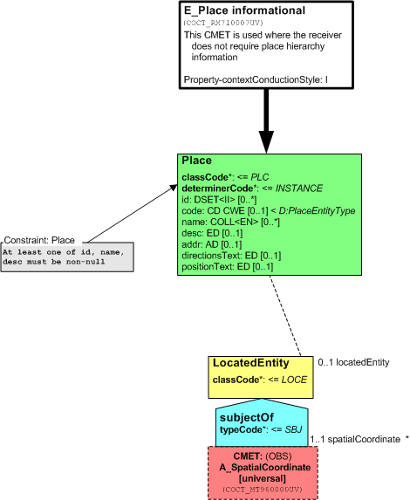
| Parent: | Patient Administration (PRPA_DM000000UV) |
This is the informational variant of E_Place universal. This CMET is used where the receiver is assumed not to need the place identifier or place hierarchy information to process the message.
Place - a bounded physical place or site with its contained structures, if any. May be natural or man-made.
- id - identifiers for this physical place (optional)
- code - value further specifying the type of place drawn from the PlaceEntityType domain. Examples include bed location, room location, floor location, wing location, and building location.
- name - non-unique textual identifiers or monikers for this place
- desc - textual or multimedia depiction of this place. Note: descriptions are meant to be shown to interested human individuals.
- addr - physical address of this place
- directionsText - free text note that carries information related to a site that is useful for entities accessing that site. For example, it could include information useful to people visiting the location such as "Last house on the right" or "If owner not present, check whereabouts with neighbor down the road".
- positionText - text reference that locates the site within a mapping scheme, for example, map coordinates for US Geological Survey maps
- A_SpatialCoordinate - The position of a Place can be specified by a spatial coordinate observation
Constraints
- For Place, either id or name must be non-null
| A_SpatialCoordinateUniversal | COCT_MT960000UV05 |
| E_Place informational | COCT_MT710007UV07 |
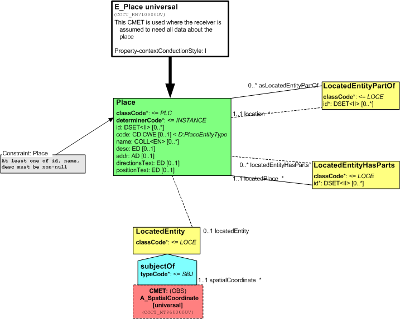
| Parent: | Patient Administration (PRPA_DM000000UV) |
This CMET is the universal variant of E_Place. This CMET is used to describe a place, which can be recursively described within a containing place, and/or contain other places. The universal variant is used where the receiver is assumed to need all data about the place.
Changes from Previous Version (COCT_RM710000UV01)
- Place adds the addr attribute
- Place removes the gpsText attribute and replaces it with an Optional 0..1 association to A_SpatialCoordinate [universal] CMET.
- LocatedEntityPartOf changes conformance for id attribute from Required 0..1 to Mandatory 1..*
- LocatedEntityHasParts changes conformance for id attribute from Required 0..1 to Mandatory 1..*
Place - a bounded physical place or site with its contained structures, if any. May be natural or man-made.
- id - identifiers for this physical place
- code - value further specifying the type of place drawn from the PlaceEntityType domain. Examples include bed location, room location, floor location, wing location, and building location.
- name - non-unique textual identifiers or monikers for this place
- desc - textual or multimedia depiction of this place. Note: descriptions are meant to be shown to interested human individuals.
- addr - physical address of this place
- directionsText - free text note that carries information related to a site that is useful for entities accessing that site. For example, it could include information useful to people visiting the location such as "Last house on the right" or "If owner not present, check whereabouts with neighbor down the road".
- positionText - text reference that locates the site within a mapping scheme, for example, map coordinates for US Geological Survey maps
LocatedEntityHasParts - association of a place to other places contained within it. This supports a hierarchy of places, for example a building wing (scoping entity) contains rooms (playing entity).
LocatedEntityPartOf - association of a place to other places that contain it. This supports a hierarchy of places, for example a bed location (playing entity) located within a room (scoping entity)
A_SpatialCoordinate - The position of a Place can be specified by a spatial coordinate observation.
Constraints
- For Place, either id or name must be non-null
| A_SpatialCoordinateUniversal | COCT_MT960000UV05 |
| E_Place universal | COCT_MT710000UV07 |
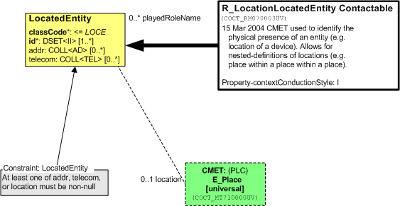
| Parent: | Patient Administration (PRPA_DM000000UV) |
This is the contact variant of R_LocationLocatedEntity universal. This CMET supports the case where the receiver is assumed to need to communicate the located entity at a particular place (e.g., via phone, email or postal mail).
LocatedEntity - Relates an entity (player) to a Place (scoper) at which it is located
- id - one or more identifiers for this located entity (mandatory)
- addr - addresses for the focal entity at this location
- telecom - telecommunication addresses for the focal entity at this location
- E_Place Universal - a bounded physical place or site with its contained structures, if any. May be natural or man-made. The geographic position of a place may or may not be constant. The place can be recursively described within a containing place and/or contain other places. The place can be located via Spatial Coordinates.
Constraints
- Either an addr or telecom must be non-null
| E_PlaceUniversal | COCT_MT710000UV07 |
| R_LocationLocatedEntity contact | COCT_MT070003UV02 |

| Parent: | Patient Administration (PRPA_DM000000UV) |
This is the identified variant of R_LocationLocatedEntity universal. This CMET supports the case of closely coupled systems where the receiver only needs an identifier.
LocatedEntity - Relates an entity (player) to a Place (scoper) at which it is located
- id - one or more identifiers for this located entity (mandatory)
| R_LocationLocatedEntity identified | COCT_MT070001UV02 |
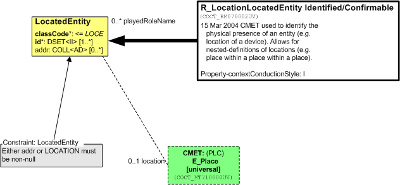
| Parent: | Patient Administration (PRPA_DM000000UV) |
This is the identified-confirmable variant of R_LocationLocatedEntity universal. This CMET supports the use case where the receiver may not have any of the LocatedEntity's identifiers and requires additional attributes to match.
LocatedEntity - Relates an entity (player) to a Place (scoper) at which it is located
- id - one or more identifiers for this located entity (mandatory)
- addr - addresses for the focal entity at this location
- E_Place Universal - a bounded physical place or site with its contained structures, if any. May be natural or man-made. The geographic position of a place may or may not be constant. The place can be recursively described within a containing place and/or contain other places. The place can be located via Spatial Coordinates.
Constraints
- Either LocatedEntity.addr or E_Place must be non-null
| E_PlaceUniversal | COCT_MT710000UV07 |
| R_LocationLocatedEntity identified-confirmable | COCT_MT070002UV02 |
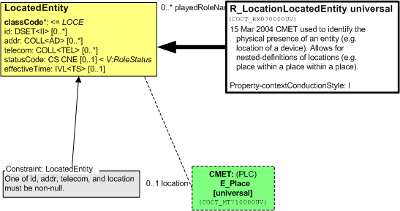
| Parent: | Patient Administration (PRPA_DM000000UV) |
Used to identify a particular location. (I.e. bed or a nursing station, floor, building) in a Healthcare Facility. May be scoped or involved in a participation. Allows for nested definitions, i.e., place within place within place.
LocatedEntity - Relates an entity (player) to a Place (scoper) at which it is located
- id - identifiers for this located entity (optional)
- addr - addresses for the focal entity at this location
- telecom - telecommunication addresses for the focal entity at this location
- statusCode - value specifying the state of this located entity role (based on the RIM Role class state-machine), for example active, suspended, terminated
- effectiveTime - interval of time specifying the period during which the focal entity is at the specified location, if such time is applicable and known
- E_Place Universal - a bounded physical place or site with its contained structures, if any. May be natural or man-made. The geographic position of a place may or may not be constant. The place can be recursively described within a containing place and/or contain other places. The place can be located via Spatial Coordinates.
Constraints
- Either an id, addr, telecom or E_Place must be non-null
| E_PlaceUniversal | COCT_MT710000UV07 |
| R_LocationLocatedEntity universal | COCT_MT070000UV01 |
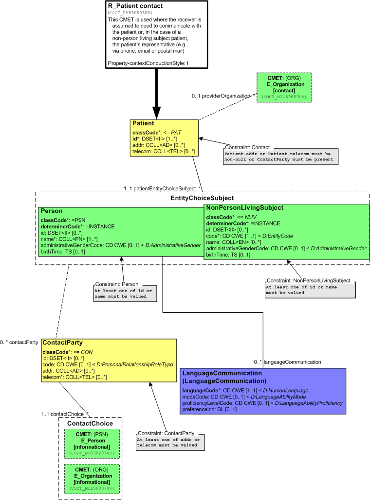
| Parent: | Patient Administration (PRPA_DM000000UV) |
This is the contact variant of R_Patient universal. This CMET is used where the receiver is assumed to need to communicate with the patient or the patient's representative (e.g., via phone, email or postal mail).
Changes from Previous Version (COCT_RM500003UV04)
This CMET was updated to be consistent with the Patient Administration Registries DMIM. Specific changes are:
- Person changes classCode attribute domain specification from <= PSN to = PSN
- Person changes determinerCode attribute domain specification from <= INSTANCE to = INSTANCE
- Patient changes id attribute cardinality from [0..*] to [1..*]
- Person changes name attribute conformance from optional [0..*] to required [1..*]
- Patient changes conformance of association to EntityChoiceSubject from optional [0..1] to required [1..1]
- Person changes name attribute datatype from BAG<EN> to BAG<PN>
- Person adds association to LanguageCommunication to be consistent with E_Person contact
- NonPersonLivingSubject changes determinerCode attribute domain specification from <= INSTANCE to = INSTANCE
- NonPersonLivingSubject adds Required code attribute
- NonPersonLivingSubject removes quantity and strainText attributes
- ContactParty changes playing entity from an Optional 0..1 association to a choice of ContactPerson or ContactOrganization to a Required 1..1 association to a choice of E_Person [informational] or E_Organization [informational]
- ContactParty adds code attribute tied to the PersonalRelationshipRoleType domain
- ContactParty adds constraint requiring that either addr or telecom must be valued
- Changed constraint requiring either Patient.addr or Patient.telecom be valued to "Patient.addr or Patient.telecom must be non-null or ContactParty must be present"
Patient - a role played by a living subject (either a Person or a Non-person Living Subject) as a recipient or potential recipient of health care services from a healthcare provider Organization (represented by E_Organization [contact])
- id - one or more identifiers for this patient (mandatory)
- addr - addresses for corresponding with the focal living subject in their role as patient
- telecom - telecommunication addresses for communicating with the focal living subject in their role as patient
EntityChoiceSubject - A Living Subject can be either a person or a non-person living subject.
- Person - A specific human being who is or was alive
- id - identifiers for this person (optional)
- name - one or more names for this person (required)
- administrativeGenderCode - value representing the gender (sex) of this person. Note: this attribute does not include terms related to clinical gender which is a complex physiological, genetic and sociological concept that requires multiple observations in order to be comprehensively described.
- birthTime - date and time this person was born. This could be an exact moment such as January 1, 1960 @ 03:00:00 EST or an approximate date such as January 1960.
- Language Communication - the language communication capability of the focal person
- NonPersonLivingSubject -A specific non-person living subject (e.g., animal, microorganism, plant) that is or was alive
- id - identifiers for this non-person living subject (optional)
- code - value representing the specific kind of non-person living subject the instance represents, for example animal or plant taxonomy (required)
- name - names of this non-person living subject (optional)
- administrativeGenderCode - value representing the gender (sex) of this non-person living subject. This attribute does not include terms related to clinical gender which is a complex physiological, genetic and sociological concept that requires multiple observations in order to be comprehensively described.
- birthTime - date and time this non-person living subject was born or hatched. This could be an exact moment such as January 1, 1960 @ 03:00:00 EST or an approximate date such as January 1960.
- ContactParty - a person or organization that is authorized to provide information about the focal living subject (patient)
- id - identifiers for this contact party relationship (optional)
- code - value specifying the type of relationship a contact person has to the patient form whom they are a contact; for example, spouse, parent, neighbor
- addr - addresses for corresponding with this contact party
- telecom - telecommunications addresses for communicating with this contact party
Constraints
- Patient.addr or Patient.telecom must be non-null or ContactParty must be present
- EntityChoice (Person or NonPersonLivingSubject) must have id or name non-null
- For ContactParty, either addr or telecom must be non-null
| E_PersonInformational | COCT_MT030207UV07 |
| E_OrganizationContact | COCT_MT150003UV03 |
| E_OrganizationInformational | COCT_MT150007UV |
| R_Patient contact | COCT_MT050003UV09 |
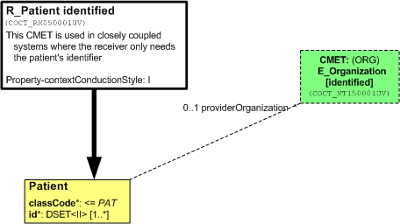
| Parent: | Patient Administration (PRPA_DM000000UV) |
This is the identified variant of R_Patient universal. This CMET supports the case of closely coupled systems where the receiver only needs the patient's identifier
Patient - a role played by a living subject as a recipient or potential recipient of health care services from a healthcare provider Organization (represented by E_Organization [identified])
- id - one or more identifiers for this patient (mandatory)
| E_OrganizationIdentified | COCT_MT150001UV01 |
| R_Patient identified | COCT_MT050001UV07 |
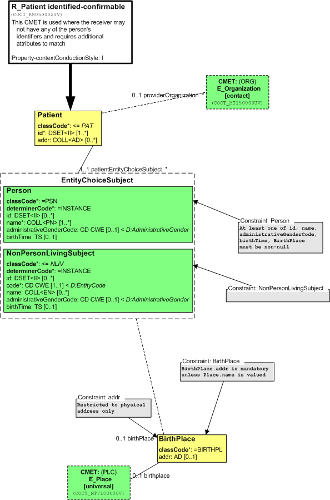
| Parent: | Patient Administration (PRPA_DM000000UV) |
This is the identified-confirmable variant of R_Patient universal This CMET supports the case where the receiver may not have any of the patient's identifiers and requires additional attributes to match
Changes from Previous Version (COCT_RM050002UV04)
- Patient changes conformance for association to EntityChoiceSubject from optional [0..1] to required [1..1]
- EntityChoiceSubject adds association to BirthPlace
- Person changes classCode attribute domain specification from <= PSN to = PSN
- Person changes determinerCode attribute domain specification from <= INSTANCE to = INSTANCE
- Person changes name attribute conformance from Optional [0..*] to Required [1..*]
- Person changes name attribute datatype from BAG<EN> to BAG<PN>
- Person adds a constraint requiring that at least one of id, name, administrativeGenderCode, birthTime, BirthPlace be non-null
- NonPersonLivingSubject changes determinerCode attribute domain specification from <= INSTANCE to = INSTANCE
- NonPersonLivingSubject adds Required code attribute
- NonPersonLivingSubject adds a constraint requiring that at least one of id, name, administrativeGenderCode, birthTime, BirthPlace be non-null
Patient - a role played by a living subject (either a Person or a Non-person Living Subject) as a recipient or potential recipient of health care services from a healthcare provider Organization (represented by E_Organization [contact])
- id - one or more identifiers for this patient (mandatory)
- addr - addresses for corresponding with the focal living subject in their role as patient
EntityChoiceSubject - A Patient can be either a person or a non-person living subject.
- Person - A specific human being who is or was alive
- id - identifiers for this person (optional)
- name - one or more names for this person (required)
- administrativeGenderCode - value representing the gender (sex) of this person. Note: this attribute does not include terms related to clinical gender which is a complex physiological, genetic and sociological concept that requires multiple observations in order to be comprehensively described.
- birthTime - date and time this person was born. This could be an exact moment such as January 1, 1960 @ 03:00:00 EST or an approximate date such as January 1960.
- NonPersonLivingSubject -A specific non-person living subject (e.g., animal, microorganism, plant) that is or was alive
- id - identifiers for this non-person living subject (optional)
- code - value representing the specific kind of non-person living subject the instance represents, for example animal or plant taxonomy (required)
- name - names of this non-person living subject
- administrativeGenderCode - value representing the gender (sex) of this non-person living subject. This attribute does not include terms related to clinical gender which is a complex physiological, genetic and sociological concept that requires multiple observations in order to be comprehensively described.
- birthTime - date and time this non-person living subject was born or hatched. This could be an exact moment such as January 1, 1960 @ 03:00:00 EST or an approximate date such as January 1960.
Birth Place is the location where the focal living subject was born or hatched
Constraints
- For Person, at least one of id, name, administrativeGenderCode, birthTime or BirthPlace must be non-null or name non-null
- For NonPersonLivingSubject, at least one of id, name, code, administrativeGenderCode, birthTime or BirthPlace must be non-null
- For BirthPlace, either addr (physical address) or Place.name must be non-null
| E_OrganizationContact | COCT_MT150003UV03 |
| E_PlaceUniversal | COCT_MT710000UV07 |
| R_Patient identified-confirmable | COCT_MT050002UV07 |
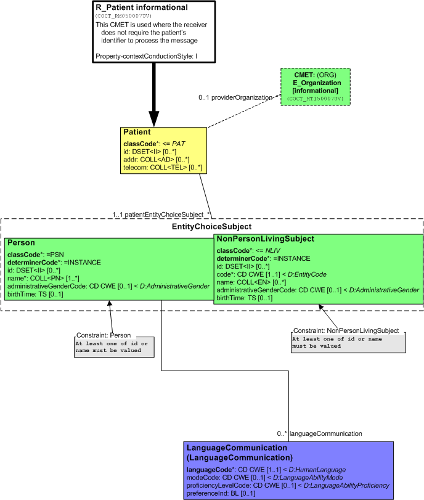
| Parent: | Patient Administration (PRPA_DM000000UV) |
This is the informational variant of R_Patient universal. This CMET is used where the receiver is assumed not to need the patient's identifier to process the message.
Patient - a role played by a living subject (either a Person or a Non-person Living Subject) as a recipient or potential recipient of health care services from a healthcare provider Organization (represented by E_Organization [informational])
- id - identifiers for this patient (optional)
- addr - addresses for corresponding with the focal living subject in their role as patient
- telecom - telecommunication addresses for communicating with the focal living subject in their role as patient
EntityChoiceSubject - A Living Subject can be either a person or a non-person living subject.
- Person - a specific human being who is or was alive
- id - identifiers for this person (optional)
- name - one or more names for this person (required)
- administrativeGenderCode - value representing the gender (sex) of this person. Note: this attribute does not include terms related to clinical gender which is a complex physiological, genetic and sociological concept that requires multiple observations in order to be comprehensively described.
- birthTime - date and time this person was born. This could be an exact moment such as January 1, 1960 @ 03:00:00 EST or an approximate date such as January 1960.
- Language Communication - the language communication capability of the focal person
- NonPersonLivingSubject -a specific non-person living subject (e.g., animal, microorganism, plant) that is or was alive
- id - identifiers for this non-person living subject (optional)
- code - value representing the specific kind of non-person living subject the instance represents, for example animal or plant taxonomy (required)
- name - names of this non-person living subject
- administrativeGenderCode - value representing the gender (sex) of this non-person living subject. This attribute does not include terms related to clinical gender which is a complex physiological, genetic and sociological concept that requires multiple observations in order to be comprehensively described.
- birthTime - date and time this non-person living subject was born or hatched. This could be an exact moment such as January 1, 1960 @ 03:00:00 EST or an approximate date such as January 1960.
Constraints
- The EntityChoice (Person or NonPersonLivingSubject) must have id or name non-null
| E_OrganizationInformational | COCT_MT150007UV |
| R_Patient informational | COCT_MT050007UV07 |
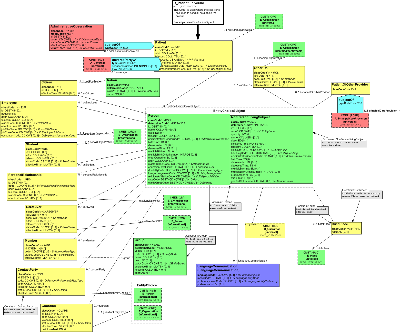
| Parent: | Patient Administration (PRPA_DM000000UV) |
This is the universal variant of R_Patient. This CMET supports the case where the receiver is assumed to need all data about a living subject patient.
Changes from Previous Version (COCT_RM050000UV01)
- Patient changes conformance of id attribute from Required [1..*] to Optional [0..*]
- Patient changes conformance of statusCode attribute from Optional [1..1] to Optional [0..1]
- Patient adds association to AdministrativeObservation
- Patient adds association to A_Coverage
- Patient playing entity changed from E_LivingSubject [universal] to individual classes due to a tooling limitation that does not allow defining associations leading from CMETs. The PatientOfOtherProvider association from EntityChoiceSubject is not included in the E_LivingSubject [universal] CMET.
- Patient association to LivingSubject changed from [1..1] to [0..1]
- Person changes datatype of name attribute from BAG<EN> to BAG<PN>
- Person removes statusCode attribute
- Person adds telecom and addr attributes
- Person changes classCode attribute domain specification from <= PSN to = PSN
- Person changes determinerCode attribute domain specification from <= INSTANCE to = INSTANCE
- Person adds a constraint requiring that either id or name must be valued
- NonPersonLivingSubject changes determinerCode attribute domain specification from <= INSTANCE+KIND to = INSTANCE
- NonPersonLivingSubject removes statusCode attribute
- NonPersonLivingSubject changes datatype of name attribute from <SET>EN to <BAG>EN
- NonPersonLivingSubject adds code, telecom and deceasedTime attributes
- NonPersonLivingSubject adds a constraint requiring that either id or name must be valued
- EntityChoiceSubject adds new association to PersonalRelationship
- EntityChoiceSubject adds new association to CareGiver
- EntityChoiceSubject removes association to R_CoveredParty [universal]
- Citizen changes association to scoping entity from Optional 1..1 association to E_Organization to Mandatory 1..1 association to Nation
- Citizen changes classCode attribute domain specification from <= CIT to = CIT
- Student corrects datatype of statusCode attribute from SET<CS> to CS
- Student changes classCode attribute domain specification from <= STD to = STD
- Student changes association to scoping organization from E_Organization [universal] to E_Organization [informational]
- Employment renamed Employee
- Employee adds occupationCode attribute
- Employee removes jobCode attribute
- Employee changes association to scoping organization from Optional 0..1 association to E_Organization [universal] to Required 1..1 association to E_Organization [informational]
- Member changes scoping entity from an Optional 1..1 association to Entity to a Required 1..1 association to Group
- Group adds code, telecom and addr attributes
- Group removes quantity attribute
- Group adds a constraint requiring that either id or name must be valued
- Guarantor class replaced with R_Guarantor CMET
- BirthPlace adds addr attribute and changes association to E_Place [universal] from Optional 1..1 to Optional 0..1
- BirthPlace changes classCode attribute domain specification from <= BIRTHPL to = BIRTHPL
- OtherIDs adds code, statusCode and effectiveTime attributes
- OtherIDs changes id attribute from Optional [1..*] to Mandatory [1..*]
- OtherIDs changes scoping organization from Optional 0..1 association to E_Organization [universal] to Required 1..1 association E_Organization[identified/confirmable]
- ContactParty changes playing entity from an Optional 1..1 association to a choice of E_Person [identified/confirmable] or E_Organization [identified/confirmable] to a Required 1..1 association to a choice of E_Person [informational] or E_Organization [informational]
- ContactParty changes code attribute from the AdministrativeContactRoleType domain to the PersonalRelationshipRoleType domain
- ContactParty changes telecom attribute from Mandatory 1..* to Required 0..*
- ContactParty adds constraint requiring that either addr or telecom must be valued
- Guardian changes playing entity from an Optional 1..1 association to a choice of E_Person [identified/confirmable] or E_Organization [identified/confirmable] to a Required 1..1 association to a choice of E_Person [informational] or E_Organization [informational]
Patient - a role played by a living subject (either a Person or a Non-person Living Subject) as a recipient or potential recipient of health care services from a healthcare provider Organization (represented by E_Organization [universal])
- A Patient can be the subject of an Administrative Observation. This can be any type of information that is not represented elsewhere in the information model, for example, a "shared secret".
- A Patient can be covered by an insurance policy or government program conveyed in an A_Coverage CMET
- A Patient of one healthcare Organization may also be the Patient of Other Provider who is responsible for some aspect of the patient's care, i.e., a principal or primary care provider. Note that RIM semantics cause this to be modeled as an association from the Entity Choice Subject.
EntityChoiceSubject - A Living Subject can be either a person or a non-person living subject.
Person - A specific human being who is or was alive.
- id - Identifier(s) for this person. Note that these identifiers can only be used for matching purposes since no scoping organization or status information is included.
- name - Name(s) for this person
- desc - A textual or multimedia depiction of this person. Descriptions are meant to be shown to interested human individuals.
- telecom - Telecommunication address(es) for communicating with this person
- administrativeGenderCode - A value representing the gender (sex) of this person. Note: this attribute does not include terms related to clinical gender which is a complex physiological, genetic and sociological concept that requires multiple observations in order to be comprehensively described.
- birthTime - The date and time this person was born. This could be an exact moment such as January 1, 1960 @ 03:00:00 EST or an approximate date such as January 1960.
- deceasedInd - An indication that this person is dead
- deceasedTime - The date and time this person died. This could be an exact moment such as January 1, 1960 @ 03:00:00 EST or an approximate date such as January 1960.
- multipleBirthInd - An indication that this person was part of a multiple birth
- multipleBirthOrderNumber - The order in which this person was born if part of a multiple birth
- organDonorInd - An indication that this person is a candidate to serve as an organ donor. Note: specifics of an organ donor agreement would be conveyed in a medico-legal document.
- addr - Address(es) for corresponding with this person
- maritalStatusCode - A value representing the domestic partnership status of this person
- educationLevelCode - A value representing the highest level of education this person achieved
- disabilityCode - A set of values identifying this person's disabilities
- livingArrangementCode - A value specifying the housing situation of this person
- religiousAffiliationCode - A value representing the primary religious preference of this person
- raceCode - A set of values representing the races of this person
- ethnicGroupCode - A set of values representing the ethnic groups of this person
NonPersonLivingSubject -A specific non-person living subject (e.g., animal, microorganism, plant) that is or was alive.
- id - Identifier(s) for this non-person living subject. Note that these identifiers can only be used for matching purposes since no scoping organization or status information is included.
- code - A required value representing the specific kind of non-person living subject the instance represents, for example animal or plant taxonomy.
- quantity - For cases where the patient is a group of animals, such as a herd, this specifies the number of animals in the herd.
- name - The name(s) of this non-person living subject
- desc - A textual or multimedia depiction of this non-person living subject. Descriptions are meant to be shown to interested human individuals.
- existenceTime - An interval of time specifying the period in which this non-person living subject physically existed
- telecom - Telecommunication address(es) for communicating with the focal non-person living subject
- riskCode - A value representing the type of hazard or threat associated with this non-person living subject. Animals of irascible temperament may prove to be a risk to healthcare personnel.
- handlingCode - A value representing special handling requirements for this non-person living subject to avoid damage to it or other entities
- administrativeGenderCode - A value representing the gender (sex) of this non-person living subject. This attribute does not include terms related to clinical gender which is a complex physiological, genetic and sociological concept that requires multiple observations in order to be comprehensively described.
- birthTime - The date and time this non-person living subject was born. This could be an exact moment such as January 1, 1960 @ 03:00:00 EST or an approximate date such as January 1960.
- deceasedInd - An indication that this non-person living subject is dead.
- deceasedTime - The date and time this non-person living subject died. This could be an exact moment such as January 1, 1960 @ 03:00:00 EST or an approximate date such as January 1960.
- multipleBirthInd - An indication that this non-person living subject was part of a multiple birth
- multipleBirthOrderNumber - The order in which this non-person living subject was born if part of a multiple birth
- organDonorInd - An indication that this non-person living subject is a candidate to serve as an organ donor
- strainText - A text string representing the specific genotypic or phenotypic variant of this non-person living subject
- genderStatusCode - A value representing whether the primary reproductive organs of this non-person living subject are present
Associations
- Personal Relationship is another living subject related to the focal living subject such as parent, sibling, spouse, neighbor
- Care Giver is a person who provides primary care for the focal living subject at home
- Member is the membership of the focal living subject in a Group such as a family, tribe or religious organization
- Contact Party is a person or organization that is authorized to provide or receive information about the focal living subject
- Guardian is a person or an organization that is legally responsible for the care and management of the focal living subject.
- Guarantor is a person or organization that takes financial responsibility for the health care of the focal living subject
- Birth Place is the location where the focal living subject was born or hatched
- Other IDs conveys identifiers assigned to the focal living subject in other systems
- The Person specialization of Living Subject also includes additional associations:
- Citizen - a relationship between the focal person who owes loyalty to and is entitled by birth or naturalization to the protection of a Nation
- Employee - a relationship of the focal person with an organization to receive wages or salary. The purpose of this class is to identify the type of relationship the employee has to the employer rather than the nature of the work actually performed
- Student - a relationship of the focal person to a school in which they are enrolled
- Language Communication - the language communication capability of the focal person
Constraints
- For Person, either id or name must be non-null
- For NonPersonLivingSubject, either id or name must be non-null
- For BirthPlace, either BirthPlace.addr (physical address) or Place.name must be non-null
- For ContactParty, either addr or telecom must be non-null
- For Group, either id or name must be non-null
| E_LivingSubjectInformational | COCT_MT030007UV |
| E_PersonInformational | COCT_MT030207UV07 |
| E_PersonInformational | COCT_MT030207UV07 |
| E_OrganizationUniversal | COCT_MT150000UV02 |
| E_OrganizationIdentified/confirmable | COCT_MT150002UV01 |
| E_OrganizationInformational | COCT_MT150007UV |
| E_OrganizationInformational | COCT_MT150007UV |
| A_CoverageUniversal | COCT_MT510000UV06 |
| R_GuarantorUniversal | COCT_MT670000UV04 |
| E_PlaceUniversal | COCT_MT710000UV07 |
| A_PrincipalCareProvisionUniversal | COCT_MT820000UV |
| R_Patient universal | COCT_MT050000UV01 |
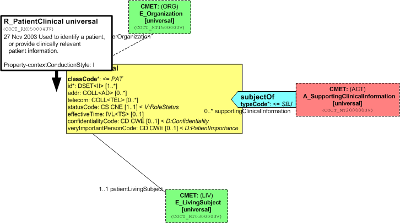
| Parent: | Patient Administration (PRPA_DM000000UV) |
The R_PatientClinical CMET is similar to R_Patient universal, except that it adds a participation to allow supporting clinical information via the A_SupportingClinicalInformation universal CMET.
| E_LivingSubjectUniversal | COCT_MT030000UV09 |
| E_OrganizationUniversal | COCT_MT150000UV02 |
| A_SupportingClinicalInformationUniversal | COCT_MT200000UV01 |
| R_PatientClinical universal | COCT_MT050004UV01 |
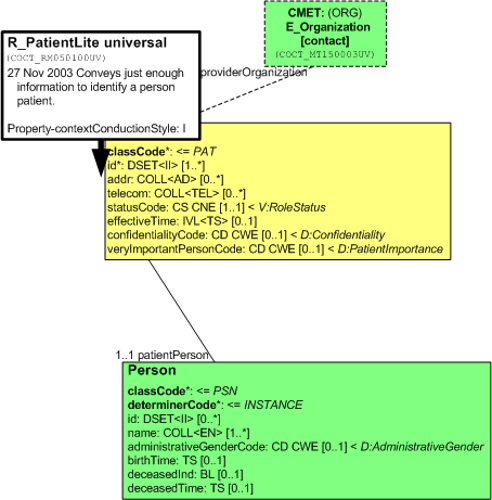
| Parent: | Patient Administration (PRPA_DM000000UV) |
Use to identify a patient only when minimal patient information is needed (as in the case of a clinical document header in a tightly coupled system). The patient is always a person.
| E_OrganizationContact | COCT_MT150003UV03 |
| R_PatientLite universal | COCT_MT050100UV02 |
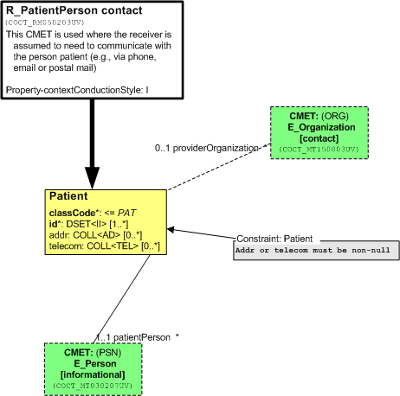
| Parent: | Patient Administration (PRPA_DM000000UV) |
This is a contact variant of R_Patient universal. This CMET is used where the receiver is assumed to need to communicate with a person patient (e.g., via phone, email or postal mail).
Patient - a role played by a person as a recipient or potential recipient of health care services from a healthcare provider Organization (represented by E_Organization [contact])
- id - one or more identifiers for this patient (mandatory)
- addr - addresses for corresponding with the focal person in his or her role as patient
- telecom - telecommunication addresses for communicating with the focal person in his or her role as patient
- E_Person [informational] - the person playing the role of patient. See E_Person informational for a description
Constraints
- For Patient, either addr or telecom must be non-null
| E_PersonInformational | COCT_MT030207UV07 |
| E_OrganizationContact | COCT_MT150003UV03 |
| R_PatientPerson contact | COCT_MT050203UV07 |
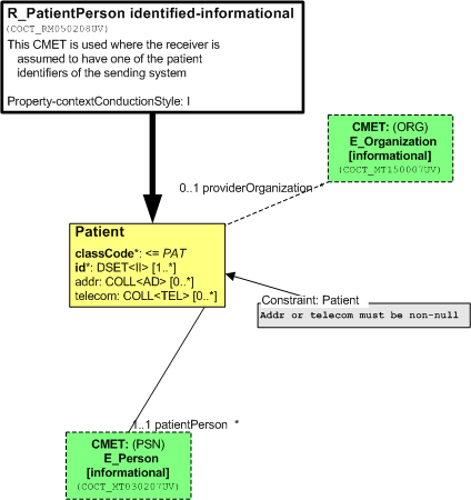
| Parent: | Patient Administration (PRPA_DM000000UV) |
This is an identified-informational variant of R_Patient universal. This CMET is used where the receiver is assumed to have one of the person patient identifiers of the sending system.
Patient - a role played by a person as a recipient or potential recipient of health care services from a healthcare provider Organization (represented by E_Organization [informational])
- id - one or more identifiers for this patient (mandatory)
- addr - addresses for corresponding with the focal person in his or her role as patient
- telecom - telecommunication addresses for communicating with the focal person in his or her role as patient
- E_Person [informational] - the person playing the role of patient. See E_Person informational for a description
Constraints
- Either addr or telecom must be non-null
| E_PersonInformational | COCT_MT030207UV07 |
| E_OrganizationInformational | COCT_MT150007UV |
| R_PatientPerson identified-informational | COCT_MT050208UV07 |
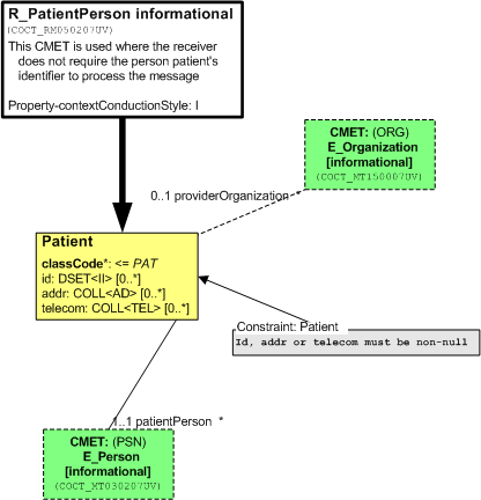
| Parent: | Patient Administration (PRPA_DM000000UV) |
This is an informational variant of R_Patient universal. This CMET supports the case where the patient is always a person and the receiver is assumed not to need the patient's identifier to process the message.
Patient - a role played by a person as a recipient or potential recipient of health care services from a healthcare provider Organization (represented by E_Organization [informational])
- id - identifiers for this patient (optional)
- addr - addresses for corresponding with the focal living subject in their role as patient
- telecom - telecommunication addresses for communicating with the focal living subject in their role as patient
- E_Person Informational - the person playing the role of patient; at least an id, name, administrativeGenderCode or birthTime will be valued
Constraints
- For Patient, at least one of id, addr or telecom must be non-null
| E_PersonInformational | COCT_MT030207UV07 |
| E_OrganizationInformational | COCT_MT150007UV |
| R_PatientPerson informational | COCT_MT050207UV07 |
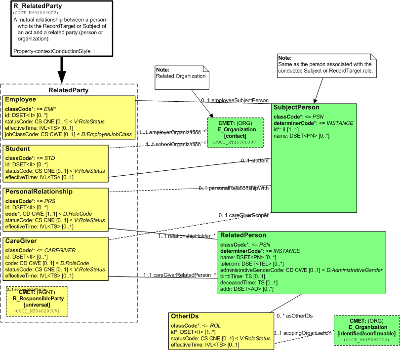
| Parent: | Patient Administration (PRPA_DM000000UV) |
The R_RelatedParty CMET defines a mutual relationship between a person who is the RecordTarget or Subject of an act and a related party (person or organization).
The RelatedParty choice box offers types of relationships between the subject person and a related party:
- Employee - The subject person (playing entity) is an employee of the related employer organization (scoping entity).
- Student - The subject person (playing entity) is a student of the related school organization (scoping entity).
- PersonalRelationship - The relationship holding person (playing entity) has a personal relationship with the subject person (scoping entity). The mandatory code attribute specifies the type of personal relationship; examples include spouse, parent, sibling, child and unrelated friend.
- CareGiver - The care giving person (playing entity) is responsible for the primary care at home of the subject person (scoping entity).
- R_ResponsibleParty - The agent party (playing entity) is authorized to act on behalf of the subject person (scoping entity). The code attribute specifies the type of agent relationship; examples include guardian and emergency contact.
| R_ResponsiblePartyUniversal | COCT_MT040200UV09 |
| E_OrganizationIdentified/confirmable | COCT_MT150002UV01 |
| E_OrganizationContact | COCT_MT150003UV03 |
| R_RelatedParty universal | COCT_MT910000UV |
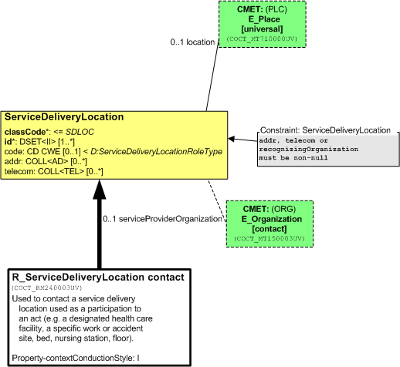
| Parent: | Patient Administration (PRPA_DM000000UV) |
This is the contact variant of R_ServiceDeliveryLocation universal. This CMET is used where the receiver is assumed to ned to communicate with service delivery location (e.g., via phone, email or postal mail).
ServiceDeliveryLocation - a role played by a Place (represented by E_Place [universal]) at which services may be provided by, or on behalf of, an Organization (represented by E_Organization [contact]).
- id - one or more identifiers for this service delivery location (mandatory)
- code - value further specifying what type of service delivery location this is, drawn from the ServiceDeliveryLocationRoleType domain. A service delivery location may be either an incidental service delivery location (a place at which services may be provided without prior designation or authorization) or a dedicated service delivery location (a place that is intended to house the provision of services). Dedicated service delivery locations can be further characterized as either clinical (DedicatedClinicalLocationRoleType) or non-clinical (DedicatedNonClinicalLocationRoleType).
- addr - addresses for a place playing this service delivery location role
- telecom - telecommunication addresses for a place playing this service delivery location role
Constraints
- At least one of addr, telecom or E_Organization must be non-null
| E_OrganizationContact | COCT_MT150003UV03 |
| E_PlaceUniversal | COCT_MT710000UV07 |
| R_ServiceDeliveryLocation contact | COCT_MT240003UV02 |
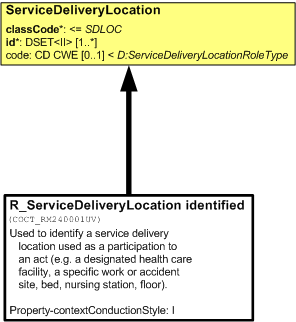
| Parent: | Patient Administration (PRPA_DM000000UV) |
This is the identified variant of R_ServiceDeliveryLocation universal. This CMET supports the use case of closely coupled systems where the receiver only needs the identifier of the service delivery location.
ServiceDeliveryLocation - A role played by a place at which services may be provided
- id - one or more identifiers for this service delivery location (mandatory)
- code - value further specifying what type of service delivery location this is, drawn from the ServiceDeliveryLocationRoleType domain. A service delivery location may be either an incidental service delivery location (a place at which services may be provided without prior designation or authorization) or a dedicated service delivery location (a place that is intended to house the provision of services). Dedicated service delivery locations can be further characterized as either clinical (DedicatedClinicalLocationRoleType) or non-clinical (DedicatedNonClinicalLocationRoleType).
| R_ServiceDeliveryLocation identified | COCT_MT240001UV02 |
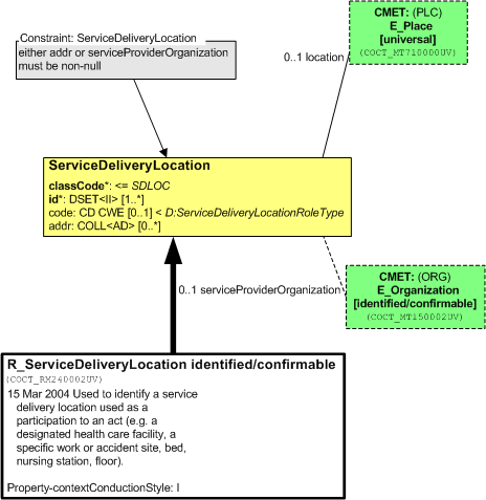
| Parent: | Patient Administration (PRPA_DM000000UV) |
This is the identified-confirmable variant of R_ServiceDeliveryLocation universal. This CMET is used in cases where the receiver may not have any of the identifiers and requires non-identifier attributes to match.
ServiceDeliveryLocation - a role played by a Place (reprsented by E_Place [universal]) at which services may be provided by, or on behalf of, an Organization (represented by E_Organization [identified/confirmable]).
- id - one or more identifiers for this service delivery location (mandatory)
- code - value further specifying what type of service delivery location this is, drawn from the ServiceDeliveryLocationRoleType domain. A service delivery location may be either an incidental service delivery location (a place at which services may be provided without prior designation or authorization) or a dedicated service delivery location (a place that is intended to house the provision of services). Dedicated service delivery locations can be further characterized as either clinical (DedicatedClinicalLocationRoleType) or non-clinical (DedicatedNonClinicalLocationRoleType).
- addr - addresses for a place playing this service delivery location role
Constraints
- Either addr or E_Organization must be non-null
| E_OrganizationIdentified/confirmable | COCT_MT150002UV01 |
| E_PlaceUniversal | COCT_MT710000UV07 |
| R_ServiceDeliveryLocation identified-confirmable | COCT_MT240002UV02 |
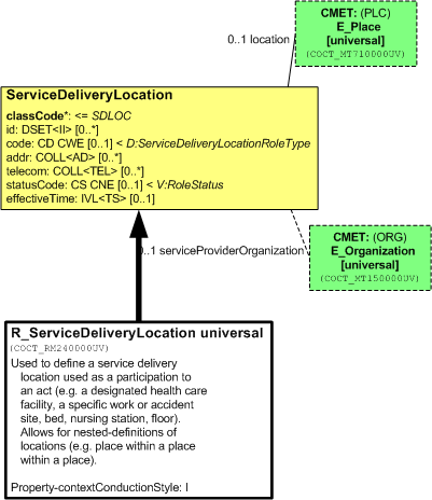
| Parent: | Patient Administration (PRPA_DM000000UV) |
This is the universal variant of R_ServiceDeliveryLocation. This CMET supports the case where the receiver is assumed to need all data about a service delivery location.
ServiceDeliveryLocation - a role played by a Place (represented by E_Place [universal]) at which services may be provided by, or on behalf of, an Organization (represented by E_Organization [universal]). Note that a single physical place can play multiple service delivery location roles each with its own attributes. For example, a Podiatry clinic and Research clinic may meet on alternate days in the same physical location; each clinic uses its own mailing address and telephone number.
- id - identifiers for this service delivery location
- code - value further specifying what type of service delivery location this is, drawn from the ServiceDeliveryLocationRoleType domain. A service delivery location may be either an incidental service delivery location (a place at which services may be provided without prior designation or authorization) or a dedicated service delivery location (a place that is intended to house the provision of services). Dedicated service delivery locations can be further characterized as either clinical (DedicatedClinicalLocationRoleType) or non-clinical (DedicatedNonClinicalLocationRoleType).
- addr - addresses for a place playing this service delivery location role
- telecom - telecommunication addresses for a place playing this service delivery location role
- statusCode - value specifying the state of this service delivery location (based on the RIM Role class state-machine), for example, pending, active, suspended, terminated.
- effectiveTime - interval of time specifying the period during which this service delivery location role is in effect, if such time limit is applicable and known
| E_OrganizationUniversal | COCT_MT150000UV02 |
| E_PlaceUniversal | COCT_MT710000UV07 |
| R_ServiceDeliveryLocation universal | COCT_MT240000UV01 |
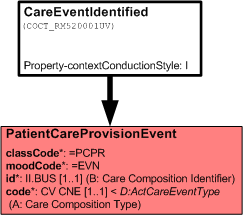
| Parent: | Care Provision (REPC_DM000000UV) |
A care composition is a record, which summarizes the events that happened during care including who is responsible for the care provided. Examples include encounters, episodes and general "care events" such as "gynecological care". It allows linking of records to encounters, episodes and other care compositions. Useful for searching and navigation of the patient's record.
Attributes
code: Identifies the kind of composition represented. E.g. "Emergency Encounter", "Long Term Care Encounter", "Episode", etc. Allows care compositions to be captured and categorized at different levels of abstraction, and is therefore mandatory.
id: Unique identifier of an encounter, episode or other care event. Allows care compositions to be uniquely identified and referenced, and is therefore mandatory
| A_CareEventIdentified Universal | COCT_MT520001UV |
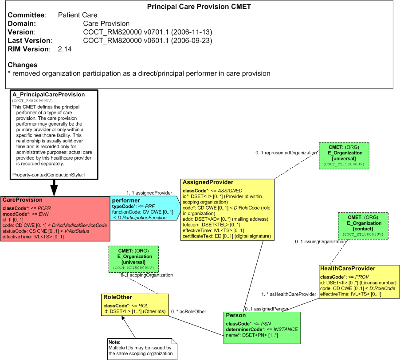
| Parent: | Care Provision (REPC_DM000000UV) |
Used to describe the principal performer responsible for a specified aspect of patient care (CareProvision), usually as a target of a patient subject participation.
The care provision performer may be the principal provider responsible for general care or while within a particular healthcare facility. This relationship is usually solid over time and is recorded only for administrative purposes; actual care provided by this healthcare provider is recorded separately.
Classes for conveying principal provider relationships are:
-
CareProvision - this is the act of being responsible for some aspect of care, performed by the assigned provider.
The type of care (e.g. Primary Care, Dentistry, Pharmacy, Ob/gyn.) is defined by the code attribute. The statusCode and effectiveTime can differentiate between current and former primary care provision.
The care provider performing the CareProvision act is linked via the performer participation. The performing function of the participant (e.g. primary care physician, preferred provider) can be specified by the participation functionCode attribute.
-
AssignedProvider - a person assigned a career functional role, optionally representing an organization. This is the care provider who has the principal responsibility of performing patient care.
The AssignedProvider class has the following attributes:- id - set of identifiers relevant to their role within the scope of the represented organization;
- code - specifies the functional role within the represented organization;
- addr - set of mailing addresses within the scope of the represented organization;
- telecom - set of electronic communication details within the scope of the represented organization;
- effectiveTime - start and end date, if relevant, of the assigned function role within the scope of the represented organization; and
- certificateText - digital certificate representing the provider performing the assigned role within the scope of the represented organization.
The AssignedProvider class has the following associated classes:
-
Organization (representedOrganization) - if relevant, the organization that the assigned provider represents, which is defined by an E_Organization [universal] CMET
Person - the care provider is a specific person, they are identified by name.
Person has the following associated classes:
-
RoleOther - used when the person has identifiers associated with other roles the person may play.
The id attribute collects a set of identifiers issued by the same scoping organization.
If relevant, the scoping organization of the RoleOther role is defined by the E_Organization [universal] CMET.
-
HealthCareProvider - the care provider must be licensed to provide health care services by some issuing organization.
The HealthCareProvider role has an id attribute that contains a set of license numbers issued by the scoping organization, a code that indicates the type of health care provider, and an effectiveTime providing the start and end dates of the license.
If relevant, the issuing organization that scopes the HealthCareProvider role is defined by the E_Organization [contact] CMET.
| E_OrganizationUniversal | COCT_MT150000UV02 |
| E_OrganizationUniversal | COCT_MT150000UV02 |
| E_OrganizationContact | COCT_MT150003UV03 |
| A_PrincipalCareProvision universal | COCT_MT820000UV |
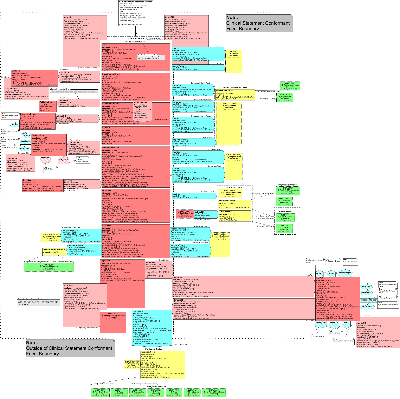
| Parent: | None |
Model Overview for A_PublicHealthStatement universal
The A_PublicHealthStatement CMET is designed to capture information of interest to public health. The model is based in part on the Clinical Statement Pattern. It focuses on those aspects of Clinical Statement that are directly related to public health.
The CMET has a central choice box that contains Act, Investigation, Incident, PublicHealthCase, Outbreak, Exposure and Organizer classes. It also includes the A_SupportingClinicalStatement universal CMET, thus allowing virtually any type of clinical statement information to be conveyed using this model.
The model also features a Focal Boundary labeled "Clinical Statement Conformant focal Boundary." Those portions of the model inside this focal boundary are intended to Clinical Statement Conformant based upon Clinical Statement Change Requests that have been approved as of 2/24/2009. Portions of the model outside the focal boundary should be considered as out of scope for Clinical Statement conformance. These non-clinical statement conformant parts of the model have been included in the Public Health Statement model to accommodate data which is of interest to public health but has not been gathered or formatted in a Clinical Statement conformant fashion.
ClinicalStatement Choice
The ClinicalStatement choice contains a choice of the PublicHealthStatement choice box or the A_SupportingClinicalStatement universal CMET.
PublicHealthStatement Choice:This structure contains classes of direct interest to public health.PublicHealthStatement Classes:PublicHealthStatement Participation's:
- Act: The Act (ACT) choice is a derivative of the RIM Act class, to be used when the other more specific classes are not appropriate. This class should not be used if there is a more appropriate class in the Act Choice or the SupportingClinicalStatement CMET. Many activities of interest to public health which are not directly related to health care may be modeled using the Act class. For instance if a case of food poisoning occurs during a picnic (bad potato salad perhaps) the picnic can be modeled as an Act, and the people at the picnic would be documented as participants in the picnic.
- InvestigationEvent: The InvestigationEvent class captures information directly related to the investigation and pulls together the rest of the relevant information.The subject of an investigation may be an entity (in the role of an investigative subject) or another act such as an exposure. Investigations normally use the trigger (TRIG) or reason (RSON) act relationship to document the activities that caused the investigation to occur. The InvestigationEvent may be associated with zero to many InvestigationIntents via the inFulfillmentOf(InFulfillmentOf) act relationship.
- InvestigationIntent: The InvestigationIntent class carries basic information regarding wither a request to perform an investigation or a promise to perform an investigation. The RQO (request or order) mood indicates that this is a request and use of the PRMS (promise) mood indicates a promise to perform an investigation. Other attributes include id, code, text, statusCode, effectiveTime, priorityCode and reasonCode.
- Incident: The Incident class describes some core information about the incident as a whole. This includes its type, when it occurred and any textual description of the incident. Incident is an event that occurred outside of the control of one or more of the parties involved. Includes the concept of an accident.
- PublicHealthCase: A public health case is an Observation representing a condition or event that has a specific significance for public health. Typically it involves an instance or instances of a reportable infectious disease or other condition. The public health case can include a health-related event concerning a single individual or it may refer to multiple health-related events that are occurrences of the same disease or condition of interest to public health. An outbreak involving multiple individuals may be considered as a type of public health case. A public health case definition (Act.moodCode = "definition") includes the description of the clinical, laboratory, and epidemiologic indicators associated with a disease or condition of interest to public health. There are case definitions for conditions that are reportable, as well as for those that are not. There are also case definitions for outbreaks. A public health case definition is a construct used by public health for the purpose of counting cases, and should not be used as clinical indications for treatment. Examples include AIDS, toxic-shock syndrome, and salmonellosis and their associated indicators that are used to define a case. A PublicHealthCase may be the subject of a CaseStatus Observation.
- Outbreak: An outbreak represents a series of public health cases. The date on which an outbreak starts is the earliest date of onset among the cases assigned to the outbreak, and its ending date is the last date of onset among the cases assigned to the outbreak.
- Exposure: Exposure is an interaction that provides opportunity for transmission of an agent from an exposure source entity to an exposure target entity. The agent is a physical (including energy), chemical or biological substance. (Note: This class deals only with opportunity and not the outcome of the exposure, i.e. not all exposed parties will necessarily acquire the agent nor will all who acquire the agent necessarily experience actual harm or benefit.) The Exposure class has the following Participants:
- exposureAgent(ExposureAgent1): The entity playing the associated role is the physical (including energy), chemical or biological substance that is participating as the exposure agent in the exposure. For example in communicable diseases, the associated playing entity is the disease causing pathogen. The target role is the ExposureAgentInstance role. The exposure agent instance (INST) role is scoped by the type of entity acting as the exposure agent in the exposure. The role is played by an instance of the type of entity scoping the role. Often the instance of the entity is not known, rather only the type of entity is known. The playing entity must use determinerCode = INSTANCE and the scoping entity must use the determinerCode = KIND.
- exposureTarget(ExposureTarget): The exposure target participation identifies those investigative subject(s) that are known to be the target of an exposure. In public health these entities are often called "contacts". The target of the participation is the R_InvestigativeSubject universal CMET.
- exposureSource(ExposureSource): The exposure agent carrier participates in the exposure act as an exposure source (EXSRC). The target of the participation is the R_ExposureAgentCarrier universal CMET.
- exposureParticipant(ExposureParticipant): The exposure participant is used when its not know whether a particular entity was involved in the exposure as an exposure target or as an exposure source. Early in an exposure investigation it may not be know what entities are the source of the exposure vs. targets of the exposure. As the exposure investigation progresses, the specific ways that entities participated in the exposure may become better identified, resulting in particular entities participation being changed to the more specific exposure target or exposure source. The target of the participation is the R_InvestigativeSubject universal CMET.
- Organizer: An Organizer (ORGANIZER) choice is a derivative of the RIM Act class, which can be used to create groupings of other clinical statements that share a common context for navigational purposes. An Organizer can contain other Organizers and/or other clinical statements, by traversing the component relationship. An Organizer can refer to acts by reference or by value via the component relationship. An Organizer cannot be the source of the sourceOf1, sourceOf2, definition or conditions relationships. The record entries relating to a single clinical session are usually grouped under headings that represent phases of the encounter, or assist with layout and navigation. The organizer represents a heading in a heading structure, or "organizer tree" and does not itself have any semantic content. Clinical headings usually reflect the clinical workflow during a care session, and might also reflect the main author's reasoning processes. Knowledge of the heading is not required to interpret contained clinical statements. Much research has demonstrated that headings are used differently by different professional groups and specialties, and that headings are not used consistently enough to support safe automatic processing of the EHR.The value for Act.ClassCode may be taken from the ActClassContainer vocabulary domain. Several specific types of collection are recognized (folder, composition, topic, category, cluster and battery), although individual communications will restrict the types that may be used for individual communication use cases.NOTE: The ActClassContainer title was changed to ActClassRecordOrganizer at the July 2007 harmonization meeting. The Entry code was changed to Grouper and the Organizer was changed to Container. When this change is added to the RIM the messaging tools and the vocabulary for this class will be changed to ActClassRecordOrganizer. An Organizer typically can be assigned a SNOMED CT concept identifier appropriate to its type (for example a category might be identified as 'investigations' and a battery might be identified as 'Full blood count'). However, any kind of concept identifier can be used, such as in the case of the HL7 CDA R2 Implementation Guides where LOINC is frequently employed. The Organizer may be used to harmonize hierarchical RECORD_COMPONENTs within and ENTRY object under either the CEN/ISO 13606 or openEHR standard with a Clinical Statement. The Organizer class may have a component ClinicalStatement Choice act.
PublicHealthStatement Act Relationships:
- subject(Subject4): The principle target of the public health statement. The R_Subject universal is the target of the participation.
- recordTarget(RecordTarget): The record target indicates whose record holds the documentation of this public health statement. The R_Subject universal is the target of the participation.
- responsibleParty(ResponsibleParty): The person or organization that has primary responsibility for the public health statement. The responsible party is not necessarily present in an action, but is accountable for the action through the power to delegate, and the duty to review actions with the performing actor after the fact. The R_AssignedParty universal CMET is the target of the participation.
- performer(Performer): A person or organization that actually and principally carries out the action. The ProviderPatientOrRelated choice box is the target of the participation. ProviderPatientOrRelated:
- InvestigatedPerson: A person that is the subject of an investigation. This role is scoped by the organization responsible for the investigation. The role is scoped by the investigationSponsor (E_Organization universal) and played by the subjectPublicHealthPerson (E_PublicHealthPerson universal).
- R_AssignedParty universal: The party assigned to participate in the act via this participation.
- author(Author): The person or organization that originates the public health statement and therefore has responsibility for the information given in the Act and ownership of this Act. The author may be either an investigative subject or a assigned party (person or organization). See performer(Performer) above for a description of the ProviderPatientOrRelated choice box.
- dataEnterer(DataEnterer): The person transcribing the data, details of which are carried in the AssignedPerson CMET.
- informant(Informant): A source of reported information (e.g., a next of kin who answers questions about the patient's history). See performer(Performer) above for a description of the ProviderPatientOrRelated choice box.
- verifier(Verifier): Identifies one or more individuals who verify the content of the Public Health Statement, details of which are carried in the AssignedEntity CMET.
- location(Location): A clinical statement may be associated with a location. The target of the participation is the LocationChoice choice box. LocationChoice:
- R_ServiceDeliveryLocation universal: The location may be a healthcare service delivery location.
- IdentifiedLocation: A place that has been identified by the scoping organization. The role is played by a choice of E_PublicHealthPlace universal or E_Place universal CMETs. The role is scoped by a choice of E_PublicHealthOrganization or E_Organization universal CMETs.
- LocatedPlace: Relates a place (player) to a location (scoper) at which it is present in some way. The role is played and scoped by a choice of E_PublicHealthPlace universal or E_Place universal CMETs. The role may be the subject of spatial coordinate observations (A_SpatialCoordinate universal).
- participant(Participant): Associates a participant with a public health statement. The participant typeCode should be further refined to something more specific. This participation crosses the focal boundary between the Clinical Statement conformant section of the model and a section that is not clinical statement conformant. This participation is intended to allow necessary documentation for any participation in the acts associated with PublicHealthStatement choice that have not been elsewhere described. The target of the participation is the ParticipantChoice. ParticipantChoice:
- R_AssignedEntity universal: The participant may be an assigned entity.
- ParticipantRole: The participant may be any role. The appropriate Role.classCode must be used for the participant. The role is scoped and played by a choice the EntityParticipantChoice: E_PublicHealthEntity universal, E_Place universal, E_Organization universal, E_Device universal, E_LivingSubject universal or E_NonPersonLivingSubject universal.
- definition(Definition): Identifies the "master" or "service catalog" entry of the act. Use this alone or in conjunction with code or text in the source act.
- conditions(Conditions): The precondition class, derived from the ActRelationship class, is used along with the Criterion class to express a condition that must hold true before some other activity occurs.
- component1(Component2): Each Act may have one or more component ProcessSteps. Virtually any workflow step associated with the target act can be communicated here. The statusCode attribute has been provided to allow the filler to indicate the state of a process step (including completion).
- sourceOf1(SourceOf1): This act relationship allows virtually any relationship between acts to be expressed in this model. The reader is directed to the Clinical Statement domain for further documentation on the use of this act relationship.
- sourceOf2(SourceOf6): This act relationship allows virtually any relationship between a public health act and the A_SupportingClinicalStatement CMET. Note that if the ActReference class is used from the A_SupportingClinicalStatement CMET, then the contextConductionInd in the act relationship must be set to false.
- sourceOf3(SourceOf3): This act relationship allows virtually any relationship between acts to be expressed in this model. The source act is a clinical statement conformant act. The target is any act. This act relationship between the clinical statement conformant acts and non-clinical statement conformant acts is necessary because not all HL7 models conform with clinical statement, yet may contain information relevant to public health.
- subjectOf1(Subject2): The act may be the subject of zero to many ControlActEvents. These Control Acts communicate the trigger event and other "action" information regarding the associated act. This structure is useful for historical query responses and management of changes of state of acts.
- targetOf1(SourceOf5): This act relationship allows virtually any relationship between acts to be expressed in this model. The reader is directed to the Clinical Statement domain for further documentation on the use of this act relationship.
- targetOf2(SourceOf2): This act relationship allows virtually any relationship between acts to be expressed in this model. The target act is a clinical statement conformant act. The source is any act. This act relationship between the clinical statement conformant acts and non-clinical statement conformant acts is necessary because not all HL7 models conform with clinical statement, yet may contain information relevant to public health.
| E_LivingSubjectUniversal | COCT_MT030000UV09 |
| E_NonPersonLivingSubjectUniversal | COCT_MT030100UV09 |
| E_PersonUniversal | COCT_MT030200UV09 |
| R_AssignedEntityUniversal | COCT_MT090000UV01 |
| R_AssignedPersonUniversal | COCT_MT090100UV01 |
| R_AssignedPartyUniversal | COCT_MT090400UV |
| E_DeviceUniversal | COCT_MT140000UV02 |
| E_OrganizationUniversal | COCT_MT150000UV02 |
| E_OrganizationUniversal | COCT_MT150000UV02 |
| E_OrganizationUniversal | COCT_MT150000UV02 |
| R_ServiceDeliveryLocationUniversal | COCT_MT240000UV01 |
| R_ExposureAgentCarrierUniversal | COCT_MT410000UV07 |
| A_SupportingClinicalStatementUniversal | COCT_MT530000UV |
| R_InvestigativeSubjectUniversal | COCT_MT550000UV07 |
| R_SubjectUniversal | COCT_MT560000UV07 |
| E_PlaceUniversal | COCT_MT710000UV07 |
| E_PlaceUniversal | COCT_MT710000UV07 |
| E_PublicHealthEntityUniversal | COCT_MT840000UV09 |
| E_PublicHealthPersonUniversal | COCT_MT840200UV09 |
| E_PublicHealthPathogenUniversal | COCT_MT840500UV07 |
| E_PublicHealthPlaceUniversal | COCT_MT841300UV09 |
| E_PublicHealthOrganizationUniversal | COCT_MT841400UV09 |
| A_SpatialCoordinateUniversal | COCT_MT960000UV05 |
| A_PublicHealthStatement universal | COCT_MT480000UV09 |
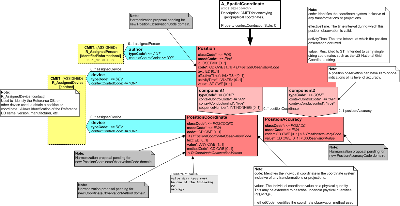
| Parent: | None |
This CMET supports the representation of geodetic as well as Cartesian coordinates related to locations. The RIM contains the single attribute of gpsText, located in the Place class, which is insufficient to represent the rich set of attributes needed to fully and unambiguously express spatial data. The scope of this CMET is constrained to representing point data and excludes support, at this time, for representing line, area or remote sensing data. It is not the intent of this CMET to replace functionality usually residing in a Geographic Information System (GIS).
The point data represented in this CMET may be auto-generated or manually derived from various spatial data sources. For example, the following technologies and methods may be used as the source of the position coordinates:
- Global Positioning System devices;
- geocoding algorithms based on a reference database of locations;
- direct digitization of existing (paper or electronic) maps;
- direct measurement of non-geodetic (i.e. strict Cartesian) coordinates, such as an area grid; and
- land based reference transmitters (e.g. LORAN-C).
When associating the A_Coordinate CMET with a Place it should be modeled as an act participating as the subject of the LocatedEntity Role being played by the Place Entity.

Diagram Walkthrough:
Position: An act with classCode Position (POS) that identifies the observation of a specific position.
- id: Unique instance identification of the position.
- code: Identifies the coordinate system inclusive of any transformations or projections. The European Petroleum Survey Group (EPSG) Geodesy Parameters will be used as the coding system for Position.code The EPSG dataset represents all Datums, coordinate references (projected and 2D geographic) and coordinate systems (including Cartesian coordinate systems) used in surveying worldwide. Each record includes a 4-8 digit unique identifier. < http://www.epsg.org/ >
- effectiveTime: The time interval during which this position observation is valid.
- activityTime: The time interval during which the position observation occurred.
- value: Restricted to ST. This attribute is intended to carry single string coordinates such as the US National Grid Coordinate string. <http://www.fgdc.gov/usng>
Each position may identify an author and a single, or list of devices by which the position was acquired.
Author: This participation allows for the optional identification of a single assigned person who is responsible for authoring the position act information.
Device: The AssignedDevice CMET is used to optionally identify the reference database and/or other device(s) used to obtain the position or the position coordinates. This allows for the identification of the reference database name, version, manufacturer and other necessary information.
PositionCoordinate: An act with classCode Position Coordinate (POSCOORD) that represents the actual coordinates of the position being described. This act is an optional component of the Position act and may repeat to support multiple coordinate measurements.
- code: identifies the individual coordinate in the coordinate system inclusive of any transformation or projections. This attribute is mandatory if Position Coordinates are being provided.
- value: the individual coordinate value as a physical quantity. This attribute is mandatory if Position Coordinates are being provided. This value attribute must be computable. The data type is constrained to PQ or may be extended to describe uncertain physical quantities using PPD<PQ>.
- methodCode: Identifies the coordinate observation method used.
PositionAccuracy: An act with classCode Position Accuracy (POSACC) that codifies the accuracy level associated with the position. This act is an optional component of the Position act. PositionAccuracy represents the closeness of the position assignment to the true position.
- code: Code system for position accuracy. An example is the South Carolina Department of Health and Environmental Control (SCDHEC) GIS Spatial Data Accuracy Tiers, which may be used as the values for PositionAccuracy.code. These tiers have been derived from the National Standard for Spatial Data Accuracy <http://www.fgdc.gov/standards/projects/FGDC-standards-projects/accuracy/part3/chapter3> as a means to categorize the accuracy of spatial data assignment utilizing a variety of tools for capturing coordinates including digitizers, geocoding software and global positioning system devices and the final identification of a positional accuracy code system and values set.
- value: Code for the accuracy.
LORAN-C Example:
A LORAN position is specified by identifying the LORAN chain used, the secondary stations, and the time difference measured on the signals from the secondary stations in relation to the chain master. These time differences are measured in microseconds. At least two secondary stations are required to fix a position.
Suppose that one is transmitting LORAN-C readings taken on the GRI 9940 chain. The time difference (TD) for the XRAY station is 28144, the TD for the YANKEE station is 41026 (this corresponds to roughly 33 degrees, 26.665 minutes N Latitude and 118 degrees, 29.826 minutes W Longitude). To represent this in the A_SpatialCoordinate CMET, one could have a Position instance whose code indicates this is the GRI 9940 LORAN-C chain. This Position instance would have two component1 relationships to represent the two PositionCoordinates. The first would have a code identifying the XRAY station, with a value.value of 28144 and value.unit "us" (microseconds). The second would have a code identifying the YANKEE station with a value.value of 41026 and value.unit of "us". Optionally the device participation of the Position would indicate the device used to obtain the LORAN-C coordinates.
| R_AssignedPersonIdentified/informational | COCT_MT090108UV |
| R_AssignedDeviceContact | COCT_MT090303UV01 |
| A_SpatialCoordinate universal | COCT_MT960000UV05 |
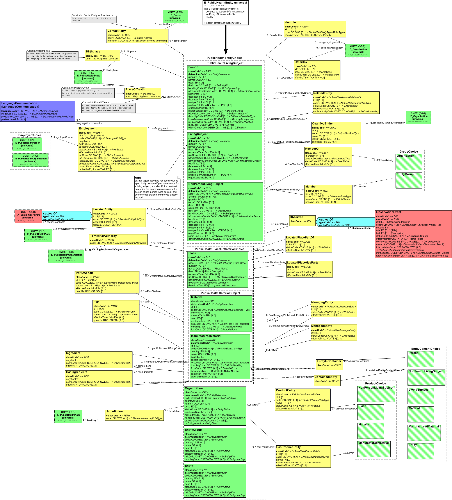
| Parent: | None |
The E_PublicHealthEntity CMET is designed to capture information regarding an entity of interest to public health. Current patient based CMETs don't come close to meeting public health's needs for identifying subjects of investigation.
The CMET has a central choice box (PublicHealthEntity) that contains Person, Place, NonPersonLivingSubject, Organization, Material, and Manufactured Material classes. This allows communication regarding virtually any "thing," including people, places, objects, vehicles, companies, clubs, animals, organisms, herds, etc. The CMET includes a number of role-based associations between entities in the PublicHealthEntity choice box, allowing a wide variety of relationships between entities to be carried. Detailed contact for the entity or a contact person for the entity is also provided. Detailed identifier information is provided for each entity using an identified role and scoping organizations for the identified role.
PublicHealthEntityChoice
The PublicHealthEntityChoice contains a choice of PublicHealthLivingSubject, PublicHealthPlaceOrMaterialChoice, Organization or Entity.
PublicHealthLivingSubject: The PublicHealthLivingSubject contains Person, LivingSubject and NonPersonLivingSubject.
Person: A person that is of interest to public health. This person may be the subject of a case or investigation.
LivingSubject: A living subject that is of interest to public health. This living subject may be the subject of a case or investigation. Living Subject is used when it is not known if the entity is a person or a non-person living subject.
NonPersonLivingSubject: A living subject, other than human being, that is of interest to public health. The non-person living subject may be the subject of a public health case or investigation.
PublicHealthPlaceOrMaterialChoice: The PublicHealthPlaceOrMaterialChoice contains Place or PublicHealthMaterialSubject.
Place: A place that is of interest to public health. The place may be the subject of a public health case or investigation. More: A physical place or site with its containing structure. May be natural or man-made. The geographic position of a place may or may not be constant.
PublicHealthMaterialSubject: The PublicHealthMaterialSubject contains Material and ManufacturedMaterial.
Material: A non-living substance that is of interest to public health. The substance may be the subject of a public health case or investigation. Note that manufactured materials are described elsewhere in the model.
ManufacturedMaterial: Any sort of artificial material, typically a manufactured item, that is of interest to public health. The artificial material may be the subject of a public health case or investigation.
Organization: An organization of interest to public health.
EntityGroup: A group of entities. This may be a formal or ad-hoc grouping of entities. The appropriate class code should be used for the purpose of creating an entity group. If determinerCode is INSTANCE then this is an instance of a group. If determinerCode is KIND then this is a kind of group. The group may be composed of any type of entity, there is no requirement that the group be of all the same type of entity. The Member role is used to associate the members of a group with the group.
Entity: An entity of interest to public health. The Entity class should only be used when the entity is not better represented by one of the other choices in the PublicHealthEntityChoice.
Roles Associated With Focal Entity
The focal entity has the following roles associating the entity with other entities.
ContactParty: Captures contact information for a person who can provide information regarding the public health entity. The role is scoped by the focal entity and played by the E_Person universal CMET.
Birthplace: Birthplace is restricted to the PublicHealthLivingSubject entity choices. Birthplace documents an entities place of birth. The entity must be a living subject (e.g., person or animal). The birthplace is scoped by the E_PublicHealthPlace universal CMET.
PlaceOfDealth: PlaceOfDeath is restricted to the PublicHealthLivingSubject entity choices. PlaceOfDeath documents an entities place of death. The entity must be a living subject (e.g., person or animal). PlaceOfDeath is scoped by the E_PublicHealthPlace universal CMET.
LanguageCommunication: LanguageCommunication is restricted to the Person entity. The language communication capabilities of Person. Examples: A patient who originally came from Mexico may have fluent language capabilities to speak, read and write in Spanish, but only rudimentary capabilities in English. A person from Russia may have the capability to communicate equally well in spoken language in Russian, Armenian or Ukrainian, but prefers to speak in Armenian.
Employment: Employment is restricted to the Person entity choice. Documents a person's role as an employee. The player of the role is the employee, the scoper is the employer. Employer is normally a person or an organization. Employment is scoped by the EmployerChoice which contains either E_PublicHealthPerson universal or E_PublicHealthOrganization universal CMETs.
LocatedEntity: Used to identify the physical presence of an entity (e.g. location of a person). Allows for nested-definitions of locations (e.g. place within a place within a place). LocatedEntity is scoped by the focal entity and played by an E_PublicHealthPlace universal CMET. The LocatedEntity may also be subject of the A_SpatialCoordinates CMET.
TerritiorialAuthority: TerritorialAuthority is restricted the Place focal entity. Relates a place entity (player) as the region over which the scoper (typically an Organization) has certain authority (jurisdiction). The TerritorialAuthority is played by focal place entity and is scoped by the E_PublicHealthOrganization universal CMET.
PartOfWhole: An association between an entity (player) and another entity (scoper) where the playing entity is considered in a "part" of the other entity, e.g. body part. This role should be used only if other roles in the model such as MBR (member), INGR (ingredient), LOCE (located entity) or CONT (content) are not appropriate. Note the model includes a 'quantity' attribute for relationships that can be quantified as a numeric ratio. The PartOfWhole is played by the focal entity and is scoped by another entity. Note that the PartOfWhole role is identical to the Part role except that it is navigated from player to scoper.
Part: An association between an entity (player) and another entity (scoper) where the playing entity is considered in a "part" of the other entity, e.g. body part. This role should be used only if other roles in the model such as MBR (member), INGR (ingredient), LOCE (located entity) or CONT (content) are not appropriate. Note the model includes a 'quantity' attribute for relationships that can be quantified as a numeric ratio. The Part is scoped by the focal entity and played by another entity. Note that the Part role is identical with the PartOfWhole role except that it is navigated from scoper to player.
Ingredient: Ingredient is restricted to the PublicHealthMaterialSubject entity choice. Relates a component (player) to a mixture (scoper). E.g., Glucose and Water are ingredients of D5W, latex may be an ingredient in a tracheal tube. Note that the INGR class code has a number of specializations including: IACT - inactive ingredient COLR - color additive FLVR - flavor ingredient PRSV - preservative STBL - stabilizer ACTI - active ingredient ACTM - active moiety ADTV - additive BASE - base Use the most appropriate class code which describes the relationship between the component (player) and the mixture (scoper). Ingredient is played by the focal entity and scoped by another material entity. Note that Ingredient is identical to the HasIngredient role except that it is navigated from player to scoper.
HasIngredient: HasIngredient is restricted to the PublicHealthMaterialSubject entity choice. Relates a component (player) to a mixture (scoper). E.g., Glucose and Water are ingredients of D5W, latex may be an ingredient in a tracheal tube. Note that the INGR class code has a number of specializations including: IACT - inactive ingredient COLR - color additive FLVR - flavor ingredient PRSV - preservative STBL - stabilizer ACTI - active ingredient ACTM - active moiety ADTV - additive BASE - base Use the most appropriate class code which describes the relationship between the component (player) and the mixture (scoper). Note that HasIngredient role is identical to the Ingredient role except that it is navigated from scoper to player.
Jurisdiction: Jurisdiction is restricted to the Organization focal entity. The Jurisdiction class associates an organization with the place it has jurisdiction over. The Jurisdiction role is scoped by the focal organization and played by the E_PublicHealthPlace universal.
HasProductEntity: HasProductEntity is restricted to the Organization focal entity. The HasProductEntity class is used to associate a product (player) with the organization (scopes) that distributes, retails, manufactures, regulates or warrants the product. The HasProduct role is scoped by the focal organization and played by an entity from the ProductChoice. HasProductEntity is identical to ProductEntity role except that it is navigated from scoper to player.
ProductEntity: ProductEntity is restricted to the ProductChoice which contains NonPersonLivingSubject, Place, Material and ManufacturedMaterial focal entities. The ProductEntity class is used to associate a product (player) with the organization (scopes) that distributes, retails, manufactures, regulates or warrants the product. ProductEntity is played by the ProductChoice focal entity and scoped by an organization. ProductEntity is identical to Has ProductEntity except that it is navigated from player to scoper.
ContainedEntity: ContainedEntity is restricted to a ManufacturedMaterial focal entity. ContainedEntity associates a container (scoper) with its content (player). This role is traversed from scoper to player. ContainedEntity is scoped by the ManufacturedMaterial focal entity and played by the EntityContentChoice which includes Person, NonPersonLivingSubject, LivingSubject, Material, ManufacturedMaterial and Entity. The ContainedEntity role is identical to the EntityInContainer role except that it is navigated from scoper to player.
EntityInContainer: EntityInContainer is restricted to the EntityContentChoice which includes Person, NonPersonLivingSubject, LivingSubject, Material, ManufacturedMaterial and Entity. EntityInContainer associates the content (player) with a container (scoper). This role is traversed from player to scoper. EntityInContainer is played by the EntityContentChoice focal entity and scoped by the ManufacturedMaterial container. The EntityInContainer role is identical to the ContainedEntity role except that it is navigated from player to scoper.
ManagedEntity: The ManagedEntity role class associates a scoping entity which either owns, holds, maintains or controls access to the playing entity. This class is traversed from the scoper to the player. ManagedEntity is scoped by the focal entity and played by another entity. The ManagedEntity role is identical to the ManagingEntity role except that it is navigated from scoper to player.
ManagingEntity: The ManagingEntity role class associates a playing entity which either owned by, hold by, maintained by or accessed through the scoping entity. This class is traversed from the player to the scoper. Depending upon jurisdiction or culture, there may be restrictions on what entities can act as owners, and what entities can be owned. The ManagingEntity role is played by the focal entity and scoped by another entity. The ManagingEntity role is identical to the ManagedEntity role except that it is navigated from player to scoper.
LocatedPlaceHasParts: The LocatedPlaceHasParts is restricted to a focal place entity. An association of a place to other places contained within it. This supports a hierarchy of places, for example a building wing (scoping entity) contains rooms (playing entity). The LocatedPlaceHasParts is scoped by the focal place and played by another place. The LocatedPlaceHasParts role is identical to the LocatedPlacePartOf role except that it is navigated from scoper to player.
LocatedPlacePartOf: The LocatedPlacePartOf is restricted to a focal place entity. An association of a place to other places that contain it. This supports a hierarchy of places, for example a bed location (playing entity) located within a room (scoping entity). The LocatedPlacePartOf is played by the focal place and scoped by another place. The LocatedPlacePartOf role is identical to the LocatedPlaceHasParts role except that it is navigated from player to scoper.
Observed: A public health entity may have additional characteristics that are describe via this role and its associated observations. The Observed role is the subject of and ObservationEvent. The observation on the associated entity to facilitate identification. This may be used to handle data like height, weight, hair color, eye color, etc.
Member: An entity may be a member of a group. Entities may be grouped together for a variety purposes ranging from formal groups (such as organizations) to informal groupings for a variety of purposes (such as all the pencils in a pencil holder). The member role is played by the entity and scoped by a group. The Member role is scoped by the focal group and played by an entity. The Member role is identical with the MemberOf role except that this role is navigated from the scoping group to the playing member entity.
MemberOf: An entity may be a member of a group. Entities may be grouped together for a variety purposes ranging from formal groups (such as organizations) to informal groupings for a variety of purposes (such as all the pencils in a pencil holder). The member role is played by the entity and scoped by a group. The MemberOf role is played by the focal entity and scoped by a group entity. The MemberOf role is identical to the Member role except that this role is navigated from the playing member entity to the scoping group.
QualifiedEntity: Documents any credentials the entity may have. The qualified role is scoped by the organization issuing the credentials. The organization is documented using the E_Organization universal CMET.
RelatedEntity: A relationship that is based on mutual behavior of the public health entity and a related party. The basis of such relationship may be agreements (e.g., spouses, contract parties) or they may be de facto behavior (e.g. friends) or may be an incidental involvement with each other (e.g. parties over a dispute, siblings, children). This is a generalized relationship model that, in a message instance, must be more narrowly defined through a combination of two coded values: one, a RIM classcode to indicate the category of the social relationship (e.g. the "personal relationship" class) and two, a role code to refine the type of relationship being reported (e.g. "sibling"). The RelatedEntity role is scoped by the focal entity and played by another entity.
OtherIDs: An identifying relationship between the focal entity and a scoping organization. Note that this could be an identifier used by the primary scoping organization in a different context. The ids carried in this role are intended to be interoperable because they are associated with a specific Role class code. The role is played by the entity and scoped by the E_Organization universal CMET.
Identifier: This role is primarily used to communicate identifiers that are not intended to be interoperable. Interoperable IDs should be carried in the OtherIDs class and associated with the appropriate Role class code. The Identifier role is played by the focal entity and scoped by the E_Organization universal CMET.
| E_PersonUniversal | COCT_MT030200UV09 |
| E_OrganizationUniversal | COCT_MT150000UV02 |
| E_OrganizationUniversal | COCT_MT150000UV02 |
| E_PublicHealthPersonUniversal | COCT_MT840200UV09 |
| E_PublicHealthPlaceUniversal | COCT_MT841300UV09 |
| E_PublicHealthPlaceUniversal | COCT_MT841300UV09 |
| E_PublicHealthPlaceUniversal | COCT_MT841300UV09 |
| E_PublicHealthOrganizationUniversal | COCT_MT841400UV09 |
| E_PublicHealthOrganizationUniversal | COCT_MT841400UV09 |
| A_SpatialCoordinateUniversal | COCT_MT960000UV05 |
| E_PublicHealthEntity universal | COCT_MT840000UV09 |
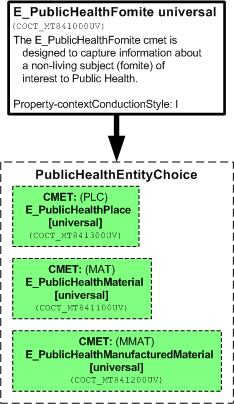
| Parent: | None |
The E_PublicHealthFomite universal CMET is a constrained version of the E_PublicHealthEntity universal CMET. The principal constraint is that the entity choice is limited to those entities which may be fomites (i.e., non-living carriers of an exposure agent). The entity choice is limited to the place, material and manufactured materials classes. See the E_PublicHealthEntity universal CMET for the detailed model walk-through.
| E_PublicHealthMaterialUniversal | COCT_MT841100UV09 |
| E_PublicHealthManufacturedMaterialUniversal | COCT_MT841200UV09 |
| E_PublicHealthPlaceUniversal | COCT_MT841300UV09 |
| E_PublicHealthFomite universal | COCT_MT841000UV09 |
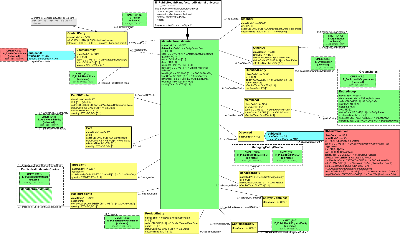
| Parent: | None |
The E_PublicHealthManufacturedMaterial universal CMET is a constrained version of the E_PublicHealthEntity universal CMET. The principal constraint is that the entity choice is limited to the manufactured material class. See the E_PublicHealthEntity universal CMET for the detailed model walk-through.
| E_PersonUniversal | COCT_MT030200UV09 |
| E_OrganizationUniversal | COCT_MT150000UV02 |
| E_OrganizationUniversal | COCT_MT150000UV02 |
| E_PublicHealthEntityUniversal | COCT_MT840000UV09 |
| E_PublicHealthPersonUniversal | COCT_MT840200UV09 |
| E_PublicHealthMaterialUniversal | COCT_MT841100UV09 |
| E_PublicHealthPlaceUniversal | COCT_MT841300UV09 |
| E_PublicHealthOrganizationUniversal | COCT_MT841400UV09 |
| E_PublicHealthOrganizationUniversal | COCT_MT841400UV09 |
| E_PublicHealthOrganizationUniversal | COCT_MT841400UV09 |
| E_PublicHealthPhysicalEntityUniversal | COCT_MT841500UV09 |
| A_SpatialCoordinateUniversal | COCT_MT960000UV05 |
| E_PublicHealthManufacturedMaterial universal | COCT_MT841200UV09 |
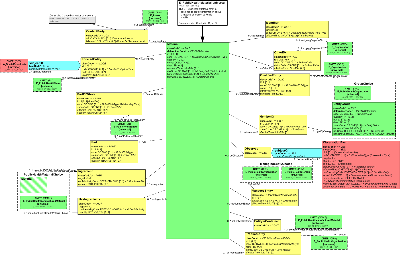
| Parent: | None |
The E_PublicHealthMaterial universal CMET is a constrained version of the E_PublicHealthEntity universal CMET. The principal constraint is that the entity choice is limited to the material class. See the E_PublicHealthEntity universal CMET for the detailed model walk-through. See the E_PublicHealthEntity universal CMET for the detailed model walk-through.
| E_PersonUniversal | COCT_MT030200UV09 |
| E_OrganizationUniversal | COCT_MT150000UV02 |
| E_OrganizationUniversal | COCT_MT150000UV02 |
| E_PublicHealthEntityUniversal | COCT_MT840000UV09 |
| E_PublicHealthPersonUniversal | COCT_MT840200UV09 |
| E_PublicHealthManufacturedMaterialUniversal | COCT_MT841200UV09 |
| E_PublicHealthManufacturedMaterialUniversal | COCT_MT841200UV09 |
| E_PublicHealthPlaceUniversal | COCT_MT841300UV09 |
| E_PublicHealthOrganizationUniversal | COCT_MT841400UV09 |
| E_PublicHealthOrganizationUniversal | COCT_MT841400UV09 |
| E_PublicHealthOrganizationUniversal | COCT_MT841400UV09 |
| A_SpatialCoordinateUniversal | COCT_MT960000UV05 |
| E_PublicHealthMaterial universal | COCT_MT841100UV09 |
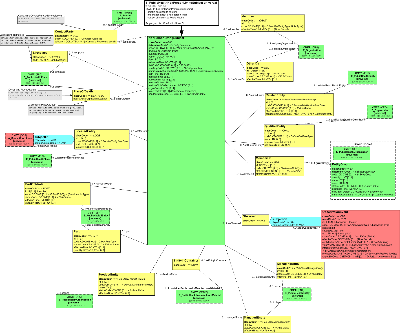
| Parent: | None |
The E_PublicHealthNonPersonLivingSubject universal CMET is a constrained version of the E_PublicHealthEntity universal CMET. The principal constraint is that the entity choice is limited to the non-person living subject class. See the E_PublicHealthEntity universal CMET for the detailed model walk-through.
| E_PersonUniversal | COCT_MT030200UV09 |
| E_OrganizationUniversal | COCT_MT150000UV02 |
| E_OrganizationUniversal | COCT_MT150000UV02 |
| E_PublicHealthEntityUniversal | COCT_MT840000UV09 |
| E_PublicHealthEntityUniversal | COCT_MT840000UV09 |
| E_PublicHealthEntityUniversal | COCT_MT840000UV09 |
| E_PublicHealthManufacturedMaterialUniversal | COCT_MT841200UV09 |
| E_PublicHealthPlaceUniversal | COCT_MT841300UV09 |
| E_PublicHealthPlaceUniversal | COCT_MT841300UV09 |
| E_PublicHealthOrganizationUniversal | COCT_MT841400UV09 |
| E_PublicHealthOrganizationUniversal | COCT_MT841400UV09 |
| A_SpatialCoordinateUniversal | COCT_MT960000UV05 |
| E_PublicHealthNonPersonLivingSubject universal | COCT_MT840100UV09 |
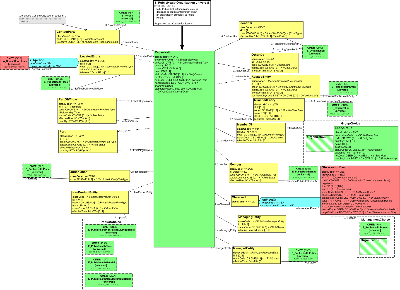
| Parent: | None |
The E_PublicHealthOrganization universal CMET is a constrained version of the E_PublicHealthEntity universal CMET. The principal constraint is that the entity choice is limited to the organization class. See the E_PublicHealthEntity universal CMET for the detailed model walk-through.
| E_PersonUniversal | COCT_MT030200UV09 |
| E_OrganizationUniversal | COCT_MT150000UV02 |
| E_OrganizationUniversal | COCT_MT150000UV02 |
| E_PublicHealthEntityUniversal | COCT_MT840000UV09 |
| E_PublicHealthEntityUniversal | COCT_MT840000UV09 |
| E_PublicHealthEntityUniversal | COCT_MT840000UV09 |
| E_PublicHealthNonPersonLivingSubjectUniversal | COCT_MT840100UV09 |
| E_PublicHealthPersonUniversal | COCT_MT840200UV09 |
| E_PublicHealthMaterialUniversal | COCT_MT841100UV09 |
| E_PublicHealthManufacturedMaterialUniversal | COCT_MT841200UV09 |
| E_PublicHealthPlaceUniversal | COCT_MT841300UV09 |
| E_PublicHealthPlaceUniversal | COCT_MT841300UV09 |
| E_PublicHealthPlaceUniversal | COCT_MT841300UV09 |
| A_SpatialCoordinateUniversal | COCT_MT960000UV05 |
| E_PublicHealthOrganization universal | COCT_MT841400UV09 |
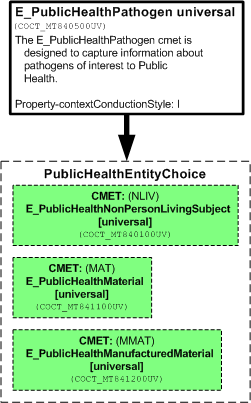
| Parent: | None |
The E_PublicHealthPathogen universal CMET is a constrained version of the E_PublicHealthEntity universal CMET. The principal constraint is that the entity choice is limited to those entities that can be considered exposure agents (pathogens). See the E_PublicHealthEntity universal CMET for the detailed model walk-through.
| E_PublicHealthNonPersonLivingSubjectUniversal | COCT_MT840100UV09 |
| E_PublicHealthMaterialUniversal | COCT_MT841100UV09 |
| E_PublicHealthManufacturedMaterialUniversal | COCT_MT841200UV09 |
| E_PublicHealthPathogen universal | COCT_MT840500UV07 |
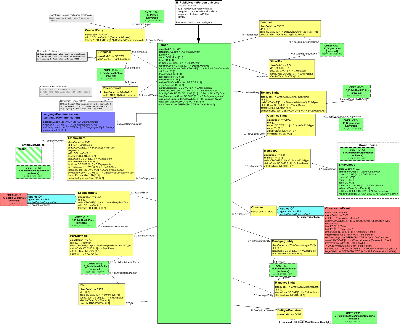
| Parent: | None |
The E_PublicHealthPerson universal CMET is a constrained version of the E_PublicHealthEntity universal CMET. The principal constraint is that the entity choice is limited to the person class. See the E_PublicHealthEntity universal CMET for the detailed model walk-through.
| E_PersonUniversal | COCT_MT030200UV09 |
| E_OrganizationUniversal | COCT_MT150000UV02 |
| E_OrganizationUniversal | COCT_MT150000UV02 |
| E_PublicHealthEntityUniversal | COCT_MT840000UV09 |
| E_PublicHealthEntityUniversal | COCT_MT840000UV09 |
| E_PublicHealthEntityUniversal | COCT_MT840000UV09 |
| E_PublicHealthManufacturedMaterialUniversal | COCT_MT841200UV09 |
| E_PublicHealthPlaceUniversal | COCT_MT841300UV09 |
| E_PublicHealthPlaceUniversal | COCT_MT841300UV09 |
| E_PublicHealthOrganizationUniversal | COCT_MT841400UV09 |
| E_PublicHealthOrganizationUniversal | COCT_MT841400UV09 |
| A_SpatialCoordinateUniversal | COCT_MT960000UV05 |
| E_PublicHealthPerson universal | COCT_MT840200UV09 |
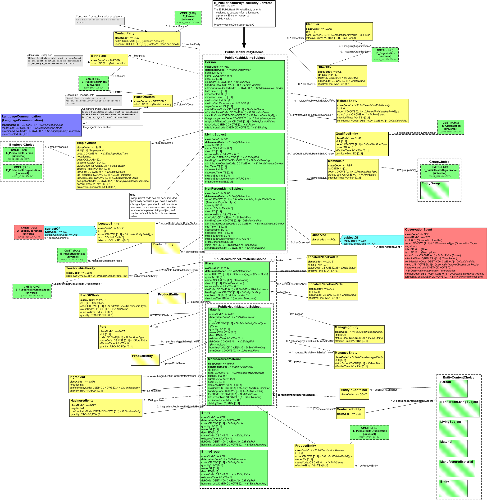
| Parent: | None |
The E_PublicHealthPhysicalEntity universal CMET is a constrained version of the E_PublicHealthEntity universal CMET. The principal constraint is that the entity choice excludes the organization class, leaving only physical entities. See the E_PublicHealthEntity universal CMET for the detailed model walk-through.
| E_PersonUniversal | COCT_MT030200UV09 |
| E_OrganizationUniversal | COCT_MT150000UV02 |
| E_OrganizationUniversal | COCT_MT150000UV02 |
| E_PublicHealthPersonUniversal | COCT_MT840200UV09 |
| E_PublicHealthPlaceUniversal | COCT_MT841300UV09 |
| E_PublicHealthPlaceUniversal | COCT_MT841300UV09 |
| E_PublicHealthOrganizationUniversal | COCT_MT841400UV09 |
| E_PublicHealthOrganizationUniversal | COCT_MT841400UV09 |
| E_PublicHealthOrganizationUniversal | COCT_MT841400UV09 |
| E_PublicHealthOrganizationUniversal | COCT_MT841400UV09 |
| A_SpatialCoordinateUniversal | COCT_MT960000UV05 |
| E_PublicHealthPhysicalEntity universal | COCT_MT841500UV09 |
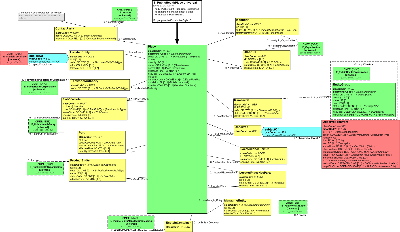
| Parent: | None |
The E_PublicHealthPlace universal CMET is a constrained version of the E_PublicHealthEntity universal CMET. The principal constraint is that the entity choice is limited to the place class. See the E_PublicHealthEntity universal CMET for the detailed model walk-through.
| E_PersonUniversal | COCT_MT030200UV09 |
| E_OrganizationUniversal | COCT_MT150000UV02 |
| E_PublicHealthEntityUniversal | COCT_MT840000UV09 |
| E_PublicHealthEntityUniversal | COCT_MT840000UV09 |
| E_PublicHealthManufacturedMaterialUniversal | COCT_MT841200UV09 |
| E_PublicHealthOrganizationUniversal | COCT_MT841400UV09 |
| E_PublicHealthOrganizationUniversal | COCT_MT841400UV09 |
| E_PublicHealthOrganizationUniversal | COCT_MT841400UV09 |
| A_SpatialCoordinateUniversal | COCT_MT960000UV05 |
| E_PublicHealthPlace universal | COCT_MT841300UV09 |
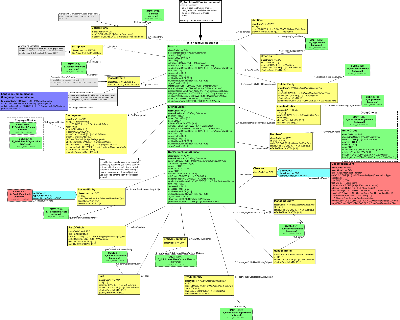
| Parent: | None |
The E_PublicHealthVector universal CMET is a constrained version of the E_PublicHealthEntity universal CMET. The principal constraint is that the entity choice is limited to those entities which may be vectors (i.e., living carriers of an exposure agent). The entity choice is limited to the person or non-person living subject classes. See the E_PublicHealthEntity universal CMET for the detailed model walk-through.
| E_PersonUniversal | COCT_MT030200UV09 |
| E_OrganizationUniversal | COCT_MT150000UV02 |
| E_OrganizationUniversal | COCT_MT150000UV02 |
| E_PublicHealthEntityUniversal | COCT_MT840000UV09 |
| E_PublicHealthEntityUniversal | COCT_MT840000UV09 |
| E_PublicHealthEntityUniversal | COCT_MT840000UV09 |
| E_PublicHealthPersonUniversal | COCT_MT840200UV09 |
| E_PublicHealthManufacturedMaterialUniversal | COCT_MT841200UV09 |
| E_PublicHealthPlaceUniversal | COCT_MT841300UV09 |
| E_PublicHealthPlaceUniversal | COCT_MT841300UV09 |
| E_PublicHealthOrganizationUniversal | COCT_MT841400UV09 |
| E_PublicHealthOrganizationUniversal | COCT_MT841400UV09 |
| E_PublicHealthOrganizationUniversal | COCT_MT841400UV09 |
| A_SpatialCoordinateUniversal | COCT_MT960000UV05 |
| E_PublicHealthVector universal | COCT_MT840300UV09 |
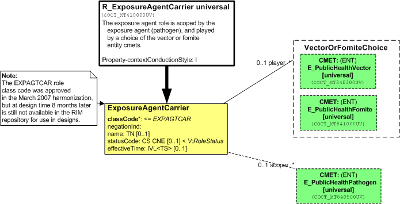
| Parent: | None |
Model Overview for R_ExposureAgentCarrier universal
The R_ExposureAgentCarrier universal CMET carries information regarding the carrier of an exposure agent (pathogen). The role is played by either a vector or a fomite. The role is scoped by the exposure agent (pathogen).
ExposureAgentCarrier: The ExposureAgentCarrier role is played by an entity that is either a living subject (vector) or a non-living material (fomite). The role is scoped by the exposure agent entity.
| E_PublicHealthVectorUniversal | COCT_MT840300UV09 |
| E_PublicHealthPathogenUniversal | COCT_MT840500UV07 |
| E_PublicHealthFomiteUniversal | COCT_MT841000UV09 |
| R_ExposureAgentCarrier universal | COCT_MT410000UV07 |
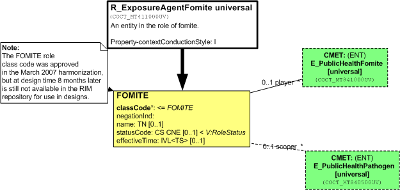
| Parent: | None |
Model Overview for R_ExposureAgentFomite
The R_ExposureAgentFomite universal CMET is a constrained version of the R_ExposureAgentCarrier universal CMET. It carries information regarding the carrier of an exposure agent (pathogen). The role is played by a fomite. The role is scoped by the exposure agent (pathogen).
Fomite: The Fomite role is played by an non-living subject entity. The role is scoped by the exposure agent entity.
| E_PublicHealthPathogenUniversal | COCT_MT840500UV07 |
| E_PublicHealthFomiteUniversal | COCT_MT841000UV09 |
| R_ExposureAgentFomite universal | COCT_MT411000UV07 |
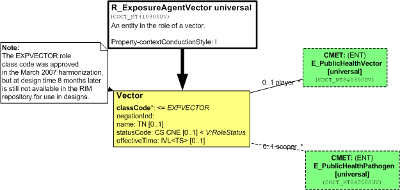
| Parent: | None |
Model Overview for R_ExposureAgentVector
The R_ExposureAgentVector universal CMET is a constrained version of the R_ExposureAgentCarrier universal CMET. It carries information regarding the carrier of an exposure agent (pathogen). The role is played by a vector. The role is scoped by the exposure agent (pathogen).
Vector: The Vector role is played by an living subject entity. The role is scoped by the exposure agent entity.
| E_PublicHealthVectorUniversal | COCT_MT840300UV09 |
| E_PublicHealthPathogenUniversal | COCT_MT840500UV07 |
| R_ExposureAgentVector universal | COCT_MT410300UV07 |
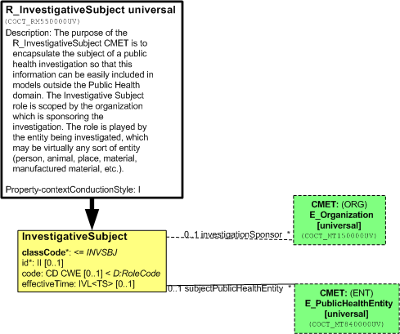
| Parent: | None |
The purpose of the R_InvestigativeSubject CMET is to encapsulate the subject of a public health investigation so that this information can be easily included in models outside the Public Health domain. The Investigative Subject role is scoped by the organization which is sponsoring the investigation. The role is played by the entity being investigated, which may be virtually any sort of entity (person, animal, place, material, manufactured material, etc).
Model Walkthrough
InvestigativeSubject: A role with the Investigation Subject (INVSBJ) class code. The InvestigativeSubject Role class documents an entity which is the subject of an investigation. The role is played by the E_PublicHealthEntity CMET, which allows virtually any entity to the be subject of investigation. The role is scoped by the E_Organization CMET. This will be the organization sponsoring the investigation, and is also the organization assigning the InvestigativeSubject.id
- id: This is the id of the subject of the investigation. The id issuer should be the scoper of this role. The id is required and constrained to a single identifier.
- code: A code the further characterizes the type of investigative subject. The code is an optional attribute.
- effectiveTime: This the interval of time for which the playing entity is a subject of investigation. Note that in the case of an ongoing investigation, the interval of time may only have a beginning time stamp. The effectiveTime is an optional attribute.
investigationSponsor: The InvestigativeSubject Role is scoped by the investigationSponsor which is an organization represented in the model by the E_Organization universal CMET. The scoper of the InvestigativeSubject role should be the issuer of the InvestigativeSubject. id. See the E_Organization universal CMET for additional information.
subjectPublicHealthEntity: The InvestigativeSubject role is played by the subjectPublicHealthEntity which is an entity represented in the model by the E_PublicHealthEntiy universal CMET. See the E_PublicHealthEntity universal CMET for additional information.
| E_OrganizationUniversal | COCT_MT150000UV02 |
| E_PublicHealthEntityUniversal | COCT_MT840000UV09 |
| R_InvestigativeSubject universal | COCT_MT550000UV07 |
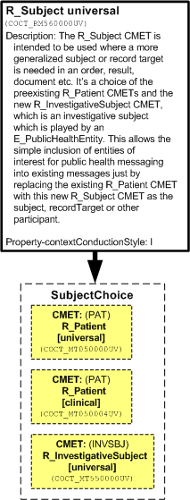
| Parent: | None |
The R_Subject CMET is intended to be used where a more generalized subject or record target is needed in an order, result, document etc. It's a choice of the preexisting R_Patient CMETs and the R_InvestigativeSubject CMET. This allows the simple inclusion of entities of interest for public health messaging into existing messages just by replacing the existing R_Patient CMET with the R_Subject CMET as the subject, recordTarget or other participant.
Model Walkthrough
SubjectChoice: A choice of role based CMET's including the following:
- R_Patient universal: Used to identify a patient. See the R_Patient universal CMET for additional information.
- R_PatientClinical universal: Used to identify a patient along with providing relevant clinical information regarding the patient. See the R_PatientClinical universal CMET for additional information
- R_InvestigativeSubject universal: Used to identify the subject of an investigation. See the R_InvestigativeSubject universal CMET for additional information.
| R_PatientUniversal | COCT_MT050000UV01 |
| R_PatientClinical | COCT_MT050004UV01 |
| R_InvestigativeSubjectUniversal | COCT_MT550000UV07 |
| R_Subject universal | COCT_MT560000UV07 |
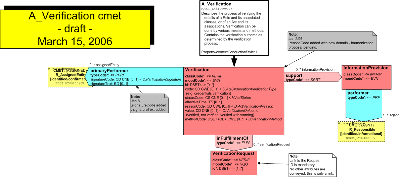
| Parent: | Personnel Management (PRPM_DM000000UV) |
This cmet describes the process of verifying the details of a Role and its associated classes, or of an Act and its associations. The model supports description of means and methods of verification and the outcome of the process. Neither the Role not the Act subject is included in this model but is assumed to be present in the domain model in which the cmet is used.
-
Verification: An act that identifies the verification event. The verification process and results are described through classes associated with this Act. Verification is the activity of confirming the existence and characteristics of a Role (usu. attested to by a Credential or other token), or of an Act and its dependent associations.
Attributes
-
id: identifier for the verification event
-
code: code identifying the type of verification. The ActVerificationTypeCode domain covers concepts such as:
-
Verification of eligibility for coverage under a policy or program - aka enrolled/covered by a policy or program
-
Verification of record - e.g., person has record in an immunization registry
-
Verification of enumeration - e.g. NPI
-
Verification of Board Certification - provider specific
-
Verification of Certification - e.g. JAHCO, NCQA, URAC
-
Verification of Conformance - e.g. entity use with HIPAA, conformant to the CCHIT EHR system criteria
-
Verification of Provider Credentials
-
Verification of no adverse findings - e.g. on National Provider Data Bank, Health Integrity Protection Data Base (HIPDB)
-
-
effectiveTime: time of the verification event
inFullfillmentOf Act Relationship: This relationship associates a verification event with zero to many VerificationRequests.
PrimaryPerformer Participation: The person, organization or device that actually performed the verification, and the organization they represent, are identified via this participation.
Support Act Relationship: A verification act can have optional corroborating information (an InformationProvision act) supplied by a performing person, organization or device.
-
-
InformationProvision: an act describing the provision of corroborating information. The model does not include any descriptive attributes for this act, apart from identifying the performer. The performer participation is therefore 'Required'.
Performer Participation: identifies the party (R_Responsible) that supplied the corroborating information.
-
R_Responsible Identified/Informational (cmet): The R_Responsible cmet describes the agent that supplied supporting information for the verification process. This version of the cmet has a mandatory id for the agent role, which normally will be known to sender and receiver of a message. However, some optional descriptive information about the player and scoper of the role are supported in the cmet. An agent can be a Person, Organization or a Device.
-
VerificationRequest: An act identifying a request for verification. Apart from an event identifier the particulars of the request are not supported in this model. A single verification event can fulfill multiple verification requests.
Attributes:
-
id: identifier(s) for the verification request
-
-
VerificationResult:
Attributes:
-
code: identifies the observation act as a Verification result via the VerificationResultType domain
o/s action item for PM to submit proposal for new domain, VerificationResultType. May require further specializations eg. 'AdministrativeVerification', and if so the domain in the model will be changed.
-
value: coded value for actual outcome of the verification process e.g. 'verified', 'not verified', 'verified with warning'
value attribute constrained to CE datatype to meet known requirements. o/s action item for PM to submit proposal for new domain, VerificationOutcome, as a a specialization of ObservationValue.
-
methodcode: identifies the method by which the results were obtained e.g. 'cardreader'. Usage note: this observation does not directly support any information about who/what obtained the results. Implementers requiring data about the source of the observation(s) must constrain the model to require the InformationProvision act and associated R_Responsible party.
o/s action item for FM committee to submit domain definition for VerificationMethod: Suggested def'n: "method by which information is obtained to determine the factualness of a subject Act or Role"
SubjectOf Act Relationship: Associates the Observation reporting the verification results with Verification event. Note that there can be only one Verification Result.
-
-
R_AssignedEntity (cmet): The assigned entity cmet describes the primary performer of the verification. This version (COCT_MT090002) of the R_AssignedEntity cmet contains only minimal attributes for identifying a known role, the entity playing the role (person, organization or device) and the organization that scopes the role.
o/s action item for PM to reconcile this cmet to PRPM DMIM
| R_ResponsibleIdentified/informational | COCT_MT040008UV |
| R_AssignedEntityIdentified/confirmable | COCT_MT090002UV01 |
| A_Verification universal | COCT_MT810000UV |
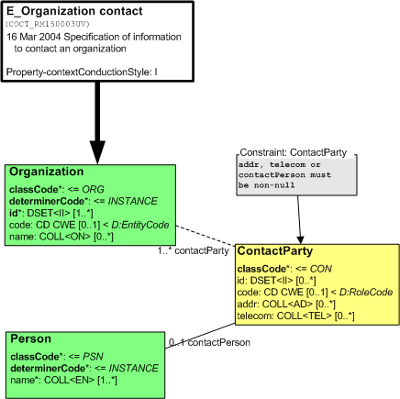
| Parent: | Personnel Management (PRPM_DM000000UV) |
This CMET is used to identifiy an organization.
This is the contact variant of E_Organization universal.
| E_Organization contact | COCT_MT150003UV03 |
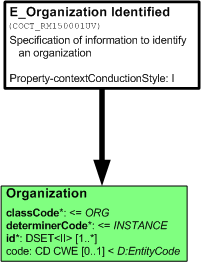
| Parent: | Personnel Management (PRPM_DM000000UV) |
This CMET is used to identifiy an organization.
This is the identified variant of E_Organization universal.
| E_Organization identified | COCT_MT150001UV01 |
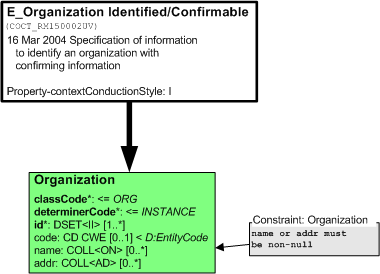
| Parent: | Personnel Management (PRPM_DM000000UV) |
This CMET is used to identifiy an organization.
This is the identified-confirmable variant of E_Organization universal.
| E_Organization identified-confirmable | COCT_MT150002UV01 |
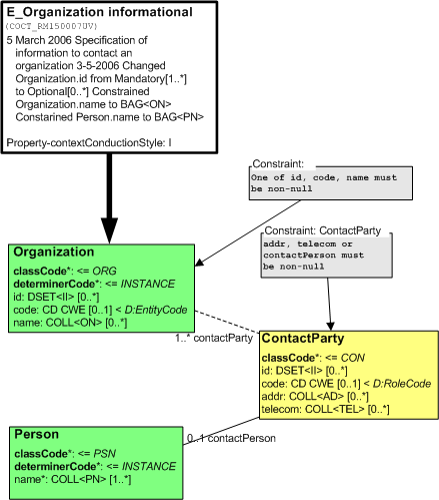
| Parent: | Personnel Management (PRPM_DM000000UV) |
This is the informational variant of E_Organization universal.
| E_Organization informational | COCT_MT150007UV |
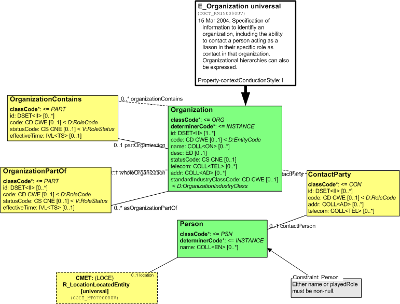
| Parent: | Personnel Management (PRPM_DM000000UV) |
Specification of information about the entity organization, a system of legally-enabled interconnections between principals. Provides enough information to contact an individual person acting as a liaison in their specific role as contact for a particular organization.
| R_LocationLocatedEntityUniversal | COCT_MT070000UV01 |
| E_Organization universal | COCT_MT150000UV02 |
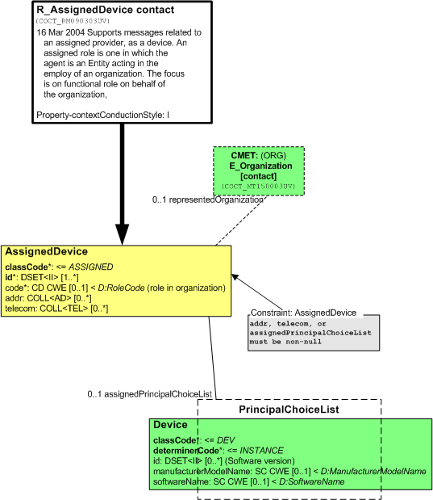
| Parent: | Personnel Management (PRPM_DM000000UV) |
The CMET is used to identify an assigned device.
This is the contact variant of R_AssignedDevice universal
| E_OrganizationContact | COCT_MT150003UV03 |
| R_AssignedDevice contact | COCT_MT090303UV01 |
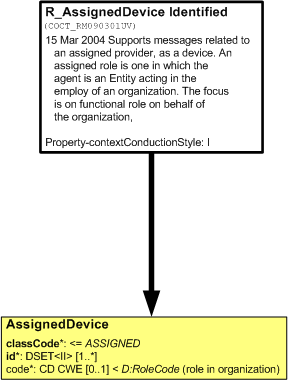
| Parent: | Personnel Management (PRPM_DM000000UV) |
The CMET is used to identify an assigned device.
This is the identified variant of R_AssignedDevice universal
| R_AssignedDevice identified | COCT_MT090301UV01 |
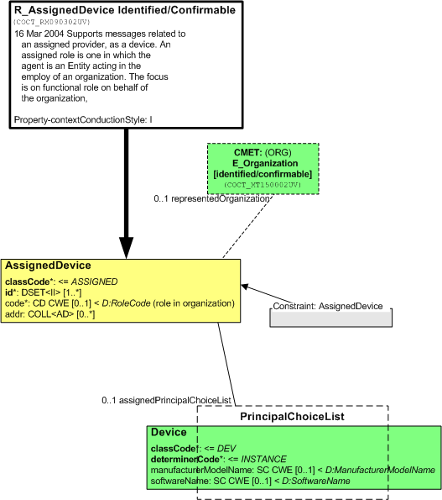
| Parent: | Personnel Management (PRPM_DM000000UV) |
This CMET is used to identified an assigned device.
This is the identified-confirmable variant of R_AssignedDevice universal
| E_OrganizationIdentified/confirmable | COCT_MT150002UV01 |
| R_AssignedDevice identified-confirmable | COCT_MT090302UV01 |
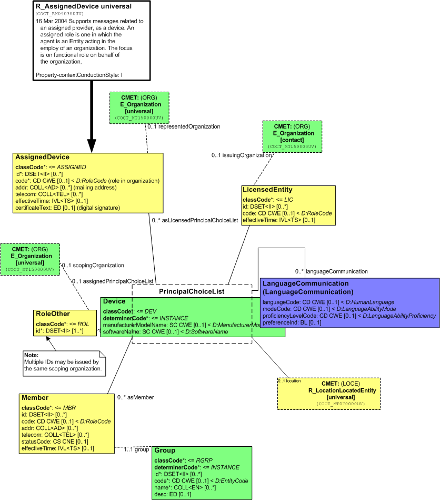
| Parent: | Personnel Management (PRPM_DM000000UV) |
This is the universal variant of the R_AssignedDevice CMET.
The CMET is used to identify an assigned device. The CMET also restricts R_AssignedEntity universal by specializing the entity choice to a device.
| R_LocationLocatedEntityUniversal | COCT_MT070000UV01 |
| E_OrganizationUniversal | COCT_MT150000UV02 |
| E_OrganizationUniversal | COCT_MT150000UV02 |
| E_OrganizationContact | COCT_MT150003UV03 |
| R_AssignedDevice universal | COCT_MT090300UV01 |
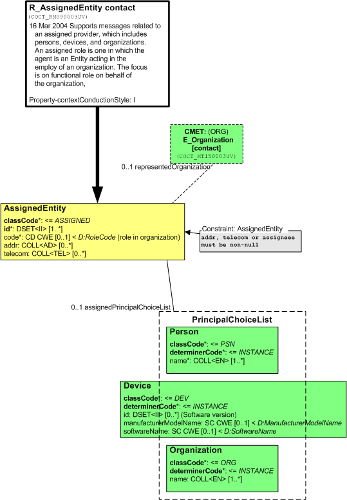
| Parent: | Personnel Management (PRPM_DM000000UV) |
This CMET is used to identifiy information about an entity -- person, organization or device -- that is assigned to a particular responsibility within the context of an HL7 message.
This is the contact variant of R_AssignedEntity universal.
| E_OrganizationContact | COCT_MT150003UV03 |
| R_AssignedEntity contact | COCT_MT090003UV01 |
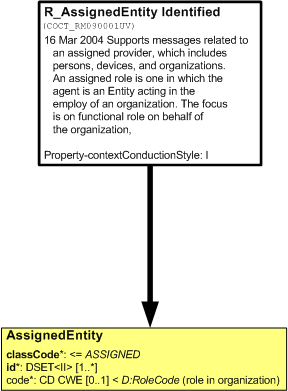
| Parent: | Personnel Management (PRPM_DM000000UV) |
This CMET is used to identifiy information about an entity -- person, organization or device -- that is assigned to a particular responsibility within the context of an HL7 message.
This is the identified variant of R_AssignedEntity universal.
| R_AssignedEntity identified | COCT_MT090001UV01 |
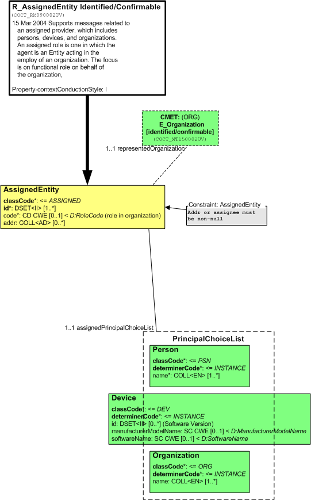
| Parent: | Personnel Management (PRPM_DM000000UV) |
This CMET is used to identifiy information about an entity -- person, organization or device -- that is assigned to a particular responsibility within the context of an HL7 message.
This is the identified-confirmable variant of R_AssignedEntity universal.
| E_OrganizationIdentified/confirmable | COCT_MT150002UV01 |
| R_AssignedEntity identified-confirmable | COCT_MT090002UV01 |
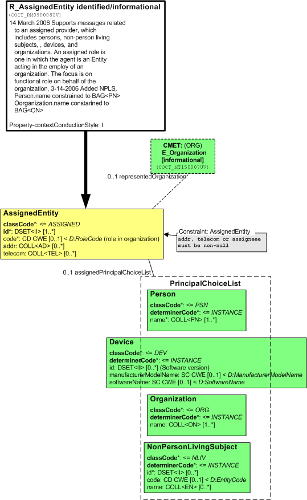
| Parent: | Personnel Management (PRPM_DM000000UV) |
This is the identified/informational variant of R_AssignedEntity universal.
| E_OrganizationInformational | COCT_MT150007UV |
| R_AssignedEntity identified-informational | COCT_MT090008UV |
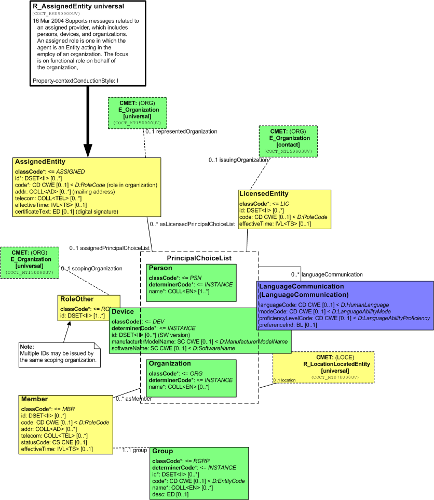
| Parent: | Personnel Management (PRPM_DM000000UV) |
R_Responsible and R_Assigned Entity Refined Message Information Model
The Responsible Entity and the Assigned Entity CMET are both used to capture information about an entity -- person, organization or device -- that is assigned to a particular responsibility within the context of an HL7 message.
R_Responsible vs. R_Assigned: The principal difference between R_Responsible and R_Assigned is that with the former, the role is that of agent, and any entity can be the scoper, but with the latter, the scoper is constrained to be an organization. Thus R_Assigned is a constrained version of R_Responsible.
From the RIM definition, an assigned role is an agent role in which the agent is an Entity acting in the employ of an organization. The focus is on the functional role performed on behalf of the organization, unlike the Employee role where the focus is on the 'Human Resources' relationship between the employee and the organization.
A major use case is for an institution-wide (or organization-wide) role (and the corresponding role attributes, especially the role.ID, which will be the institution-wide identifier). This will support such roles as "staff member", "staff physician", "contracted physician", "contracted nurse", etc. This single role is used for all transactions (interactions) within the institution. For example, at "University Medical Center", Dr. Jones will have a "staff ID number". All acts in which Dr. Jones participates will use the assignedEntity role instance (for which the Role.ID is his "University Medical Center" "staff ID number" to document his participation. Documenting his participations in this manner allows Dr. Jones to have a single Id that he uses within that institution, and also allows the computer applications to easily aggregate any or all acts in which he participates for any particular application reason.
This transaction-related role is not to be confused with the employment relationship the entity has with the organization. Employment relationship examples are full-time, part-time, contracted, temporary, probationary..
It is assumed that the application creating each act will validate Dr. Jones permissions to participate in that act, but it is not necessary to create a new role instance for each of Dr. Jones' permissions (or groups of same). Nor is it necessary to transmit those permissions with each act instance. The receiving application can, if necessary, use Dr. Jones' "staff ID number/assignedEntity role" to validate that he had the necessary permissions to participate in a particular act instance.
Note that the assignedEntity role is distinct from the Personnel Management concepts of position and assignment.
-
Position is an act used to define a named, identified collection of Responsibilities (including Privileges).
-
The Personnel Management concept of assignment is modeled by the participation of a staff member in an act that is an instance of a particular (pre-defined) Position (with its' associated Responsibilities and/or Privileges).
-
Thus, even in Personnel Management, this same single instance of assignedEntity role (with the corresponding institution-wide identifier) can be used.
The following discussion reviews key elements within the CMET:
-
Assigned Entity (role): The role class, assigned entity, captures the critical information of the party playing the role in question. This includes an identifier for the role, mailing address, phone number, and the time within which the role is played. The model identifies zero to one parties playing the role. This supports the case in which information directly related to the playing party is not needed. The role player is captured as a choice of either a person, device or organization. The role is scoped by zero to one organizations. The scoping organization - which like the role player may be omitted if not needed, provides the organizational context for the entity that actually plays the role. For example, the role scoper will normally be the party that assigns the identifier for the role.
-
Entity Choice: As previously noted, the role of assigned entity can be played by either a person, organization or device. At this point, minimal information is captured for each. The reader should also note that it is possible to capture language information for the person, and to identify the location (as shown by the Located Entity CMET) at which the role is generally played.
-
Credentialing (role): The assigned entity may have zero to many credentialing roles. Credentialing captures information for licenses or credentials that may be relevant, and that have been issued to the assigned entity. It is also possible to identify the organization that issued the credential, i.e., the scoping organization.
-
Other Role: The assigned entity may play zero to many other roles. The other role structure makes it possible to capture a list of roles that the entity plays. The scoping organization is also included for these roles.
-
Member (role): The assigned entity may belong to zero to many groups. Information related to the party's membership, and to the group itself is captured.
| R_LocationLocatedEntityUniversal | COCT_MT070000UV01 |
| E_OrganizationUniversal | COCT_MT150000UV02 |
| E_OrganizationUniversal | COCT_MT150000UV02 |
| E_OrganizationContact | COCT_MT150003UV03 |
| R_AssignedEntity universal | COCT_MT090000UV01 |
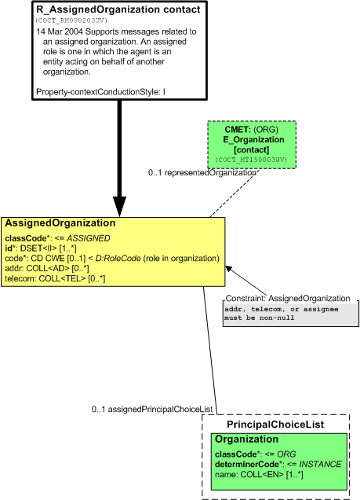
| Parent: | Personnel Management (PRPM_DM000000UV) |
This CMET is used to identified an assigned organization
This is the contact variant of R_AssignedOrganization universal
| E_OrganizationContact | COCT_MT150003UV03 |
| R_AssignedOrganization contact | COCT_MT090203UV01 |
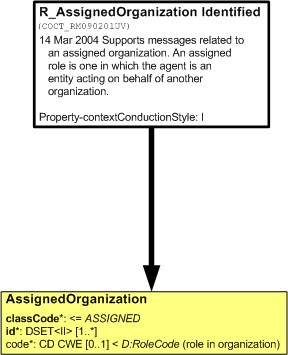
| Parent: | Personnel Management (PRPM_DM000000UV) |
The CMET is used to identify an assigned organization.
This is the identified variant of R_AssignedOrganization universal
| R_AssignedOrganization identified | COCT_MT090201UV01 |
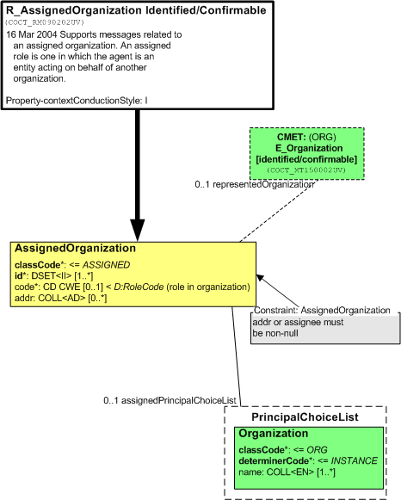
| Parent: | Personnel Management (PRPM_DM000000UV) |
The CMET is used to identify an assigned organization.
This is the identified-confirmable variant of R_AssignedOrganization universal
| E_OrganizationIdentified/confirmable | COCT_MT150002UV01 |
| R_AssignedOrganization identified-confirmable | COCT_MT090202UV01 |
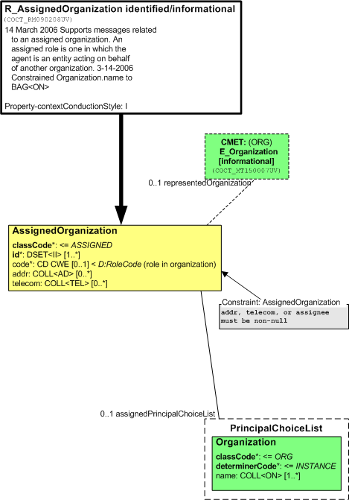
| Parent: | Personnel Management (PRPM_DM000000UV) |
This is the identified/informational variant of R_AssignedOrganization universal.
| E_OrganizationInformational | COCT_MT150007UV |
| R_AssignedOrganization identified-informational | COCT_MT090208UV |
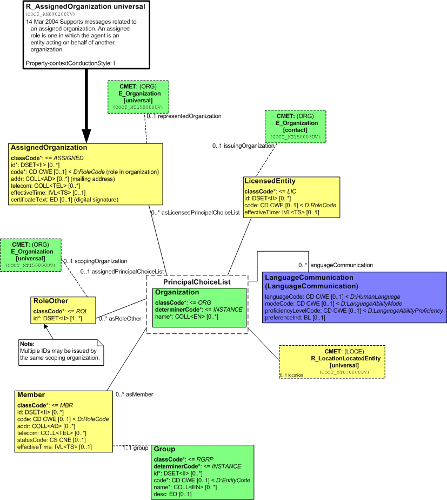
| Parent: | Personnel Management (PRPM_DM000000UV) |
This is the universal variant of the R_AssignedOrganization CMET.
The CMET is used to identify an assigned organization. The CMET also restricts R_AssignedEntity universal by specializing the entity choice to an organization.
| R_LocationLocatedEntityUniversal | COCT_MT070000UV01 |
| E_OrganizationUniversal | COCT_MT150000UV02 |
| E_OrganizationUniversal | COCT_MT150000UV02 |
| E_OrganizationContact | COCT_MT150003UV03 |
| R_AssignedOrganization universal | COCT_MT090200UV01 |
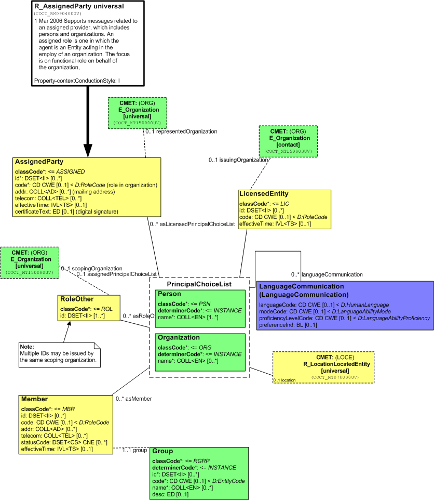
| Parent: | Personnel Management (PRPM_DM000000UV) |
This is the universal variant of the R_AssignedParty CMET.
The CMET is used to identify an assigned party. The CMET also restricts R_AssignedEntity universal by specializing the entity choice to a person or organization.
| R_LocationLocatedEntityUniversal | COCT_MT070000UV01 |
| E_OrganizationUniversal | COCT_MT150000UV02 |
| E_OrganizationUniversal | COCT_MT150000UV02 |
| E_OrganizationContact | COCT_MT150003UV03 |
| R_AssignedParty universal | COCT_MT090400UV |
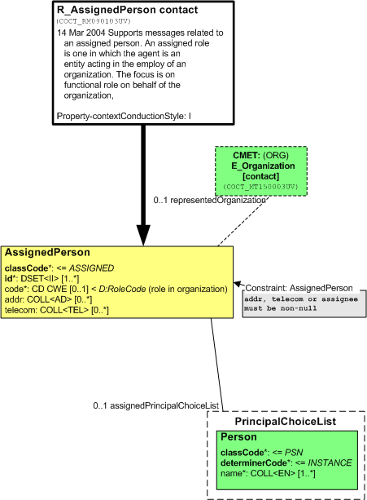
| Parent: | Personnel Management (PRPM_DM000000UV) |
The CMET is used to identify an assigned person.
This is the contact variant of R_AssignedPerson universal
| E_OrganizationContact | COCT_MT150003UV03 |
| R_AssignedPerson contact | COCT_MT090103UV01 |
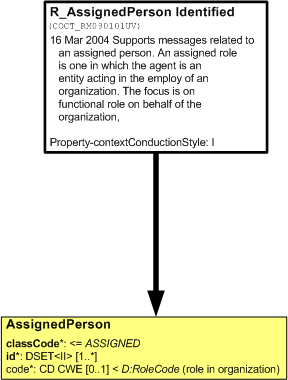
| Parent: | Personnel Management (PRPM_DM000000UV) |
The CMET is used to identify an assigned person.
This is the identified variant of R_AssignedPerson universal
| R_AssignedPerson identified | COCT_MT090101UV01 |
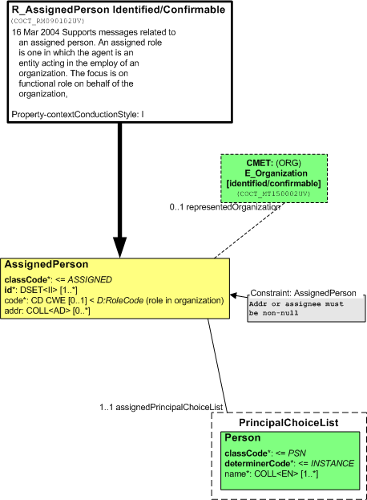
| Parent: | Personnel Management (PRPM_DM000000UV) |
The CMET is used to identify an assigned person.
This is the identified-confirmable variant of R_AssignedPerson universal
| E_OrganizationIdentified/confirmable | COCT_MT150002UV01 |
| R_AssignedPerson identified-confirmable | COCT_MT090102UV02 |
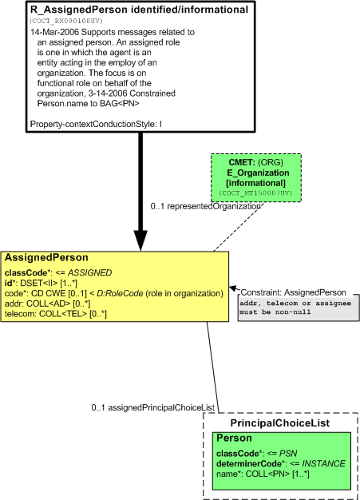
| Parent: | Personnel Management (PRPM_DM000000UV) |
This is the identified/informational variant of R_AssignedPerson universal.
| E_OrganizationInformational | COCT_MT150007UV |
| R_AssignedPerson identified-informational | COCT_MT090108UV |
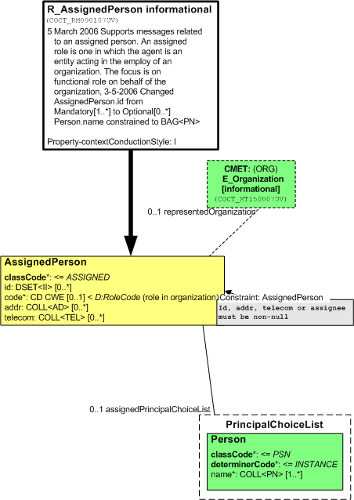
| Parent: | Personnel Management (PRPM_DM000000UV) |
This is the informational variant of R_AssignedPerson universal.
| E_OrganizationInformational | COCT_MT150007UV |
| R_AssignedPerson informational | COCT_MT090107UV |
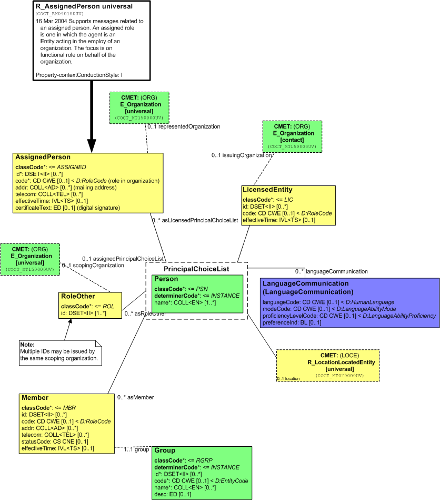
| Parent: | Personnel Management (PRPM_DM000000UV) |
This is the universal variant of the R_AssignedPerson CMET.
The CMET is used to identify an assigned person. The CMET also restricts R_AssignedEntity universal by specializing the entity choice to a person.
| R_LocationLocatedEntityUniversal | COCT_MT070000UV01 |
| E_OrganizationUniversal | COCT_MT150000UV02 |
| E_OrganizationUniversal | COCT_MT150000UV02 |
| E_OrganizationContact | COCT_MT150003UV03 |
| R_AssignedPerson universal | COCT_MT090100UV01 |
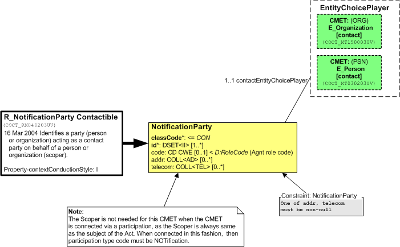
| Parent: | Personnel Management (PRPM_DM000000UV) |
This CMET Identifies a party (person or organization) acting as a contact party on behalf of a person or organization (scoper).
This is the contact variant of the R_ResponsibleParty universal CMET, but additionally constrains the role to that of contact. Contrast to R_ResponsibleParty contact where the role is not constrained.
| E_PersonContact | COCT_MT030203UV07 |
| E_OrganizationContact | COCT_MT150003UV03 |
| R_NotificationParty contact | COCT_MT040203UV09 |
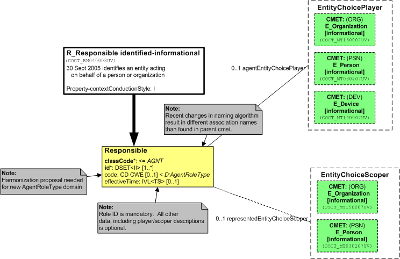
| Parent: | Personnel Management (PRPM_DM000000UV) |
This is the identified/informational variant of R_Responsible universal.
| E_PersonInformational | COCT_MT030207UV07 |
| E_PersonInformational | COCT_MT030207UV07 |
| E_DeviceInformational | COCT_MT140007UV |
| E_OrganizationInformational | COCT_MT150007UV |
| E_OrganizationInformational | COCT_MT150007UV |
| R_Responsible identified-informational | COCT_MT040008UV |
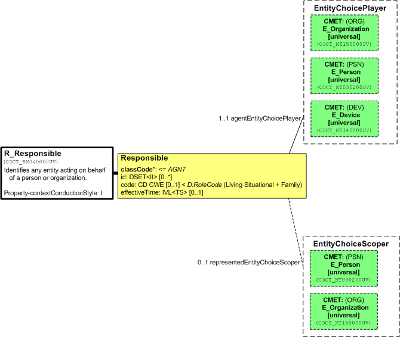
| Parent: | Personnel Management (PRPM_DM000000UV) |
R_Responsible and R_Assigned Entity Refined Message Information Model
The Responsible Entity and the Assigned Entity CMET are both used to capture information about an entity -- person, organization or device -- that is assigned to a particular responsibility within the context of an HL7 message.
R_Responsible vs. R_Assigned: The principal difference between R_Responsible and R_Assigned is that with the former, the role is that of agent, and any entity can be the scoper, but with the latter, the scoper is constrained to be an organization. Thus R_Assigned is a constrained version of R_Responsible.
For further discussion, see R_Assigned
| E_PersonUniversal | COCT_MT030200UV09 |
| E_PersonUniversal | COCT_MT030200UV09 |
| E_DeviceUniversal | COCT_MT140000UV02 |
| E_OrganizationUniversal | COCT_MT150000UV02 |
| E_OrganizationUniversal | COCT_MT150000UV02 |
| R_Responsible universal | COCT_MT040000UV09 |
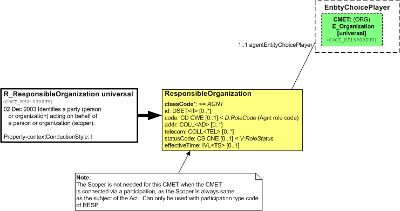
| Parent: | Personnel Management (PRPM_DM000000UV) |
This CMET is the universal variant of the R_ResponsibleOrganization CMET. This is also a constraint of R_Responsible universal, where the agent is constrained to an organization.
| E_OrganizationUniversal | COCT_MT150000UV02 |
| R_ResponsibleOrganization universal | COCT_MT040300UV09 |
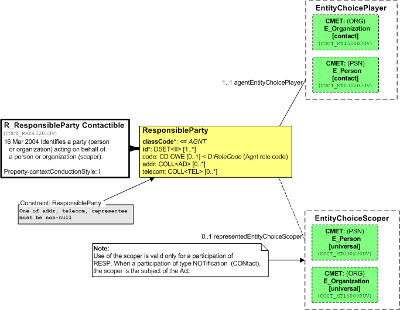
| Parent: | Personnel Management (PRPM_DM000000UV) |
This CMET Identifies a party (person or organization) acting as an agent on behalf of a person or organization (scoper).
This is the contact variant of the R_ResponsibleParty universal CMET. Contrast with R_NotificationParty contact, where agent is constrained to contact.
| E_PersonUniversal | COCT_MT030200UV09 |
| E_PersonContact | COCT_MT030203UV07 |
| E_OrganizationUniversal | COCT_MT150000UV02 |
| E_OrganizationContact | COCT_MT150003UV03 |
| R_ResponsibleParty contact | COCT_MT040205UV09 |
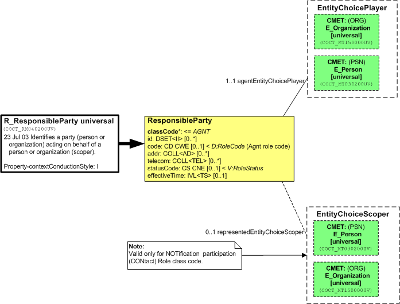
| Parent: | Personnel Management (PRPM_DM000000UV) |
The R_ResponsibleParty CMET identifies a party (person or organization) acting in the role of Agent on behalf of a person or organization.
This CMET is a restriction of the R_Responsible CMET, where the player of the agent role is constrained to a Party, which is either a Person or Organization.
| E_PersonUniversal | COCT_MT030200UV09 |
| E_PersonUniversal | COCT_MT030200UV09 |
| E_OrganizationUniversal | COCT_MT150000UV02 |
| E_OrganizationUniversal | COCT_MT150000UV02 |
| R_ResponsibleParty universal | COCT_MT040200UV09 |
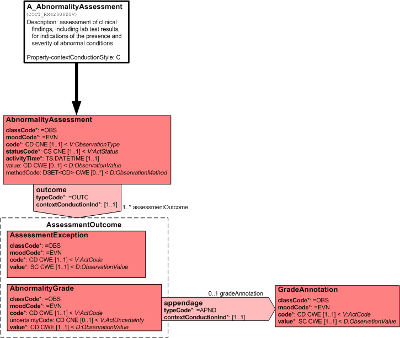
| Parent: | None |
The AbnormalityAssessment CMET is used to communicate data about preliminary, first-level assessments of clinical findings, including laboratory test results, for indications of the presence and severity of abnormal conditions.
Overview
The interactions currently supported by this CMET include:
- CT Lab Test Result Abnormality Assessment Request
- CT Lab Test Result Abnormality Assessment Response
Abnormality Assessment (entry point): The process of evaluating a clinical finding, including a laboratory test result, for indications of the presence and severity of an abnormal condition, and to assign the corresponding descriptive terminology that identifies the abnormal condition.
Assessment Exception: An exception represents one of two possible outcomes of the abnormality assessment (Abnormality Grade being the other possible outcome). When an assessment can not be done, information is provided detailing the reason(s) for the exception(s).
Abnormality Grade: An abnormality grade represents one of two possible outcomes of the abnormality assessment (Assessment Exception being the other possible outcome). When an assessment is completed, the severity of the abnormal condition is provided and this grade/level of severity is based on a specified assessment criteria or scale.
GradeAnnotation: Additional information provided about a grade such as explanatory text, caveats, and constraints.
| A_AbnormalityAssessment universal | COCT_MT420000UV |
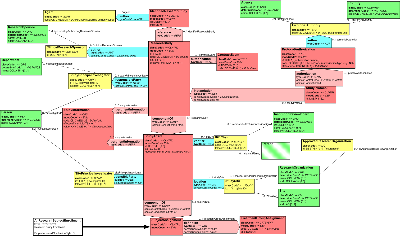
| Parent: | None |
This CMET is entered through the SubjectAssignement class, which represents enrollment in the study at a particular site. Component relationships are used to show the association of the subject enrollment to the StudyAtSite class and the site study to the overall ResearchStudy class. The following describes the individual associations to these three central classes.
TreatmentGroupAssignemnt: The definition act-relationship is used to show when the subject is also assigned to a treatment arm. This class is in Definition mood because a treatment arm is a treatment definition for a subgroup of the total enrollment.
ResearchOrganizaton and Site: The location participation captures the research institution responsible for the study at a particular site.
The ApprovedResearchOrganization represents the role of the research institution as an approved institution for federally-funded research as indicated by the Assurance number issued by the Office of Human Subject Research Protection under HHS.
IRBChair: The verification participation is used to identify the Institution Review Board and its chair. The IRB is responsible for ensuring the ethical conduct of the study at a given site with respect to the protection of human subjects.
SiteInvestigator and StudyInvestigator: The performer participation captures the lead for the study at a particular site as identified in the SiteInvestigator class and the lead investigator for the whole study is identified through the responsible party participation in the StudyInvestigator class. In addition, the department where the lead investigator works is identified in the Department class.
StudyInformation: The pertains to act-relationship relates the ResearchStudy class and the StudyAtSite class to the StudyInformation class to identify observations about the study. For example, any action that may be taken to the study as a result of the event or various statistics about enrollments.
StudyProtocol: The instantiation act-relationship associates the StudyProtocol class to the research study. The protocol is the overall plan for conducting the study. It must first be authorized by a regulatory organization before the study can take place. ProtocolAuthorization contains the authorization number and type of authorization, for example IND for drugs or IDE for devices. The Country class identifies the country where the regulatory organization issued the authorization.
ContractAward: The authorization act-relationship connects the ContractAward class to the study. In federally-funded research, the study is usually performed by the research institution under a contract to either the sponsor or the funding organization. Both the contract number and the type of contract are identified in the ContractAward class.
ResearchSponsor: The sponsor for the research is identified through the author participation in the ResearchSponsor class. The sponsor is the organization that proposed the research.
IdentifiedResearchStudy: The reference act-relationship is used to associate multiple identifiers with the study. The IdentifiedResearchStudy contains the identifier and the Agent class contains the type of organization that assigned the identifier.
| A_ResearchSubjectEnrollment | COCT_MT970000UV |
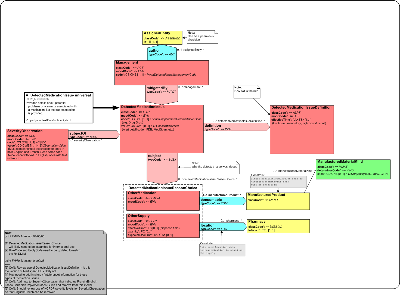
| Parent: | Pharmacy (PORX_DM000000UV) |
A_DetectedMedicationIssue universal
The DetectedMedicationIssue CMET provides details about potential problems or warnings associated with the dispensing of a drug. No text representation is provided.
The alert type code and value are specified and supported with the instantiation (time range that the alert applies over), the severity, the alert management approach and the reason the alert was tripped (e.g. the product they have a contraindication to or a pharmacy with which they have a supply problem).
Walkthrough:
The DetectedIssue is the focus of the CMET. The code identifies the type of issue that was detected, The 'value' identifies the specific issue detected. Associated with the issue may be an indication of the issue severity (SeverityObservation.value). It may also indicate when the 'type' of alert was last updated (i.e. when the knowledge-base rule that identified the issue was last changed).
The details of the interacting element are identified as the 'reason' for the issue. This might be a drug, a supply action, or both.
Finally, the issue might be managed, with the specific management action identified by Management.code, and the managing pharmacist identified by ProviderRole.id
| A_DetectedMedicationIssue universal | COCT_MT260003UV |

| Parent: | Scheduling (PRSC_DM000000UV) |
Used in situations where an encounter or service needs to refer back to the appointment that scheduled the event. This CMET is not intended to convey all appointment information, but just enough to identify the appointment and optionally, an appointment request.
| A_Appointment universal | COCT_MT020000UV01 |
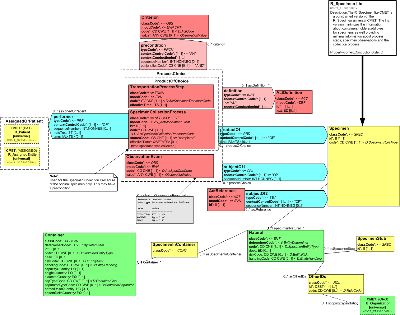
| Parent: | Specimen (POSP_DM000000UV) |
The R_Specimen lite CMET is a constrained version of the R_Specimen universal CMET. The lite version minimizes the information about containers/holders/additives for specimens as well providing minimal information about process steps, specimen observations and the collection process. See the R_Specimen universal CMET for the detailed model walk-through.
| R_PatientUniversal | COCT_MT050000UV01 |
| R_AssignedEntityUniversal | COCT_MT090000UV01 |
| E_OrganizationUniversal | COCT_MT150000UV02 |
| R_Specimen lite | COCT_MT080200UV09 |
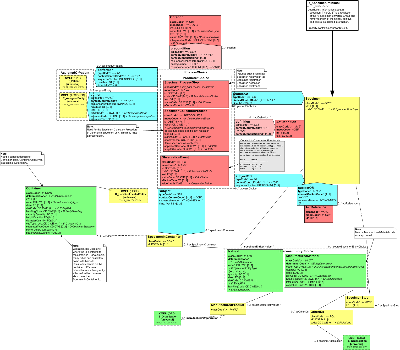
| Parent: | Specimen (POSP_DM000000UV) |
The R_Specimen minimal CMET is a constrained version of the R_Specimen universal CMET. The minimal version minimizes the information about containers/holders/additives for specimens, focusing mainly on information about the specimen itself. Information about a specimen, its container or both, includes information that aids in the analysis of a specimen and can be used by automation systems to interpolate settings required for automated analysis (e.g. container type, dilution factor.) Includes aliquot relationships, and container registration events. See the R_Specimen universal CMET for the detailed model walk-through.
| R_PatientUniversal | COCT_MT050000UV01 |
| R_LocationLocatedEntityUniversal | COCT_MT070000UV01 |
| R_AssignedEntityUniversal | COCT_MT090000UV01 |
| E_OrganizationUniversal | COCT_MT150000UV02 |
| E_OrganizationUniversal | COCT_MT150000UV02 |
| R_Specimen minimal | COCT_MT080100UV09 |
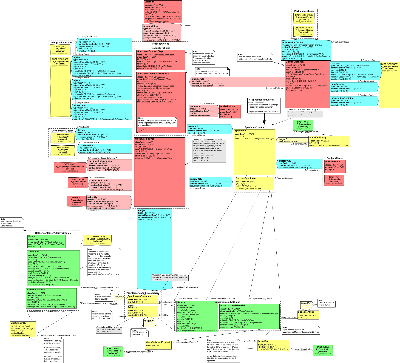
| Parent: | Specimen (POSP_DM000000UV) |
Model Overview For Specimen Universal
The Specimen CMET Refined Information Model (RMIM) captures information regarding a specimen and its container. Both the specimen and the source of the specimen are scoped by a specimenEntity which may be located in a container. The specimen itself may be the result of a process and can be acted on by any number of processes in order to handle both the specimen and the container.
The CMET has a central choice box (SpecimenChoice) that contains Specimen and DerivedSpecimen role classes. It should be noted that the CMET entry point is on the choice box, but has been constrained (via a text constraint) so that entry to the CMET is allowed only through the Specimen Role. This has been done because of tooling limitations which prevent the associations attached to the choice box from being properly inherited by the roles in the choice box if the entry point were directly attached to the Specimen role..
SpecimenChoice
Specimen: The Specimen role is played by an entity and scoped by the parent entity of the specimen. Attributes of the specimen role include an id and code describing the type of specimen role.
DerivedSpecimen: The DerivedSpecimen role is played by an entity and scoped by the parent entity. The parent of a derived specimen is always another specimen. Attributes of the specimen role include an id and code describing the type of specimen role.
Playing and Scoping Entities Associated With Specimen and DerivedSpecimen
The Specimen and DerivedSpecimen roles are played by the specimenEntityChoice. The Specimen role is scoped by the sourceSpecimenEntityChoice.
SpecimenEntityChoice: Choice of Natural (ENT) or ManufacturedMaterial (MMAT) entities).
Natural: An entity comprised of naturally occurring substance in the role of specimen.
ManufacturedMaterial: The ManufacturedMaterial entity class is used to document specimens which have been manufactured such as quality control specimens. The ManufacturedMaterial entity plays the role of a manufactured product, which is scoped by the E_Organization universal CMET representing the manufacturing organization.
Associations of SpecimenEntity Choice:
OtherIDsAn identifying relationship between the focal entity and a scoping organization. Note that this could be an identifier used by the primary scoping organization in a different context. The ids carried in this role are intended to be interoperable because they are associated with a specific Role class code. The role is played by the entity and scoped by the E_Organization universal CMET. A role that provides a non-specimen identifier for an entity in the role of specimen. Examples include medical record numbers, drivers license number, social security number, etc.
SpecimenStub: The SpecimenStub serves two purposes.When the associated entity is playing the role of specimen, then SpecimenStub conveys other specimen ids for the specimen. The SpecimenStub may be the target of an IDENT role link from an IdentifiedEntity role.
Additive: An additive mixed into the specimen, e.g., in an aliquot of citrate blood. Additive is a role scoped by the specimen entity and played by the AdditiveMaterial (MAT). AdditiveMaterial is a choice in the HolderContainerAdditiveChoice (see below). The Additive may be the target of an IDENT role link from an IdentifiedEntity role.
SpecimenInContainer: The SpecimenEntities play the role of content for a container. The SpecimenInContainer is scoped by the Container entity. Container is a choice in the HolderContainerAdditiveChoice (see below). The SpecimenInContainer may be the target of an IDENT role link from an IdentifiedEntity role. The player association from the specimen to the container role has a 0..* cardinality to support a single specimen in multiple containers. There are examples from veteranary medicine where a siongle specimen, for instance an animal cadaver, is contained in multiple containers. This is still treated as a single specimen.
HolderContainerAdditiveChoice: The HolderContainerAdditiveChoice is a choice of a Holder entity, Container entity or AdditiveMaterial entity.
Holder: Entity which contains either a container or another holder.
Container: The container entity contains the specimen and may also itself be the content of a holder, such as a vial containing a specimen that is placed in a carrier.
AdditiveMaterial: Additive mixed into the specimen, e.g., in an aliquot of citrate blood.
Role Associations of HolderContainerAdditiveChoice:
EntityInEntity: A Holder in holder, e.g,a carrier on a tray. A Container in holder,e.g., a specimen container in a carrier. A Material in Container. E.g. an anticoagulant in the container.
R_LocationLocatedEntity: The HolderContainerAdditiveChoice plays the role of a located entity via the R_LocationLocatedEntity universal CMET.
Role Links Associated With SpecimenChoice
TargetOf: The SpecimenChoice is the target of an IDENT role link. The associated IdentifiedEntity Role provides additional scoper information for the target Role.id. In this model the following roles are associated with IdentifiedEntity: Specimen, DerivedSpecimen, SpecimenStub, SpecimenInContainer and Additive. In each of these roles, the scoper of the role is not the orgnaization which assigned the role id, rather it is the source material from which the specimen, material, etc. is associated. The IdentifiedEntity role is associated with these roles via an IDENT role link to allow more information about the issuer of the Role.id to be provided. The 2.x equivalent to this is the concept of assigning authority.
Participations Associated with SpecimenChoice
SubjectOf3: The Specimen is subject of zero to many ActReferences or Annotations.
SubjectOf2: The specimen is the subject of zero to many ProcessChoice acts. See ProcessChoice below for a description of the acts included in ProcessChoice.
ProductOf: The Specimen is the product of zero to one SpecimenProcessSteps or SpecimenCollectionProcess. This identifies the specimen, via its role, that is the product of a process. This process may be any act from the ProductChoice. Where this is the original specimen, the SpecimenCollectionProcess will generally be the appropriate process but, where there is an aliquoting or other specimen treatment that results in a "new specimen," the SpecimenProcessStep is appropriate.
ProcessChoice: ProcessChoice contains the ProductChoice acts as well as an ObservationEvent act.
ProductChoice: A specimen may be the product of either a SpecimenProcessStep act or a SpecimenCollectionProcess.
SpecimenProcessStep: A SpecimenProcessStep is performed on a specimen and its container or holder. Typical process steps are Specimen Collection, Specimen Accession, Specimen Separation etc. The Process Step in EVN mood is intended to identify that the step has taken place but not to report any value or the outcome. For instance, when Cold Agglutinins are discovered in the specimen during the processing of a CBC test the specimen is placed in a 37 degree wash for two hours. This observation would record that this had been performed.
SpecimenCollectionProcess: SpecimenCollectionProcess documents the obtaining or planed obtaining of an original specimen from the subject of interest. Used for the Specimen Collection Procedure of the original specimen only. This may have a precondition.
ObservationEvent: An observation performed related to an entity in the role of specimen. Observations are actions performed in order to determine an answer or result value. Observation result values (Observation.value) include specific information about the observed object in this case a specimen.
ProcessChoice Act Relationships
Precondition: Associates specific criteria that apply prior to a particular Specimen process. The process choice for the specimen may have any number of Criterion Observations as a precondition, such as fasting before a glucose tolerance test. The Criterion is a precondition observation for the ProcessChoice.
SubjectOf4: The ProcessChoice may the subject of a ControlAct. These Control Acts communicate the trigger event and other "action" information regarding the associated act. This structure is useful for historical query responses and result communications. The ControlAct is modeled on the Control Act wrapper from Specification Infrastructure. See Trigger Event Control Act Infrastructure D-MIM for additional information regarding the control act.
Definition: The definition act relationship is used to associate a ProcessChoice with its ActDefinition (master file). The source act is an instance of the target definition act. The ActDefinition class represents the definition (master file) for the associated ProcessChoice. Typically this definition is drawn from the local service catalog.
SubjectOf5: The act my be the subject of zero to many Annotations. Annotations include any sort comments, special instructions, etc.
ControlVariable: The ControlVariable participation documents the order options associated with a ProcessChoice.
PertinentInformation: An ProcessChoice is associated with zero to many items of supporting clinical information that are pertinent to the event. The information is carried in the SupportingClinicalStatement CMET.
ProcessChoice Participation's
Performer: Identifies the performer of the ProcessChoice. This may be an assigned entity or a patient.
Author: The entity responsible for creating the ProcessChoice, details of which are carried in the AssignedEntity CMET.
Transcriber: Identifies the person/device transcribing the data, details of which are carried in the AssignedEntity CMET.
Verifier: Identifies one or more individuals who verify the content of the ProcessChoice, details of which are carried in the AssignedEntity CMET.
Device: A test kit that is participating in the process step as a device.
Consumable: Lab test kit or reagent that is taken up, is diminished, or disappears in the process step.
Subject: The SpecimenInContainer or Additive is subject of zero to many ProcessChoices.
| R_PatientUniversal | COCT_MT050000UV01 |
| R_LocationLocatedEntityUniversal | COCT_MT070000UV01 |
| R_AssignedEntityUniversal | COCT_MT090000UV01 |
| R_AssignedPersonUniversal | COCT_MT090100UV01 |
| R_AssignedPersonUniversal | COCT_MT090100UV01 |
| R_AssignedDeviceUniversal | COCT_MT090300UV01 |
| E_OrganizationUniversal | COCT_MT150000UV02 |
| E_OrganizationUniversal | COCT_MT150000UV02 |
| E_OrganizationUniversal | COCT_MT150000UV02 |
| A_OrderOptionsUniversal | COCT_MT210000UV02 |
| R_ReagentUniversal | COCT_MT250000UV03 |
| R_LabTestKitUniversal | COCT_MT430000UV09 |
| A_SupportingClinicalStatementUniversal | COCT_MT530000UV |
| A_AnnotationUniversal | COCT_MT590000UV |
| A_AnnotationUniversal | COCT_MT590000UV |
| R_Specimen universal | COCT_MT080000UV09 |
| Return to top of page |


